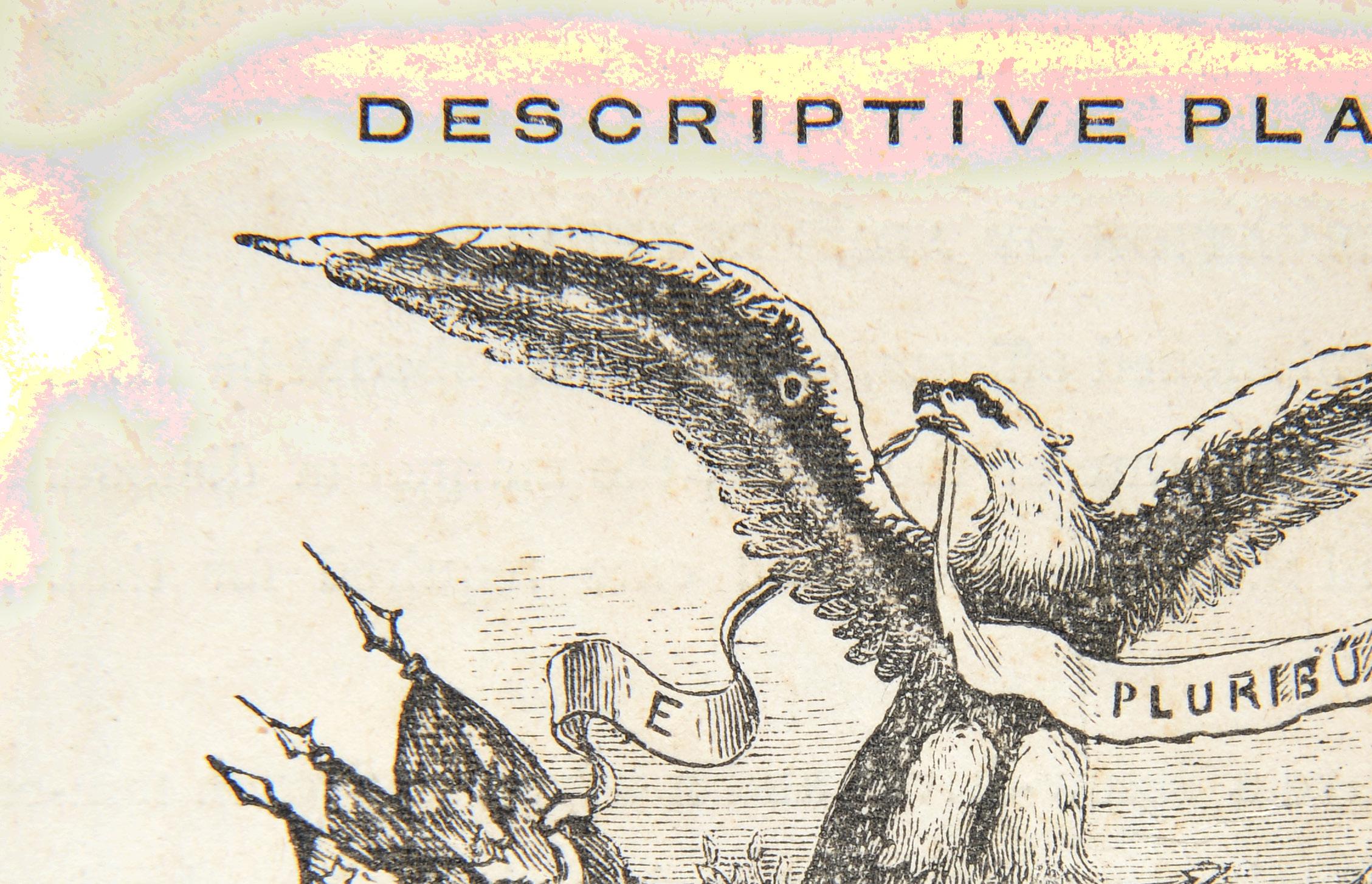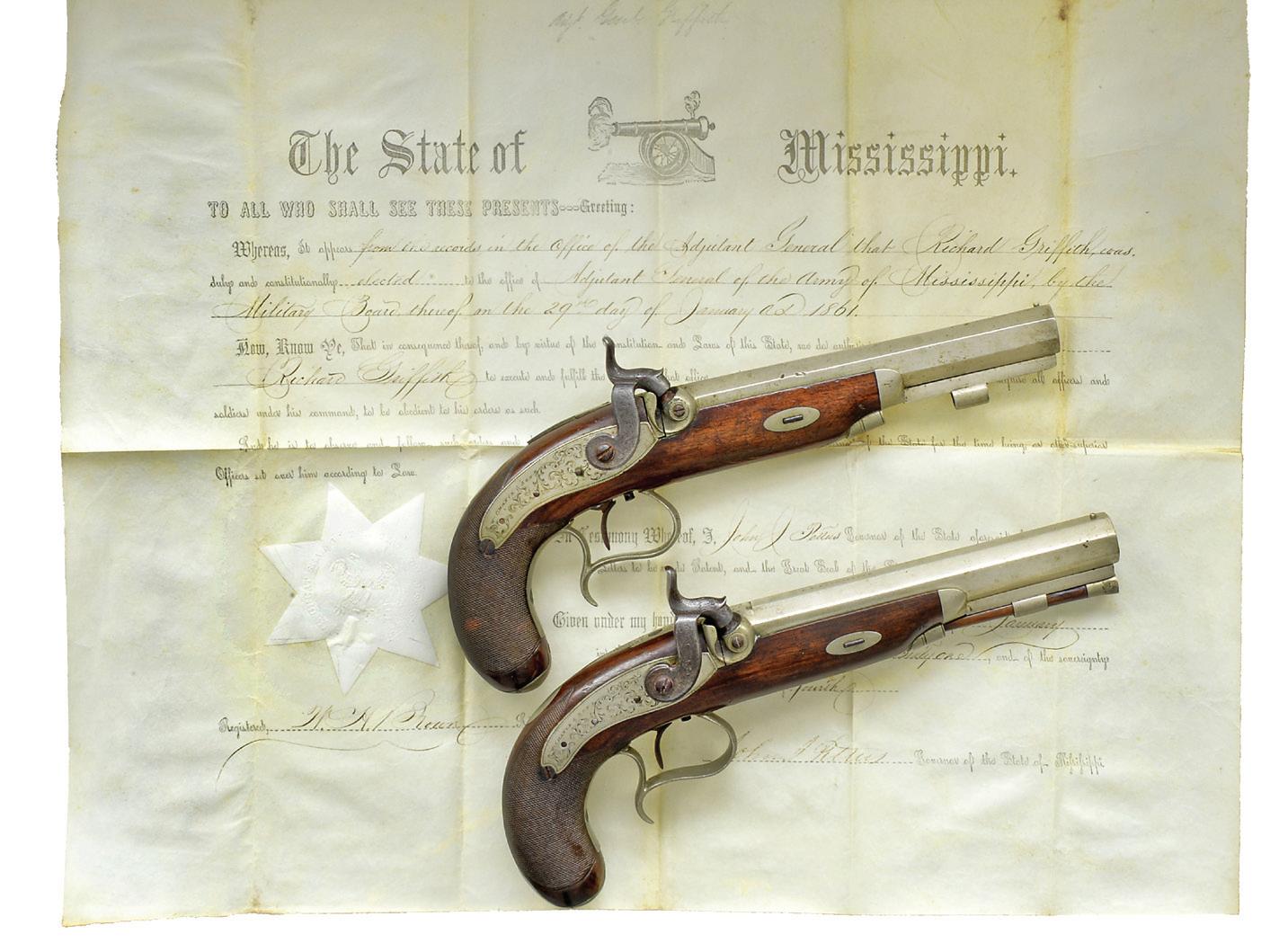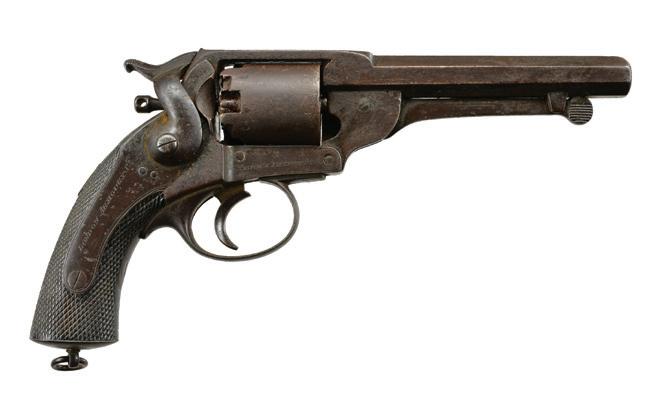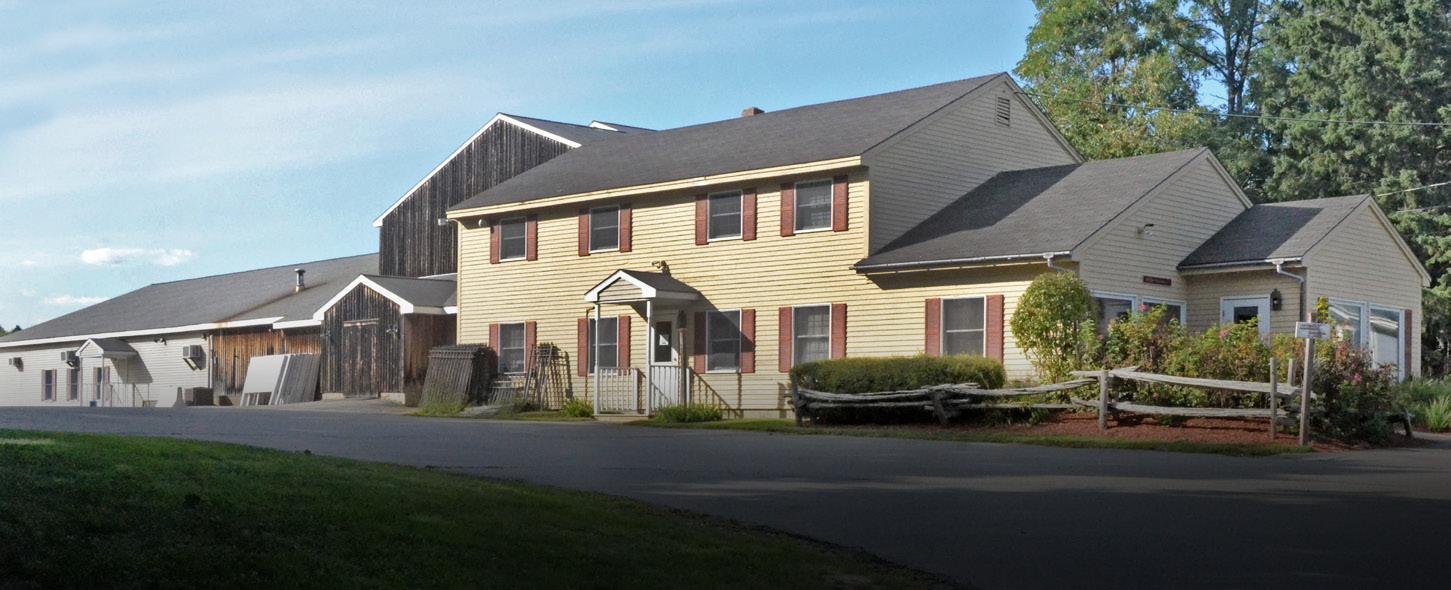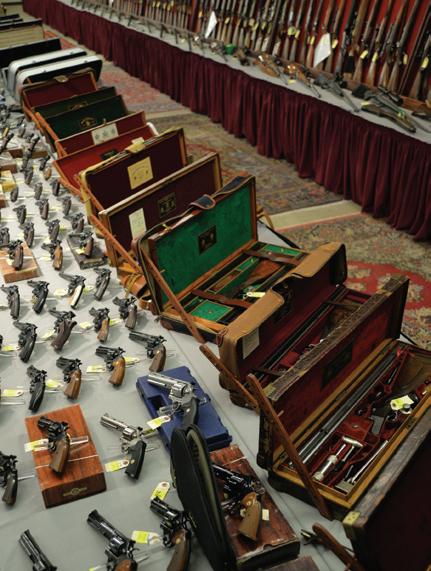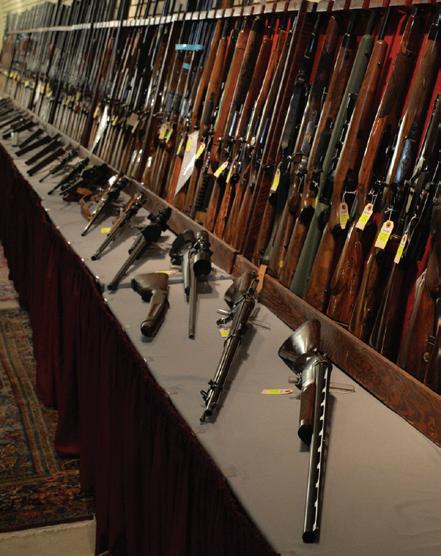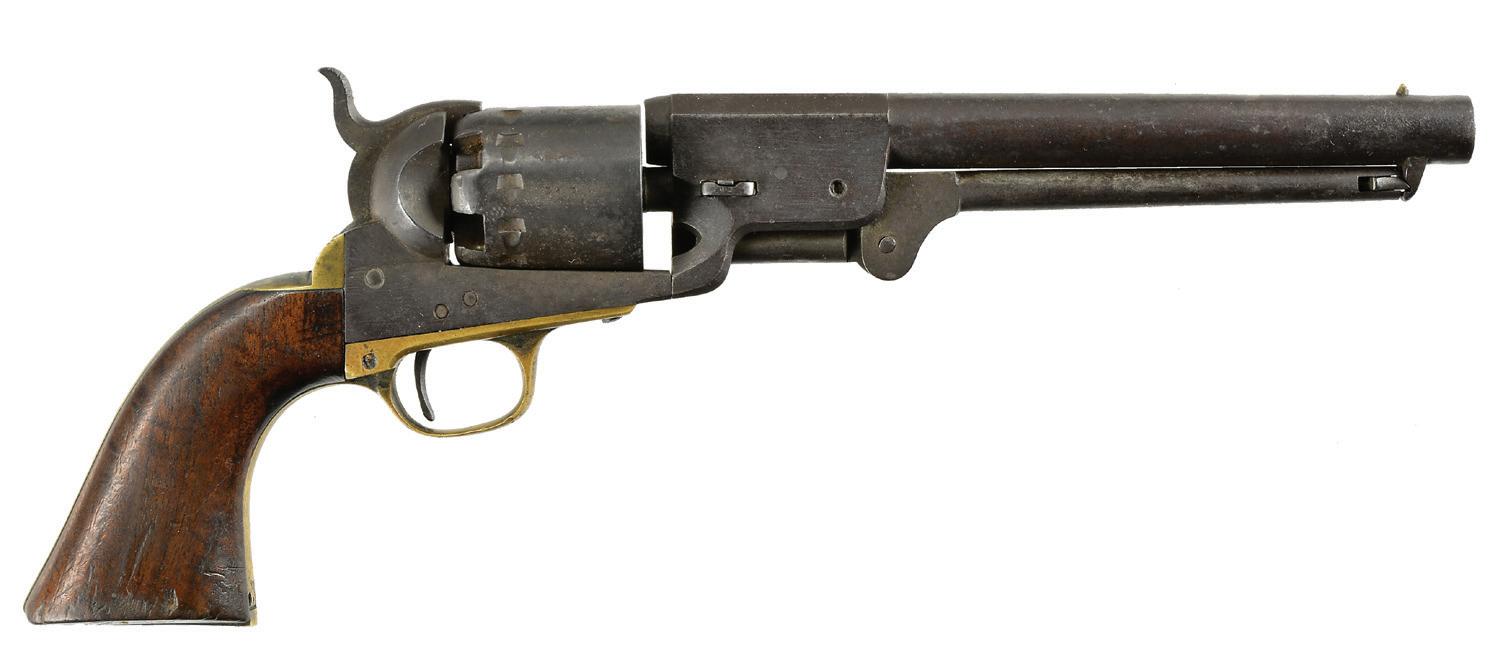45, No. 3
$3.50
America’s Monthly Newspaper For Civil War Enthusiasts



DALTON, Ga.—While a polar vortex threatened north Georgia early in the week, skies cleared and temperatures rose to almost balmy levels just in time for the 24th Annual Chickamauga Civil War Show and Sale held at the Dalton Convention Center on February 2-3.
Enthusiasm was high as the parking lot filled to capacity early Friday morning as dealers jockeyed for positions to ensure a good spot close to the doors for the move in. Many vendors had not seen each other since the Franklin show in early December, and all were excited to quickly set up their tables and begin searching for that perfect item to add to their collection or shop.
Show Promoter Mike Kent of MK Shows expected this show to be a success based on the results of the preceding Richmond and Franklin shows and he was not disappointed. With all 500 tables sold out weeks ahead of time, Kent had to contend with a promoter’s worst nightmare; turning away quality dealers due to lack of space. Over 15 dealers were unable to secure tables because the popular show sold out much earlier than usual. The folks who were fortunate enough to acquire tables were treated to a
show reminiscent of the old days with a huge crowd, money freely changing hands, and lots of fresh material walking in the door.
As always, an enthusiastic group of history buffs from the Atlanta Civil War Round Table journeyed to Dalton to take in the sights and visit with old friends in what has become an annual pilgrimage for the group. Other celebrities spotted at the show were Wayne and Greg Williams, promoters of the well-known Ohio Civil War and Artillery Show, in town to check things out with the promise of returning next year with one of their museum quality displays.
Over the course of the weekend, many dealers expressed the feeling that the Dalton show was one of their favorites on the circuit. When questioned about it, Kent agreed and provided an insight into why so many dealers felt that way.
The Dalton Convention Center is a state of the art building with 50,000 square feet of unobstructed exhibit space in one room with great lighting, an easy move in via multiple ground level doors, a huge carpeted lobby, free internet access, acres of free parking, and good concessions. It is the perfect venue for our type of event.
Dalton is centrally located between Atlanta and Nashville, two major population areas, and only 20 miles south of Chattanooga. These areas saw some of the heaviest fighting in the Civil War and there is tremendous interest in the war even today. In fact, the address of the Dalton Convention Center is Dug Gap Battle Road; it is located less than a mile off I-85 at Exit 333.
With more than ten major hotels and corresponding restaurants within one mile of the Convention Center, lodging, meals, and social activities are easy and convenient to access.
Although the Convention Center staff are rarely encountered by dealers, they are fully supportive of the show and go out of their way to ensure the event goes off flawlessly each year. They have been invaluable in scheduling dates, arranging speakers, and working with the Convention and Visitors Bureau to make the show a success.
Even though the Dalton show is not the biggest event of its type in the country, exhibitor Martha Nelson summed it up best: “It’s not too big, it’s not too small; it’s just the right size!”
As always, there are several items at each show that are a little unusual and garner a lot of attention. This year was no different; two items had a direct Dalton connection. Will Gorges of Battleground Antiques in New Bern, N.C., brought a Confederate battle flag manufactured in Augusta, Ga., that was delivered to the 1864 Confederate winter camp in Dalton to replace an original flag that was either lost or destroyed. One of only eleven similar flags known to exist; it was being offered for $95,000. The other item was a war log from the Battle of Chickamauga that featured a
projectile embedded in the trunk. It was being displayed by Dicky Ferry of MacClenny, Fla., and was originally part of the Steve Mullinax collection.
Several new dealers were participating in the Dalton show for the first time and promised to be back next year after an exciting and profitable first time out. In addition, several vendors who had not been seen in several years were back as well. Kent discussed the aging of vendors as well as the aging of attendees and opined about the difficulty of attracting new blood into the Civil War collecting community. While many older enthusiasts “just know” about Civil War shows, promoters are having to work smarter and rethink the way they advertise their events to reach new potential customers as the old traditional ways are becoming less and less effective. In the past, newspaper ads, TV and radio commercials, billboards, post cards, and flyers were the primary modes of advertising. Fast forward to 2019 with fewer and fewer people reading newspapers, more people listening to commercial free Sirius radio, TV cable companies who won’t air commercials featuring weapons of any type, and postage rates
that are prohibitive for mailing thousands of post cards for a show. That leaves you with billboards and the new advertising trend known as social media. Kent made a bold move 5 years ago when he switched from mailing 5,000 post cards to previous attendees to sending 5,000 emails with no downturn in attendance. In addition, he runs digital ads on all Civil War and gun related advertising forums, maintains an up to date website, has a corporate Facebook presence, accepts digital $1 off coupons at the door, and partners with all his venues to advertise via Facebook. If we are to survive and grow in this business, Kent thinks it is imperative that we embrace these newer trends and use them to their fullest potential to attract and keep engaged younger and more tech savvy enthusiasts, even though the material we all deal in is over 100 years old!
The next Dalton Civil War Show and Sale is scheduled for Feb. 1-2, 2020, but make plans to attend Mike Kent’s Capital of the Confederacy Show in Richmond, Nov. 16-17 and the Franklin Civil War Show on Dec. 7-8.

Published by Historical Publications LLC


520 Folly Road, Suite 25 PMB 379, Charleston, SC 29412
800-777-1862 • Facebook.com/CivilWarNews
mail@civilwarnews.com • www.civilwarnews.com
Advertising: 800-777-1862 • ads@civilwarnews.com
Jack W. Melton Jr. C. Peter & Kathryn Jorgensen
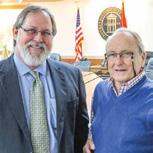
Publisher Founding Publishers
Editor: Lawrence E. Babits, Ph.D.
Advertising, Marketing & Assistant Editor: Peggy Melton
Columnists: John Banks, Craig Barry, Joseph Bilby, Matthew Borowick, Stephen Davis, Stephanie Hagiwara, Gould Hagler, Tim Prince, Salvatore Cilella, John Sexton, Michael K. Shaffer
Editorial & Photography Staff: Greg Biggs, Joseph Bordonaro, Sandy Goss, Gordon L. Jones, Michael Kent, John A Punola, Bob Ruegsegger, Gregory L. Wade, Joan Wenner, J.D.
Book Review Editor: Stephen Davis, Ph.D., Cumming, Ga.
Civil War News (ISSN: 1053-1181)
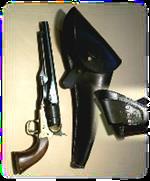
Copyright © 2018 by Historical
Publications LLC is published 12 times per year by Historical Publications LLC, 520 Folly Road, Suite 25 PMB 379, Charleston, SC 29412. Monthly. Business and Editorial Offices: 520 Folly Road, Suite 25 PMB 379, Charleston, SC 29412, Accounting and Circulation
Offices: Historical Publications LLC, 520 Folly Road, Suite 25 PMB 379, Charleston, SC 29412. Call 800-777-1862 to subscribe.

Periodicals postage paid at U.S.P.S. 131 W. High St., Jefferson City, MO 65101.
POSTMASTER: Send address changes to: Historical Publications LLC 520 Folly Road Suite 25 PMB 379 Charleston, SC 29412

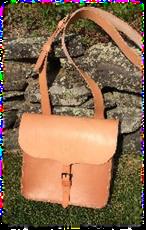
Display advertising rates and media kit on request. The Civil War News is for your reading enjoyment. The views and opinions expressed herein are those of its authors, readers and advertisers and they do not necessarily reflect the official policy or position of Historical Publications, LLC, its owners and/or employees.
Please send your book(s) for review to:
CWN Book Review Editor, Stephen Davis
3670 Falling Leaf Lane, Cumming, GA 30041-2087
Email cover image to bookreviews@civilwarnews.com Civil War News cannot assure that unsolicited books will be assigned for review. We donate unsolicited, unreviewed books to libraries, historical societies and other suitable repositories. Email Dr. Davis for eligibility before mailing.

Email us at ads@civilwarnews.com Call 800-777-1862
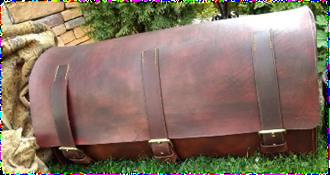
MOVING?
Contact us to change your address so you don’t miss a single issue. mail@civilwarnews.com • 800-777-1862
U.S. Subscription rates are $38.50/year, $66/2 years, digital only $29.95, add digital to paper subscription for only $10/year more. Subscribe at www.CivilWarNews.com
Letter to the Editor:
I enjoyed Leon Reed’s article “New York State Militia/Hiram Roosa’s Collection.” Since my family was involved in the New York State Militia at the time, I hope Mr. Reed does not mind if I provide a side bar. Mr. Reed is correct when he wrote, “Of all the northern states, New York was the one that took military affairs most seriously.” Well, there was more than one reason New York State gave such strong support to its militia; it was the Irish and the Fenian Brotherhood.

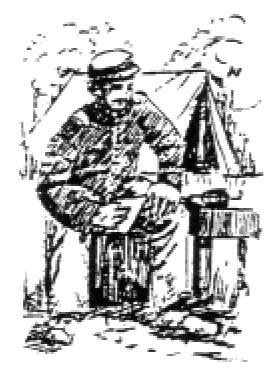
Some, not all, were Irish Regiments and some of them were training in hopes of returning to Ireland to cause trouble for the English. Some Irish Regiments at the time were the 9th, 69th, 7th, and 12th. New York Governor Fish even gave the Irish regiments the right to wear green uniform coats in 1849. The 69th wore their green coats for the first time on February 25, 1853.
My great grandfather’s regiment, the 69th New York Militia, was later nicknamed the Fighting 69th by General Lee. Col. Corcoran, the acting leader of the New York State Fenian Brotherhood, was elected as its commanding officer.

The Irish political power was so strong, that the State of New York even allowed the 69th to train as artillerymen, since they could raise infantry in Ireland, but not artillery.
Then, on April 12, 1861, the South fired on Fort Sumter and Irish regiments went to war to preserve the union.
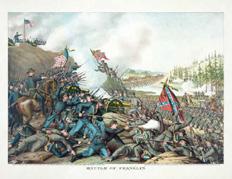 Steve Reilly Lost Mountain, Georgia
Steve Reilly Lost Mountain, Georgia
Letter to the Editor:
“Let Them Rest” by Gould Hagler. I’d like to thank Mr. Hagler for his fine piece on Confederate Statues. He points out the Smithsonian’s Magazine
article on this topic and it’s falsehoods. He also points out the Smithsonian partnering with “The Nation Institute” a far left wing group that is far below the dignity and standards of the Smithsonian that we expect. This article and others in the February 19 issue were great—as always.
 Bob Brewer Gaithersburg, MD
Bob Brewer Gaithersburg, MD


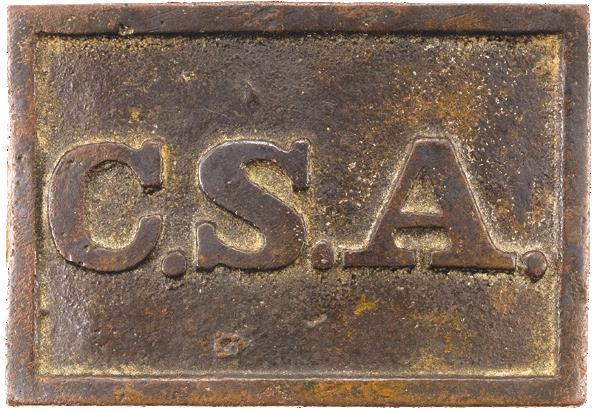
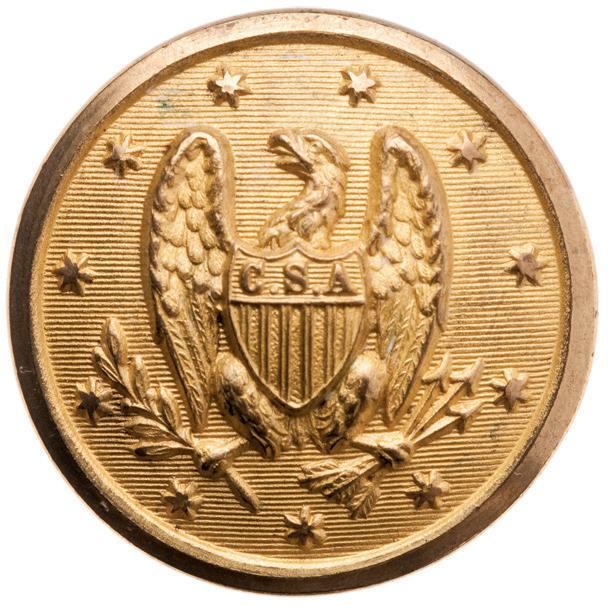
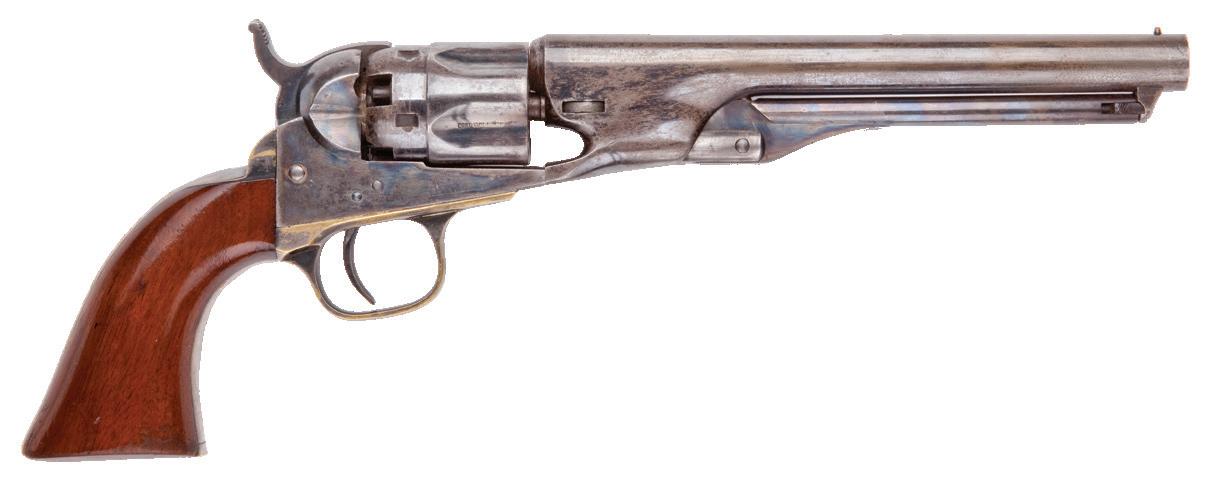

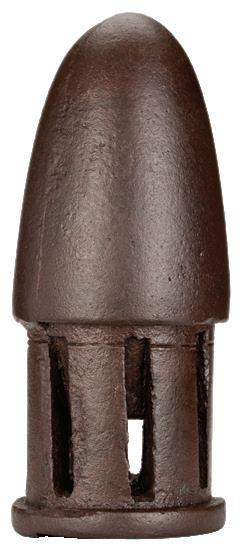

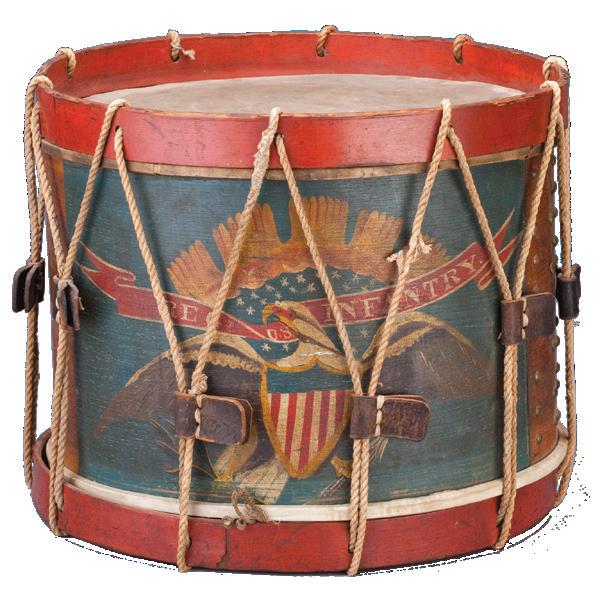
We have seen the views taken in Paris by the “Daguerreotype” and have no hesitation in avowing that they are the most remarkable objects of curiosity and admiration, in the arts, that we ever beheld. Their exquisite perfection almost transcends the bounds of sober belief. Let us endeavor to convey to the reader an impression of their character. Let him suppose himself standing in the middle of Broadway, with a looking glass held perpendicularly in his hand, in which is reflected the street, with all that therein is, for two or three miles, taking in the haziest distance. Then let him take the glass into the house, and find the impression of the entire view, in the softest light and shade, vividly retained upon its surface. This is the Daguerreotype!1
This is how a New York journalist in 1839 expressed his amazement over a new artistic creation, the Daguerreotype. Louis Daguerre was a French painter who, in the 1820s, began experimenting with ways of reproducing images on canvas without having to paint them. About that time, another Frenchman, Joseph Niepce was trying to do this same thing with lithographic stone. The two artists collaborated until
Niepce’s death in 1833. Daguerre persevered until he was able to announce his new process in January 1839.
The story of photography, however, goes back many years before. The camera obscura (Latin for dark vault) had been around since Leonardo da Vinci’s time. The principle involved having a darkened room with a small hole bored in a window shutter. Light passing through the opening projects on a surface across from the hole an upside-down, laterally reversed image of the outside scenery. Improvements on the process replaced the room with a small box and a glass surface as the receiving screen.
Daguerre’s contribution to the camera obscura—eventually just “camera”—was to think of a way to make permanent the image projected by the ray of light. Everyone wanted to know how he had done it. On Aug. 19, 1839, the French Academy of Sciences hosted a public meeting to hear Daguerre. The artist, however, chose not to speak, so a noted scientist explained it for him:
a) he plated a copper sheet with liquid silver and polished it;
b) he put the silver surface in a little box filled with iodine vapor for up to half an hour till it
turned golden or yellow;
c) he then placed the silver-sensitized sheet in a camera obscura for from five to twelve minutes, depending on the air temperature;
d) with the reversed image now present on the plate (but not yet visible), he developed it with liquid mercury vapor;
e) he washed the developed plate with hyposulfite of soda, dried, then mounted it under glass;
f) voila! The finished daguerreotype!
Daguerre’s process got into the papers immediately. The London Globe published an article on it four days after the Paris meeting. With communication between America and Europe still dependent on steamers at sea, it was the arrival of the H.M.S. British Queen in New York on September 20 that brought the Globe with its reporting on Daguerre’s exciting new process. Within days, papers in major U.S. cities were reprinting the article.2
This set industrious artisans to work trying to produce their own daguerreotypes. Within a month, Samuel F.B. Morse, the same Morse who had invented the electromagnetic telegraph in 1835–37, produced a daguerreotype at his New York office. Daguerreotypists in other major American cities began to advertise for patrons. Along the way, experimenters improved the production process.
During the time of his experiments with daguerreotypes, Morse was visited by a young Mathew Brady. Brady, born in upstate New York around 1822, was enthralled and learned the process from Morse. He then opened his own studio in New York City in 1844. Within a year he came up with the idea of making pictures of every famous person he could. In this endeavor he famously succeeded, thus earning from Robert Taft, historian of American photography, credit as an accomplished “photographic historian.”3
Medium: quarter-plate ambrotype, 11.9 x 9.5 cm (case). (Liljenquist Family Collection, Library of Congress)
Shadow of Death”—referring to the famous charge of the Light Brigade.4
Mary Todd Lincoln, wife of Abraham Lincoln. Three-quarter length portrait, seated, facing front. Attribution to Nicolas H. Shepherd based on similarity to daguerreotype of Lincoln received as a pair with this portrait. Photograph was taken in 1846 or 1847.
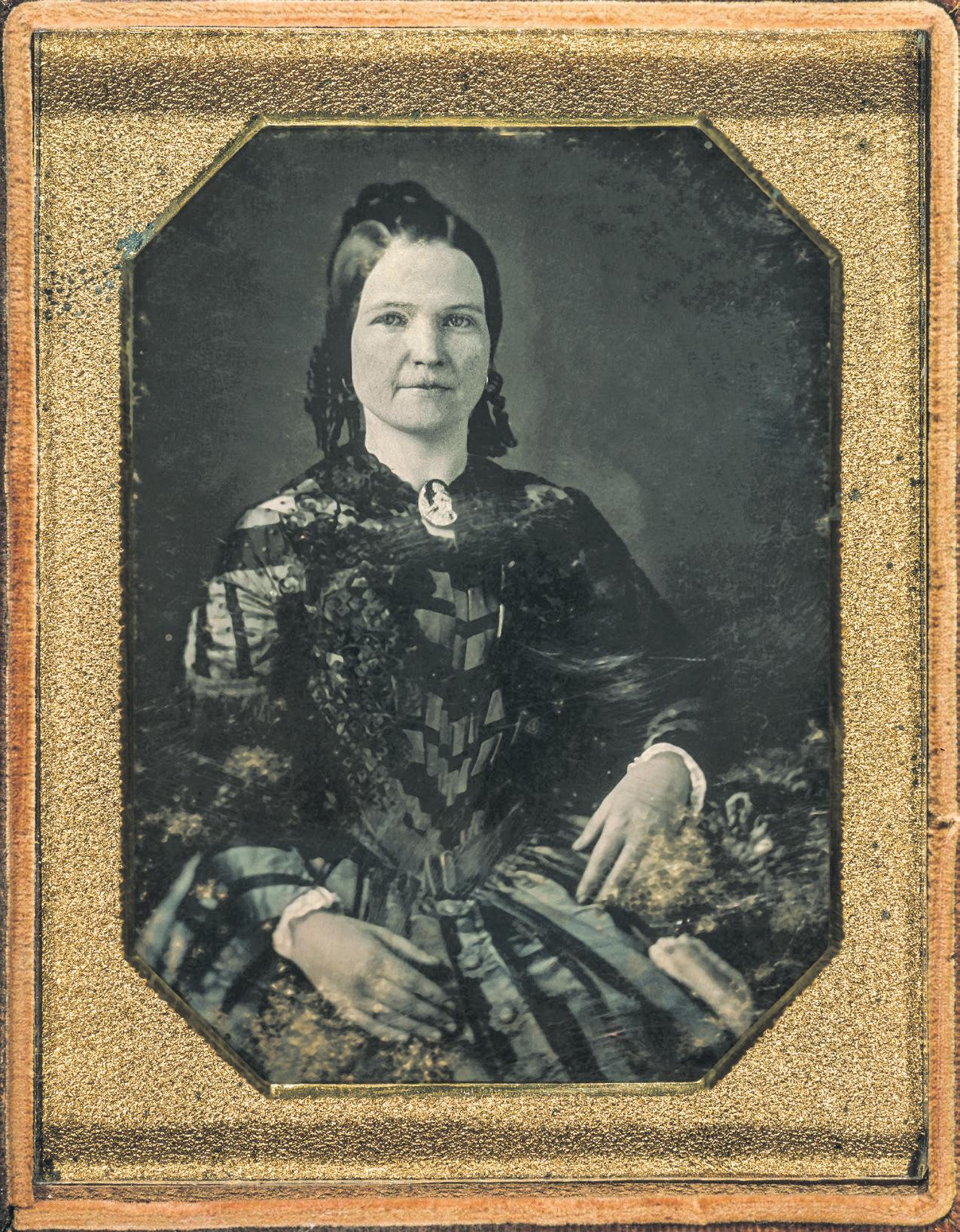
Medium: 1 photograph: quarter plate daguerreotype; plate 4 1/4 x 3 1/4 in. (Library of Congress)
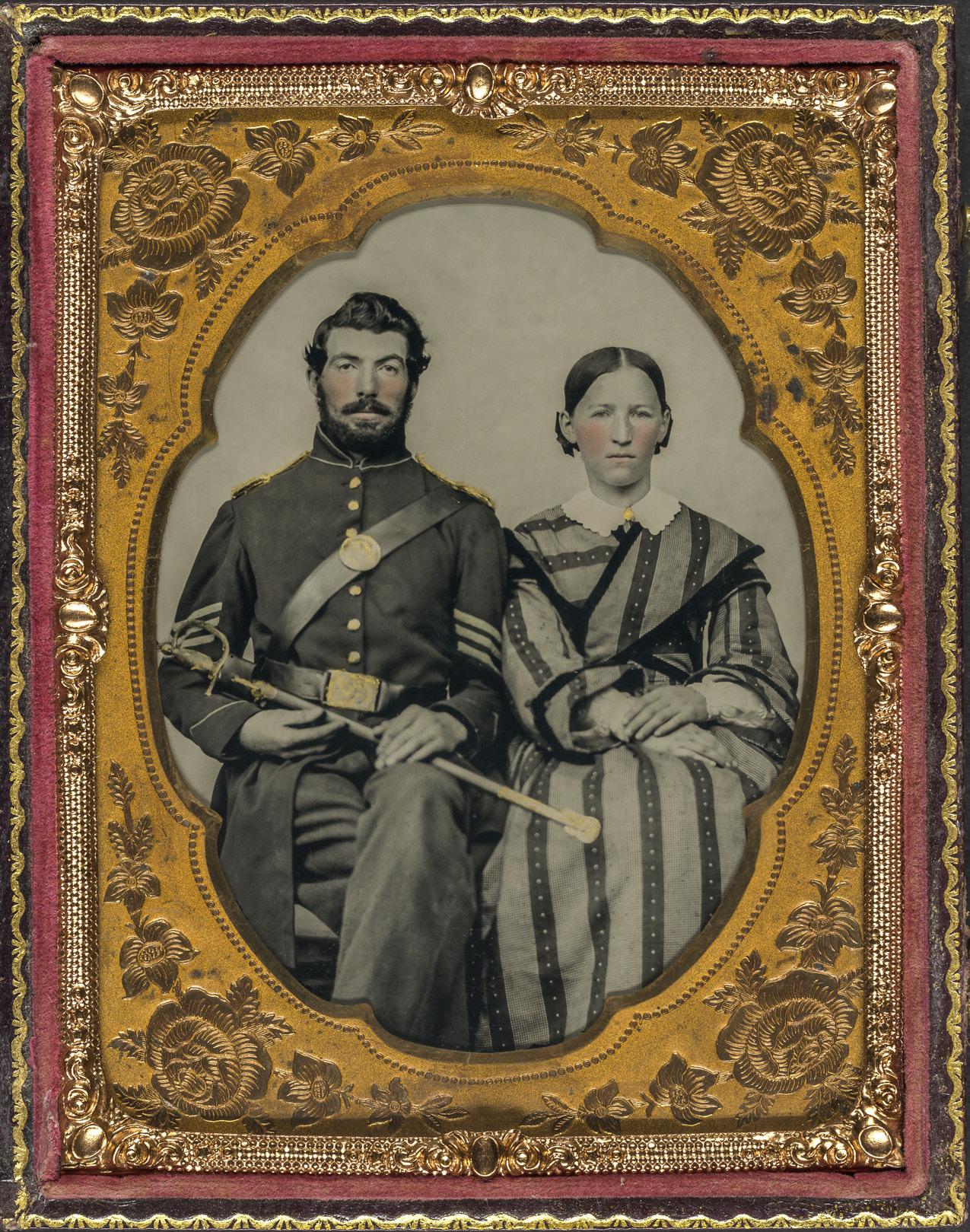
The idea of photographs capturing people and moments in history was further tested, and advanced, during the MexicanAmerican War of 1846–48. One of a handful of existing daguerreotypes shows General John E. Wool and his staff on horseback in the streets of Saltillo during the winter of 1846–47. A few years later, in 1855, Englishman Roger Fenton went to Crimea and took pictures of the Crimean War. He and his assistant produced more than 350 images, the best known of which are titled “Valley of the
By that time, the daguerreotype was already in decline, replaced by wet-plate collodion photography, as experimenters sought continually to improve the process and product. A major defect of Daguerre’s image was that there was no way to replicate it, and visually, because of its mirror-like surface, the picture could only be seen in a certain light. As the craft was evolving, the term photography took hold as artisans began producing images on chemically treated paper. Early photographers in the 1840s also began speaking of negatives (original images in the camera) and positives (prints derived from the negative).5
In 1850 nearly a thousand daguerreotypists were in business across the country. “The rage for photography was overwhelming,” writes historian George Gilbert.
In every major city, photographic galleries, like exhibition rooms in the finest museums, made it possible for everyone to see and acclaim photographic likenesses—and to consider a suitable time for arranging a sitting. In the earliest
years some studio-galleries had up to hundreds of sittings a day. Few photographs made in the mass production centers were larger than a playing card, and most were only half that size. Encased in their protective leather, wood, or molded housings with the delicate Daguerrean image under glass, the miniatures were an endless source of amazement. Although at first they cost about $5 (more than a week’s wages for a workingman), it was not long before studio competition brought prices down to a dollar, then fifty cents, and, finally, to the outrage of the leading photographers, twenty-five cents.6
Technological improvements continued. Physicians in the late 1840s had learned that collodion, a syrupy mix of nitrated cotton in alcohol with ether, when dried formed a transparent membrane that could be applied to wound and burn victims as a “skin.” Photographic experimenters realized that collodion could be applied to glass plates to prevent their fracturing. Better still, collodion could absorb the photographer’s light-sensitive chemicals. Thus was born the “wet-plate.” Transfer of the image from glass plate negative to
produced positive
prints lots of them inexpensively. In 1857 a European nobleman had his likeness glued onto small (2 ½ x 4 inch) cards, giving rise to the carte de visite—also known as a CDV—a popular type of cheap photographic portrait. Oliver Wendell Holmes, the Massachusetts physician and man-of-letters, called the card-portraits “the social currency, the sentimental green-backs of civilization.”
Then in 1855 came the ambrotype: a glass negative backed with black velvet or black paper to render it into a positive, and encased in the manner of daguerreotypes. Ambrotypes came in a variety of sizes. Most common were 2 ¾ inches x 3 ¼ inches and 3 ¼ inches x 4 ¼ inches. Their rise as successor to earlier technology was swift. Frank Leslie’s Illustrated Newspaper in New York used photographic images as the basis for its wood engravers to make printable pictures. In 1856, of 123 pictures rendered from photographs, 100 came from ambrotypes, ten from paper photos, and thirteen from daguerreotypes.7
Photography for everybody took another step forward in 1856 with the tintype (or ferrotype, from the Latin for iron). Tintypes used the same sticky wet emulsion as before, but on lightweight metal instead of glass. The finished product also needed no protective case. The result was a photographic image that could be produced for a single cent.
The inexpensive ferrotype became a political campaign tool just before the Civil War. In February 1860, a beardless, fifty-one-year-old lawyer from Illinois, Abraham Lincoln, was in New York to give a speech he hoped would advance his chances of securing the Republican Party’s presidential nomination. On February 27, the day of his address at the Cooper Union (a Manhattan school with a large auditorium), Lincoln stopped by Mathew Brady’s studio at Broadway and Tenth Street to have his picture taken.
An enterprising resident of Waterbury, Conn., D.F. Maltby came up with the idea of putting tintype photos of leading politicians on small buttons for their supporters to wear. When manufactured by the Waterbury Button Company, Lincoln buttons—an estimated 300,000 were eventually circulated—put the Railsplitter’s face before countless Northerners. Both the speech and the button succeeded. Later Lincoln was heard to remark, “Brady and the Cooper Union made me president of the United States.”8
Carte de visite’s front and back views of John L. Burns, veteran of the War of 1812, a civilian who fought in the Battle of Gettysburg with Union troops, standing with bayoneted rifle musket. From photographic negative in Brady’s National Portrait Gallery.
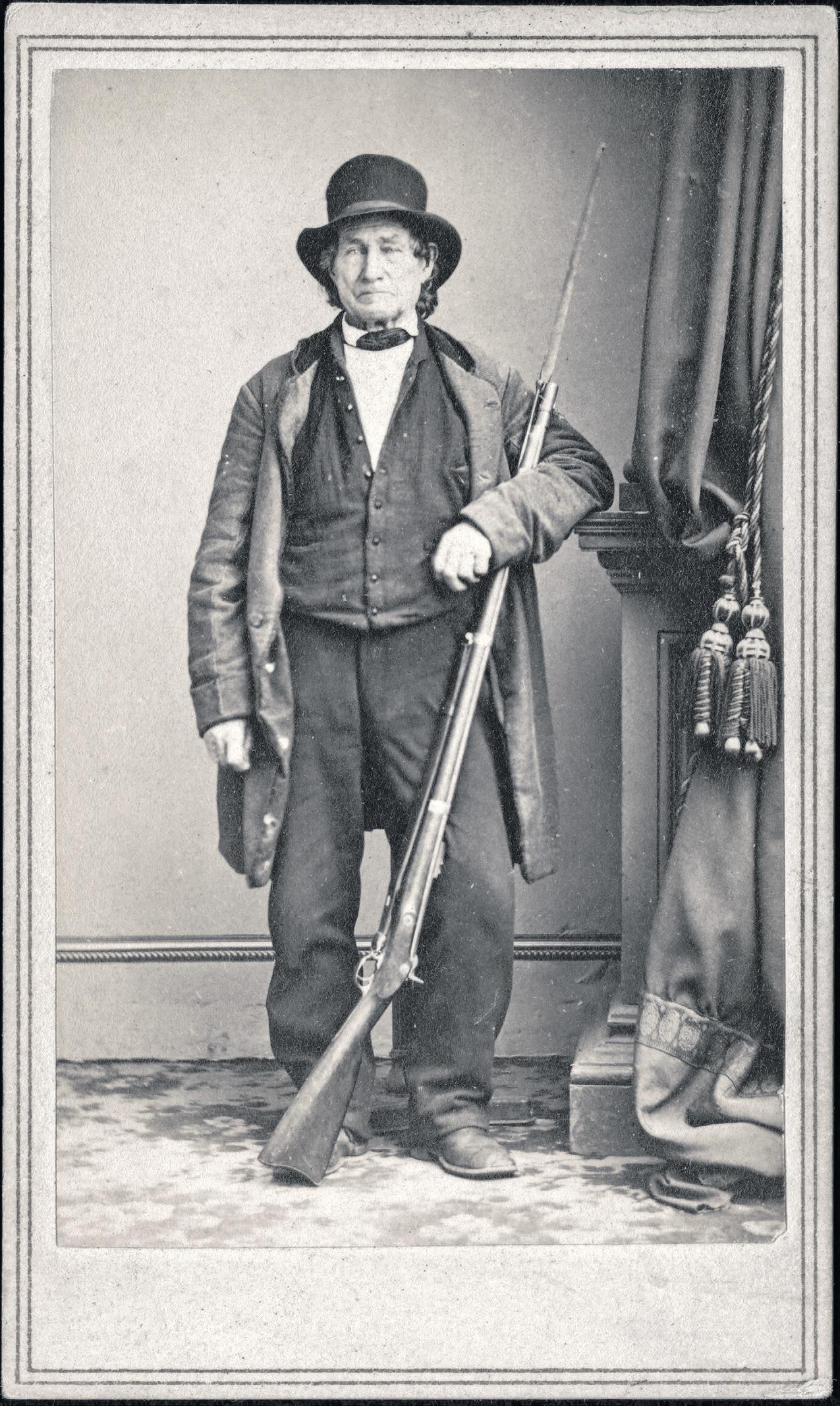
Creator: Brady’s National Photographic Portrait Galleries, photographer, New York: E. & H.T. Anthony, 501 Broadway.
Medium: albumen print on card mount; mount 11 x 7 cm (carte de visite format).
Endnotes
1. The Knickerbocker (a New York magazine), quoted in Robert Taft, Photography and the American Scene: A Social History, 1839–1889 (New York: Dover Publications, 1964 [1938]), 3.
2. Taft, Photography and the American Scene, 4-6, 14.
3. Taft, Photography and the American Scene, 39, 43, 46, 55, 57, 59.
4. Taft, Photography and the American Scene, 223-25; Allan R. Millett and Peter Maslowski, For the Common Defense: A Military History of the United States of America (New York: Free Press, 1994 [1984]), 153; Errol Morris, Believing Is Seeing (Observations on the Mysteries of Photography) (New York: Penguin Press, 2011), 3-4.
5. Taft, Photography and the American Scene, 7-8, 101, 103, 105-106.
6. Michael Fellman, “Foreword” in Ronald S. Coddington, Faces of the Civil War: An Album of Union Soldiers and Their Stories (Baltimore: Johns Hopkins
University Press, 2004), x; George Gilbert, Photography: The Early Years A Historical Guide for Collectors (New York: Harper & Row, 1980), 37.
7. Gilbert, Photography, 39; J. Matthew Gallman, “Foreword” in Ronald S. Coddington, African American Faces of the Civil War: An Album (Baltimore: Johns Hopkins University Press, 2012), xvii; James D. Horan, Timothy O’Sullivan: America’s Forgotten Photographer (New York: Bonanza Books, 1966), 13, 23; Fellman, “Foreword,” x-xi.
8. Gilbert, Photography, 55-56, 58; Stephen B. Oates, With Malice Toward None: The Life of Abraham Lincoln (New York: Harper & Row 1977), 171; Harold Holzer, Lincoln at Cooper Union: The Speech that Made Abraham Lincoln President (New York: Simon & Schuster, 2004), 6, 105; James D. Horan, Mathew Brady: Historian with a Camera (New York: Crown Publishers, 1955), 31; Taft, Photography and the American Scene, 158.
(Liljenquist Family Collection, Library of Congress)
Abraham Lincoln-Hannibal Hamlin campaign button for 1860 presidential election. These small buttons were manufactured by the thousands. Medium: sixteenth-plate tintype, trimmed to circle; 2.5 cm diameter (frame).
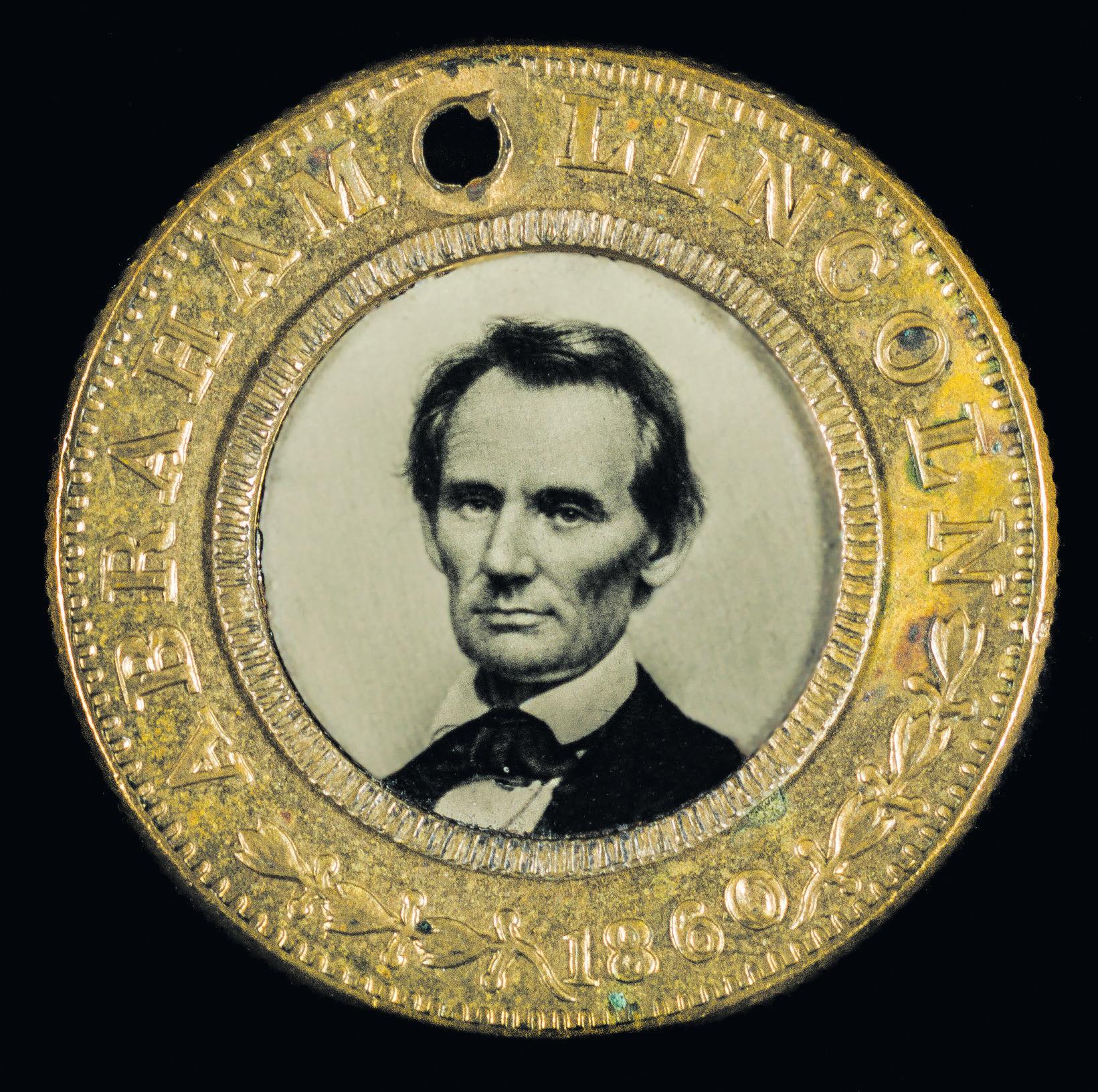
(Liljenquist Family Collection, Library of Congress)
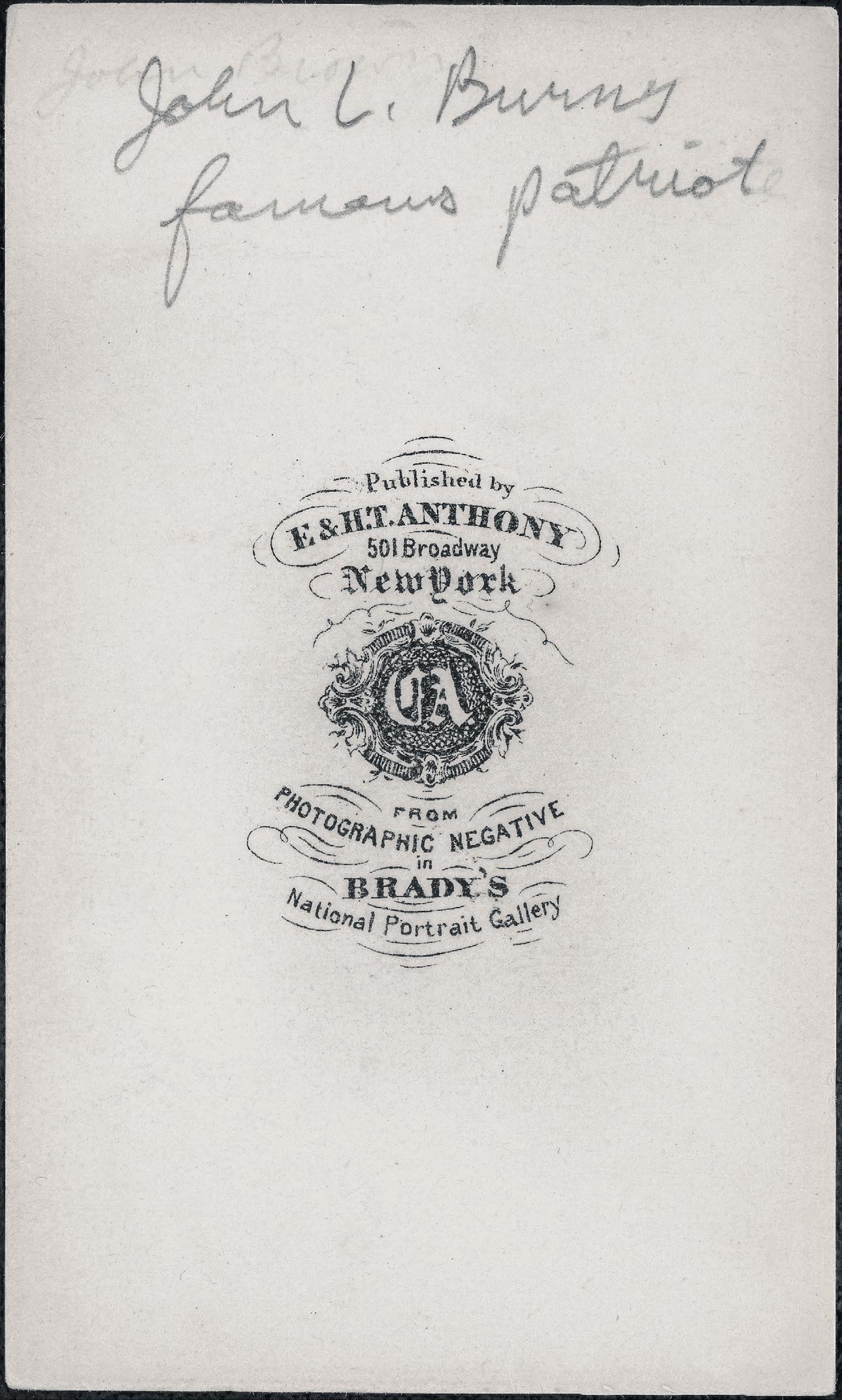
In rare instances, the Compiled Service Record (CSR) of a Civil War soldier contains little gems of history. The CSR of Robert Clifton Wood includes one such gem, the transcript of his trial for murder. On Dec. 19, 1864, Lieutenant Colonel Robert C. Wood, 14th Missouri Cavalry Battalion rode to Confederate headquarters to obtain a pass to visit a local town. That innocent-seeming desire for a pass set in motion events that resulted in murder.
In late 1864, Major General John B. (“Prince John”) Magruder had been made commander of the District of Arkansas. “Known to be a very strict disciplinarian,” Magruder commenced reorganizing the cavalry corps of the district. General Jeff Thompson’s Division of Missouri cavalry, part of General Sterling Price’s cavalry corps, was ordered to a rest camp at Lanesport, a small community in southwest Arkansas. Faced with slack discipline and rampant desertion, Magruder wanted all his officers, particularly regimental commanders, at their posts at all times, in order to enforce discipline and good order. He also did not want officers setting the men a bad example by gallivanting off on leave, an all-too-common practice in the cavalry. Thus he issued an order forbidding any leave without his consent.
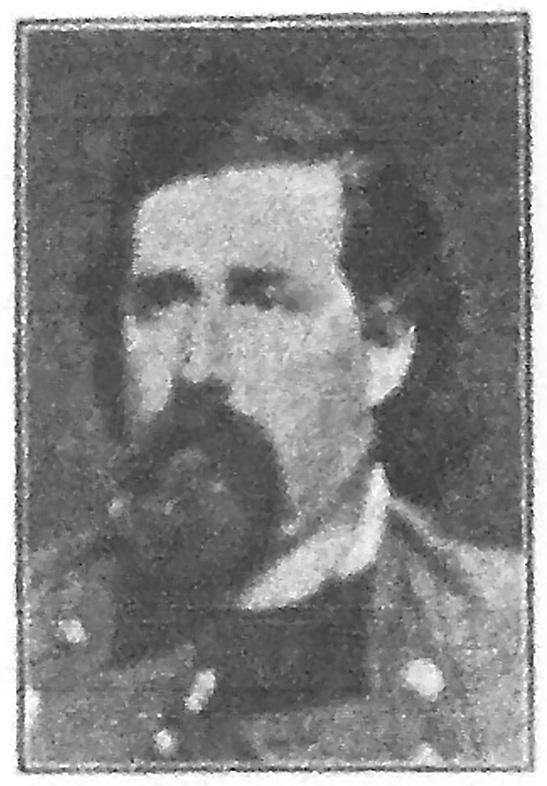
As General Thompson later recalled, “...several of our Colonels were sadly disappointed by the order. The day after the order, several gentlemen came to my ‘shebang’ to get me to approve their application. I declined doing so. Among them was Col. Wood, who was very anxious to visit the town of Washington and was importunate in his earnestness, and said that if I could sign the application that he would get it signed by Genl. Price and guarantee me no trouble about it. I told him that McLean [sic] would not approve it, unless with special orders from Genl. Price. At last I was over-persuaded and approved the application.” To his dying day Thompson regretted his approval and its unintended result.
Robert Clifton Wood was born Feb. 20, 1828, in Charlotte County, Va., of “fine old colonial stock, who never missed a fair, a fight, or a horserace.” At the age of 14, his parents moved to Saline County, Mo. Three years later he left home for the American West, becoming, in the words of an Arizona newspaper, “a splendid specimen of the American
pioneer, ... soldier, scout, adventurer, statesman, partizan, friend ...” After adventures in the southwest fighting Indians, he settled in California and bought a ranch. At the start of the war he hastened back to Missouri to join up with “Pap” Price and the pro-southern Missouri State Guard. He raised the 14th Missouri Cavalry Battalion (later known as the 13th Missouri Cavalry Regiment) and won promotion to major, lieutenant colonel, and colonel. He led the battalion during Price’s 1864 raid, earning the reputation of a gallant and zealous commander.
Armed with Thompson’s conditional approval, Wood rode over to Price’s headquarters in Richmond, Ark. Wood had reason to expect Price to approve a pass. Fighting side by side for three years, Price and Wood (who named his son “Sterling” after the general) had become close friends. Price valued Wood as “a remarkably gallant officer and a fine soldier” and knew he was “extremely anxious” to visit Washington. So when Wood appeared at his headquarters in a converted store, Price agreed to issue the pass and ordered his assistant adjutant general, Major Lauchlan Maclean, to write one out.
part in the border troubles. At the beginning of the Civil War, Maclean returned to Missouri.
On June 12, 1861, he was appointed adjutant of a state guard regiment. Promoted to colonel, he served as adjutant general of a state guard division. In 1862 he entered Confederate service on Sterling Price’s staff, rising to the rank of major and assistant adjutant general. In August 1864, General Kirby Smith unofficially promoted Maclean to lieutenant colonel.
Maclean and Wood knew each other well. Early in the war, both had served on Price’s staff. As such they’d lived in the same room for months at a time. All observers believed their relationship to be most cordial, with only one brief falling-out some years before. Both enjoyed high repute in the army. Fellow staff officers later testified to Wood’s “bravery” and “peaceable disposition,” never “bearing any ill-will or malice to anyone.” They also noted that he was “a hot headed man very dangerous if aroused.” Maclean, a bull-necked Scottish immigrant, often appeared “rough,” “abrupt,” “at times very disagreeable and overbearing,” but overall was thought a “brave and gallant officer ... respected by numerous friends.”
The no-nonsense Maclean reminded Price of Magruder’s order forbidding any leave of absence, noting that the pass amounted to a leave. Price realized Magruder’s order bound him, but Price also knew of Wood’s “anxiety to visit Washington immediately ... and that I could make a satisfactory explanation to General Magruder.” Price ordered Maclean to issue Wood the pass.
Maclean wrote out the pass and gave it to Wood, grumbling audibly that granting the pass ‘’was contrary to Gen. Magruder’s orders ... he feared trouble or difficulty would be produced by
it.” To Wood, Maclean’s grumbling implied that Wood “was imposing on the good nature of Gen. Price to obtain favors it was wrong to grant, and which might bring trouble upon Genl. Price.” Angered, Wood handed the pass back to Maclean, saying, if you think the pass is contrary to orders, “you had better tear it up.”
A relieved Maclean told Wood, “well Bob this is the best conclusion you could have come to,” and tore up the pass. Maclean then left to go to an upstairs room and join fellow staff officers, who were packing up in preparation for a move.
A few minutes later Wood, still seething, approached Price again and requested that another staff officer, Major George Gallagher [George Aiken Gallagher (1826–78), a Harvard-educated prewar lawyer in Little Rock], give Wood a pass. Price told Wood he should have kept the pass he got, but after a few minutes consented to Wood’s request.
and will die in a few minutes.” Unnoticed in the scuffle, Wood had pulled out a knife and stabbed Maclean through the chest. Friends placed the seriously wounded man on a sofa, where they noted a spreading bloodstain on his shirt. A doctor came within seconds.
Lauchlan Allan Maclean was born in Argyleshire, Scotland, May 6, 1820. Around 1843 he came to Lafayette County, Mo., to teach school there and in Saline County. “A highly educated Scotchman,” Maclean married a local girl and adopted the proSouthern attitudes of the community. He served in the Missouri volunteers during the Mexican War. Upon his return home the voters of Lafayette County elected him county surveyor. In 1855 he took a job with the office of the surveyor general of the Kansas Territory, and played a prominent
Wood set out to find Gallagher, climbing the same steps to the upstairs room Maclean had just climbed. Going up the stairs and into the upstairs room, Wood passed Maclean, who had paused by the top of the steps, but ignored him completely. Gallagher and Maclean, who roomed together there, had their overcoats on and, with the help of several other staff officers, were enjoying a few drinks. Wood told Gallagher that Price had ordered Gallagher to issue the pass. As Gallagher started to write out the pass, Maclean, who was standing just behind Wood, took out a bottle of whisky, swallowed a swig, then, in a friendly gesture, handed the bottle to Wood, saying “Bob, won’t you take a drink?” Wood, still angry, turned and replied “I will drink with no such man” (or, as some witnesses recalled, “damned man”) “as you are.” Wood then slapped Maclean in the face. Maclean grabbed the bottle, described by witnesses as square, with sturdy sides, and struck Wood over the head with it, shattering the glass. The large hat Wood wore cushioned the blow, and Wood suffered only minor cuts. The burly Maclean jumped on Wood, grappling him, and pinning him to the wall. As they struggled, the officers in the room rushed to separate them. As they reached the combatants, Maclean jerked loose from Wood, ran back a few feet, and drew his pistol. Two staff officers grabbed Maclean’s hand before he could fire, It was then Maclean announced “I have been cut
Wood descended the stairs to tell General Price “that he had stabbed Maj. Maclean and he would do it again under the same circumstances ninety nine times out of a hundred.” Later Wood told Gallagher he “regretted exceedingly that it had occurred ... when [I] stabbed him [I] did not want to kill him.” It was at first thought that the wounds might not be mortal, and Maclean appeared to be recovering. However, the knife blade had penetrated Maclean’s lung. Infection set in, and three days later “poor Maclean” died, “regretted by us all.” Maclean was buried in an unmarked grave in a churchyard about a mile from Richmond, Ark.
On Jan. 2, 1865, General Magruder convened a military court to try Colonel Wood. The charge was murder, but, curiously, charged murder not under military law but under Arkansas civil law.
The witnesses, General Price and the half-dozen staff officers at his headquarters that morning, all agreed on the facts, though their recollections differed slightly. The attorneys for both sides disagreed on how to interpret those facts. Wood’s defense attorneys, partners in a top-notch local law firm, contended that Wood had been “insulted” by Maclean’s reluctance to issue the pass, an insult no officer with “a sense of honor ... pride ... [and] chivalry” could ignore. The crux of the defense was the contention that, when Maclean smashed the bottle over Wood’s head, it was an assault that threatened Wood’s life, or at least could be seen by Wood as such, justifying Wood’s use of deadly force to defend himself with the knife. At that point, Wood did not intend using the knife to kill, only to fend off Maclean, who was described as “a very powerful man … almost a giant in size.” On the larger issue of intent to murder, Wood obviously had not come into the room with any intent to do Maclean harm and, as testimony showed, after the fight Wood regretted ever pulling his knife out. In short, the defense argued that Wood acted in self-defense. Alternatively, should it be determined that Wood did not act in
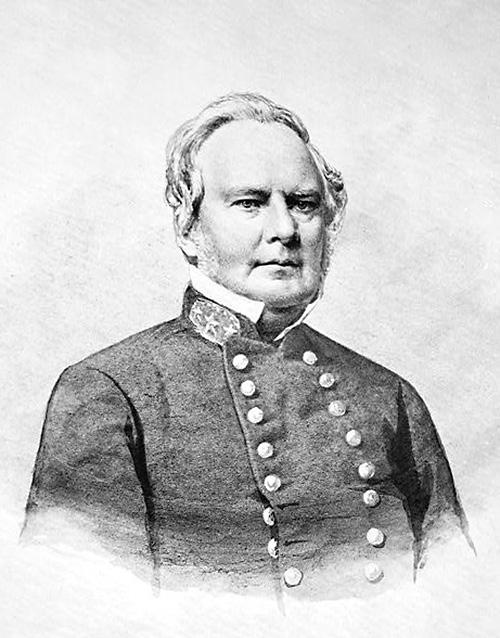
self-defense, the lawyers argued Wood never had any malicious intent to kill Maclean and thus could not be found guilty of murder.
The prosecution presented the events of the killing as the act of an unreasonable, irate officer. Since Maclean’s reluctance to issue the pass stemmed from department orders, not personal spite, Wood had no right to feel insulted. Maclean’s offering the bottle to Wood, calling him by his familiar name of “Bob,” proved that Maclean held no grudge against Wood and was still on cordial terms with him. It was Wood’s slap, induced by Wood’s anger, that started the fight. It was Wood who first hauled out a deadly weapon. Thus, Wood must be held accountable for the fight’s consequences. As to intent to murder, under Arkansas law,
the very act of the stabbing implied all the intent necessary for a murder conviction.
The court found Wood guilty of murder in the first degree and sentenced him to be shot by a firing squad. However, nobody, including the judges, three high-ranking officers, desired to see a brave officer executed at a time when every fighting man was needed at the front. Two weeks later, General Magruder intervened.

On Jan. 20, 1865, Magruder wrote Department Commander Gen. E. Kirby Smith, endorsing the court’s plea for clemency, and adding “there is much sympathy felt here for this gallant officer who is closely confined.”
The combined pleas worked. On Feb. 8, Smith returned Wood to duty, pending the result of Smith’s application to President Davis for pardon. Given that the
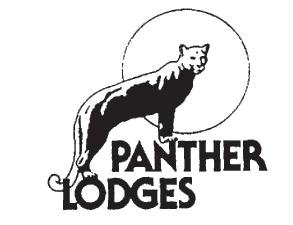
Trans-Mississippi Department was cut off from Richmond, Smith knew the application might not even reach Richmond, let alone be acted upon, for many months. In essence, Smith pardoned Wood. In the coming months, additional companies were assigned to Wood’s battalion, forming a new regiment under his command. Wood finished the war with the rank of full colonel. Instead of a firing squad, he received a promotion.

After the war Colonel Wood returned to the Southwest, settling in Arizona. Known as one of the territory’s biggest ranchers and miners, “Colonel Bob,” as his neighbors called him, died in Tucson Oct. 12, 1902. He is buried in Tucson City’s Evergreen Cemetery. As a local newspaper headlined, “A Life of Adventure and Fidelity to Friendship and
Principle Comes to an End.”
Sources:
• Wood’s compiled service record, National Archives.

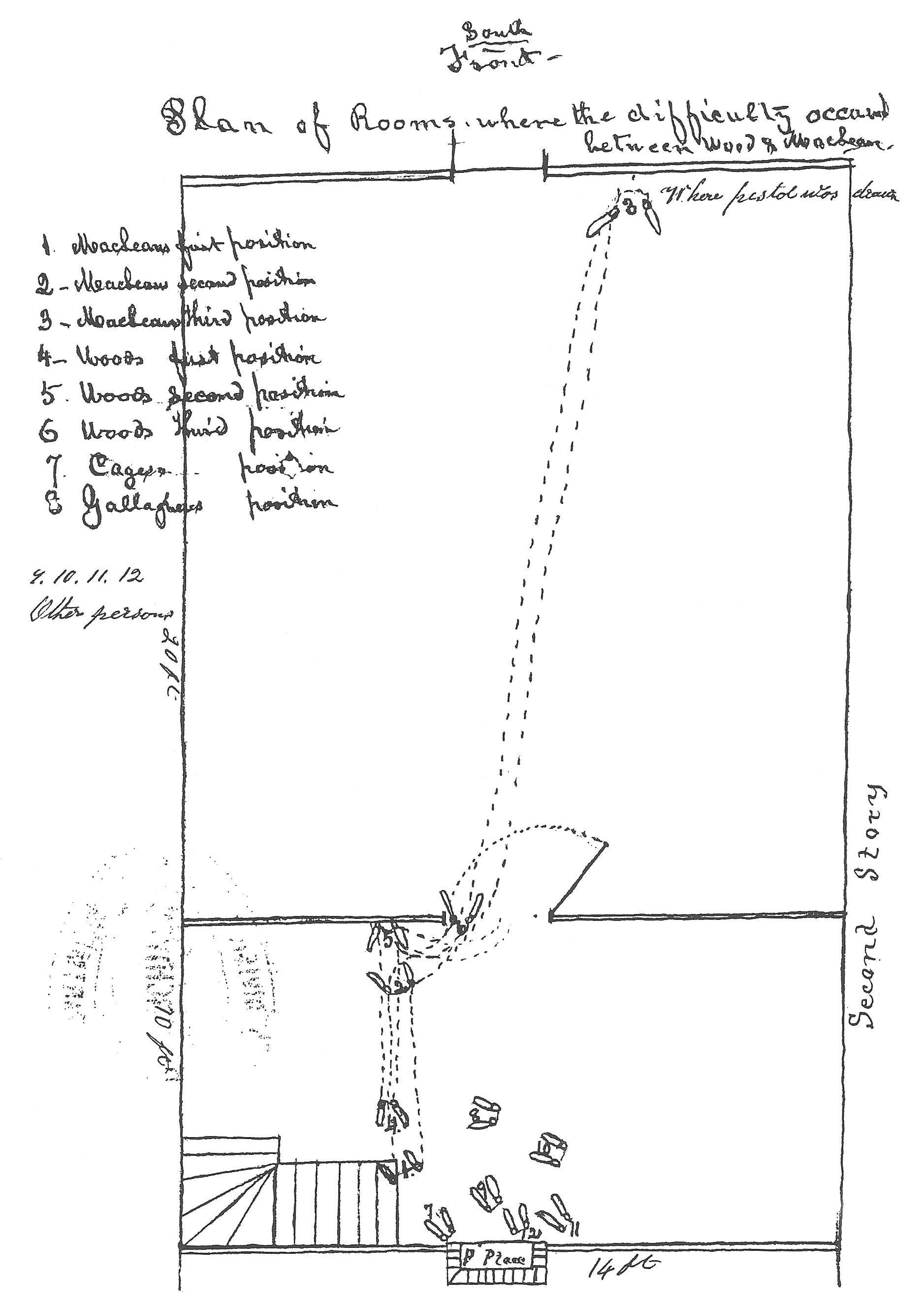
• Cynthia D. Pitcock and Bill Gurley (eds.), “I Acted From Principle”: The Civil War Diary of Dr. William M. McPheeters, Confederate Surgeon of the Trans-Mississippi (Fayetteville, U. of Arkansas Press, 2002).
• M. Jeff Thompson, Reminiscences of General M Jeff Thompson, edited by Donal J. Stanton, Goodwin F. Berquist, and Paul C. Bowers (Dayton, Morningside Press, 1988).
• William E. Connelley, Doniphan’s Expedition and the Conquest of New Mexico and California (Topeka, Crane & Co., 1907).
• Information on Col. Wood, including undated newspaper clippings, supplied by his great-nephew, Rock P. Wood of Mobile, Ala.
Prof. Allardice has authored More Generals in Gray (LSU Press, 1995) and Confederate Colonels: A Biographical Register (University of Missouri Press, 2008).


In my December 2018 column, I wrote about problems British troops had during the Sepoy Rebellion in India when their Enfield P53 rifles fouled up so badly after a few shots that reloading became difficult and at times impossible. After analysis, British ordnance experts decided that the problem was traceable to tallow used with beeswax as a bullet lubricant. The tallow’s reaction to the intense tropical heat expanded and hardened it. The problem was solved by eliminating the tallow from the formula and using pure beeswax.
Reader and SUV expert rifle musket shooter Dick Denney took the story to heart and began to experiment with using beeswax as a bullet lubricant, leaving out other substances. He reported that: “The best mix I found was to cut a cube of beeswax one-inch square and add five drops of mineral oil, stir and pour into a wax paper lined large bottle cap for dipping. It improved my scores and I am certain that I am not becoming a better shot on my own.”
So, although we have plenty of effective bullet lubricants to pick from today, if you want to be a true traditionalist, and maybe even improve your shooting a tad, you might want to try beeswax as a retro lubricant.
The Artilleryman Magazine is a quarterly magazine for enthusiasts who collect and shoot cannons from the Rev War to World War II.
Subscription only $34.95/year.
Historical Publications LLC, 520 Folly Road, Suite 25 PMB 379, Charleston, SC 29412. 800-777-1862.

ArtillerymanMagazine.com
Keeping with the British theme, Buffalo Arms Company is now offering Whitworth hexagonal paper patch cast bullet molds for the Pedersoli Whitworth reproduction. The mold, which uses Pedersoli bullet mold handles, casts slugs in .442 inch diameter weighing 556 grains. It is priced at $223.39. Buffalo is also offering hexagonal felt wads for the Pedersoli Whitworth. They are .451 inch diameter and .236 inch thick. A box of 200 wads costs $39.79. For more on these and other Buffalo Arms offerings check out the company’s website at: https://www.buffaloarms. com/.
At the outset of the Civil War, the M1861 Springfield rifle musket was the standard U.S. infantry weapon. Due to the massive increase in manpower, Union army soldiers were subsequently armed with whatever was available, however, including obsolete smoothbore muskets and foreign made weapons of varying quality. By mid-war, availability of the standard arm had increased dramatically, as Springfield Armory boosted productions and contracts were awarded to private gunmakers.
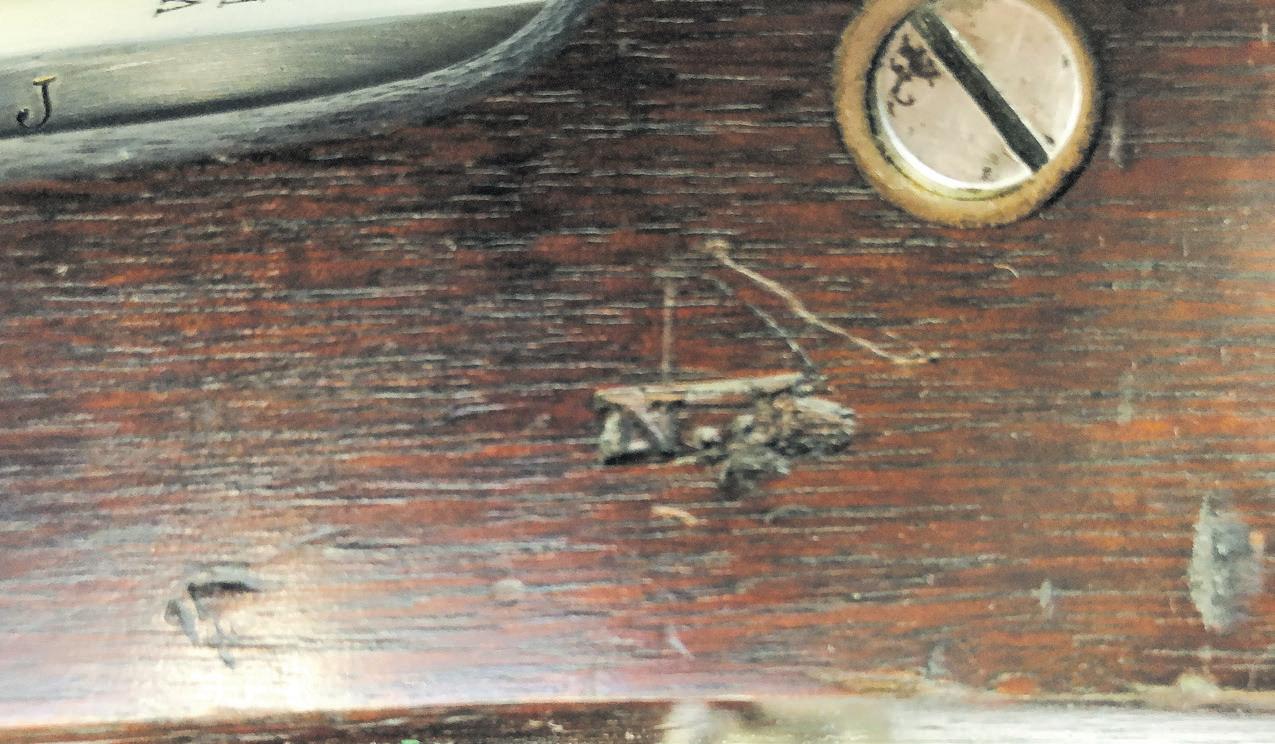
In 1863, New Jersey Adjutant General Robert Stockton, with the approval of Governor Joel Parker, was reforming the state’s militia, and in the process created the New Jersey Rifle Corps. Although units of the old smoothbore musket armed militia still existed, recruits to the new organization were issued distinct uniforms and promised up to date rifled arms. Initially, the Rifle Corps was less than a stunning success, with only six of the authorized fifty companies organized by the end of the year, but those companies were deployed to control a riot that broke out between employees of two rival railroads in November.
In order to properly arm the Rifle Corps, New Jersey
New Jersey state armory in 1863. The rifle, in almost perfect condition will be on prominent display at the museum.
historical consultant and author or editor of 21 books and over 400 articles on N.J. and military history and firearms.
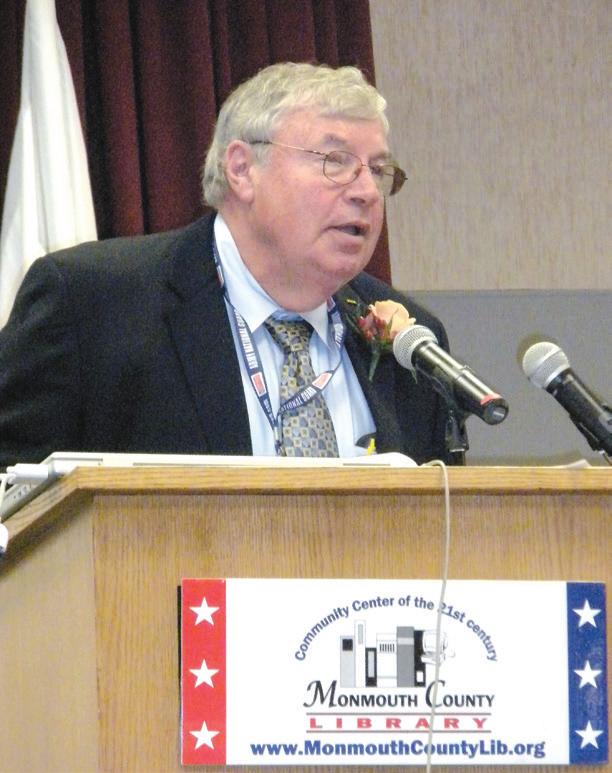
purchased over 9,000 rifle muskets in 1863 and 1864. The first two orders, in July 1863, were to New York arms merchants Schuyler, Hartley and Graham, for 2,500 and 1,500 Colt “Special Model” 1861s, paid for with Federal promissory notes.
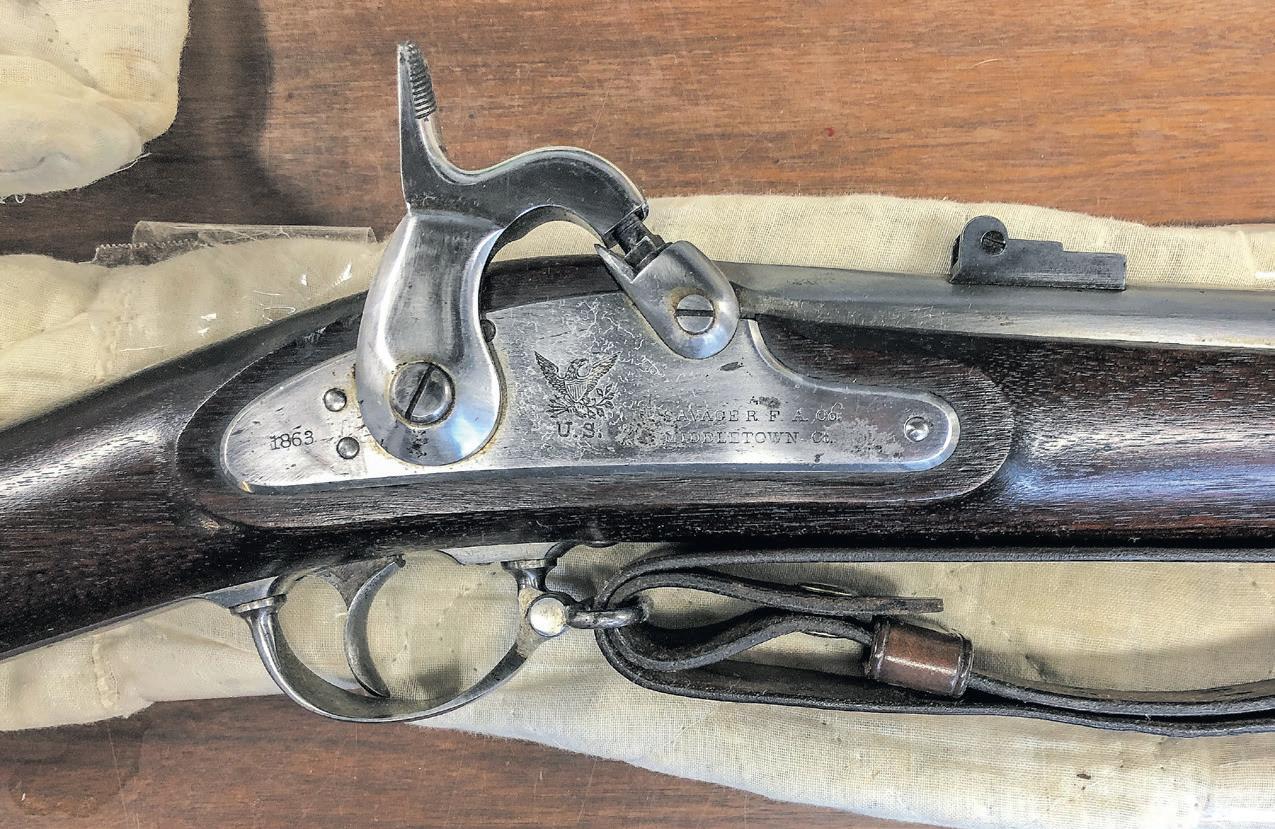
After delivery of the initial Colt order in January 1864, however, the state’s Quartermaster General cancelled the second one. It appeared that Colt, or Schuyler, Hartley and Graham, was trying to dispose of guns that had failed Federal inspection by selling them off to unsuspecting customers. Unfortunately for them, New Jersey had a very sharp Quartermaster General in Lewis Perrine, who saw to it that each weapon was taken apart and carefully inspected by “a competent person” at the state arsenal in Trenton. Perrine reported that “the inspector rejected a great number of parts.” He added that he had “allowed the contractors in every instance to replace the parts rejected for defects with perfect parts.” He did not provide details on why the second Colt contract was cancelled, although one would assume that there was a lack of “perfect parts” to replace the inferior ones.
None of the other contracts, for standard Springfield pattern M1861 rifle muskets, to J.T. Hodge and A.M. Burton of the Trenton Locomotive and Machine Co. in Trenton, or Savage Revolving Firearms Company of Middletown, Conn., were cancelled, so it is safe to assume that those contractors either supplied satisfactory arms or had a ready supply of functional parts. Accepted guns were stamped “NJ” on the barrel and stock opposite the lock to indicate state ownership.
In January 2019, one of those rifle muskets returned home, as a generous Midwestern donor disposing of his father’s large arms collection contacted the National Guard Militia Museum of New Jersey in Sea Girt and asked if that institution was interested in receiving an “NJ” marked Savage M1861 rifle musket. Savage delivered 2,200 rifle muskets to the
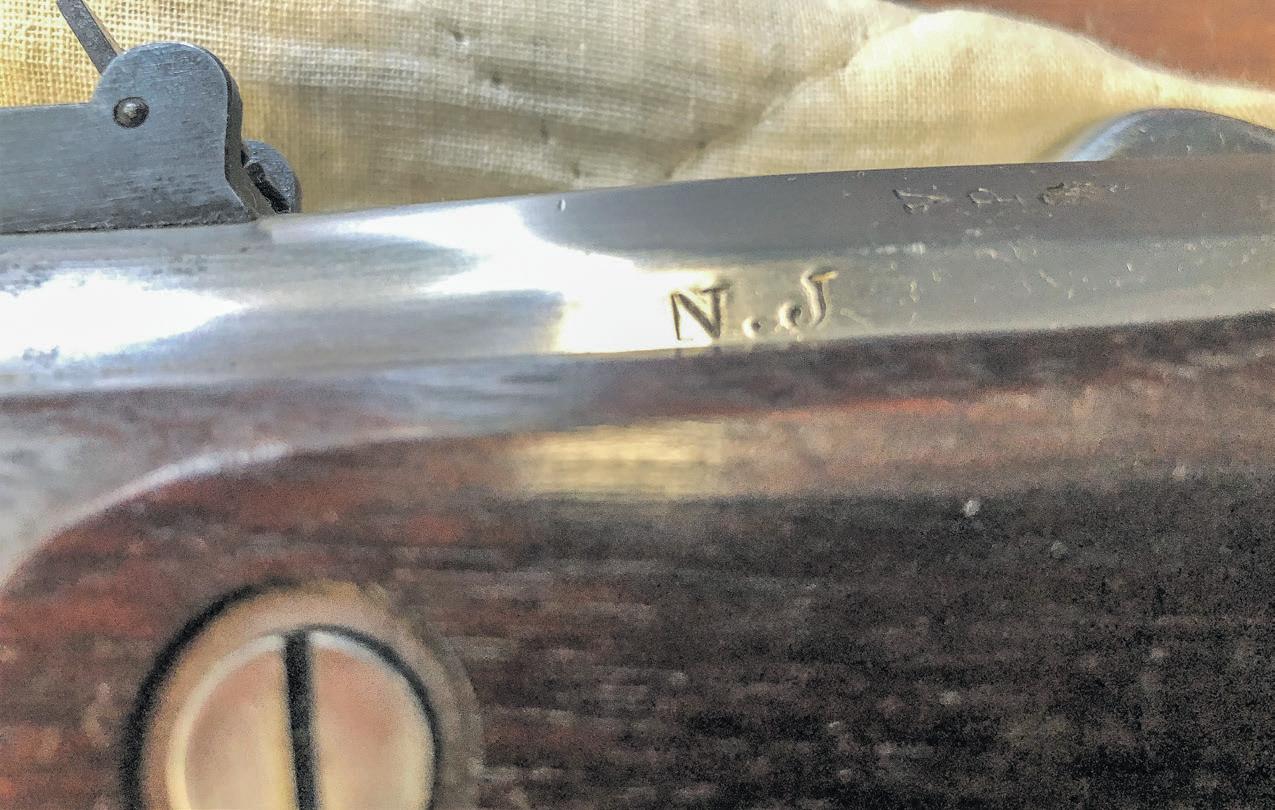
The New Jersey Rifle Corps and the militia were combined into the National Guard in 1869. They continued to use the M1861 rifle muskets Stockton purchased until 1875, when they were replaced with breech loading Springfield rifles. The rifle muskets were stored and sold to legendary firearms dealer Bannerman’s in New York City early in the 20th century. This rifle musket was apparently one of them.
Joseph G. Bilby received his BA and MA degrees in history from Seton Hall University and served as a lieutenant in the 1st Infantry Division in 1966–1967. He is Assistant Curator of the New Jersey National Guard and Militia Museum, a freelance writer and
He is also publications editor for the N.J. Civil War 150 Committee and edited the award winning New Jersey Goes to War. His latest book, New Jersey: A Military History, was published by Westholme Publishing in 2017. He has received an award for contributions to Monmouth County (N.J.) history and an Award of Merit from the N.J. Historical Commission for contributions to the state’s military history. He can be contacted by email at jgbilby44@aol.com.
Deadlines for Advertising or Editorial Submissions is the 20th of each month. Email to: ads@civilwarnews.com
WASHINGTON, D.C.—“We are trying to save land in Virginia where boys from Rochester fought, and in some cases were captured, wounded, or killed,” said Tom Van Winkle, president of the land preservation and conservation group The Central Virginia Battlefields Trust (CVBT). Rochester’s own 140th New York Infantry fought on battlefield property the CVBT is now saving. “Although CVBT is based in Spotsylvania County, Va., we have a national following, and we want it to grow. We are in a race against time to save historic greenspace in this county where people from Rochester fought for the preservation of the Union and we are asking for your help,” said Chris Mackowski, professor at St. Bonaventure University and CVBT board member.
Since 1996 the CVBT has saved over 1,300 acres of “battlefield greenspace” from America’s bloodiest conflict, in the country’s bloodiest county—Spotsylvania, where over 750,000 soldiers fought and 110,000 fell in four battles in a mere 18 months. “Major newsgroups were publishing reports from ‘The Front’ regularly in Spotsylvania. Many Americans would know very well the names of the county’s battlefields, Fredericksburg, Chancellorsville, ‘The Wilderness,’ and Spotsylvania Court House, in addition to the local names of the roads, rivers, and farms, that were fought over,” said CVBT board member
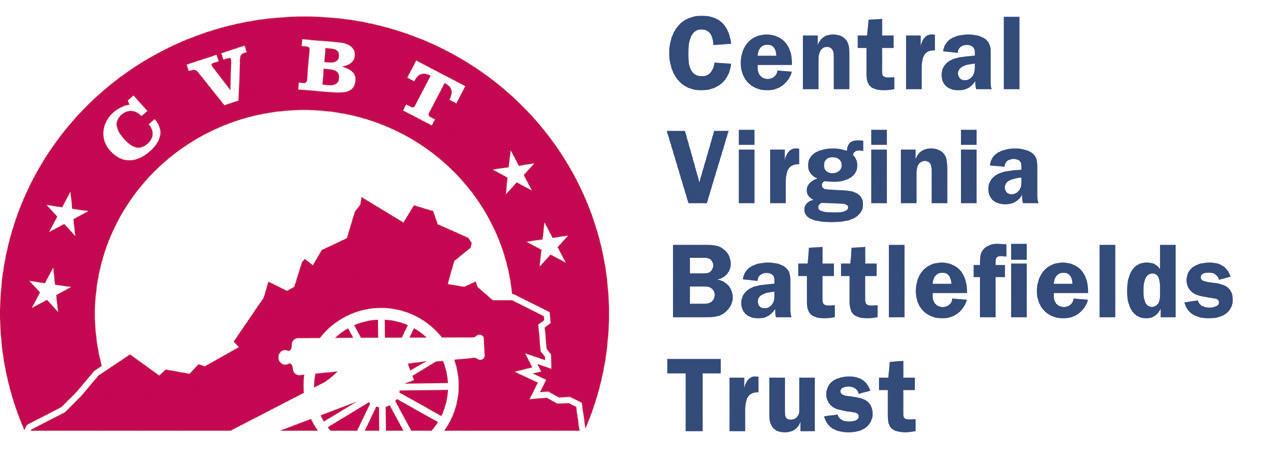
Pete Kolakowski. The four battlefields are ranked in the top ten deadliest battles of the Civil War.
The race with time to save this battlefield land has accelerated since Spotsylvania County, being just 60 miles from Washington, D.C., has been one of the fastest growing areas in the United States. In Spotsylvania, the roads are being choked with rising traffic congestion. Those same roads were also where massive armies marched and bled over in the 1860’s, posing a quandary for preservation and conservation groups.
Compare the rapid growth of Spotsylvania County with the hard reality that the underfunded National Park Service (NPS) owns just 1,500 acres of the 21,000-acre Spotsylvania Court House battlefield, or only 14%. Ironically, Spotsylvania Court House was the third bloodiest battle of the Civil War, lasting 13-days.
The target property the CVBT is now saving is part of the long-neglected fighting in an area known as Myer’s Hill, where Rochester’s 140th Infantry fought.
The fighting at Spotsylvania Court House was also the costliest battle of Union General Grant’s famed and aggressive “Overland Campaign.” Grant’s Federal army suffered 50,000 casualties in the 50 days it slugged through Virginia in 1864; it was a presidential election year, and Abraham Lincoln needed military victories to be re-elected. In 1864 the warfare took on a more modern, and more desperate, feel.
By the time Rochester’s 140th New York attacked Myer’s Hill they had been in action for 9 straight days and lost 315 of 529 soldiers. They were a hard-fighting, “zouave” unit, wearing fez caps and turbans, short jackets, baggy pantaloons and leggings, a popular style at the time.
At 8 a.m. on May 14, the 140th New York Zouaves and another

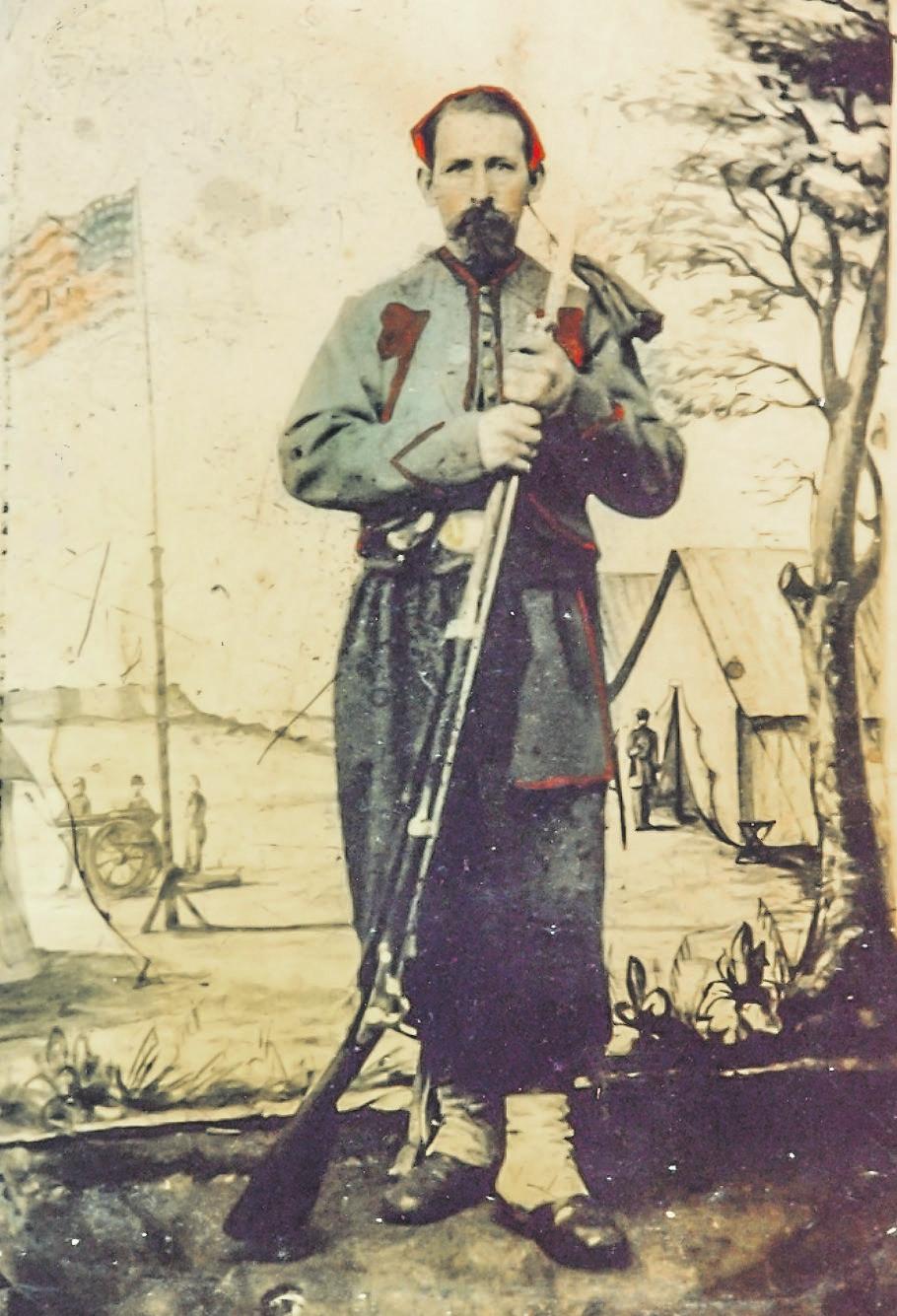
regiment, attacked Rebel artillery and cavalry on Myer’s Hill. “Forward we go with bayonets,” said 140th Private August Seiser, “Under a rain of bullets.” Company B’s John Wetzel was hit in the left thigh, and George Dreschler in the hip. Tim Farrell of Brockport’s Company A took a Rebel bullet in the left foot. John Snyder of Churchville’s Company G was hit by a minieball in the finger.
The 140th took Myer’s Hill from the Confederates. Private Seiser rushed into the Myer House stating, “We reach the top, rush into the building. The rebels take to their heels and quickly we are the possessors.” The 140th set up a defensive position in Myer’s orchard. They were relieved by a 900-man Federal brigade that was later routed by a Confederate counter-attack. In this vicious Rebel assault General Meade was almost captured while directing a Federal picket line. After a fierce Federal artillery barrage, Meade ordered the 140th New York, and over ten thousand other Union troops, to attack and retake Myer’s Hill. A Union soldier said, “The rebs were lying on the other side to avoid our shells which were hissing and exploding around the crest . . .”
Then the Federals attacked. “When all was ready the bugle sounded the charge and we broke from cover like quarter-horses and with a volley of cheers mounted the hill. . . when they heard our cheers supposed a mighty force was coming and so they ran like the Devil.”
Historians have wanted Myer’s Hill preserved for a while. Chief Historian Emeritus of the National Park Service, Ed Bearss, said, “At Myer’s Hill Grant is checked, but he goes back and takes it. The fighting for the hill resulted in a crucial two-day delay for his army.”
Noted Civil War, and Spotsylvania, author Gordon Rhea, said, “It is imperative that Myer’s Hill be saved to enable future generations to walk the ground and understand the momentous events that transpired there.”
Local resident and Spotsylvania Court House historian, John Cummings added, “I’ve been hoping for nearly twenty years to
see this vital property preserved. The human interest stories relating to Myer’s Hill abound, and its preservation and interpretation will greatly enhance the understanding of the two week struggle at Spotsylvania Court House.”
CVBT pays fair market value for historic land. They work with landowners who want to see their property saved for future generations to appreciate and learn about America’s vast history.
Private Seiser wrote after the Myer’s Hill battle, “Deadly tired we throw ourselves onto the wet ground . . . How is it possible to endure such strain and how long will it still last in this way?”
“We want to remember
Rochester’s soldiers, and others, who fought at Myer’s Hill. By protecting this land it helps tell their story. CVBT is also saving greenspace along the way, and, simply put, we need your help to accomplish this,” said CVBT Executive Director, Elizabeth Heffernan. She added, “CVBT’s administrative costs are low at 14%; one of our mottos has been ‘Your green buys green.’”
To join, or to donate to, CVBT visit their website: www.cvbt. org/membership.
For more information contact: Robert Hodge robertleehodge@yahoo.com
leggings, of an Algerian influence—a popular style at the time.

An interesting topic came up on one of the Civil War internet forums about whether a particular musket followed the soldier to whom it was issued should he transfer to another unit. It reminds me of the often quoted passage (by me) about whether P53 Enfields were ever polished or kept blued from John Mead Gould’s History of the 1st, 10th, and 29th Maine. The 90 day recruits of the 10th Maine were reforming and it was noted they had to give up their U.S. M1855 rifle muskets. They had been promised U.S. M1861s if they reupped. They were griping about being issued P53 Enfields instead which they felt were inferior to the U.S. M1855s which they turned in.
The point here is that when infantry soldiers mustered out, or their infantry unit(s) reformed, they were reissued other equipment including their longarms. They did not keep whatever they had before even if they had a preference to do so; clearly, this was involuntary with respect to the Maine troops and they were not happy about it. For what it is worth, they also got new blue uniforms that they remembered as “a good outfit in every way” and continued with “...but look at these Enfield muskets with their blued barrels and wood no man can name.” It is the same passage where the men were later ordered to polish the barrels of their P53 Enfields bright “and kept them so ever after.”
There is a pretty good reason for the policy of longarms remaining with the original unit, and this continued into the modern era with the U.S. Army. Consider that the accoutrements (bayonet & sheath, cartridge box) need to compatible with the new unit. Additionally, the ammunition might be incompatible and the Ordnance Department was reluctant to complicate logistics by keeping track of different types of ammunition needed by one specific soldier within a regiment. This was particularly challenging for the Confederate armies due to the variety of different European imports that were in use. The arms did not belong to the soldier but to the government and, by extension, to the unit. A soldier was issued a weapon and was responsible for its care and maintenance. Normally if he was transferred to another unit due to consolidation (as in the case of the 10th Maine in 1861) or the unit being dissolved due to lack of re-enlistments, arms and equipment were turned in and new ones issued. Also, if you drill it down philosophically, the army views the soldier as the mechanism needed to fire the musket. It sounds callous phrased that way, but it is the fact of the matter. The musket (or rifle) in the firing line pointed at the opposing force is what the army was after. The soldier’s thoughts on the matter were a secondary priority, if considered at all. If the soldier left or was injured, the weapon was simply reissued to another soldier in the company by the Ordnance officer.

Now was this always the case in both armies? We can’t really know definitively; it is the paradox of proving something didn’t happen. You can only go by what period accounts say about the matter when it came up. There is one notable exception that springs immediately to mind. There is a passage in the memoirs of Sam Watkins, 1st Tenn. Maury Grays (CS). In Co Aytch
of Civil War arms. Most of us had always believed that it was a P53 Enfield polished bright, as this was what was issued to most of the 1st Tennessee Maury Grays.
he talks about a fallen comrade presenting him with his prized weapon named Florence Fleming. “Every soldier had to have his gun rubbed up as bright as a new silver dollar. W.A. Hughes had the brightest gun in the whole army and always called it Florence Fleming.” Watkins noted that during hand-to-hand combat at the battle of Kennesaw Mountain, “…a Yankee rushed upon me … and said, ‘You have killed my two brothers and now I’ve got you.’ … I heard the roar, and felt the flash of fire and, saw my more than friend, William A. Hughes, grab the muzzle of the gun, receiving the whole contents in his hand and arm, mortally wounding him… he died for me…When the infirmary corps carried him off, all mutilated and bleeding he told them to give me ‘Florence Fleming’ (that was the name of his gun which he had put on it in silver letters), and to give me his blanket and clothing… It was the last time I saw him.” Hughes died from his injuries and I believe Sam Watkins was permitted to carry Florence Fleming going forward, or that is how he recalls it in his memoirs. If so, does that contradict what we concluded previously? Wouldn’t the rifle ‘Florence Fleming’ be reissued by the company to another soldier at the discretion of the Ordnance officer, not given away by the soldier who was previous owner? While he continually reminds the reader that his memoirs “are not a history,” that is what Sam Watkins says about the matter.
Sam Watkins never addressed what became of ‘Florence Fleming,’ which had the name on the stock “in silver letters.”
Anecdotally, a well-known collector who wishes to remain anonymous states that he saw Florence Fleming one time many years ago in a private collection
For example, Watkins says earlier in his memoirs, “…look out boys, the United States is sending iron over into the Southern Confederacy; let’s send a little lead back to the United States and we would blaze away with our Enfield guns.” The collector recalls though that it was not a burnished P53 Enfield but rather a U.S. M1861 or the C.S. variant made at Richmond (he could not recall which) and further that the name ‘Florence Fleming’ was placed on the stock with tacks.
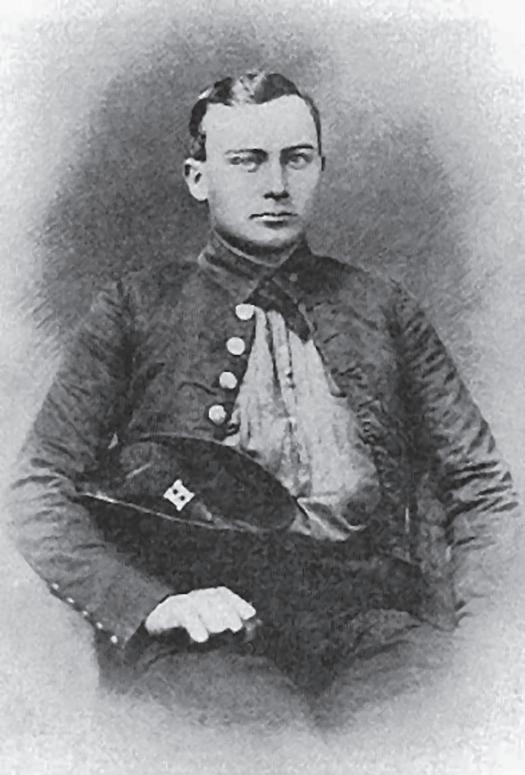
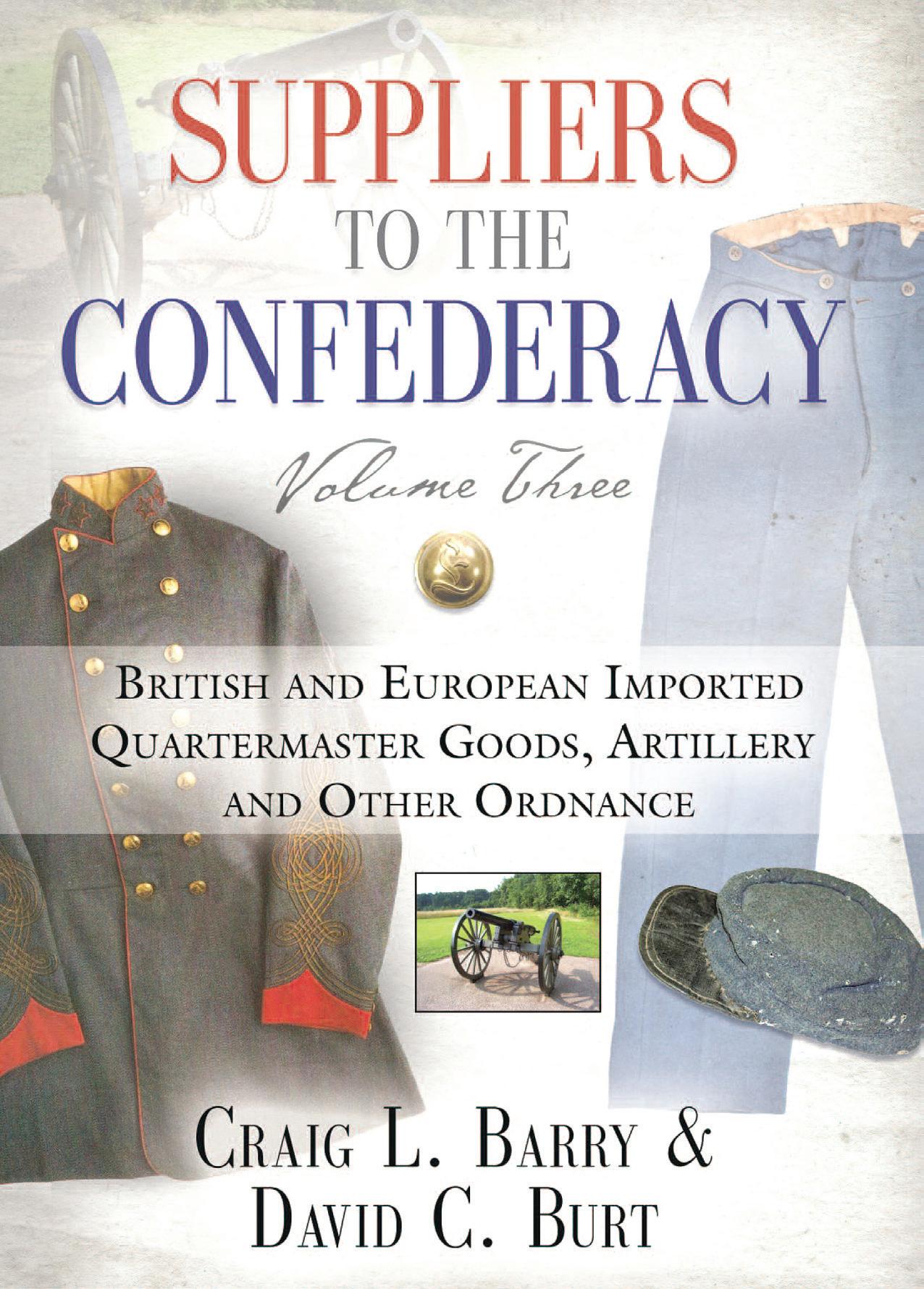
Craig L Barry was born in Charlottesville, Va. He holds his BA and Masters degrees from the University of North Carolina (Charlotte). Craig served The Watchdog Civil War Quarterly as Associate Editor and Editor from 2003–2017. The Watchdog published books and columns on 19th-century material and donated all funds from publications to battlefield preservation. He is the author of several books including The Civil War Musket: A Handbook for Historical Accuracy (2006, 2011), The Unfinished Fight: Essays on Confederate Material Culture Vol. I and II (2012, 2013) and three books (soon to be four) in the Suppliers to the Confederacy series on English Arms & Accoutrements, Quartermaster stores and other European imports.
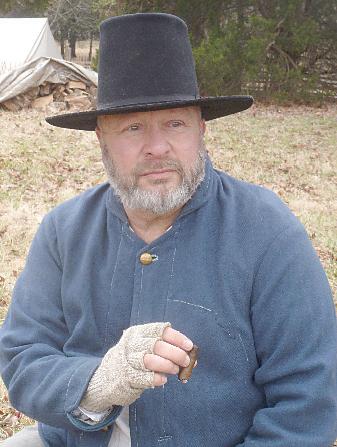
The North Carolina “NC” oval waist belt plate is one of the very rarest and most desirable of the Confederate state plates. Confederate state plates and buckles. The difference between plates and buckles being that the plate is one piece, and the buckle consists of two interlocking pieces. So rare are these NC state plates that I have wanted to purchase one for more than 30 years and this is the first opportunity that I have had of doing so. This example was purchased from the Earl, Roger, and Allan Catlett Collection. The Catletts lived on the Chancellorsville Battlefield and began hunting and collecting in the 1940s. They also purchased rare plates they had not found. Recently they began to deaccession their collection for estate planning purposes and I was fortunate enough to purchase this rare “NC” oval.
Little is known of these rare plates, but we do know something about North Carolina’s actions leading up to the War. Prior to the War, North Carolina did not have an organized militia like many other states; instead they had independent companies such as the Charlotte Grays, the Buncombe Riflemen, etc. These groups tended to wear stock


pattern plates and insignia if they had uniforms at all. The arms and accoutrements that North Carolina drew from the Federal government under the Militia Act of 1808 were identical to those of the United States. These various facts tell us that the NC oval was not a pre-1861 acquisition.
In 1861, North Carolina’s Governor Ellis began a feverish effort to get arms and accoutrements for the coming storm. Prior to the state’s secession, Ellis sent an agent North to purchase arms and accoutrements. He only acquired
cavalry arms; 280 short Enfield rifles, 500 Colt Navy revolvers and 300 cavalry swords, plus powder, lead, and percussion caps. The rifles and swords came from the Northern firm Schuyler, Hartley & Graham. When purchasing swords in bulk, they always came with sword belts, since a sword without a belt was more problem than help. Invariably the “NC” ovals, when found on their original belts, are mounted on a buff Model 1851 type sword belt and there is no known matching cartridge box plate. There is no record to whom these 300 belts and swords were issued, but they were no doubt issued to independent companies as they enrolled into state service.
These early companies would become a part of the 1st North Carolina Cavalry. Photographic evidence exists to substantiate this supposition; there are images of members of the 1st North Carolina Cavalry wearing the rare NC sword belt plate.
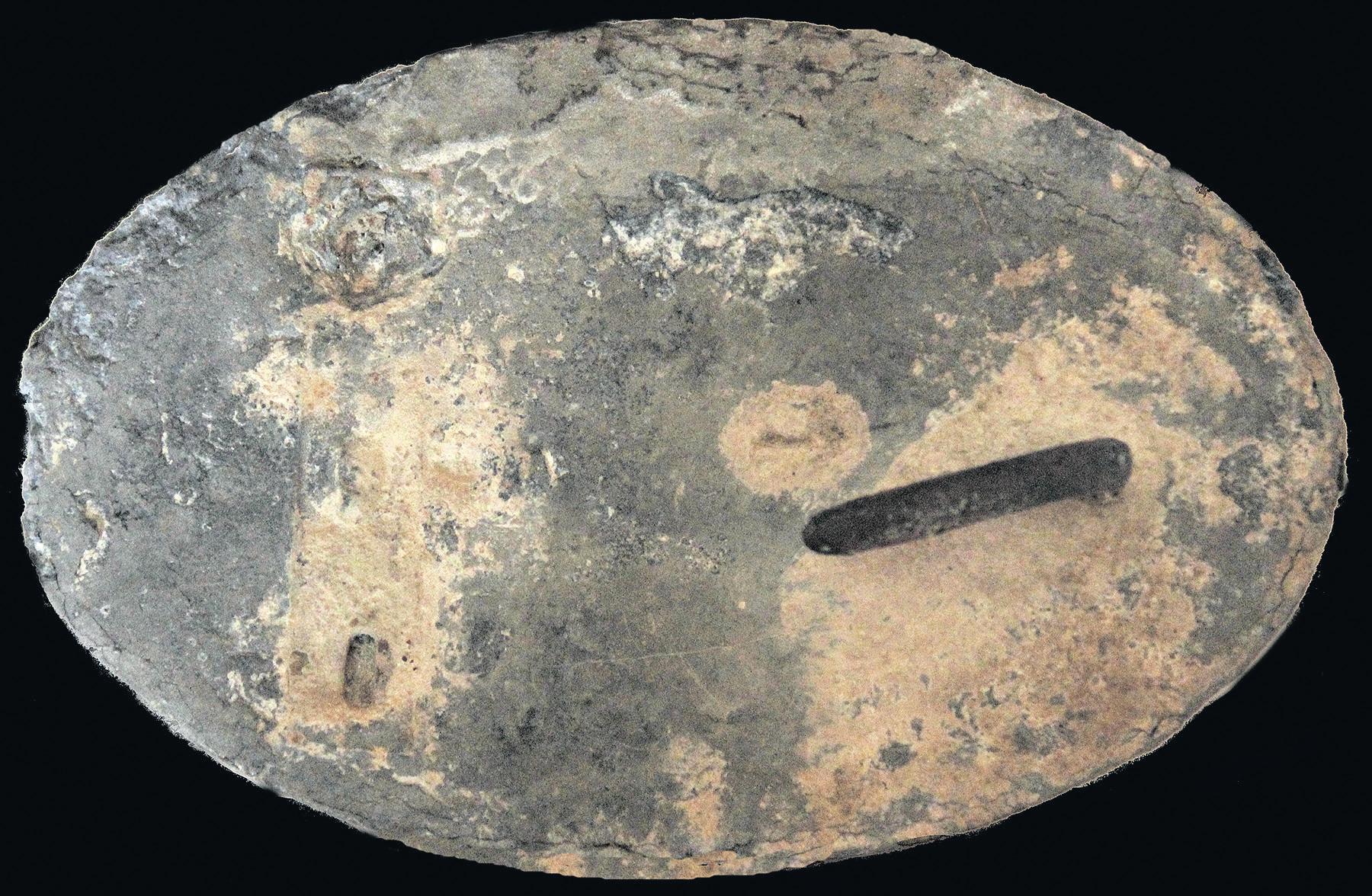
To my mind this leaves virtually no doubt that these “NC” oval plates came from Schuyler, Hartley & Graham in the spring of 1861. Also that there were, at most, only 300 ever produced, if that many, since all 300 from S, H & G were not necessarily this pattern. I only speculate that all 300 were not “NC” because of their extreme rarity. If 300 were issued, I would expect more to survive than are known.
Shannon Pritchard has authored numerous articles relating to the authentication, care and conservation of Confederate antiques, including several cover articles and is the author of the definitive work on Confederate collectibles, the widely acclaimed Collecting the Confederacy, Artifacts and Antiques from the War Between the States, and is co-author of Confederate Faces in Color.
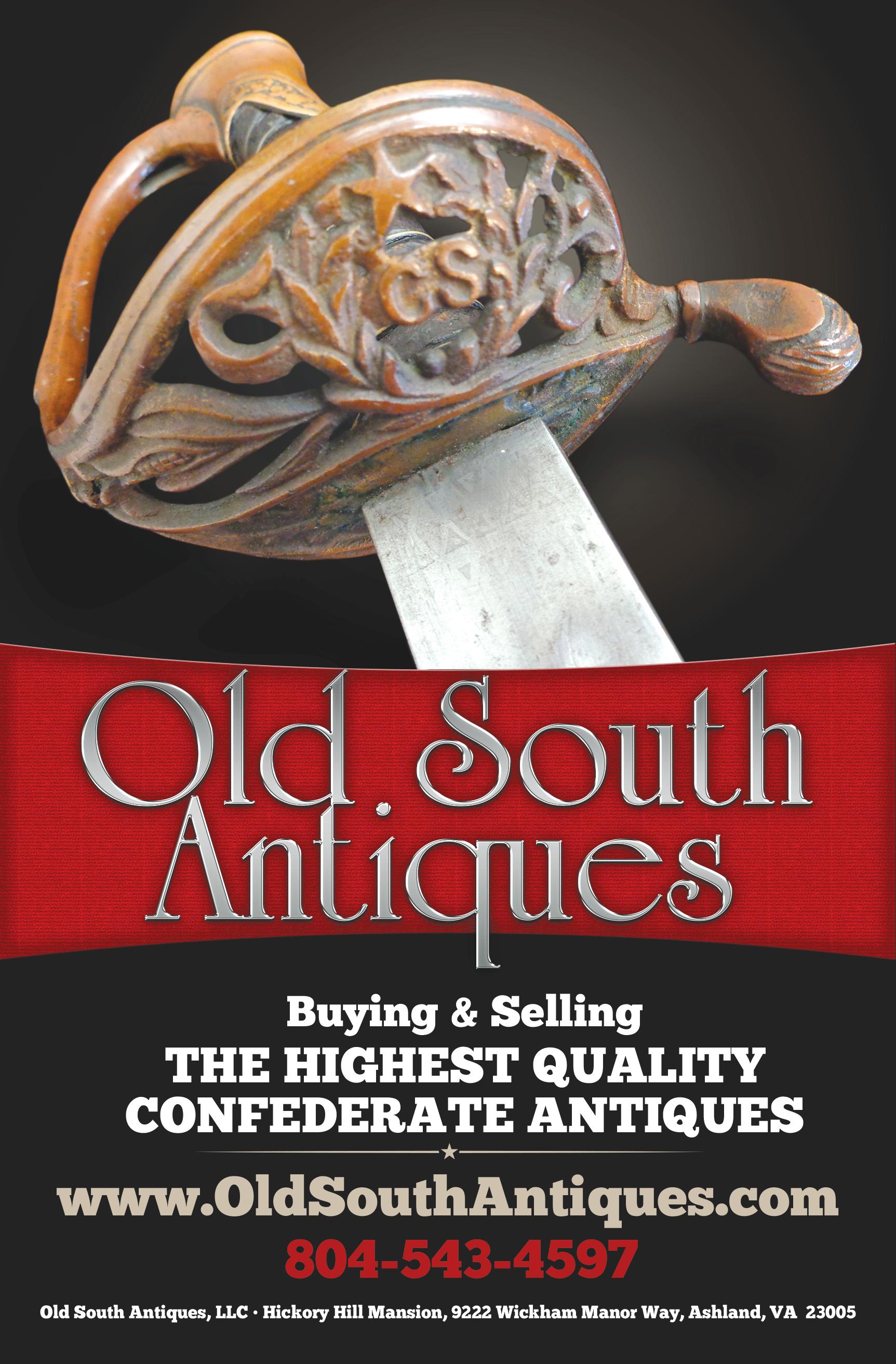
After a week at sea, with its usual sickness, and another spent marching and riding the rails, Private Alfred Abel Rigby and the Twenty-Fourth Iowa Infantry were in need of having their spirits lifted in early August 1864. The troops had arrived in Harper’s Ferry, W.V., after traveling by boat from Louisiana to Washington City, then by rail to Monocacy Junction in Md., and finally Harper’s Ferry, W.V.
After settling in camp and enjoying the scenery, the TwentyFourth and a large number of other arrivals were introduced to General Phil Sheridan, commander of the newly formed Army of the Shenandoah. In his diary entry of August 9, Rigby wrote: “Altho a small man there seems to be a good deal of him. I have much confidence in him as a commander.”
What’s more, General Ulysses Grant was in town, making plans with Sheridan to take control of the rich Shenandoah Valley from Confederate forces under General Jubal Early. The Confederates had arrived back in the Valley after a campaign that had reached the outskirts of Washington City.
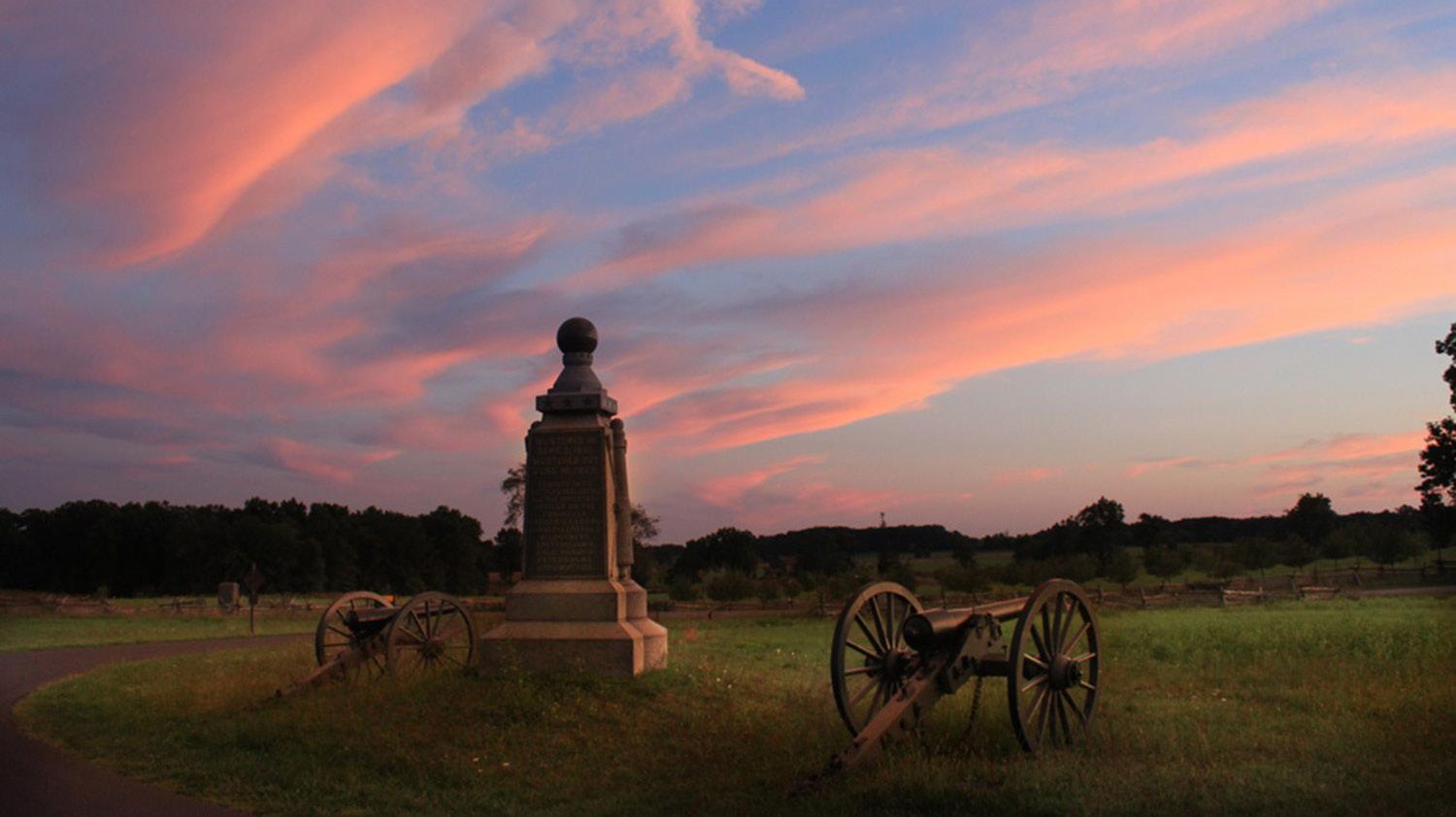
Early’s foray had forced Grant to divert troops from the Army of the Potomac near Petersburg to meet the threat. As a result, Grant devised a plan to destroy Early’s army and deprive the Confederates of the provisions being provided by the fertile valley. He put Sheridan, his feisty cavalry leader, in charge of the new army to do it.
That’s why Rigby’s regiment had been sent almost 2,000 miles by sea and rail to Harper’s Ferry. They had been part of the successful Vicksburg Campaign in 1863 and the Red River Campaign earlier in 1864 that gave the Federals control of the Mississippi River delta.
Rigby enlisted with a group from the Mount Vernon, Iowa, near Des Moines. Born in Ohio, he was teaching school in Iowa at the time. After a ride down the Mississippi River from Muscatine, Iowa, the regiment eventually reached the Vicksburg area. By the time the call came from the east, the Twenty-Fourth had been involved in bloody battles at Champions Hill in Mississippi and Mansfield, La.
The Twenty-Fourth sailed from Louisiana at sunrise on July 23,
1864, aboard The Star of the South and were escorted by a school of porpoises, according to Rigby’s diary. It didn’t take long for sea sickness to set in. At three p.m. on July 25, the ship passed Key West and set a course in the Atlantic Ocean up the east coast. The winds picked up that night and sea sickness got worse.
After arriving at Fort Monroe, the Twenty-Fourth was ordered into Chesapeake Bay and up the Potomac River to Washington City. Along the way, Rigby mentioned passing George Washington’s tomb at Mount Vernon, although he admitted he couldn’t see it because of the trees. From Washington City, the regiment traveled by rail to Baltimore and subsequently on to Harper’s Ferry.
Grant and Sheridan settled on a plan to defeat Early, first by heading toward Winchester with a two-pronged attack along the Charlestown Road and the Berryville-Winchester Turnpike. The Twenty-Fourth marched within the shadow of the western slope of the Blue Ridge to a spot between the mountains and Berryville. It was along the same route Early had taken
when he crossed the Blue Ridge at Snickers’ Gap after threatening the capital. The attack began at 2 a.m. on September 18, just past Opequon Creek in what is known as the “Berryville Canyon” because of the steep slopes. Meanwhile, other Union troops attacked along the Valley Pike. The strategy resulted in a hurried Confederate retreat from Winchester. The Twenty-Fourth went into camp on Sept. 19; the next morning they moved south toward Fisher’s Hill, where the enemy was strongly entrenched.
Sheridan’s forces broke through Early’s defenses at Fisher’s Hill, forcing the Rebels to retreat toward Staunton. The Union army set up camp near Cedar Creek and Sheridan went off to confer with Union leaders in Washington. Early on the foggy morning of October 19, the Twenty-Fourth was sent on a reconnaissance patrol that ran into an all-out Rebel attack.
Rigby’s Battle of Cedar Creek Oct. 19, 1864 diary entry reads:
As I have never given a description of our forces I will give it in order to better understand the difficulties we labored under.

Our works were diagonally
across the valley along the banks of the creek. The 6th and 8th Corps occupying the flanks and the 19th the center. The picket firing during the night created but little suspicion as it was nothing unusual. At 4 Ocl the pickets were deployed in the line with special instructions to be vigilant. At five Ocl the enemy made a feint on the 6th Corps while the main force was being massed on the left flank of the 8th. In order to accomplish this, Gen. Early had occupied the whole night in marching his forces along the base of the mountain single file. Then crawled upon their hands & knees as close to the picket lines as possible without exciting suspicion. At day dawn they marched upon the 8th Corps surprising the camp driving their half formed lines back upon the 19th. This was so sudden and unexpected that no time was given for extending our lines. After a short but stubborn resistance we were obligated to fall back in confusion upon the 6th Corps. In this struggle we suffered our greatest loss. The enemy was checked by the 6th Corps sufficiently to teach them caution in their further movements. Our corps was reformed on
the hights two miles to our right. Here we could see the enemy plundering our camp. At this time it seemed the intention of our commanders to retreat.
Gen. Wright had been wounded early in the morning leaving us without a commander in chief and many of our bivouac officers had already fallen. Our ranks were fearfully thinned and the list of stragglers going to the rear was still greater. Our prospects looked gloomy indeed, and fighting seemed out of the question except for existence.
At 11 Ocl three lines of battle were being formed, the columns already on the retreat recalled and new vigor seemed to be infused in the ranks. Gen. Sheridan had arrived, and to use his own language, said “this work must be stopped. We must camp on our old grounds tonight.” Stockades of rails were hastily thrown up ready for the onset of the advancing foe. It was impetuous but met fearful recoil at the hands of our brave men. The well- directed volleys poured into their ranks checked them, silencing their hideous yells, and drove them panic stricken to a more respectful distance.
After being driven from their strong positions actually retreating then reorganizing a dispirited army and driving an exultant foe from the field, with less than half of his army, in consternation, merits for Gen Sheridan a name among the military heroes of the age. So sure was the enemy of success that many of the women from Strausburg followed the army for the purpose of pillaging.
Our wounded were subject to all manner of insults from those fiends. Ambulances were fired into while passing through Middletown. The secessionist of Winchester were very exultant until news of Early’s defeat reached them which caused quite a reaction in public sentiment.
I had been sent on picket the night before. At four A.M. our suspicions were aroused. When the firing commenced we were satisfied that the enemy was pressing the 8th Corps. The enemy did not advance upon our flank until after they had gained the first work on our flank. We kept up a rousing skirmish, crossed the creek and formed on the bluff between our works and the creek. They made no further demonstrations but stood on the opposite hills and cheered Jeff Davis and Dixie. We did not retreat further
until the balls began to come in our flank. I shall never forget the scene which greeted my eyes upon reaching the breastworks. Our lines were broken, and wagons and men were hurrying to the rear in one promiscuous mass while the enemy’s shot and shell was scattering death & destruction in every direction. I found Major Myers with a squad of the 4th Brigade. We reached the regiment in time to reform. My heart was overflowing with gratitude to God for his preserving care in my behalf and so many of my comrades. Our greetings were truly cordial. We know not how strong are our attachments until so fearfully tested. Col. Wright* soon came to us and kept his command all day though suffering from his wound. Martin did not come to us until noon which relieved my mind of a load of uneasiness in his behalf.
I volunteered with others to go out as sharpshooters and remained as such a portion of the afternoon. Our brigade made one brilliant charge driving the enemy from a stone fence and capturing many prisoners. Surely God has been merciful to me today. I believe that prayer does avail at the throne of Grace. May I never loose [sic] this confidence is my daily prayer.
A silence, ominous, portentious, and forbidding reigned along the lines until four Oclock. It was our turn to take the offensive. The scene which followed was awfully sublime; steadily we drove the enemy amid the screaming of shells, the rattling of musketry and the yells of the combatants. Gen. Sheridan rode along the lines on his white charger speaking words of encouragement to the faint and by his presence enabled all to dare & brave all for the victory.
Before our old works were gained the enemy were in full retreat which was turned to a rout by our invincible cavalry. At sunset we stacked arms on our respective parade grounds. The cheers which rent the air testified of the joy of the warworn veterans who survived.
Our wounded were gathered up and cared for and refreshments taken, the first time since the night before, and a part of our force pushed on to Strausburg, our brigade taking the advance.
On the way we met a Rebel team and a number of pieces of artillery driven by their original drivers, with a “yank” sitting
in front directing the frightened drivers the way to go. The road was nearly obstructed by the abandoned paraphranalia of war. The woods was strewn with small arms & accouterments, our nap sacks and haversacks well filled with plunder. Many of [sic of] the boys made good their losses. Perhaps our loss in killed and wounded exceeds the enemy’s. Our regimental loss in killed, wounded and prisoners is 93. Carlos Weeks was killed early in the morning. Serg’t Rigby**, Sandford Crisman. E. Gabrial, B.C. Zitter, Emory Crisman & John Randue wounded, and Sergt Crisman & Brother missing. Capt. Smith of Co. G. and Lt. Davis, Co. A, taken prisoners. Col. Wilds, left arm was badly shattered and Col. Wright slightly wounded. Not a commanding field officer in our Division escaped unhurt.
We have captured sixty pieces of artillery including what we lost in the morning and upwards of three thousand prisoners. I believe Gen. Early does not command a regularly organized army. Men who escaped in the confusion this evening say that the rout exceeds the one at Winchester. This has been their final effort to retrieve their sinking fortunes prompted by the authorities at Richmond, Non combatants and a spirit of revenge pervoked by our devastating march down the valley. That is[sic it] signally failed is owing to the prompt military spirit of our gallant Sheridan and the determined courage of his command.
Cedar Creek was the last battle for the Twenty-Fourth Iowa. The regiment was camped near Winchester for the rest of the year, spending time building winter quarters and escorting wagon trains. On Nov. 8, 303 soldiers voted in the presidential election, casting 285 votes for President Lincoln. On Jan. 6, 1865, the Twenty-Fourth Iowa left Winchester and traveled by train to Baltimore. From there, the troops traveled by steamship to Savannah, Ga., until the regiment was mustered out on July 17, 1865. While in Savannah, the troops fought a major fire and explosion at a Confederate magazine.
In July, the regiment was provided transportation by boat to Baltimore, train to Chicago, where they changed trains for Davenport, Iowa; there Rigby caught a train for home. Cousins were there to greet him at Mechanicsville, but the train didn’t stop until it arrived at Mount Vernon. There was no one there to welcome him back!
In August, Rigby enrolled in
Cornell College and later became a Methodist minister as part of the Upper Iowa Conference. During the war, Rigby organized prayer groups among the troops and faithfully attended local churches, often in Confederate territory. He married Carrie Nancy Gerard and fathered two sons, Archie Edward and Alfred Gerard. Rigby died on July 8, 1872, age 31 from tuberculosis contracted during the war. His wife remarried in 1881 and lived until 1934.
*Lieutenant Colonel Ed Wright of the Twenty-Fourth, not to be confused with Major General Horatio Wright, the VI Corps commander.
**Sergent Martin F. Rigby was one of Alfred Rigby’s three cousins in Company B. Captain William T. Rigby, who had been promoted on Aug. 6, 1863, also was at Cedar Creek. Nineteenyear-old Jesse W. Rigby had been taken captive in Louisiana on April 8, 1864, and missed the trip to the Shenandoah Valley. All survived the war. Alfred was promoted to Sixth Corporal on July 1, 1865, just before the TwentyFourth disbanded.

Note: This article is the result of a chance meeting between Civil War historian Carl Sell and Dee Hallett at the Bluemont Fair at Snickers Gap in the Blue Ridge Mountains of Virginia during the fall of 2018. Sell had a table selling his books and gave a talk
about Civil War history in the area that day. Sell’s great grandfather, a private in the Thirty-Eighth Virginia Infantry, passed through Snickers Gap in June 1863 on the way to Gettysburg. Hallett, who lives nearby, said her husband, Kirk, had a great-great grandfather who fought with the TwentyFourth Iowa Infantry Regiment in the Shenandoah Valley in the fall of 1864. What’s more, she said, the family had a daily diary kept by Private Alfred Abel Rigby that reported on his unit’s travels during the war. Dee and Kirk subsequently provided a copy of the diary section that focused on Rigby’s experiences on the trip from Louisiana to Virginia and Cedar Creek.
It was Kirk’s grandmother, Stella Rigby Hallett, who copied and typed the hand-written diary. The manuscript is part of the Manuscript Archives and Rare Book Library at Emory University in Atlanta, Ga. Archie E. Rigby, Kirk’s great grandfather, was only two years old when his father, Alfred, died in 1872. Archie’s daughter, Stella, married Reveley Allinson Hallett. They had a son named Edward Reveley Hallett, Kirk’s father.
Contact Carl Sell at sellcarl@aol. com for additional information regarding this story or his books about his ancestors, Jeb Stuart, and Snickers Gap.
“Yanks, if you know what is best for you, you had better make a blue streak toward sunset.” –



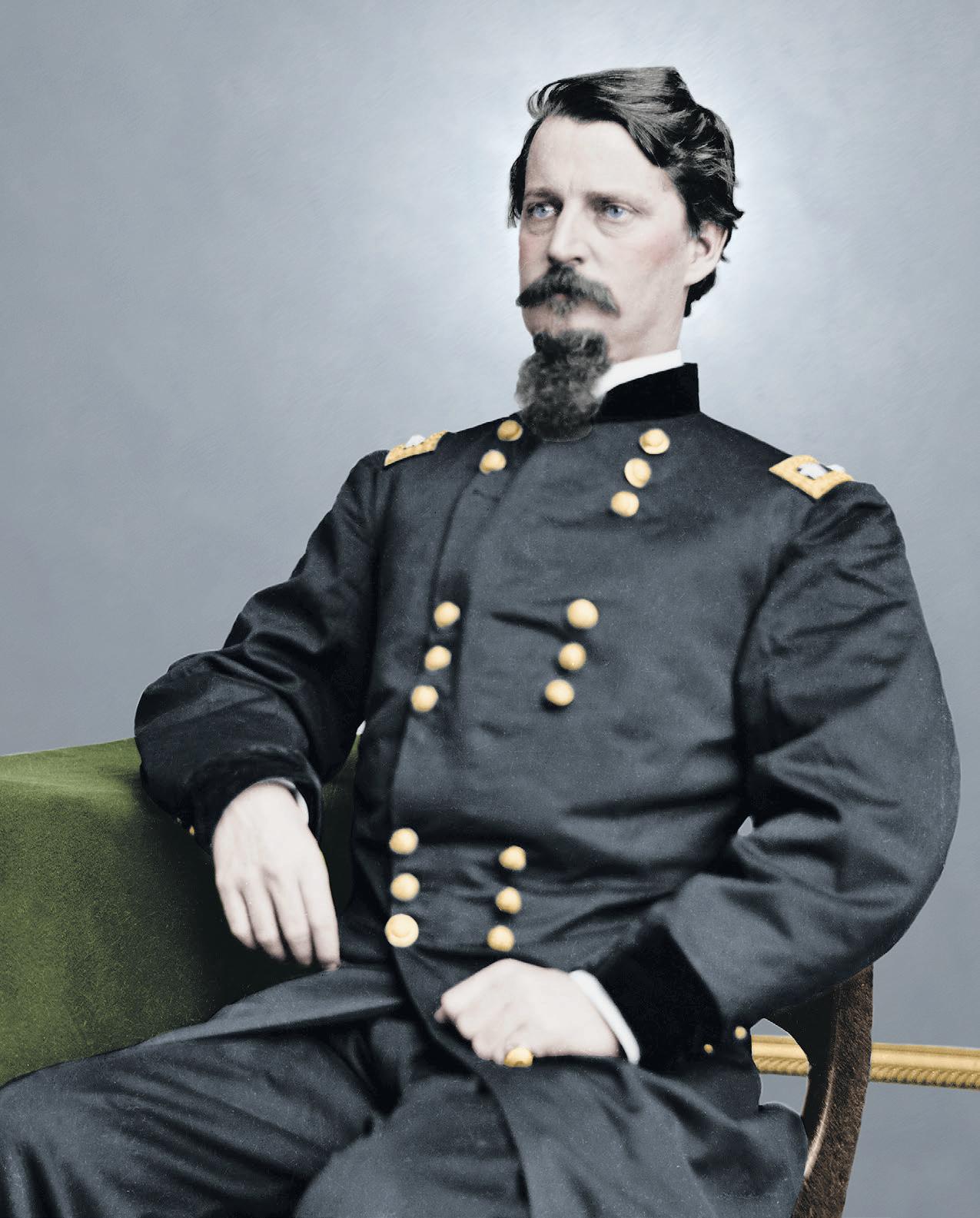
On Aug. 21, 1864, U.S. Gen. Ulysses S. Grant ordered Gen. Winfield Scott Hancock’s 8,500 man II Corps south of Petersburg, Va., to destroy the tracks near Ream’s Station. In what became known as the “Siege of Petersburg,” Grant planned on capturing Richmond by severing the Confederate capital’s supply lines. As part of that effort, Hancock’s men had fought at the Second Battle of Deep Bottom, Va., on Aug. 13–20, marched all night back to Petersburg and now were marching towards Reams Station. They became known as “Hancock’s Cavalry” as they stopped marching only when the staff officers got fresh horses.
“Move down the railroad
... and do all in your power to punish the enemy,” ordered Gen. Robert E. Lee. Lee knew he wouldn’t be able to regain control of the entire the Weldon railroad that connected Richmond to the outside world via Wilmington, N.C., but he wasn’t going to allow further destruction without a fight. Gen. Wade Hampton’s cavalry and generals Henry Heth, William Mahone, and Cadmus Wilcox, of A.P. Hill’s 3rd Corps were ordered to stop Hancock. Wilcox was a popular career military officer. He had participated as a groomsman at the weddings of future generals George B. McClellan and Grant. He served in the Mexican-American War, as executive officer under Lee at West Point, and spent a year in Europe studying warfare tactics. Wilcox wrote “Rifles and Rifle Practice”, the standard text at West Point. He predicted that
improvement in range and accuracy would extend the field of battle, changing warfare. Wilcox advised, “to shelter troops from the enemy’s fire as long as possible without being too far distant, and to hold them well in hand, will probably be the best rule to observe.” The deciding factor for Wilcox to join the Confederacy wasn’t loyalty to his home state but his inability to face fighting his Tennessee relatives.
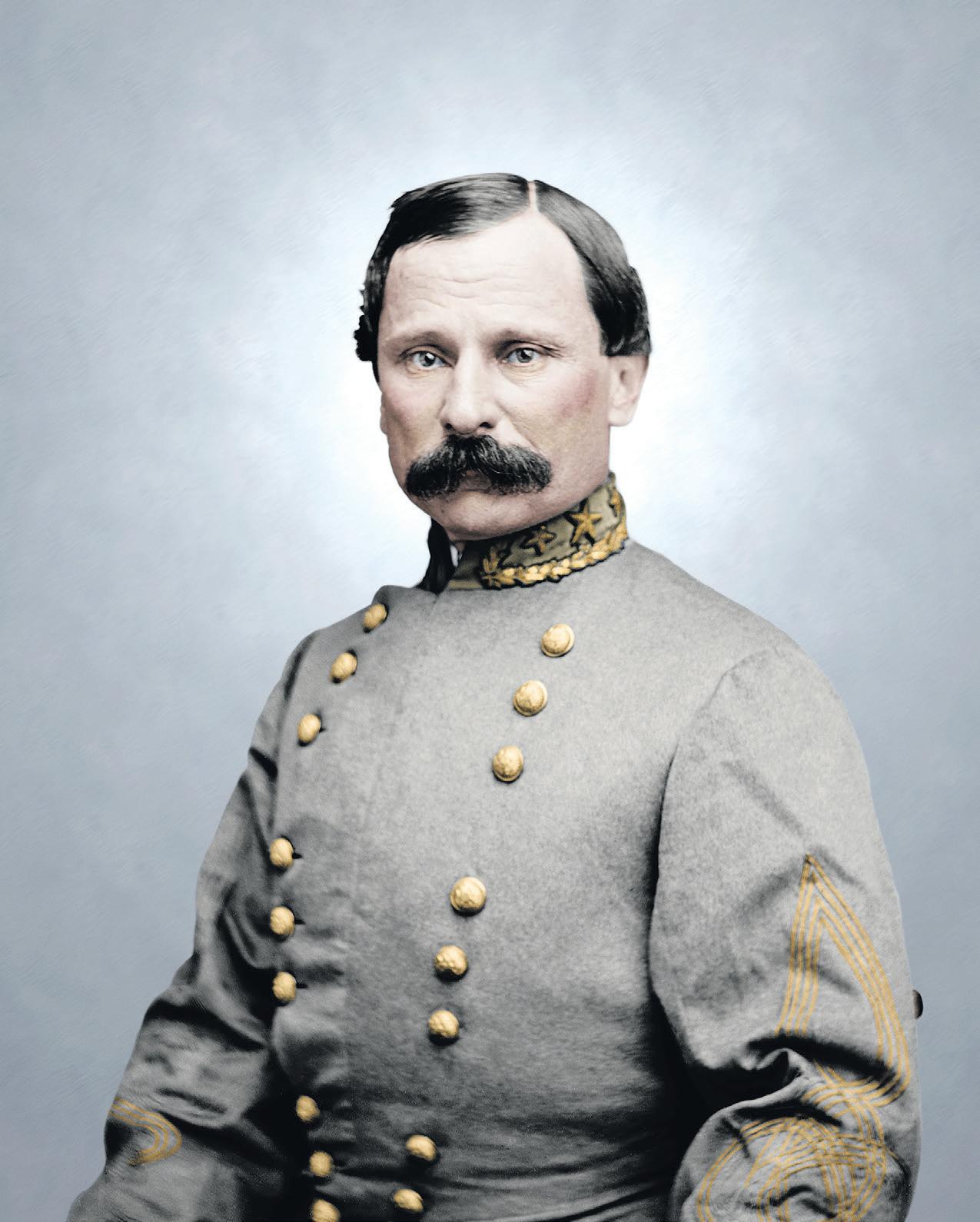
A couple of days destroying railroad track was a nice change of pace for Hancock’s men. On the evening of the Aug. 24, Hancock received a dispatch advising that between eight and ten thousand Confederates were approaching. On the morning of Aug. 25, Gen. David Gregg’s cavalry drove in the Confederate pickets without a counter response. Consequently, Gen. John Gibbon’s division was directed to continue tearing up the tracks.
Gen. Nelson Miles, in his first day as a division commander, ordered his men to strengthen the elliptical shaped line of breastworks Federal troops had built in June. Their valiant efforts were unable to overcome the work’s inherent design flaws.
At 2 p.m. Wilcox’s infantry attacked while Wade Hampton’s cavalry swooped in to push back Gregg’s cavalry. Gibbon’s division stepped in to block the cavalry sweeping around the Federal line before falling back to Reams Station. Heth’s and Mahone’s infantry joined the fray. Snipers in the trees killed 134 artillery horses, immobilizing the Federal batteries. C.S. Col. William Pegram’s eight guns began an intense short range barrage about 5 p.m.
“When the guns fell silent, most of the Northerners emerged from their rifle pits unscathed, but the intense bombardment had demoralized many of the raw recruits recently inducted into the Second Corps. The replacements must have been further shaken as a double assault column raced from the woods toward Miles’s division, emitting their eerie yell.”
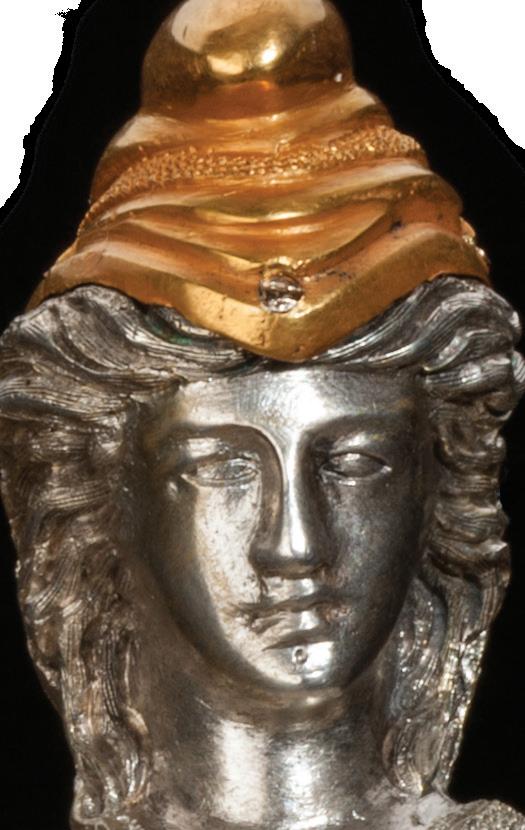
Still the Federals held off the

onslaught. Heth and the color bearer of the 26th N.C. climbed the breastworks, each holding the staff, waving the flag, the general cheering on his men. Farther down, a lone captain of the 26th N.C. breached the works warning the Yankees to run. Having enough, the bluecoats ran.

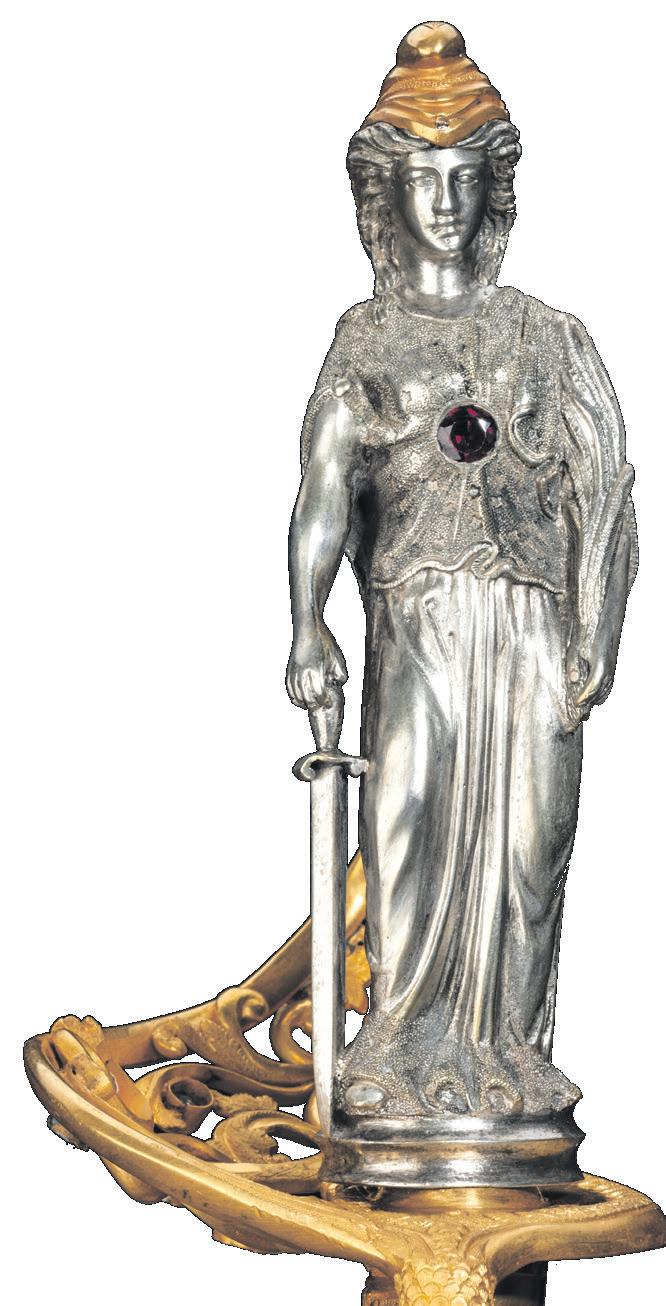
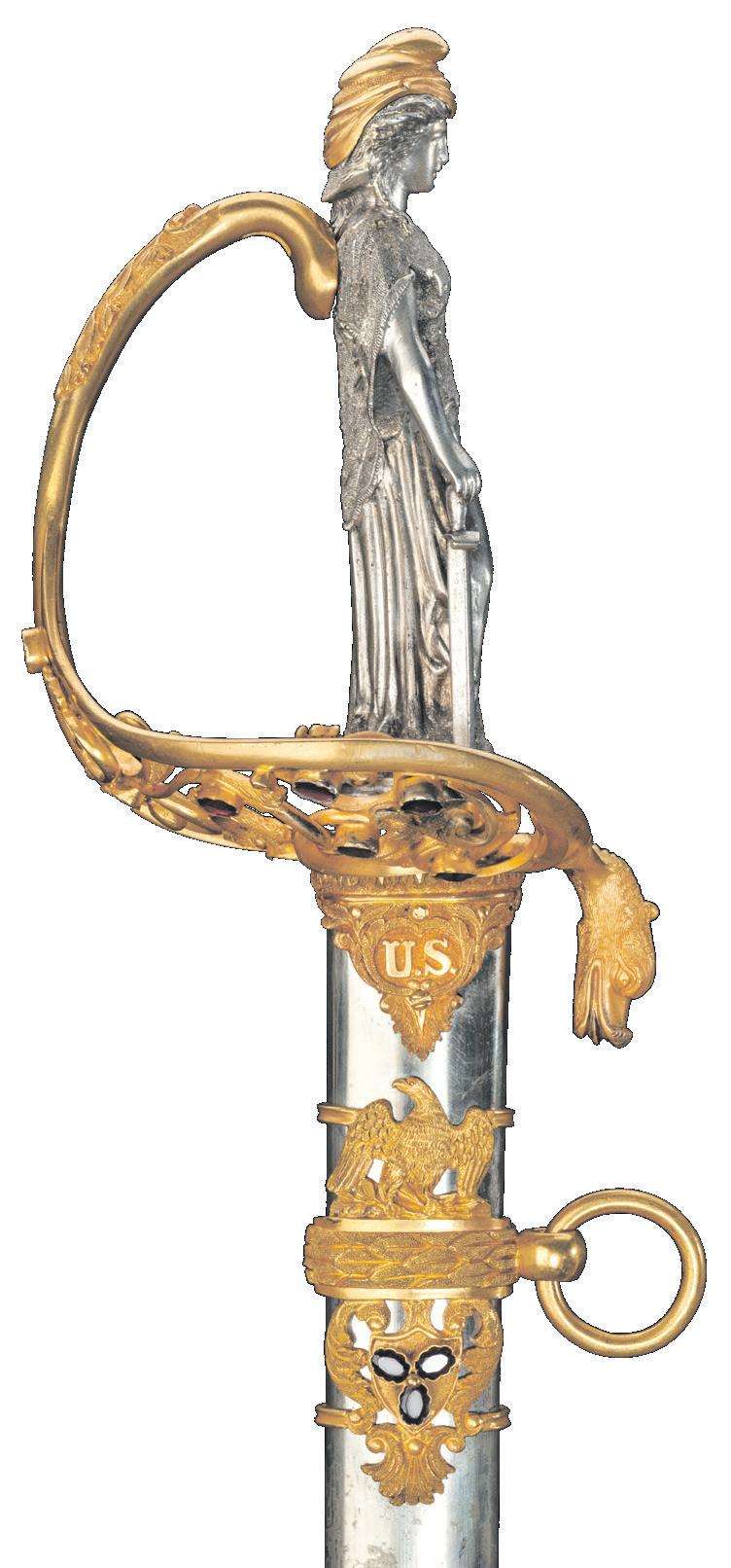
Miles was stunned. On the verge of victory, his position
was collapsing. He ordered other troops into the breach. “Instead of following orders, these troops panicked and either ran to the rear or dropped to the ground where they had been standing.” The 4th Brigade moved in while the 12th N.Y. Artillery fired upon the approaching enemy. Their horses dead or wounded, Union gunners abandoned their artillery as the
Rebels reached the guns. Worse, the Confederates turned one gun to fire on the fleeing Yankees.
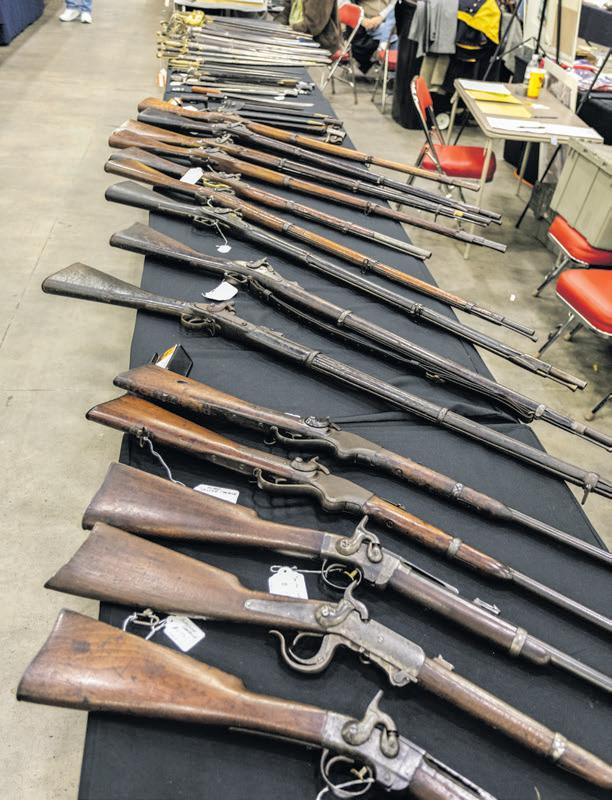
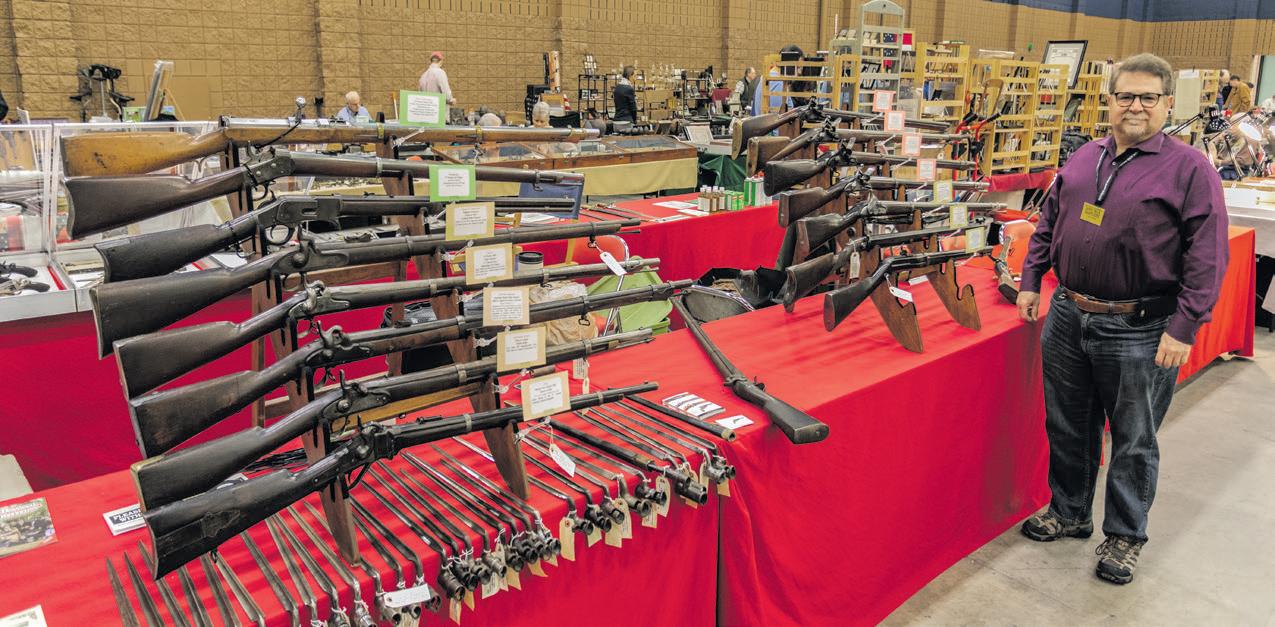
Miles spotted the 61st N.Y., his old regiment, standing up to the enemy. His used the regiment as an anchor as he “directed it to advance with a cheer. It swept the enemy from a major portion of the north face of the work, recapturing three guns of the Twelfth New York Battery, and driving the enemy into the railroad cut.”
Hancock, ignoring his personal safety rode all over the field rallying his men. “Hancock had his bridle-rein cut by a bullet,” wrote a soldier, “but was continuing galloping along the front urging the stragglers to resume their places in the lines and do their duty.” Suddenly his horse dropped under him. Hancock left the animal for dead. “We can beat them yet,” he yelled. “Don’t leave me, for God’s sake!” During the fight, Hancock placed a hand on his staff officer’s shoulder saying, “Colonel, I do not care to die, but I pray God I may never leave the field.”
Gregg’s dismounted cavalry saved part of Gibbon’s division. The rest either ran as fast as they could from the field or surrendered to the Confederates. The rallied Federals were not enough for a counter-attack. Hancock gave the order to pull out. Between nightfall and the heavy rain, the Confederates did not follow. They had captured nine guns, 12 flags, over 3,000 muskets, and 2,150 prisoners.
In the dispatch to Richmond, the Confederate victory was credited to Heth’s and Gen. James H. Lane divisions under Gen. James Connor. Wilcox and his division were not mentioned at all. As a professional soldier, stuck in the trenches around Petersburgh, credit earned was a needed morale booster. Wilcox would write, “It was my fight. … I gave the orders, … had my horse killed, one of my aides had his killed, two couriers had theirs killed & my Adjutant General wounded. My brigadiers all said it was a strange dispatch.”
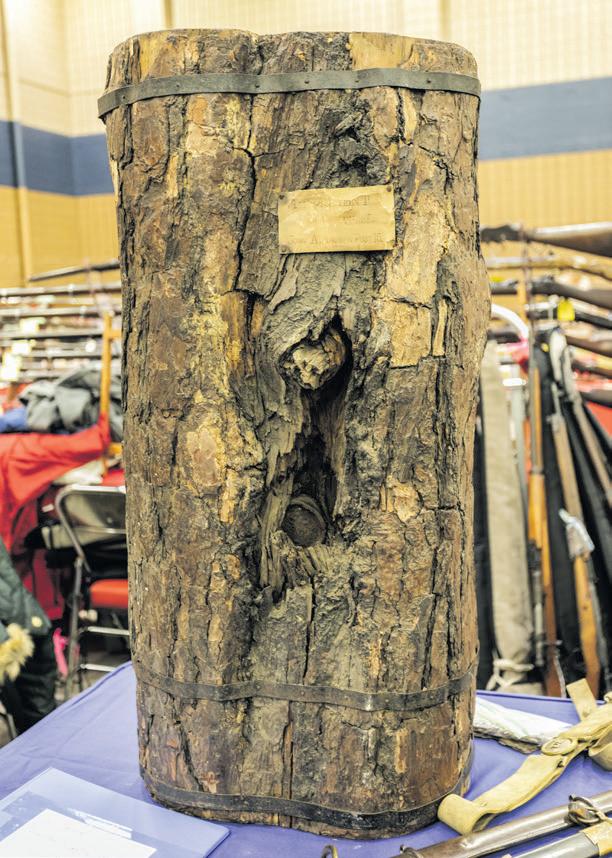
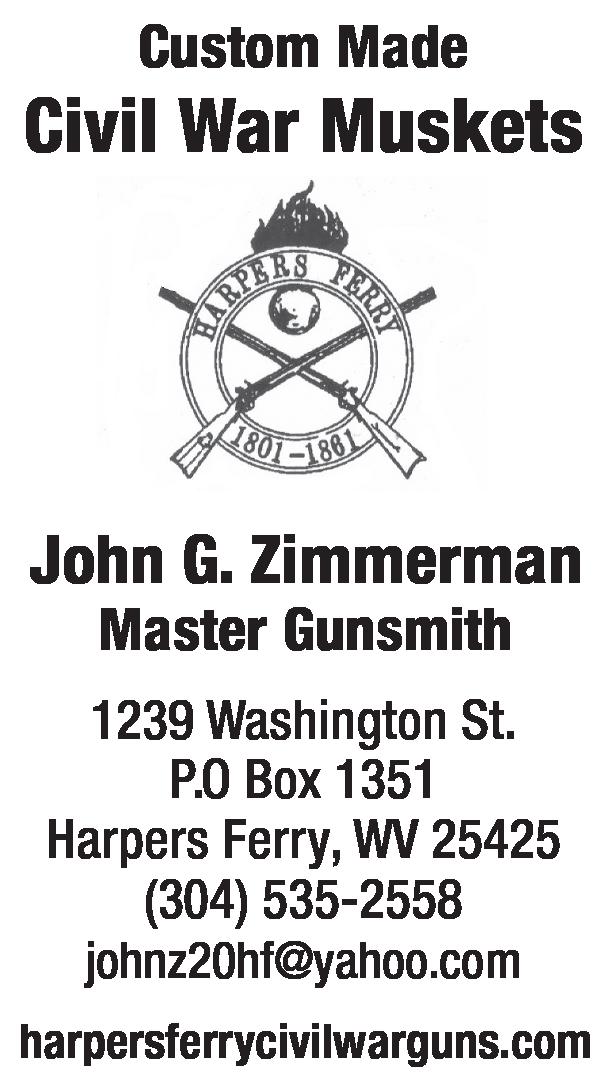
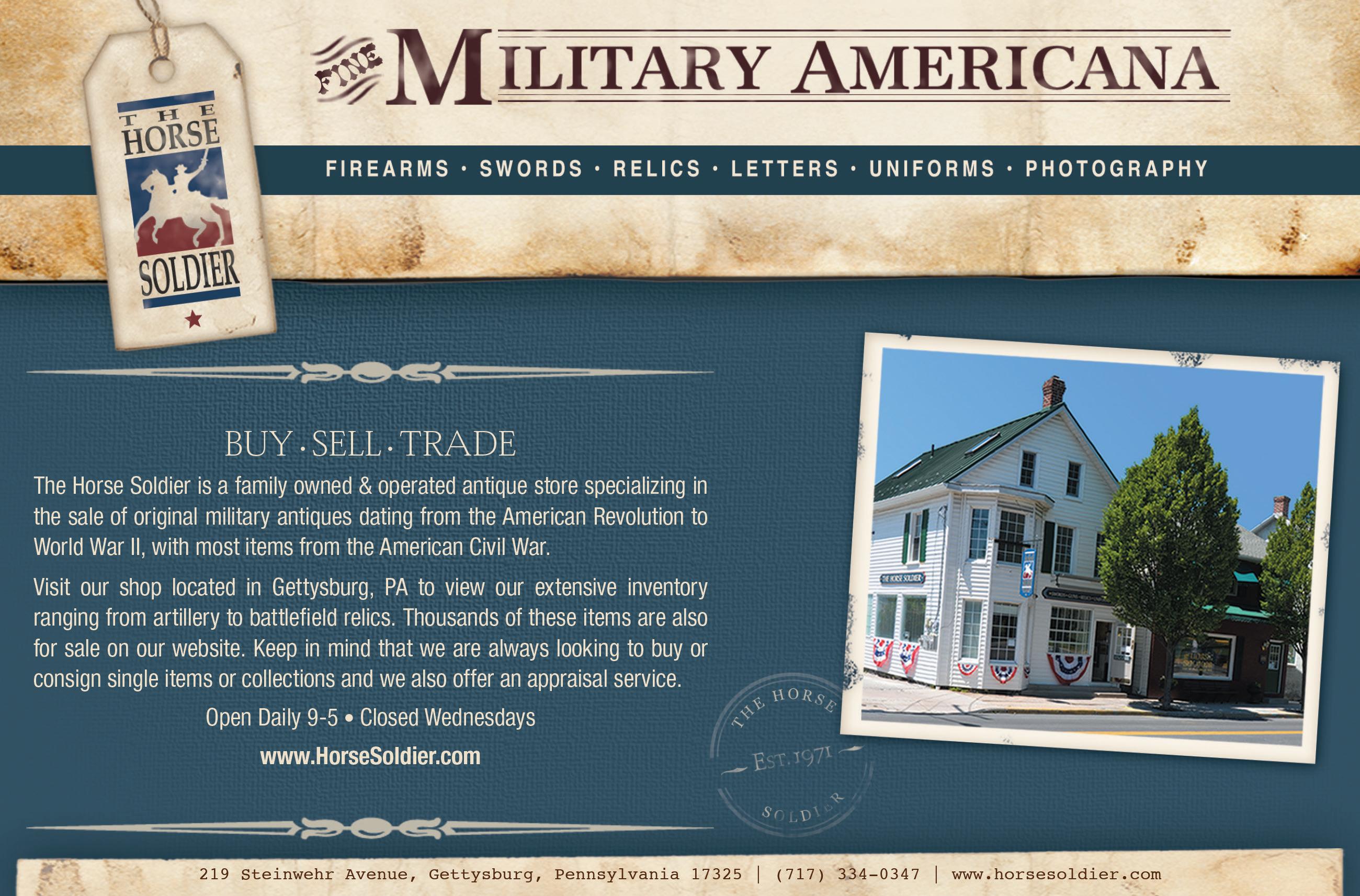
Sources:
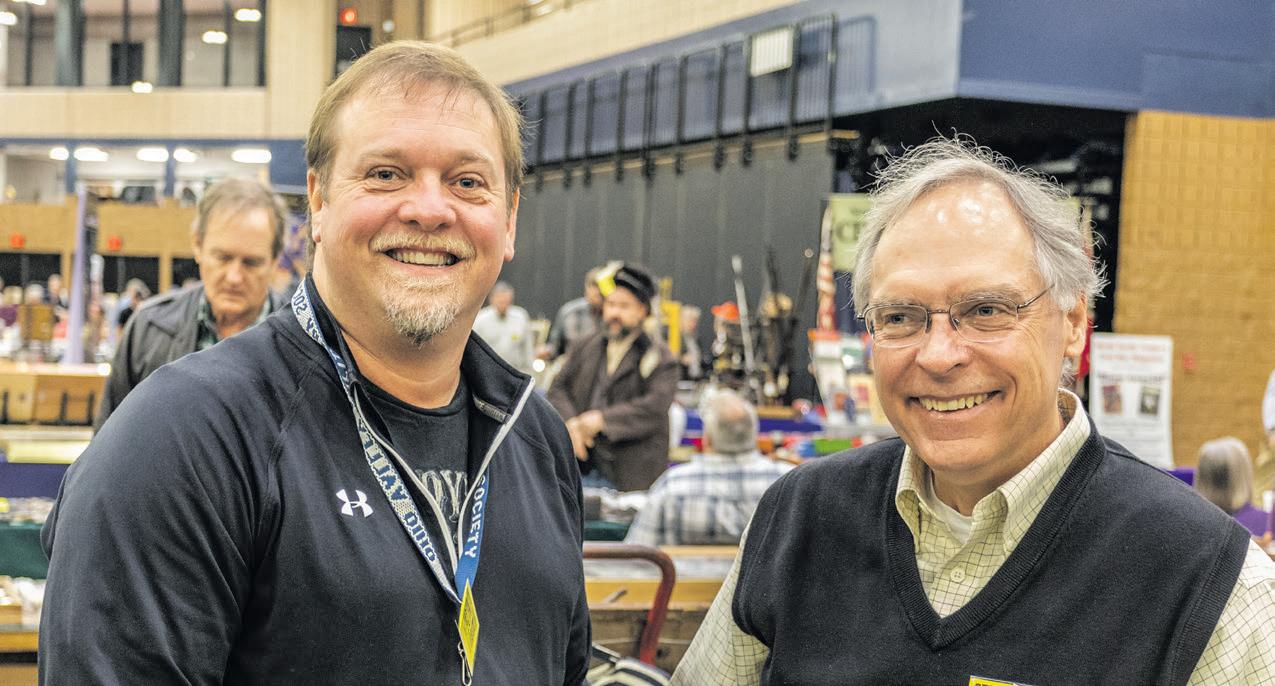
• Walker, Francis Amasa, General Hancock; Great Commanders
• Patterson, Gerard, From Blue to Gray: The Life of Confederate General Cadmus M. Wilcox
• DeMontravel, Peter R., A Hero to His Fighting Men: Nelson A. Miles, 1839–1925
• Dauchy, George K., The Battle of Reams’s Station; Military Essays and Recollections, Military Order of the Loyal Legion of the United States. Commandery of the State of Illinois Vol 3

Stephanie Hagiwara is the editor for Civil War in Color.com and Civil War in 3D.com. She also writes a column for History in Full Color. com that covers stories of photographs of historical interest from the 1850’s to the present. Her articles can be found on Facebook, Tumblr and
War
H Dalton . . . . . . . . . . . from page 1Antiques Roadshow appraiser, author and CWN columnist Tim Prince, owner of College Hill Arsenal, proudly displays his fine selection of antique weapons. John & Nikki Walsh, proprietors of FortDonelsonRelics.com, offered a number of antique weapons for sale at the show.
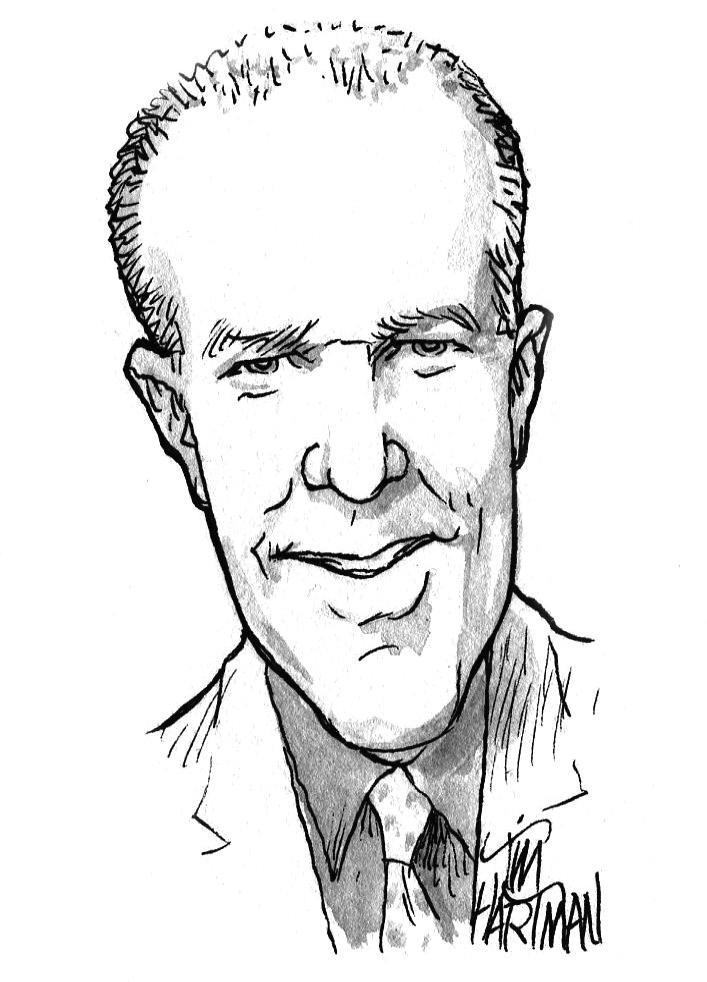
The Atlanta Papers cover and spine.
Continuing the dig into Sydney C. Kerksis’s The Atlanta Papers, this month’s column contains additional Federal accounts from the Atlanta Campaign. Colonel Samuel W. Price of the 21st Kentucky Infantry (Federal) penned Paper No. 10, entitled ‘The Skirmish Line in the Atlanta Campaign,’ which focuses primarily on the Battle of Kennesaw Mountain. Borrowing the same title from Colonel Price, Major William Henry Chamberlin of the 81st Ohio Infantry recalled his involvement in the campaign through Paper No. 11. During the Battle of Resaca, Chamberlain’s regiment numbered among those units charged with moving around the Confederate left flank and effecting a crossing of the Oostenaula [occasional wartime spelling] River. Navigating across the swift current of the river, Chamberlin recalled he felt “…it was the open way to Andersonville.” Rowland Cox, who served as an assistant adjutant general on Major General Frank Blair’s staff during the campaign, remembered the fighting at ‘Snake Creek Gap, and Atlanta’ in Paper No. 12. Accompanying Major General James McPherson’s Army of the Tennessee during their maneuver through Snake Creek Gap, Cox witnessed the Confederate demonstrations, which prompted McPherson to withdraw his force. A few days later, Cox, while standing next to McPherson, heard the general state, in response to a query of why he did
not keep his army in the gap, “… Johnston would have cut [me] off as you cut off the end of a piece of tape with a pair of shears.”
Lieutenant Colonel Robert Lang Kilpatrick composed Paper No. 13, ‘The Fifth Ohio Infantry at Resaca.’ He closed his account with a recollection of finding boxes of tobacco left in his regiment’s camp with a note affixed:
“To the Regiment that Captured the Rebel Guns at Resaca.”
‘McCook’s Brigade at the Assault Upon Kenesaw [wartime spelling] Mountain, Georgia, June 27, 1864,’ Paper No. 14 from Lieutenant Frank Bakewell James of the 52nd Ohio Infantry offers an exciting account of the attack on Cheatham Hill. James remembered how, during the truce to bury the dead after the battle, a Federal soldier, actually a Confederate spy, sprang up and raced to the Southern line. James believed this spy notified Major General Ben Frank Cheatham of the tunneling work underway.
‘The Battle of Peach Tree Creek,’ Paper No. 15 from Private George A. Newton with the 129th Illinois Infantry, offers an excellent description of the terrain in the area, as well as accounts from the battle. Of General John Bell Hood’s attack at Peachtree Creek, Newton suggested, “It was a brilliant affair well planned….”
Captain Gilbert D. Munson of the 78th Ohio Infantry, authored Paper No. 16, ‘The Battle of Atlanta.’ Serving as assistant adjutant general on Brigadier General Mortimer Leggett’s staff, Munson detailed the action involved in taking, and holding, an important piece of high ground, which earned the name Leggett’s Hill after the July 22 fight.
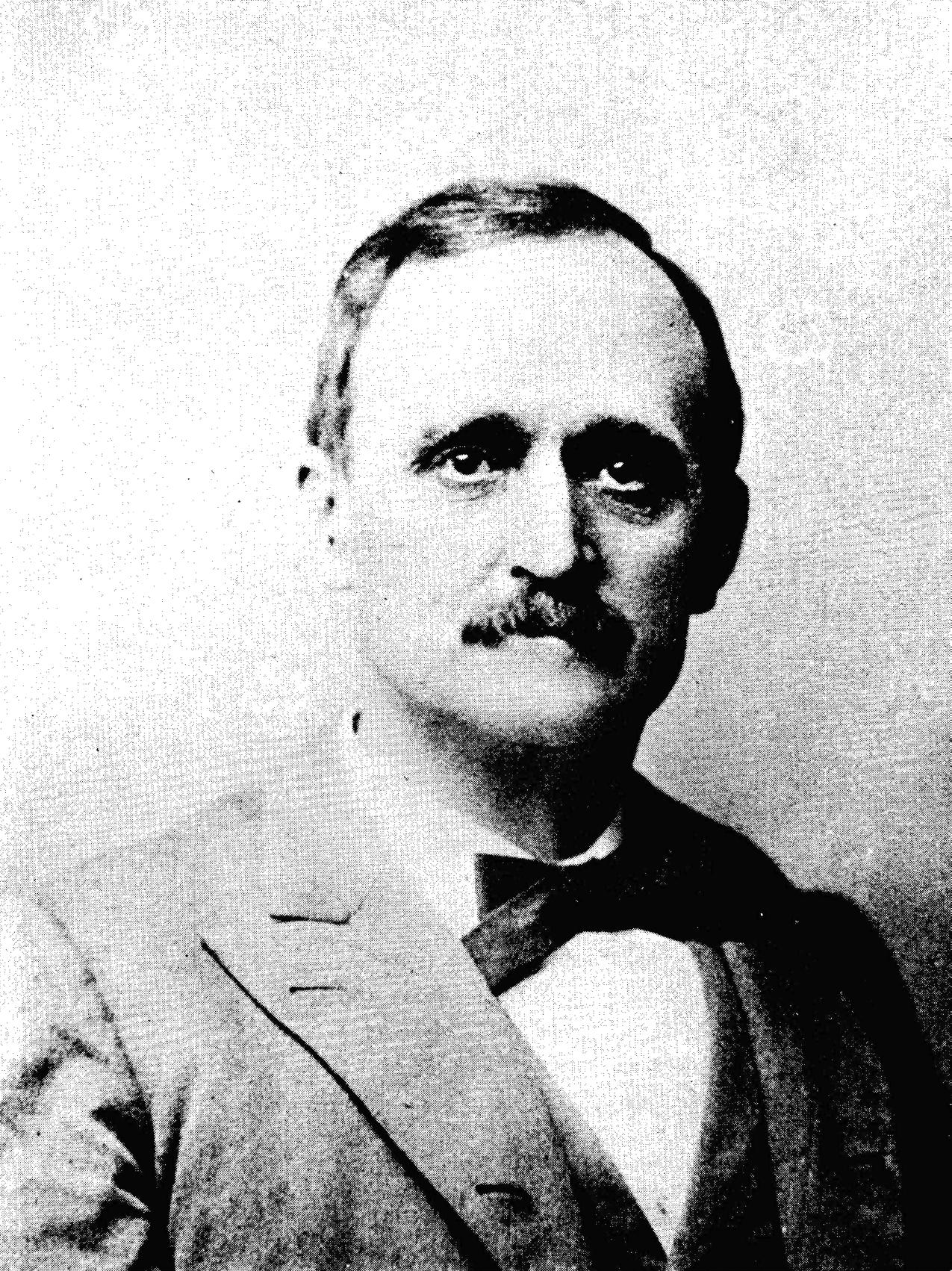
In ‘An Artilleryman’s Recollections of the Battle of Atlanta,’ Lieutenant Richard S. Tuthill provides a glimpse into the life of a gunner with the 1st Michigan Light Artillery. One of Tuthill’s opening sentences on the battle offers researchers a glimpse into his gift with words. “July 22, 1864, dawned in calmness and
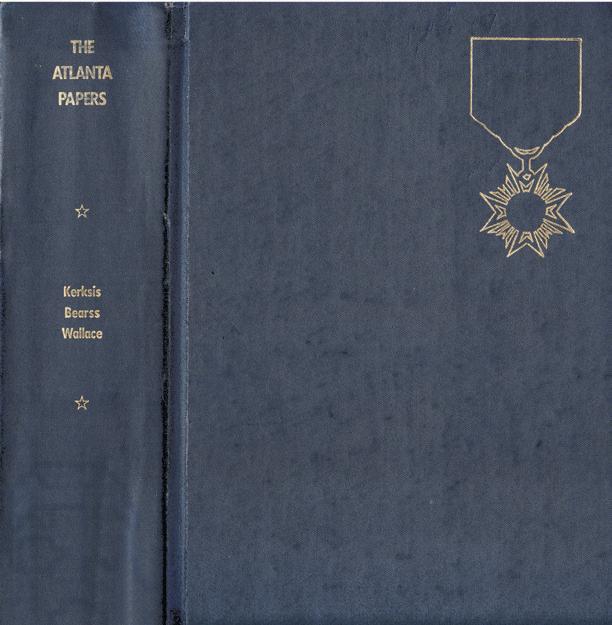
beauty, presaging a perfect summer day; but as the sun rose upon the horizon, an angry red flushed his broad disk, which seemed to presage one of the very fiercest battles ever fought, and to reflect what should ere nightfall be…blood-drenched ground....” Tuthill, servicing his gun near where McPherson fell mortally wounded, recalled the valiant effort of each artillery crew in his sector of the field. Taking a jab at the credit given Leggett and his gunners, Tuthill strongly asserted, “That artillery had no more to do with breaking the enemy’s line than if it had been fired in an opposite direction.”
Remember to check WorldCat http://www.worldcat.org/ for help in finding this book in a local library; search The Atlanta Papers + Kerksis. Researchers may also have luck in securing a copy of this 1980 Morningside Press publication from an online bookseller. Next month, we will explore additional sections of The Atlanta Papers. Until then, continued good luck in researching the Civil War!
Michael K. Shaffer is a Civil War historian, author, lecturer, instructor, and a member of the Society of Civil War Historians, the Historians of the Civil War Western Theater, the Georgia Association of Historians, and the Georgia Writers Association. Readers may contact him at mkscdr11@ gmail.com, or to request speaking engagements, via his website www.civilwarhistorian.net. Follow Michael on Facebook www.facebook.com/michael.k.shaffer and Twitter @michaelkshaffer.
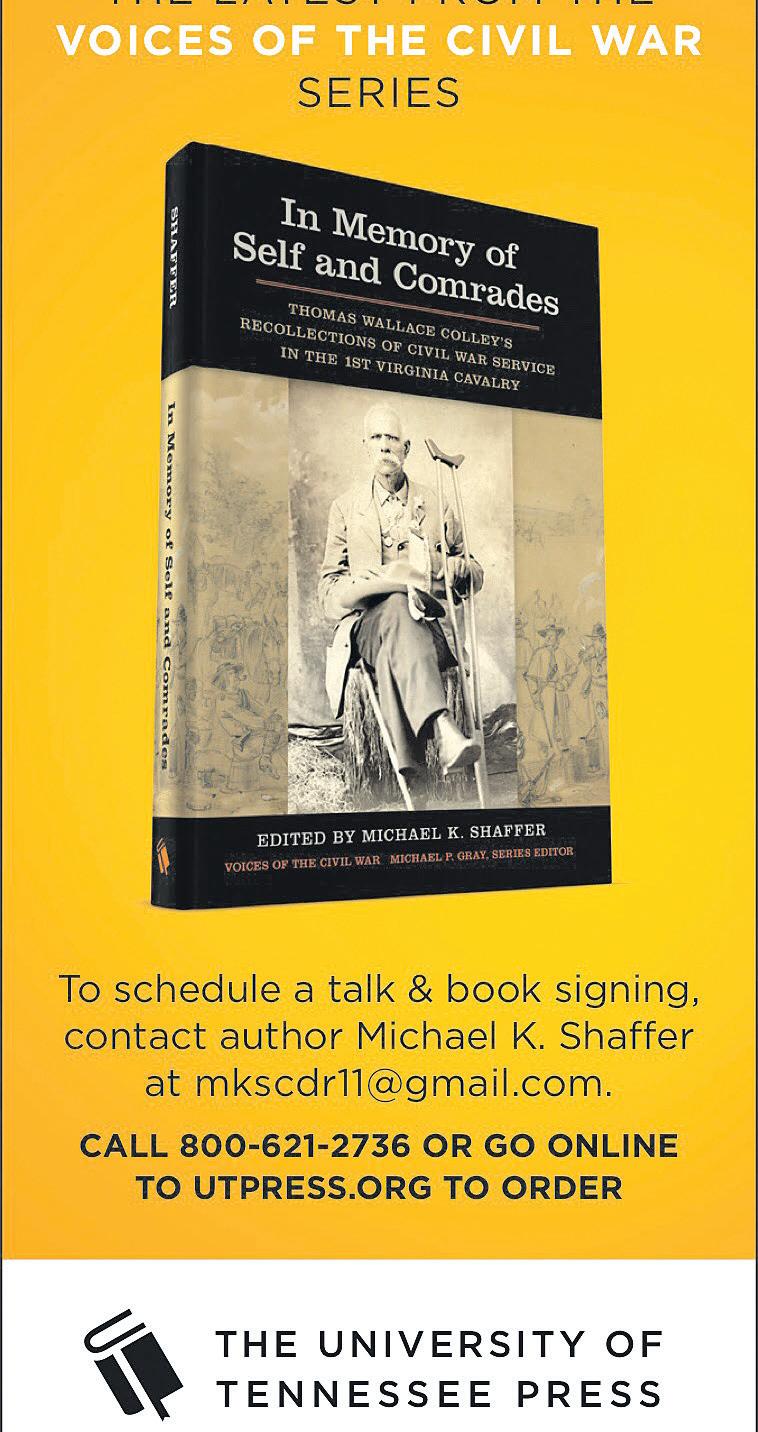
Submissions is the 20th of each month. Email to: ads@civilwarnews.com

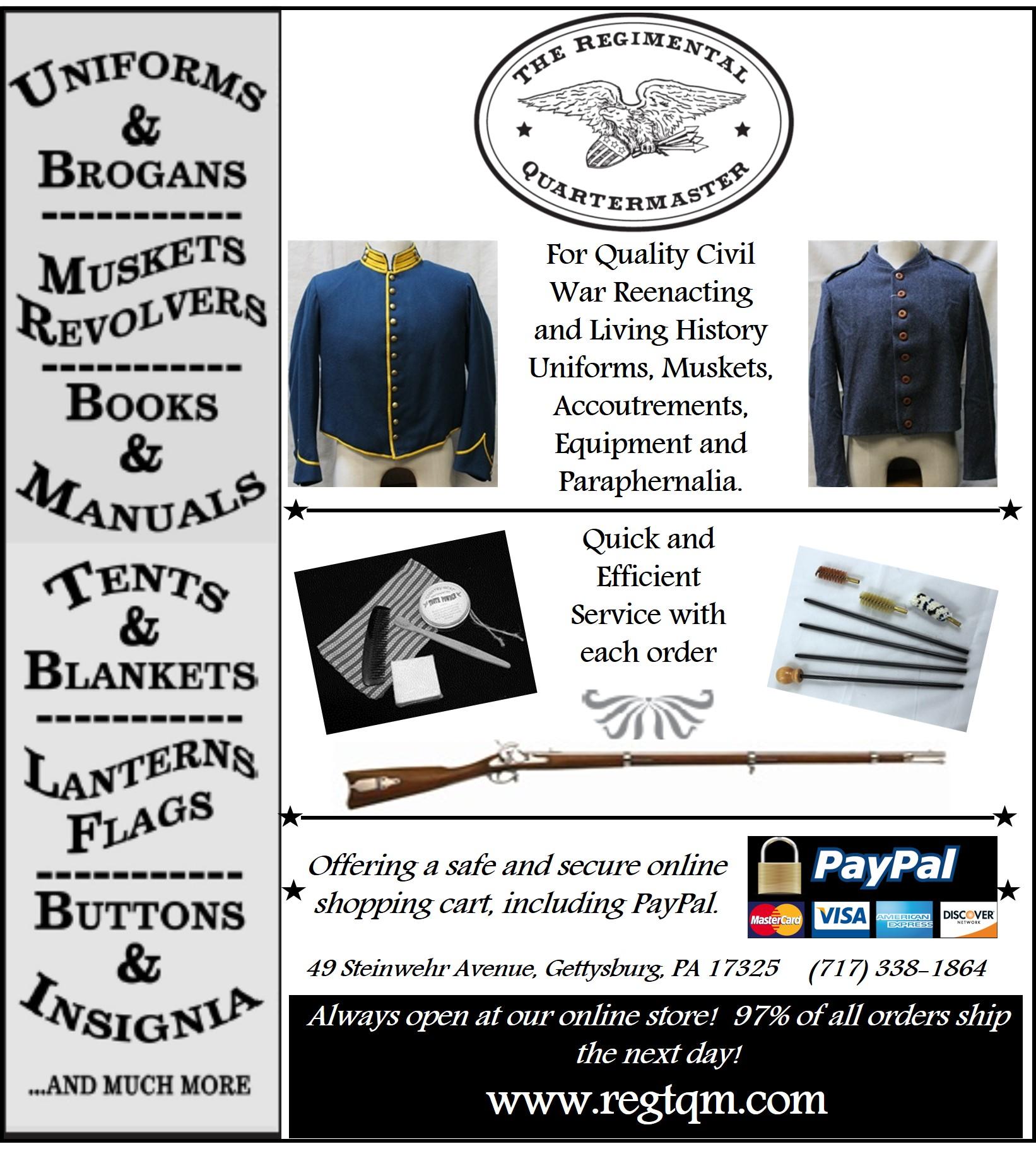
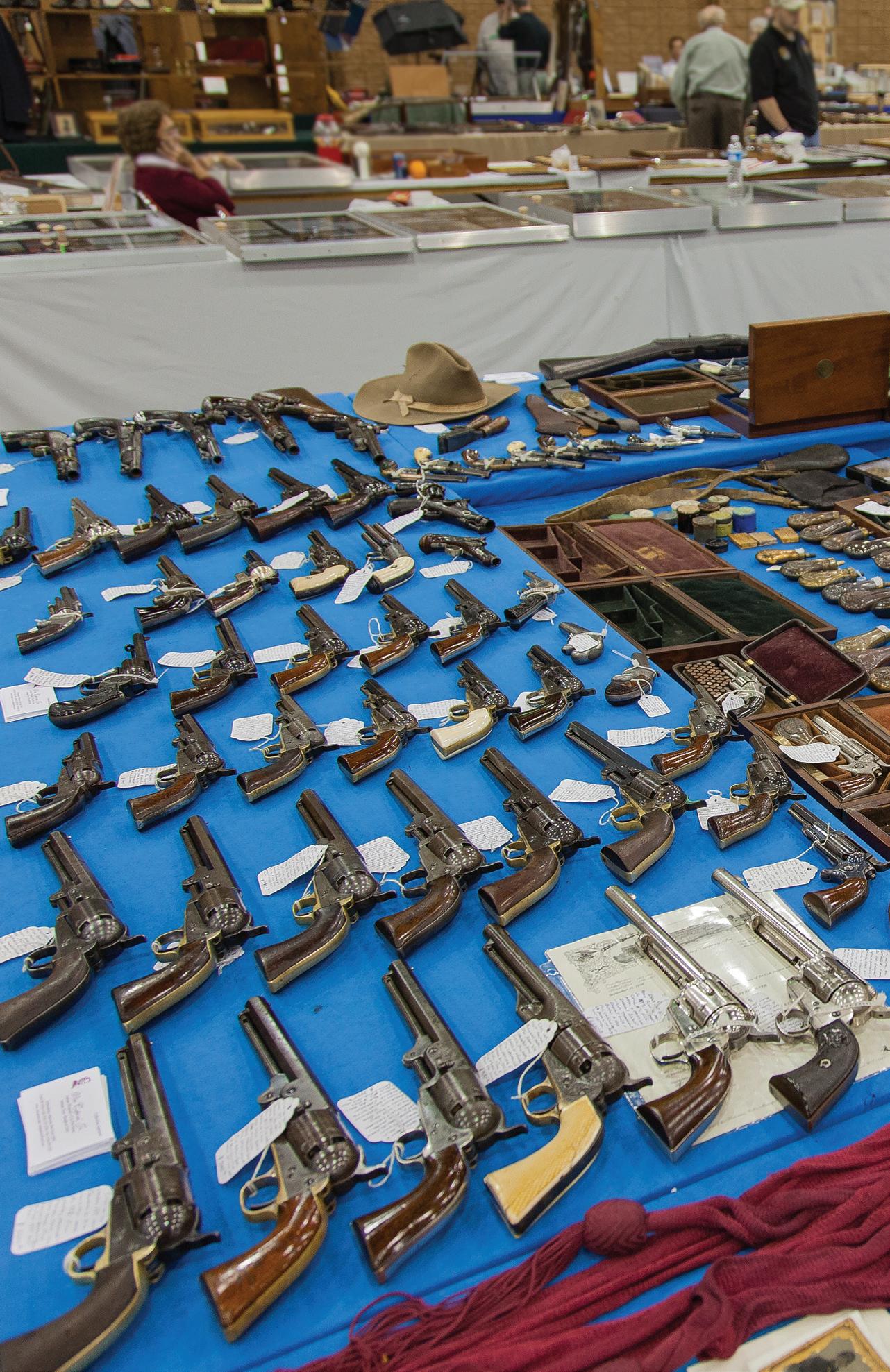


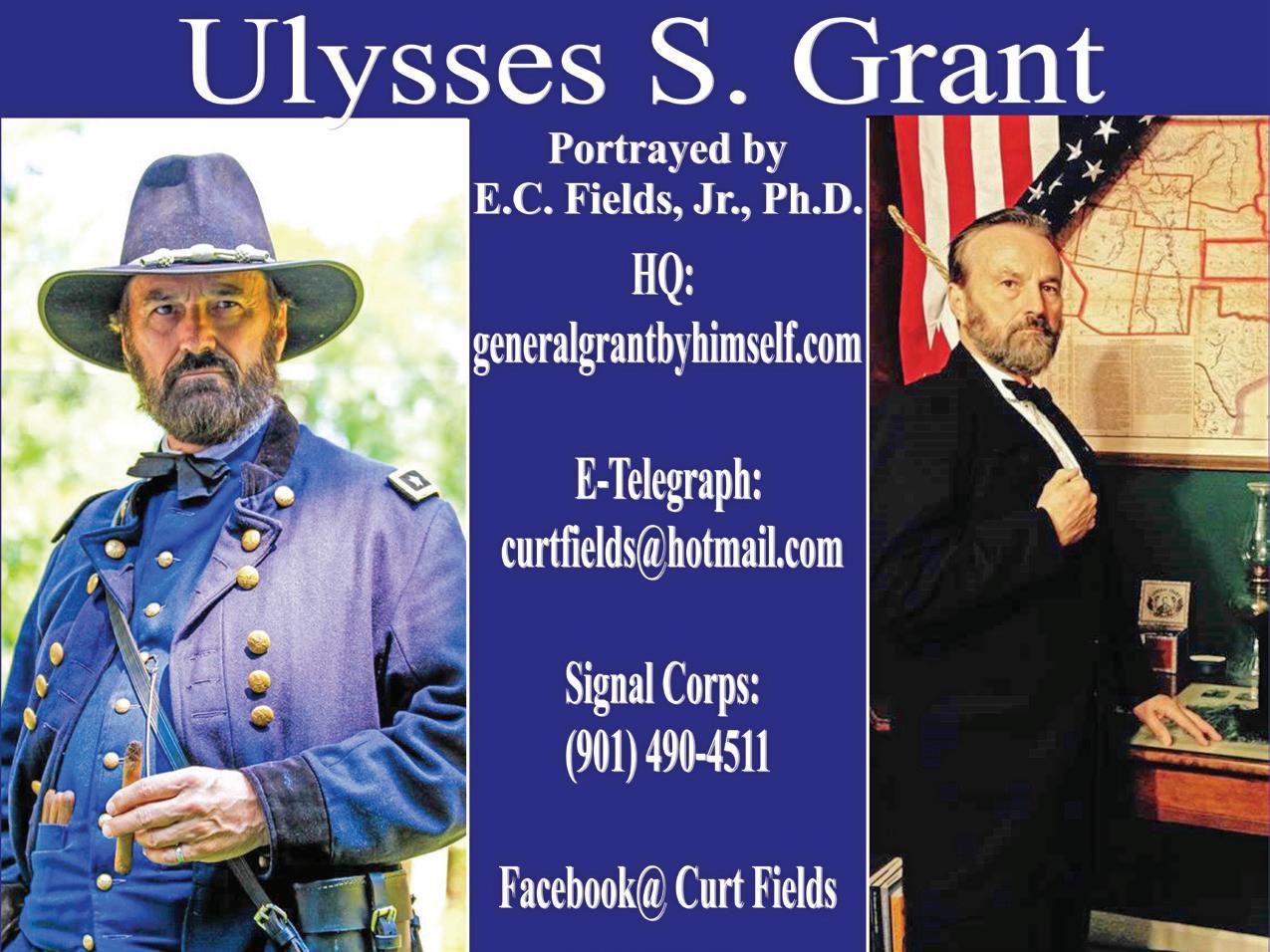
Dec. 31, 2018, General Gordon S. Meade’s 203rd birthday was celebrated at Laurel Hill Cemetery in Philadelphia, Penn. This was the 26th time the occasion was marked by the General Meade Society. The Society was formed in 1996 and its mission is to “discuss the General’s role in the American Civil War and other related topics” (Source: https://generalmeadesociety.org/ about/mission/). As most of the readers of the Civil War News know, General Meade was the commander of the Army of the Potomac when it defeated General Lee’s Army of Northern Virginia at the largest battle of the Civil War in Gettysburg, Penn.
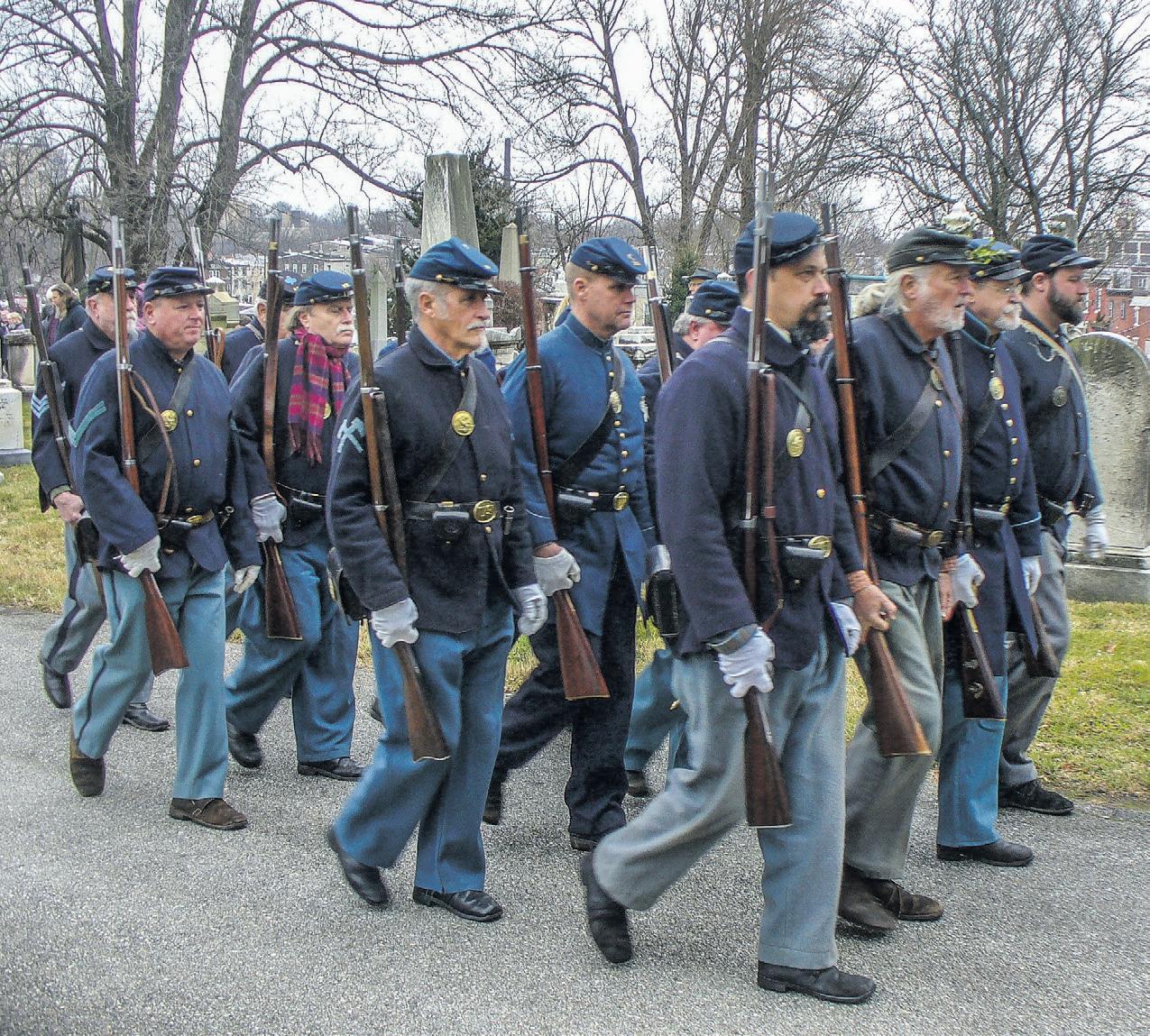
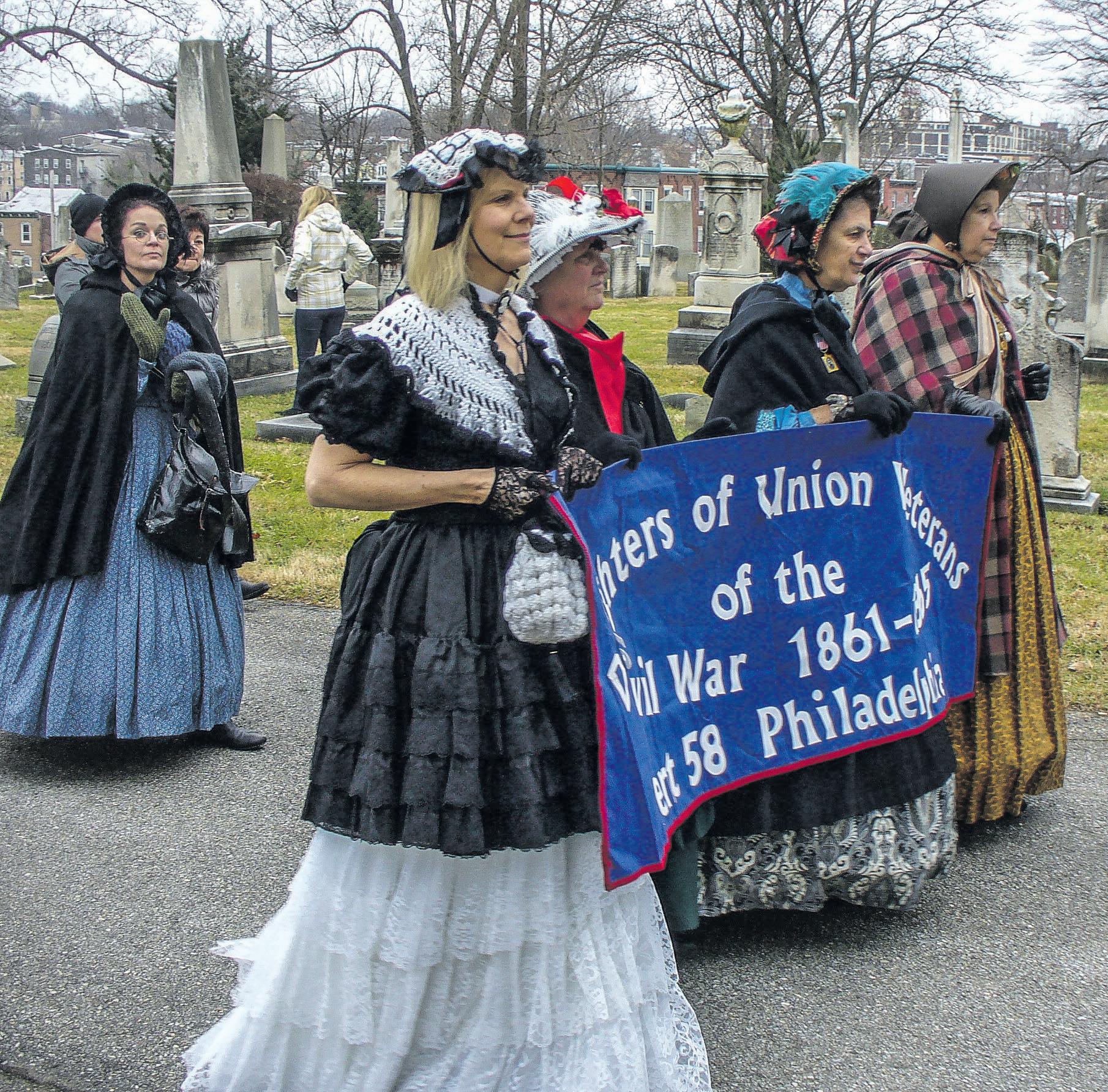

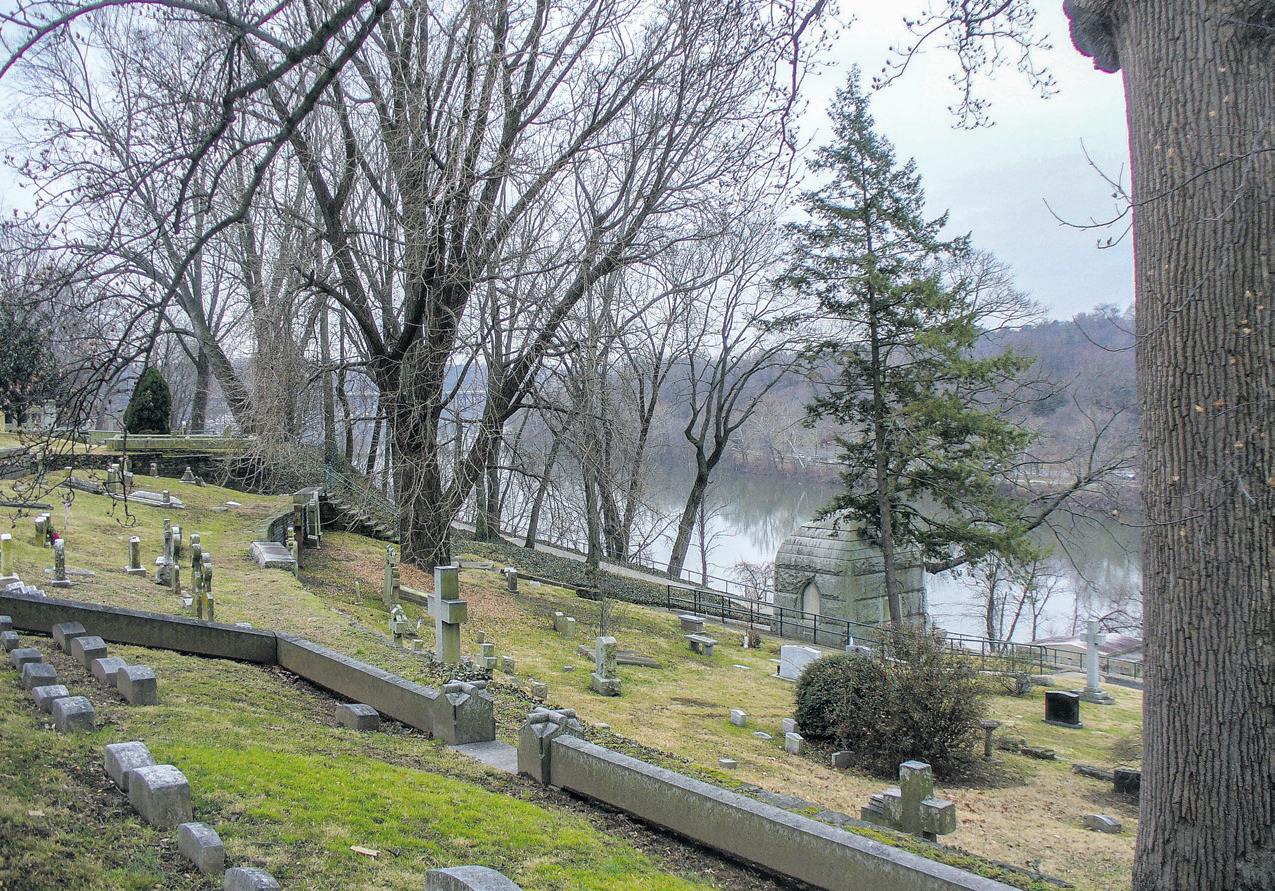
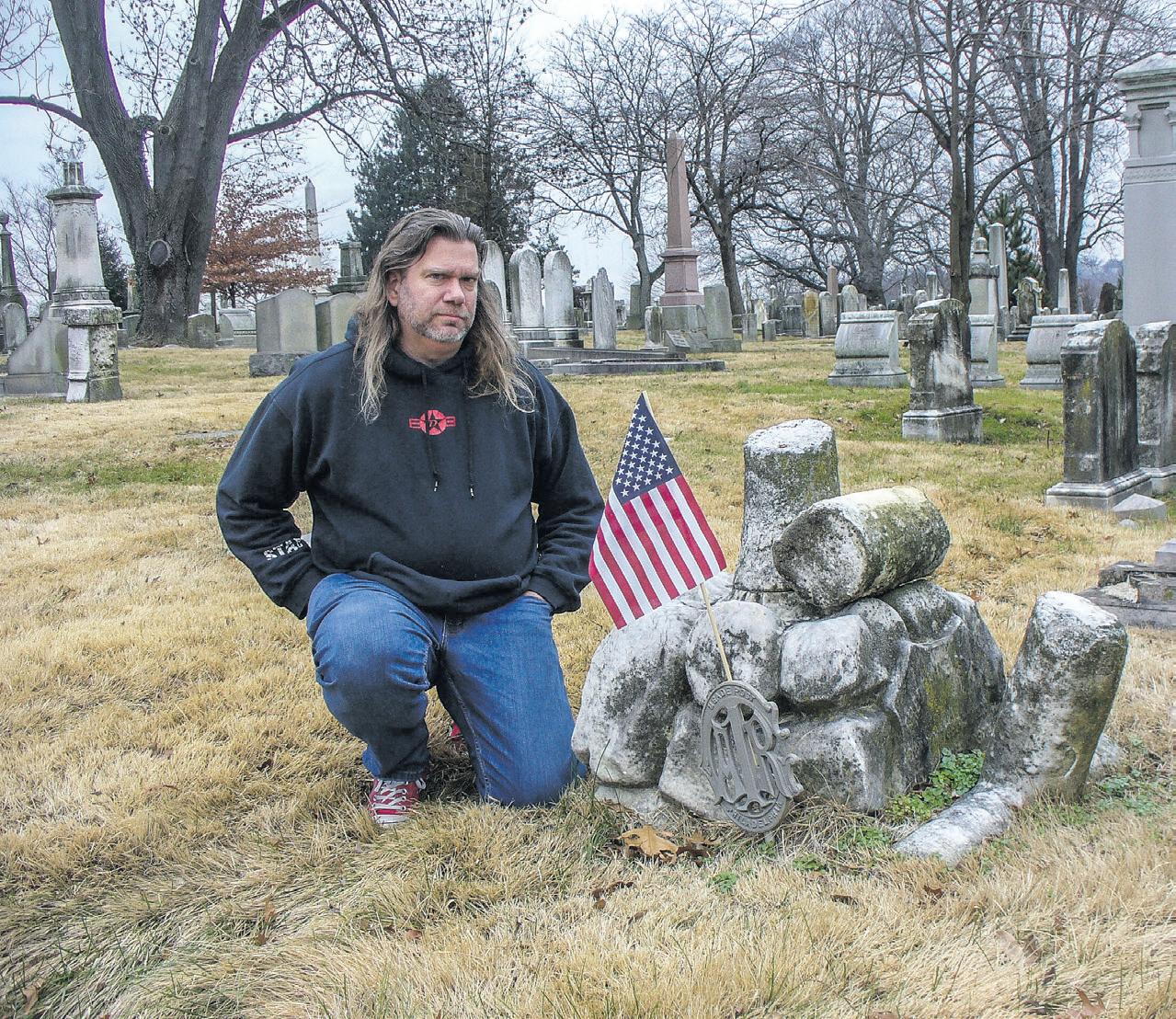
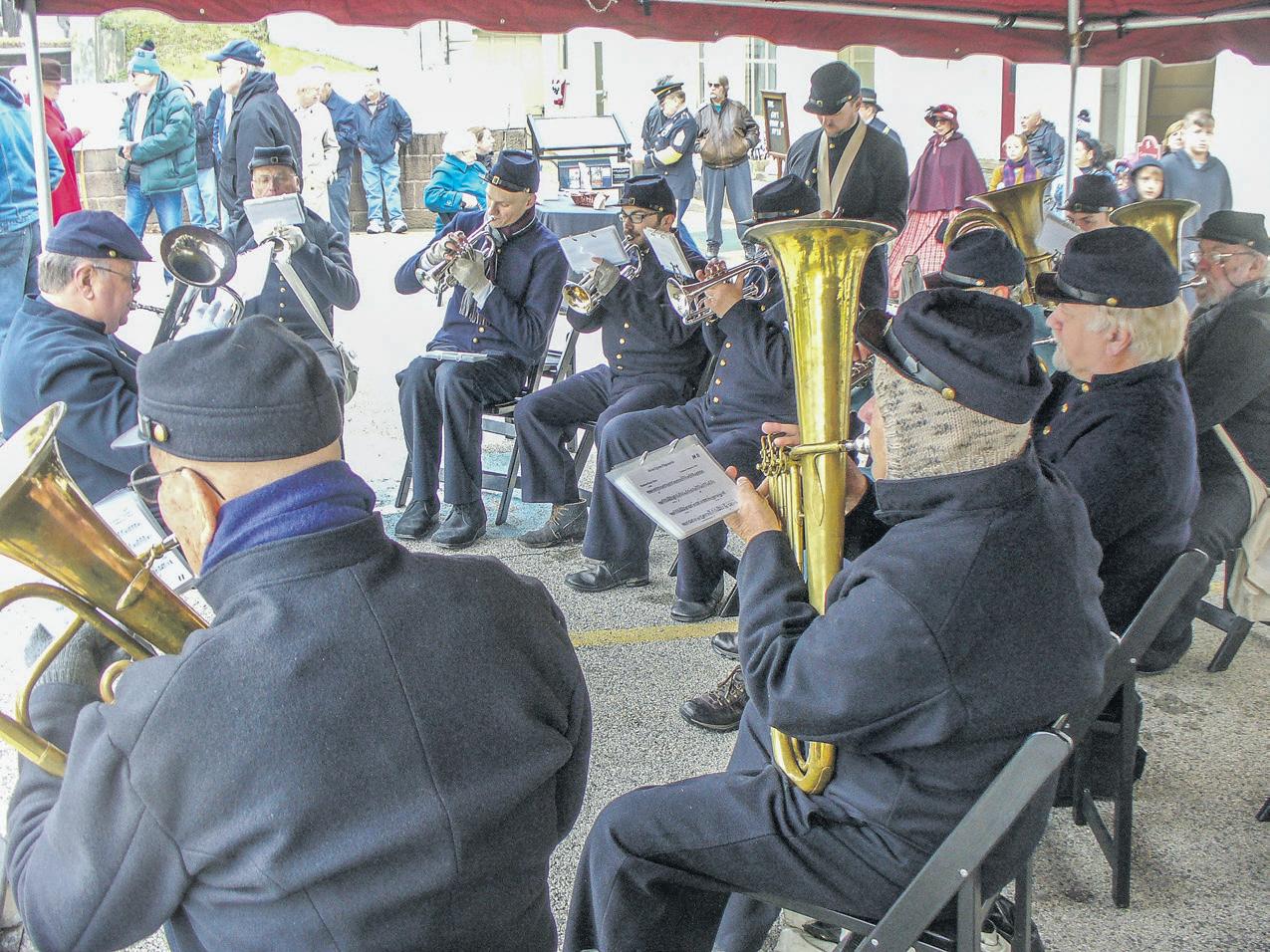
Organized by Temple University professor, and General Meade impressionist, Anthony (Andy) Waskie, the celebration features a march to the general’s grave, speeches, an honor volley, 19th century period band performances by Beck’s Philadelphia Brigade Band, and refreshments, including the general’s favorite beverage, champagne!
Rain threatened to soak the celebrants, but fortunately held off long enough for the graveside events to be completed. The refreshments were served indoors, so the event was a great success in all respects, and its goal of keeping General Meade’s memory alive was a great success as well.
Joe Bordonaro is a USAF veteran (1973–1977), Glassboro State College graduate (1980), Catholic school teacher (St. Joseph’s ProCathedral, 1983–1988), and retired public school teacher (Mullica Township School, 1988–2009). He has been involved with Civil War reenacting/living history since 1999. Joe began submitting articles to the Civil War News in 2005 and has been covering events for the News on a regular basis since 2016. Joe lives in Mount Laurel, NJ, and has been married to his wife Karen for 29 years. If you wish to contact Joe, you may send an email to joe1861@gmail.com.
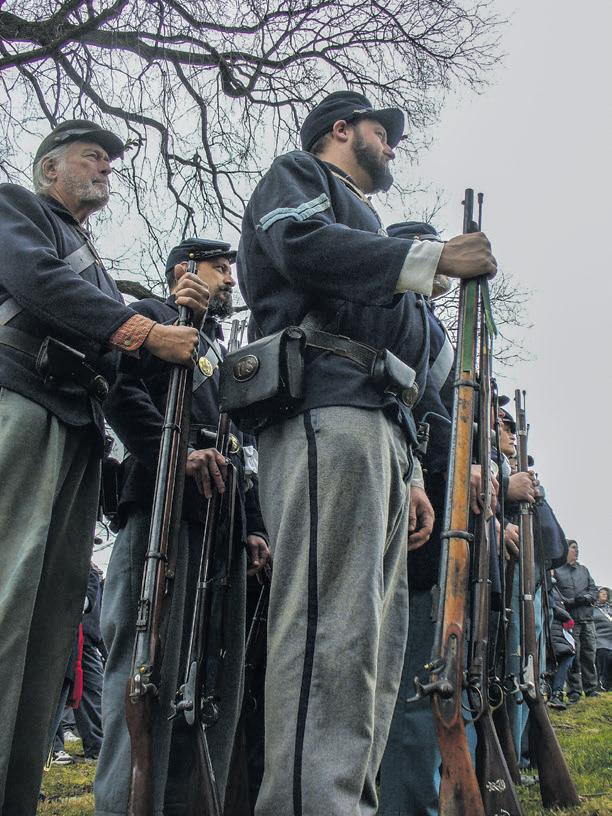
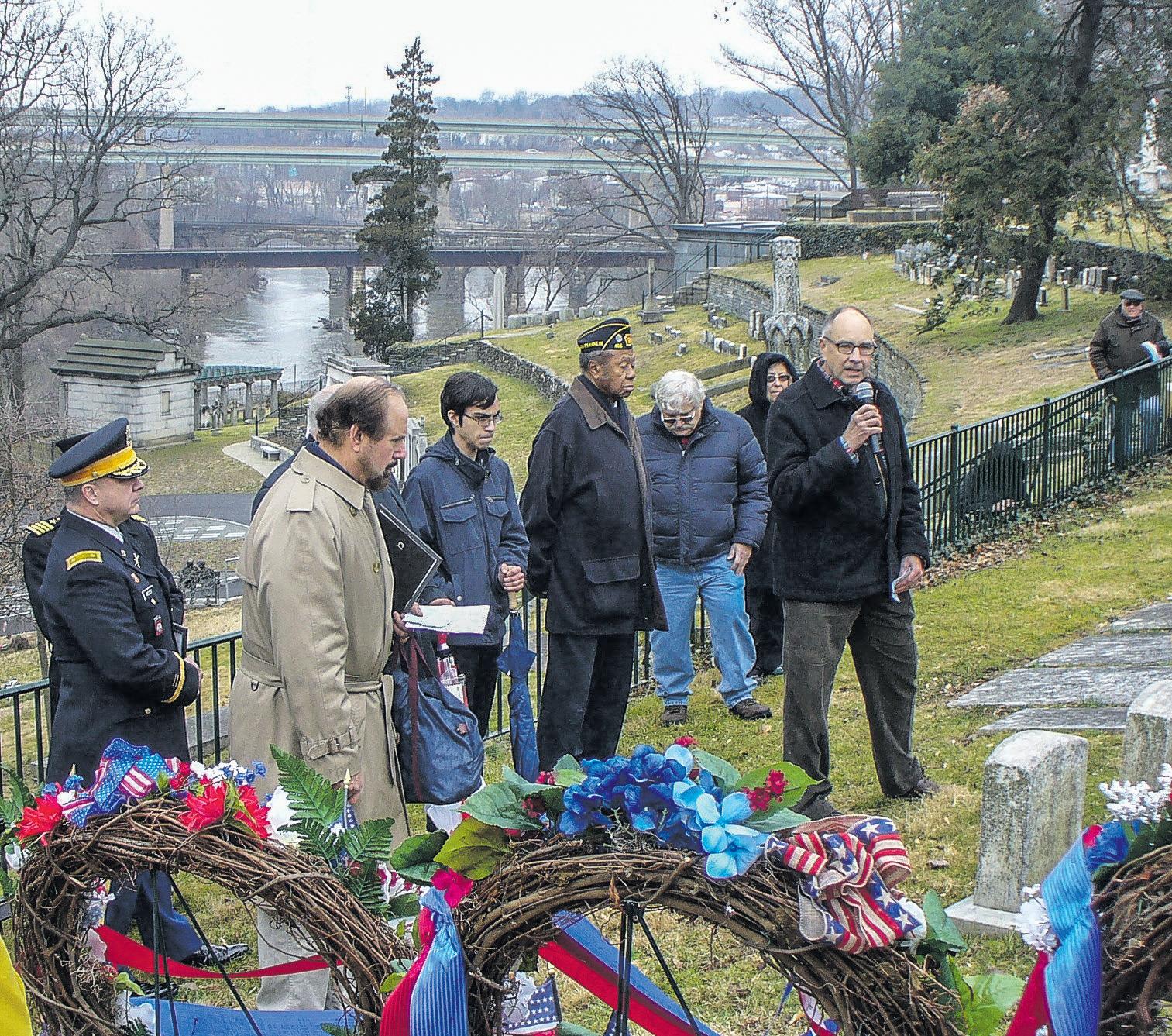


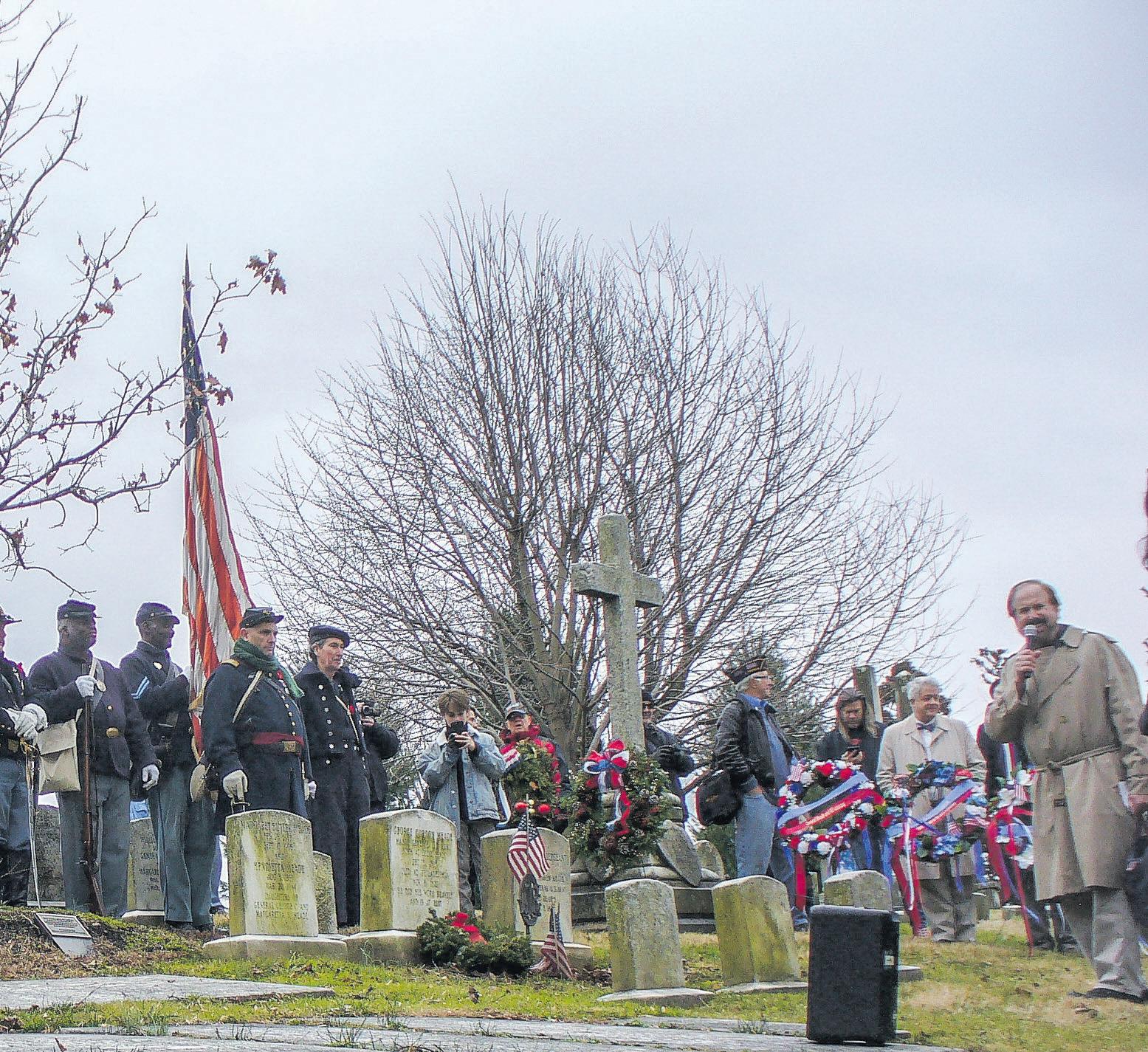
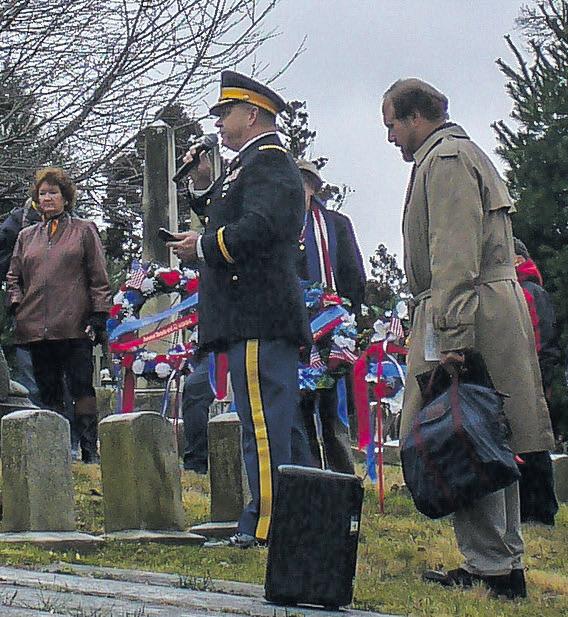
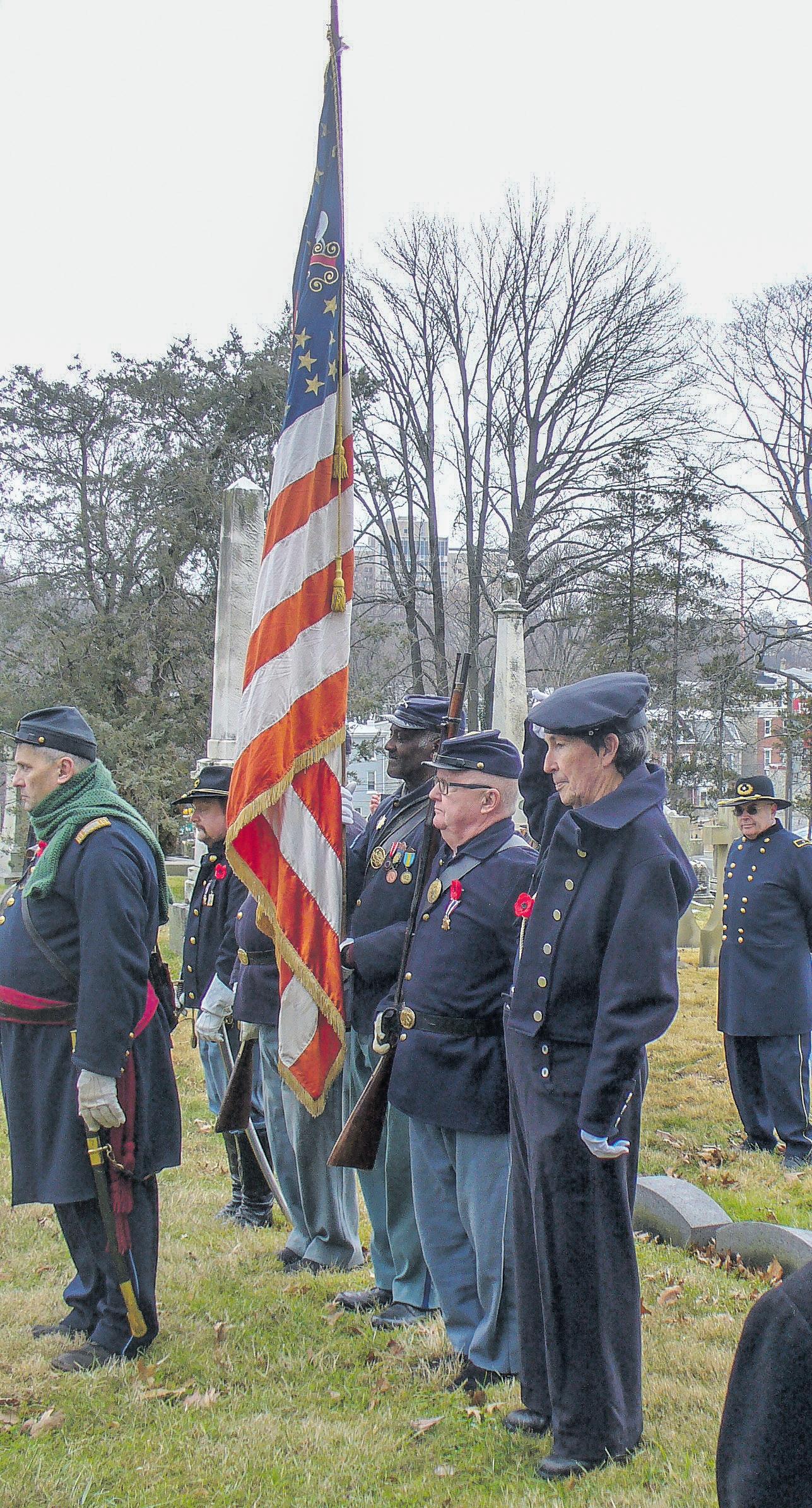
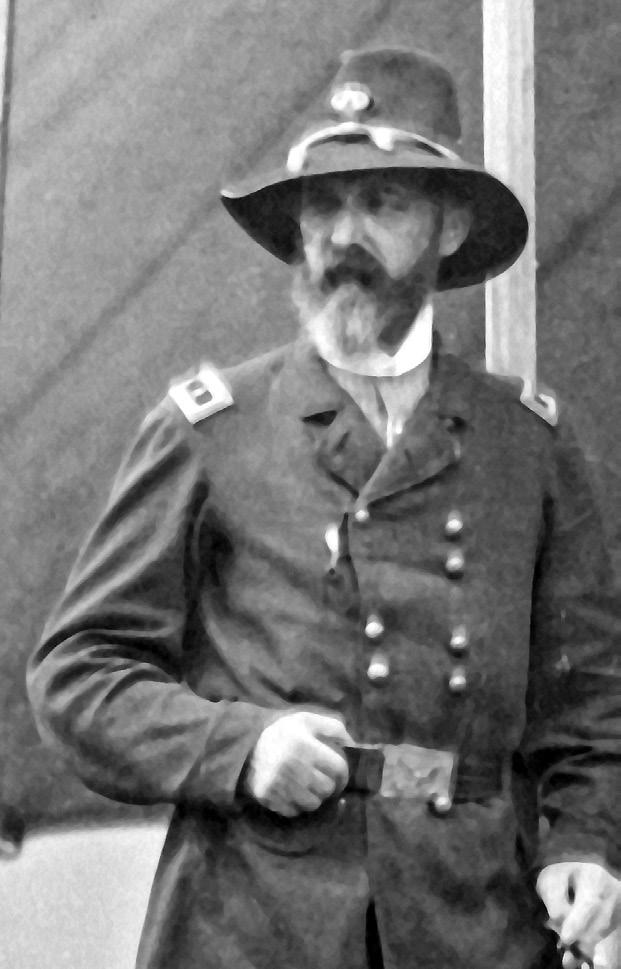
With the advent of the Civil War by the bombardment of Fort Sumter on April 12, 1861, and secession from the Union of eleven states, decades of political turmoil in the United States Congress and the nation came to a head.
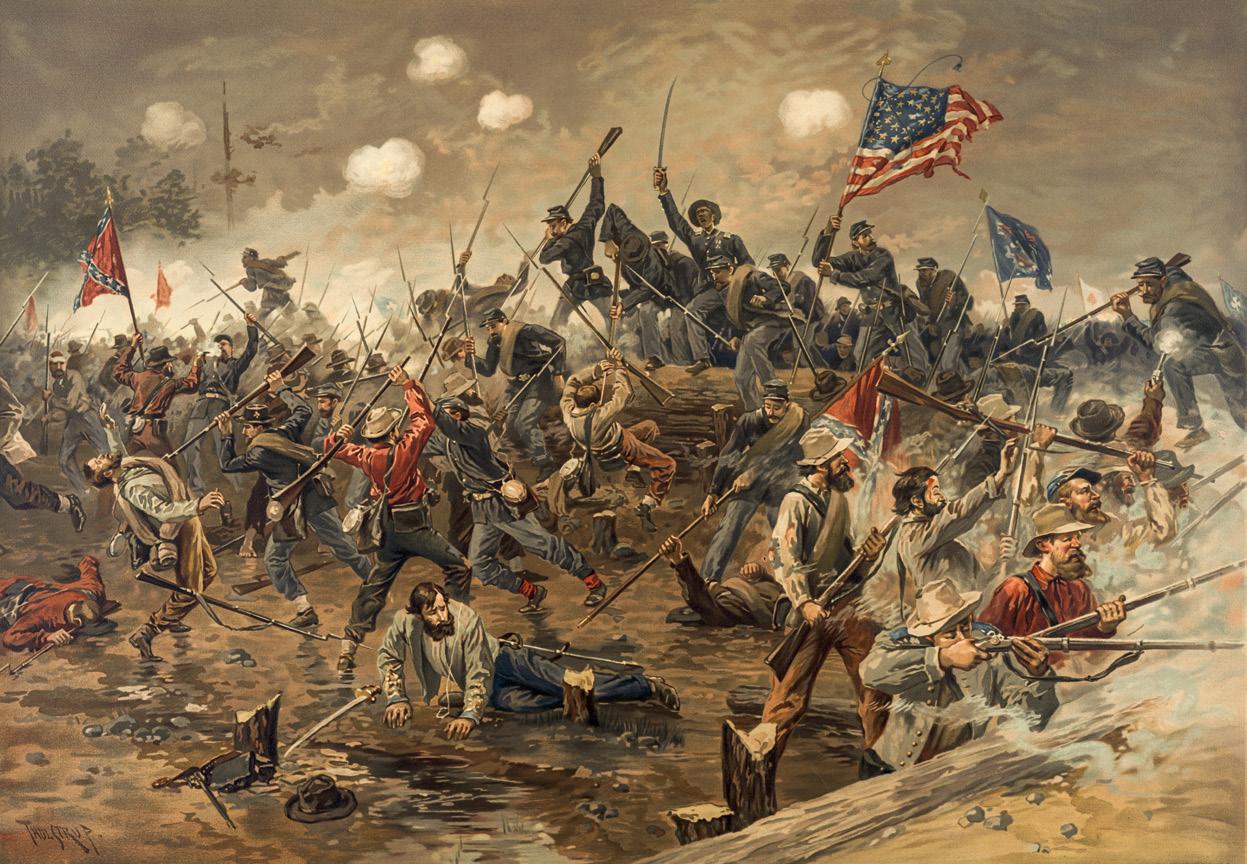
As thunder clouds of war descended on the tranquil cities and towns of the South, the conflict would leave behind more than 750,000 casualties, by modern estimates, and see desolation beyond imagination. A large part of those casualties, over 100,000, would occur in the Fredericksburg, Va., area with the town bombarded and urban combat chasing civilians from their homes.
The Union Army of the

Potomac and Confederate Army of Northern Virginia would clash several times in central Virginia between 1862 and 1864, making the names of Fredericksburg, Chancellorsville, Wilderness, and Spotsylvania indelible in American History.
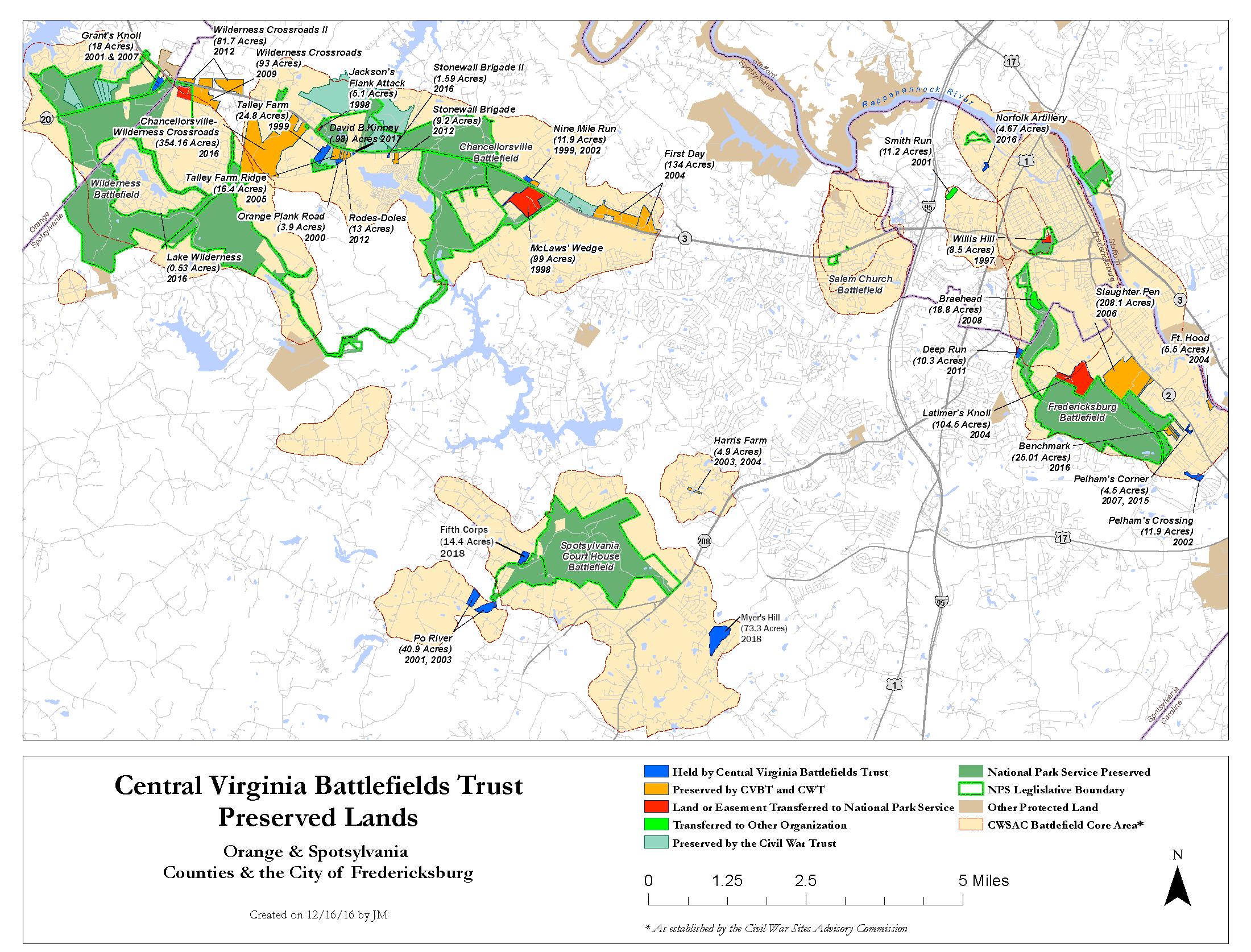
Fredericksburg, centered between the warring capitals,
Washington D.C., for the North and Richmond, for the South, made central Virginia one of the most fought over areas during the Civil War. A visiting British statesman observed a century ago, that Fredericksburg is “the cockpit of the Civil War.” For over 100 years, this region lay relatively forgotten and untouched by development. Now, again, with its proximity to Washington, D.C., and Richmond, pressure to develop this once war-torn area was great.
On Sept. 4, 1996, several dozen community leaders gathered at a Fredericksburg home to organize a group dedicated to saving the most important Civil War sites that remained unprotected. The Central Virginia Battlefields Trust grew out of that session. The next March, the CVBT received the official non-profit 501(c)3 status necessary to begin raising funds. Almost immediately, the new organization played a pivotal role in acquiring the Montfort Academy site atop Marye’s Heights, that the college sought to turn into a parking lot until blocked by political efforts at the state level. This area was a Confederate artillery position during the 1862 Battle of Fredericksburg. Several preservation groups collaborated to acquire Montfort in June 1997.

A few months later, the CVBT bought 100 acres on the south
side of Route 3, just east of Chancellorsville intersection, the “McLaws Wedge” where Lafayette McLaws’ Division fought. In 1999 and 2002, the Trust purchased a further 12 acres in two parcels directly across Route 3 from the “wedge.”
Generous bequests by the estates of Ralph Happel, retired National Park Historian, Brian Pohanka, Civil War author, historian, and preservationist, as well as the group’s loyal and growing membership base, gave CVBT the means to begin acquiring endangered battlefield land, meanwhile developing a national support base. The Trust today has loyal Partners in all parts of the United States and abroad.
In 2009 and 2013, the Trust purchased significant property around the crucial Wilderness intersection, near where modern Routes 3 and 20 meet, totaling 150 acres. For the past decade, the CVBT has achieved its greatest preservation success in the area west of Chancellorsville where “Stonewall” Jackson’s epic flank attack struck the Union right flank on May 2, 1863; that historic location enjoyed no protection at all until fairly recently. Between 1999 and 2017, the Trust purchased eleven tracts there, totaling nearly 100 acres.
By the end 2018, the Central Virginia Battlefields Trust had saved outright, or participated

in protecting, 1,300 acres on the four main Fredericksburg battlefields. In February 2018, the Trust signed a contract to save 14 acres just outside the entrance to Spotsylvania Battlefield on Brock Road, and most recently acquired 73.3 acres on the Spotsylvania Court House battlefield known as Myer’s Hill.
Tom Van Winkle currently serves as president of CVBT and is supported by a 14-member volunteer board. At this year’s 2019 annual conference, being held April 5th -7th in Fredericksburg, the CVBT will again welcome Partners from all across the country to celebrate its preservation successes by visiting sites saved and other locations that deserve protection. Its motto remains “Preserving Dirt and Grass.”
The historical benefits of that remarkable record must be obvious. As an additional benefit to local citizens, it becomes steadily more apparent that preserved battlefield land soon will be the only large block of green space in a region becoming densely urbanized. But this battle to save more hallowed ground from the blade of the bulldozer continues.
For information on becoming an active Partner and donating, please contact the Trust at P.O. Box 3417, Fredericksburg, VA 22402; (540) 374-0900, visit the website at www.cvbt.org, or email at execdirector@cvbt.org.
Artilleryman is a quarterly magazine founded in 1979 for enthusiasts who collect and shoot cannons and mortars primarily from the Revolutionary War, Civil War to World War II. Now expanded and fully illustrated in rich color throughout the entire magazine.
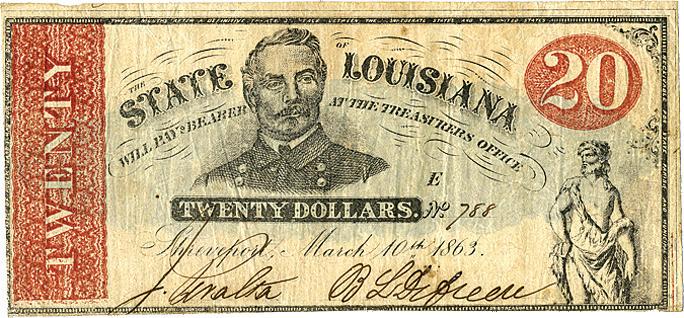
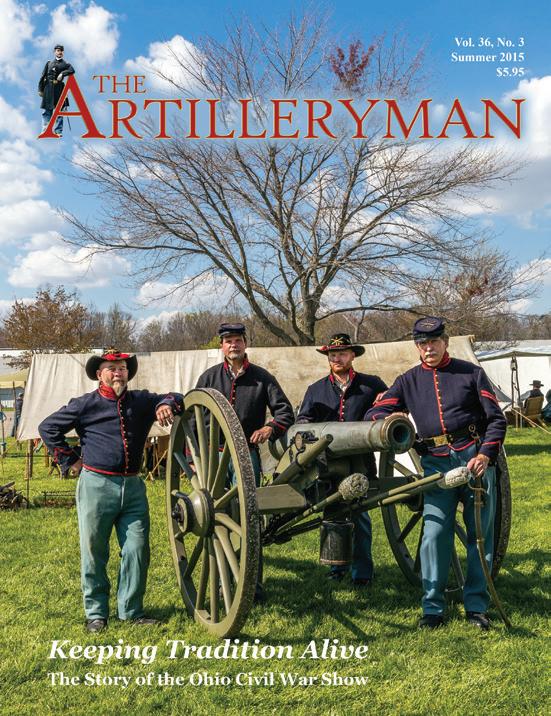
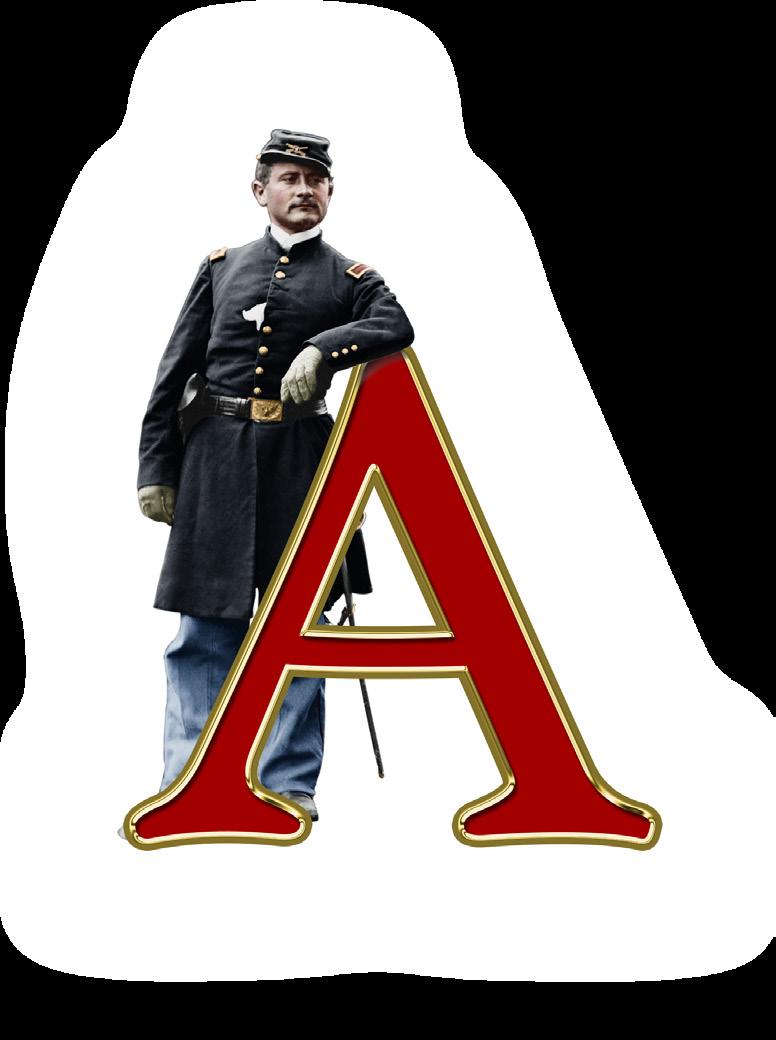


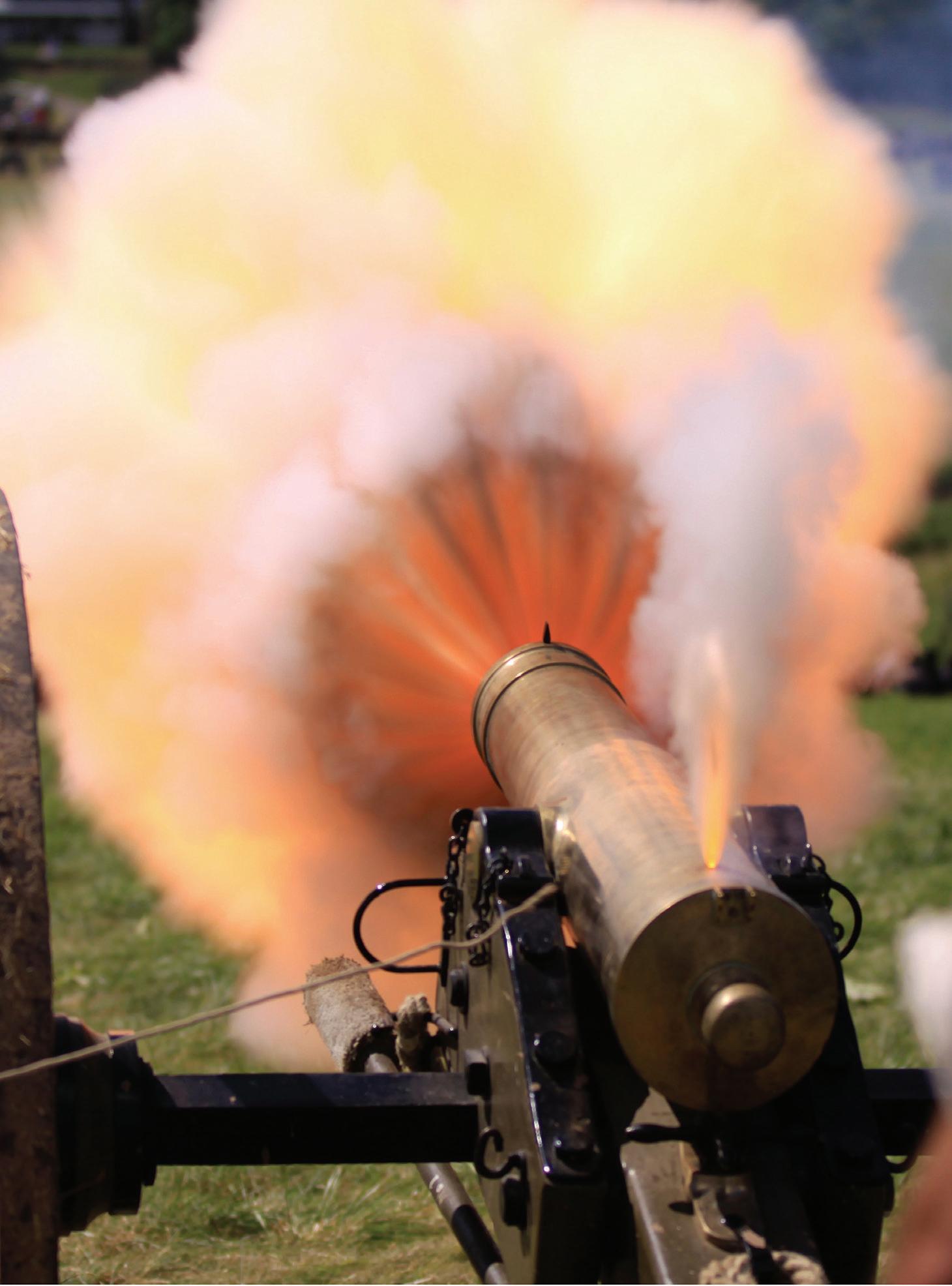
customers, including buckskinners, reenactors, modern blackpowder hunters and sport shooting enthusiasts, for 65 wonderful years.














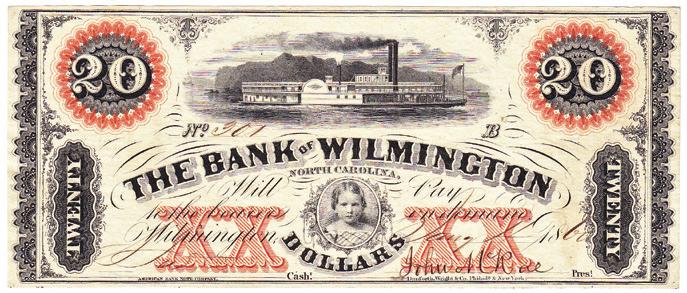



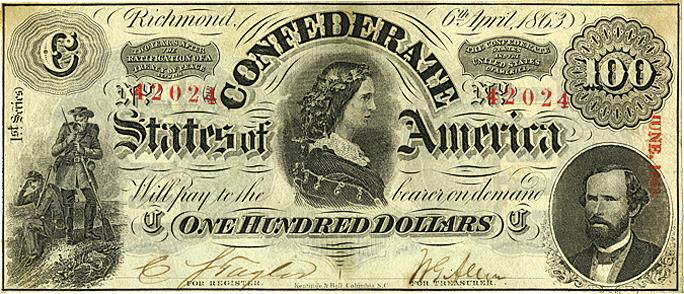

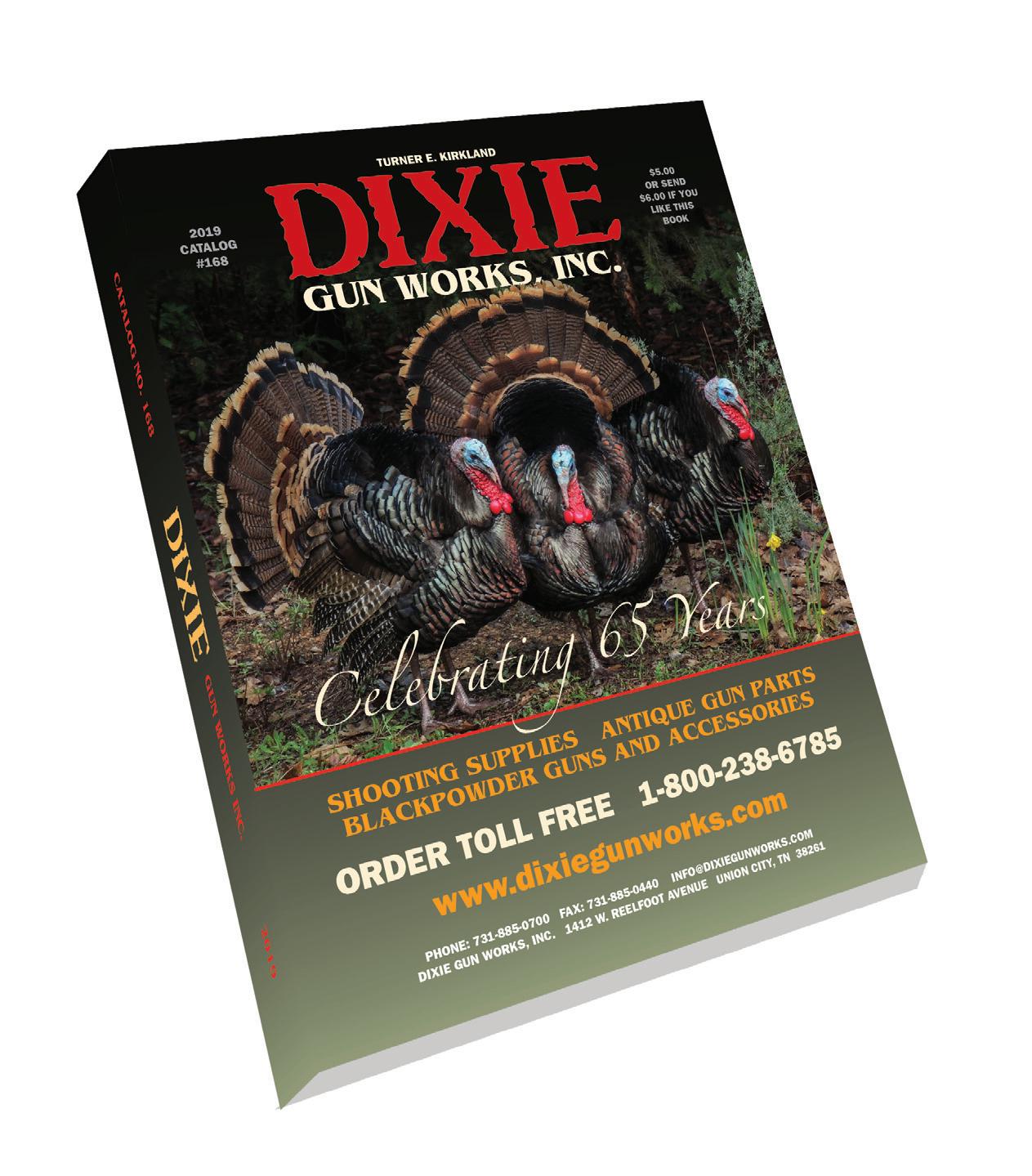



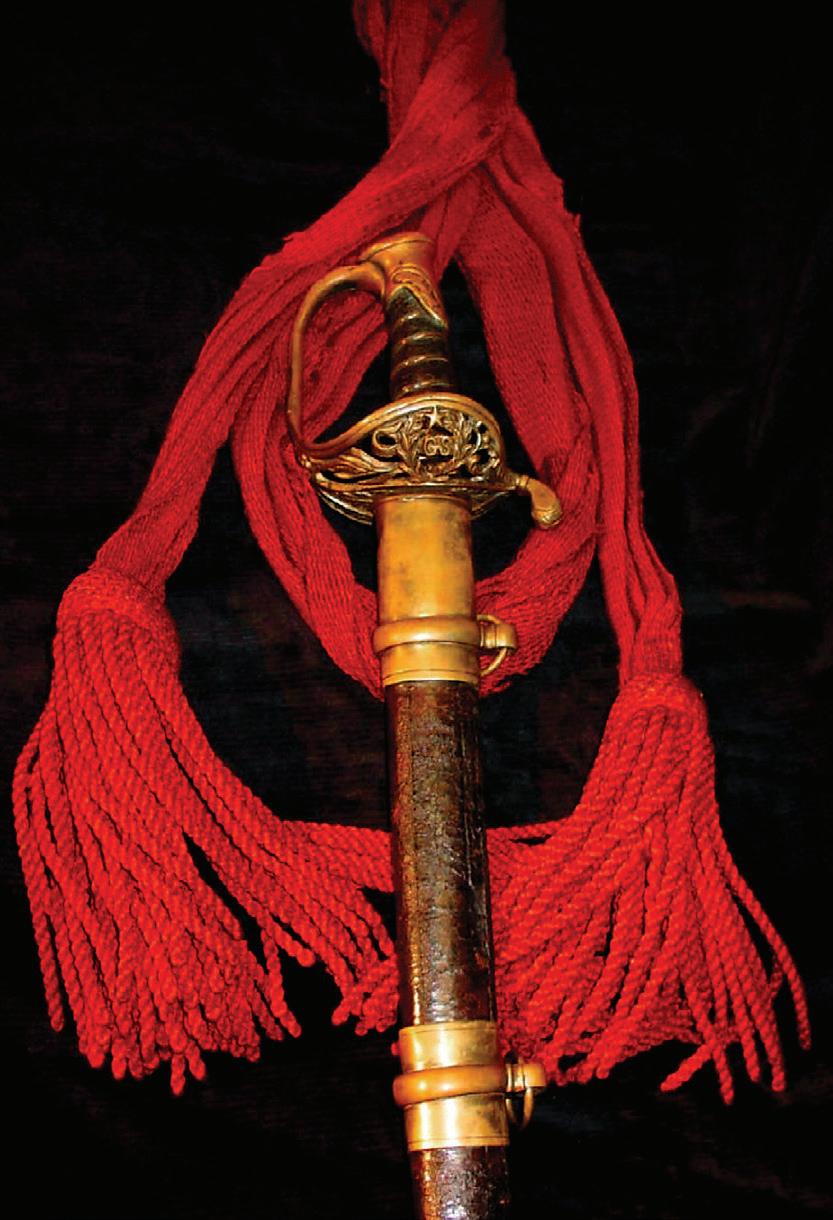
This occasional column highlights prints from the Civil War. It discusses their meaning and most importantly, what the print maker or artist was trying to achieve.
After the war, (and not during), several lithographers, artists, and publishers began memorializing the old south and the Lost Cause. The most popular figure to receive their attention was Robert E. Lee. Following close behind were Jefferson Davis and Stonewall Jackson. Copying previous groupings of commanders, particularly Union commanders, artists composed fictitious group meetings showing many Confederate commanders who were still favorably viewed by potential buyers. The myth of the Lost Cause became a new marketing endeavor for the economically struggling south, and after all, the new prints were relatively cheap by art standards.

Lee and His Generals was the creation of the Tholey brothers, Charles and Augustus. Unlike most lithographers of the 19th century, they were native born; their grandfather had migrated from Alsace-Lorraine to Philadelphia in 1848 during the revolutions in Europe that year. They worked in lithography with well-known artists/printers such as the Duvals, who specialized in military subjects. During the
war, the Tholeys produced prints of Grant and his staff, Lincoln’s funeral in Philadelphia, the Battle of Antietam; and of course, Lee and his Generals.1
The Tholeys may have been adequate artists, but they were short on historical accuracy and details. Lee, of course, is the central figure on a white horse that bears little resemblance to Traveler who was gray. The most prominent generals of the Confederacy surround Lee in “a clever composite of portraits based on photographs…all on improbable
bodies and horses.” The meeting never took place but that, and the obvious miscues, did not seem to matter to the Lost Cause market. The print was lithographed by Joseph Hoover and published by John Calvin Smith, both of Philadelphia, in 1867.2 Hoover specialized in chromolithographs and his business flourished from 1856 well into the 20th century before folding in 1985.3
The Tholeys gave prominence to P. G. T. Beauregard shown in the far-left corner. Between Beauregard and Lee is Joseph E.
Johnston; between Johnston and Lee is Albert Sidney Johnston, dead since Shiloh. Over Lee’s left shoulder are Longstreet and then Stonewall Jackson. Lesser known lights occupy the mid and background, sharing space with neat rows of white tents and drilling soldiers. A cannon completes the scene in the lower right corner.
It’s remarkable that a northern lithographic firm, a creature of the victorious side, would celebrate the vanquished (and rebellious) in such a heroic and robust manner. Looking at this print with 21st century eyes and void of any contextual references, makes one question who won and who lost the war. Conventional scholarship places the blame of the myth of the Lost Cause on various southern constituencies—the Klan, the United Daughters of the Confederacy (UDC), Jubal Early, and Confederate veterans. They may have all played a role furthering the narrative; but there are countless examples of northern printers, artists, and publishers offering heroic prints such as this who contributed mightily to the myth.4
How ironic.
1. Harry Peters, America on Stone, New York, Arno Press, 1976 reprint, 383.
2. Mark Neely, Harold Holzer and Gabor S. Boritt, The Confederate Image: Prints of the Lost Cause. Chapel Hill: University of North Carolina Press, 1987, introduction, caption, Plate 12.
3. Jay T. Last, The Color Explosion: Nineteenth Century American Lithography, Santa Ana, California: Hillcrest Press, 2005, 196.
4. See Caroline E. Janney, Remembering the Civil War: Reunion and the Limits of Reconciliation, Chapel Hill: University of North Carolina Press, 2013.

Salvatore Cilella is retired after 43 years in the museum field. His last position was President and CEO of the Atlanta History Center. He is the author and editor of several articles and books including Upton’s Regulars: A History of the 121st New York Volunteers in the Civil War (U. Press Kansas, 2009) and The Correspondence of General Emory Upton, 1856–1881 (U. Tennessee Press, 2017).
of Congress)

Chancellor Carol L. Folt of the University of North Carolina announced on January 14 that she will step down at the end of the academic year this spring.
“There has been too much recent disruption due to the monument controversy,” Folt wrote in an email addressed to the University community,” referring to the tearing down last summer of “Silent Sam,” the Confederate soldier’s monument on campus.
In her letter Folt stated that she had authorized removal of the monument base and its commemorative plaques removed from McCorkle Place at the center of the Chapel Hill campus. The base had been left when the statue was taken down. “The presence of the remaining parts of the monument on campus poses a continuing threat both to the personal safety and well-being of our community and to our ability to provide a stable, productive educational environment,” Folt explained.
Within forty-eight hours of
the Chancellor’s email, eight responses had been posted on the university alumni association’s website, Carolina Alumni Review. They were unanimous in criticizing the university’s actions regarding “Silent Sam.”
In six of the eight posts, words used included “cowards,” “cowardly,” “cowardice” and “spine of a jellyfish.” One respondent recalled that the monument had been taken down in the middle of the night.
These unhappy alums would have been pleased to learn that the University System’s Board of Governors had apparently had enough. On January 15, the day after Chancellor Folt announced her plans to resign; the board directed that she had to leave by January 31.
Chairman Harry Smith made it clear that the Board of Governors was displeased with the chancellor’s decision to remove Silent Sam’s base from campus. “We are incredibly disappointed at this intentional action,” Smith said in a statement issued Monday night, January 14, just hours after Folt sent out her announcement.
Carol Folt was to have left UNC at the end of the academic year this May. The Board gave her two weeks to clear her office.
published from February of the previous year to February of the current year. Review will consider biographies, monographs, works of synthesis and interpretation, edited collections of original papers, and documentary editing projects published in the English language.
The Lincoln Forum has created a new $1,000 prize to honor the year’s best book on Abraham Lincoln—or a distinguished work in which Lincoln is a central figure.
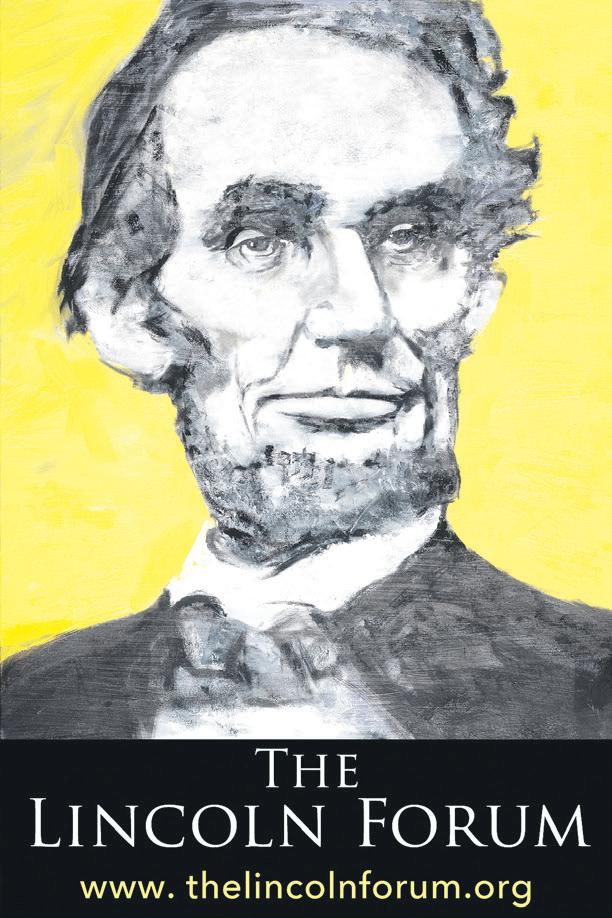
The book prize will be awarded each year at the Lincoln Forum symposium in Gettysburg, which will next take place November 16-18, 2019.
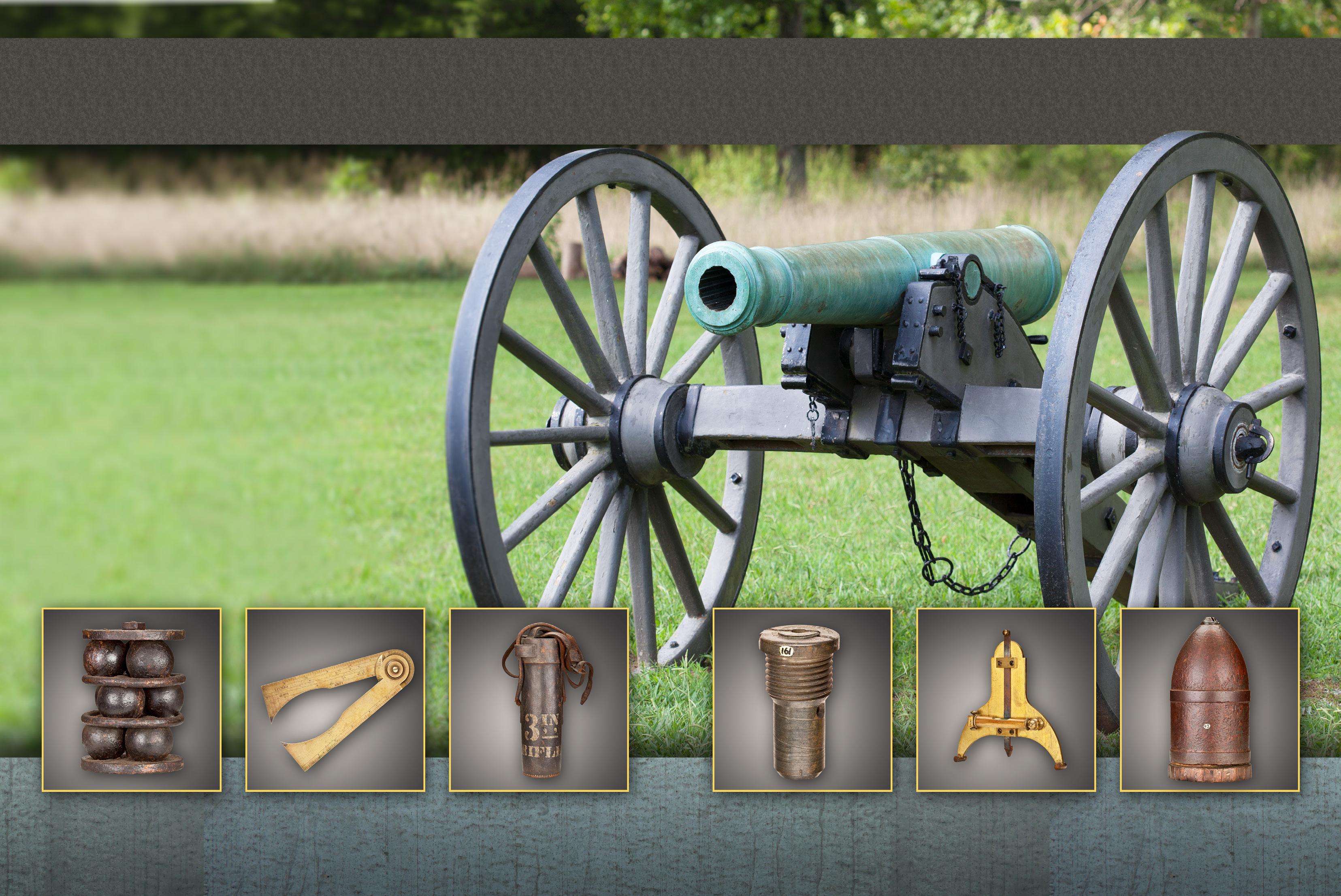
The prize will honor books
The new prize takes its place alongside two long-traditional, annual Forum honors: the Richard Nelson Current Award of Achievement for lifetime accomplishment in the history field; and the Wendy Allen Award for outstanding achievement by a history organization.
Judges for the Forum’s first book prize will be: Dr. Thomas A. Horrocks (Chairman of the Book

Prize Committee), historian, author, and Lincoln Forum executive committee member who has held administrative posts at both Harvard University’s Houghton Library and Brown University’s John Hay Library; Dr. Michelle Krowl, author, Lincoln and Civil War specialist at the Manuscript Division of the Library of Congress, and Secretary of the Lincoln Forum; and Daniel R. Weinberg, author, manuscripts expert, Forum board member, and longtime proprietor of the Abraham Lincoln Book Shop in Chicago.
For more information on the Lincoln Forum Book Prize, contact Dr. Horrocks by email at: thomasahorrocks@gmail.com.
Gibbs

With all of the trials and tribulations experienced during the life of the Gibbs Carbine, it is a story might best be entitled The Carbine That Was Never Meant To Be. The Gibbs carbine was contracted for no fewer than four times before it finally went into production, experienced major delays in manufacturing, and was eventually killed by a factory fire. All these events combined to make the Gibbs one of the scarcest U.S. contract Civil War carbines to see issue and use, and one of the harder U.S. military carbines to find for sale on the market.
The Gibbs Carbine had its genesis as the invention of Lucius H. Gibbs, an inventor and gunsmith living in Oberlin, Ohio. Gibbs had previously received U.S.

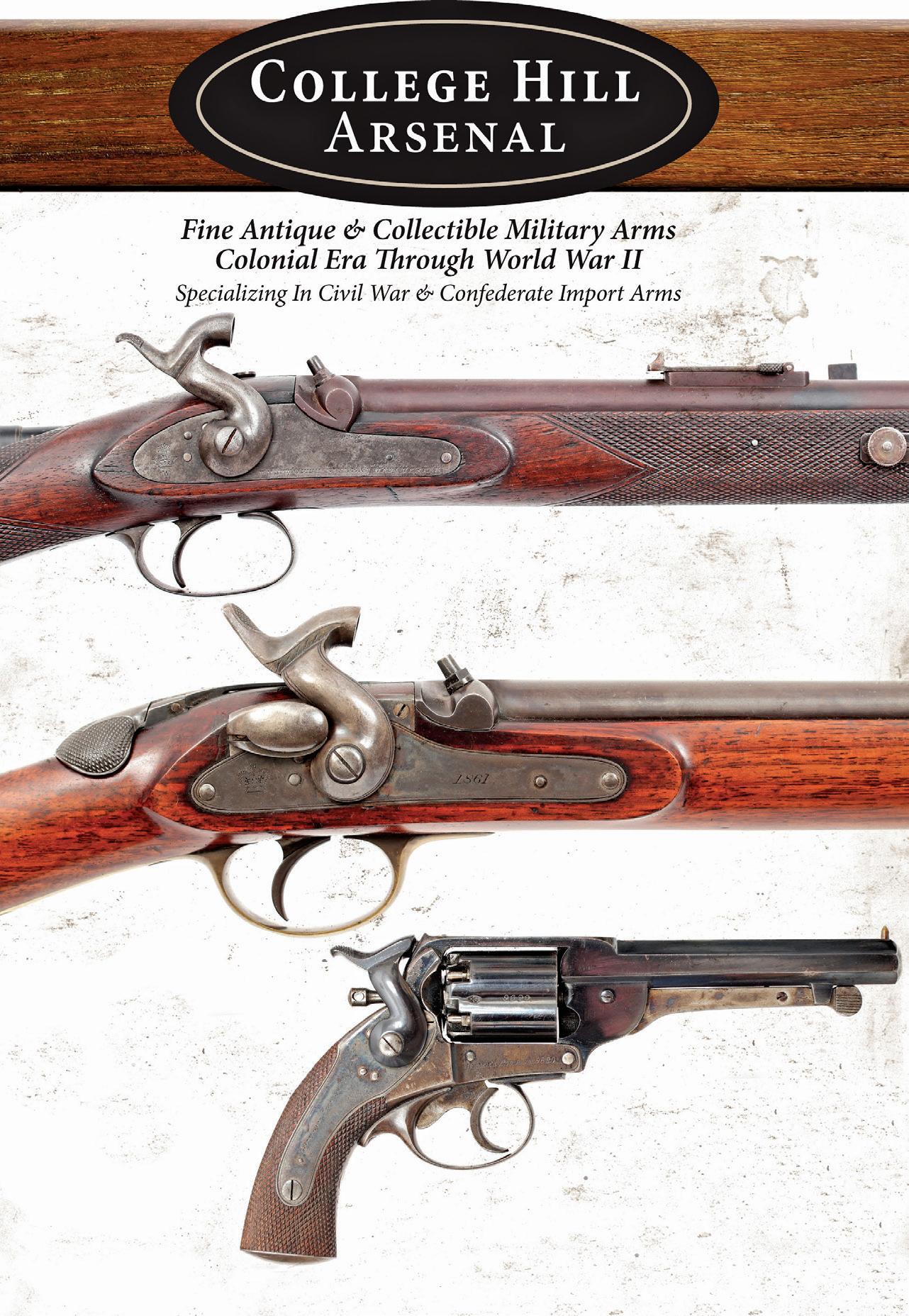
Patent #5316 on Oct. 2, 1847, for a percussion-repeating rifle. The revolving rifle shown in the patent drawings bears a vague resemblance to Colt’s Patterson revolving rifles but is truly unique. Gibbs’ patent specification describing the unique action reads in part:
The nature of my invention consists in making the breechstock of the gun tubular, the tube communicating with the breech of the gun barrel for the purpose of receiving a number of shot-charged cylinders in such a manner that as soon as one is discharged of all its loads it may be easily and quickly taken from the gun, as here-in set forth, and another cylinder made to take its place by simply dropping the muzzle of the gun.
However, in my research I could find no records of Gibbs’

patent repeating, revolving, percussion rifle having ever been produced.
Gibbs’ patent that applied to his Civil War carbine was #14057, issued on Jan. 8, 1856. The patent was for a single shot, percussion, breech loading arm. At that time, Gibbs listed his residence as New York City. It appears that Gibbs may have produced a few single shot pistols using the same patented breech design, but these are so scarce that Flayderman’s Guide to Antique American Arms does not asses a value for them. Gibbs’ design was not particularly revolutionary, in the greater sense of “invention,” but was more of an “improvement” upon existing designs and was patented as such.
The Gibbs system used a lever


under the breech to push the barrel away from the breech face of the carbine and tilt it down for loading. The system is in fact very similar to the Gallager Carbine (patented in 1860), and the Gallager was likely heavily influenced by the existing Gibbs design. The Gibbs patent was probably influenced by Edward Maynard’s carbine (patented May 1851), where an under lever pushed the barrel away from the breech face and tilted it down for loading and unloading. The Maynard system relied upon a brass cartridge case to seal the rear of the barrel against the breech face to prevent the escape of gasses when the gun was fired. This meant that the brass case had to be manually extracted after each shot. Gibbs’ system used a small button shaped projection on the face of the breech to fill the rear of the barrel’s chamber and seal it against gas leaks. This allowed the use of combustible paper or linen cartridges, like those in the Sharps designs, and eliminated the need to extract spent cartridge cases.
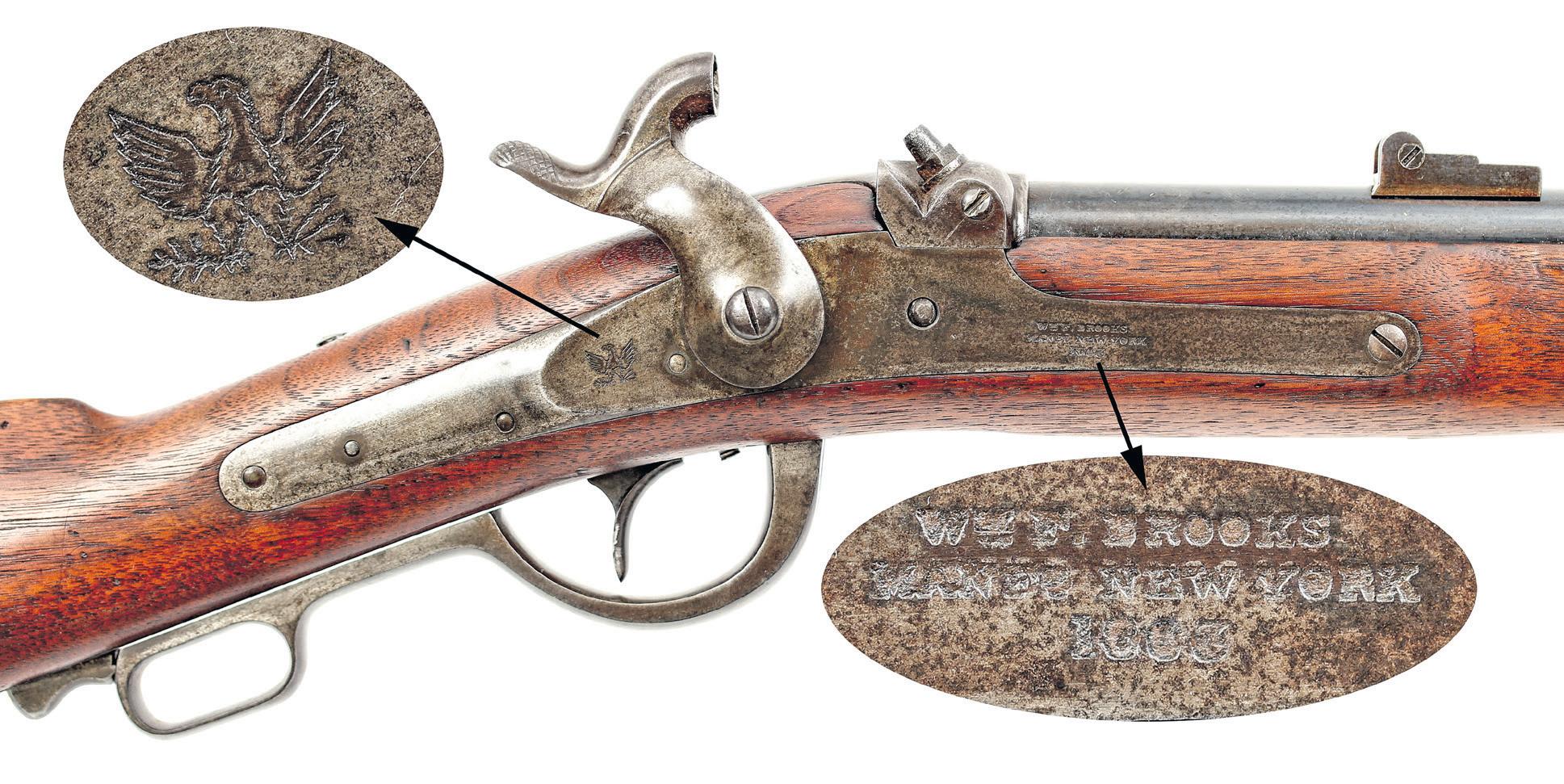
From a purely economic point of view, the ammunition was cheaper and easier to produce, as no metal case was required for the Gibbs cartridge. As
Gibbs described in his patent application:

…my said invention also consists in combining with a sliding barrel made with the rear or breech end open, a fixed breech pin which fits the bore of the rear end of the barrel, in combination with an annular recess surrounding the said pin to receive the rounded edge of the rear end of the barrel, to prevent as much as possible the escape of gases and in case of any escape to deflect them toward the muzzle.
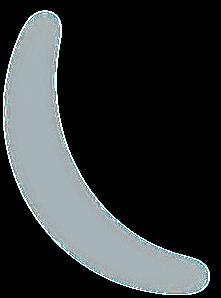
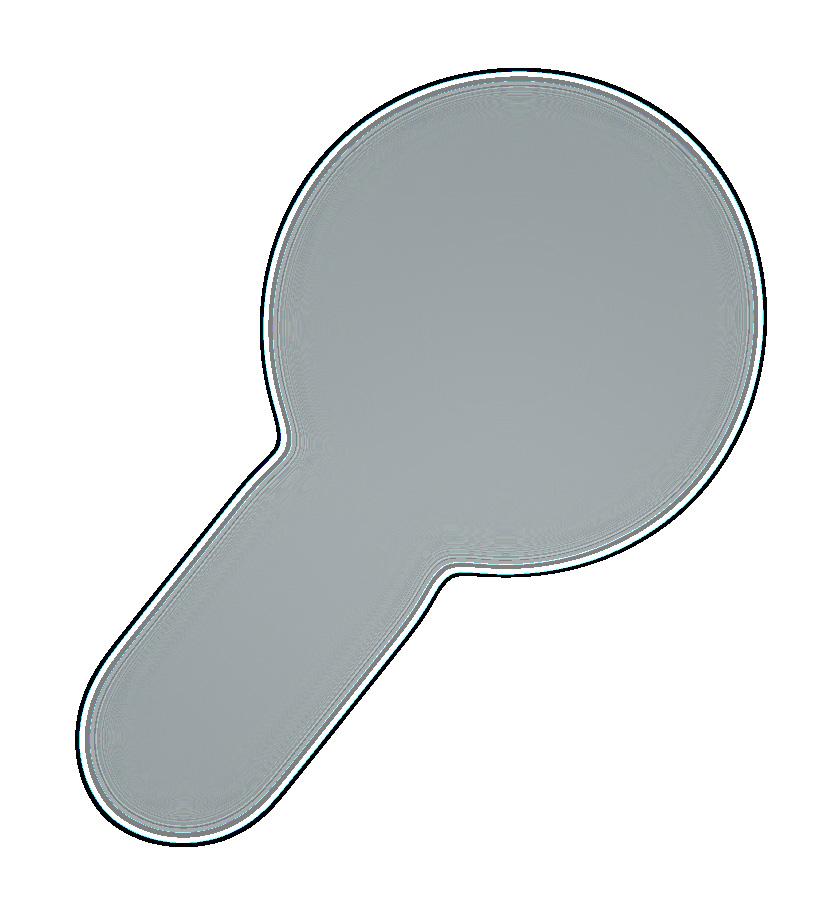
Sometime during 1857, Gibbs managed to have approximately twenty sample carbines produced, most likely by W.W. Marston of New York. At least one of these carbines was tested by a U.S. Army Ordnance Board at West Point during 1858, and was considered to be a generally good design, but no orders were forthcoming. The carbine was a simple, single shot, percussion breechloader whose action was opened by lowering a lever that was an extension of the triggerguard. The lever resembles a miniaturized version of the classic Winchester lever, with a much smaller loop for the hand and an extension between the loop and triggerguard.

The carbine had a .52 caliber, 22-inch round barrel and was 39 inches in overall length. The carbine’s barrel was blued, with a color casehardened lock and furniture, and mounted in a walnut stock. The standard markings on the production Gibbs carbines that were delivered included a three-line horizontal lock mark as well as a three-line breech marking. The very long, elongated lock plate was marked, forward of the hammer: WM F. BROOKS / MANFR NEW YORK / 1863.
To the rear of the hammer, it was marked with an American Eagle, although it is a sort of scrawny, “chicken necked” eagle. The top of the breech was marked L.H. GIBBS / PAT’D / JANY 8, 1856. The buttplate tang was marked with the standard U.S. found on period U.S. military muskets. The inspection cartouches were stamped on the reverse of the stock, close to the butt, and not in the usual location on the reverse wrist. It appears that Samuel T. Bugbee inspected most of the Gibbs carbines that were completed and delivered, as the handful of extant examples with legible cartouches show his script STB stamp in the wood.
A short sling bar and ring were mounted to the long, elongated side plate on the reverse that mirrored the lock plate’s contours. A single barrel band served double duty as a forend cap. The front sight was a brass blade mounted in a dovetailed iron base, but the rear sight was a standard U.S. rifle musket rear sight, with the leaves graduated to 100, 300, and
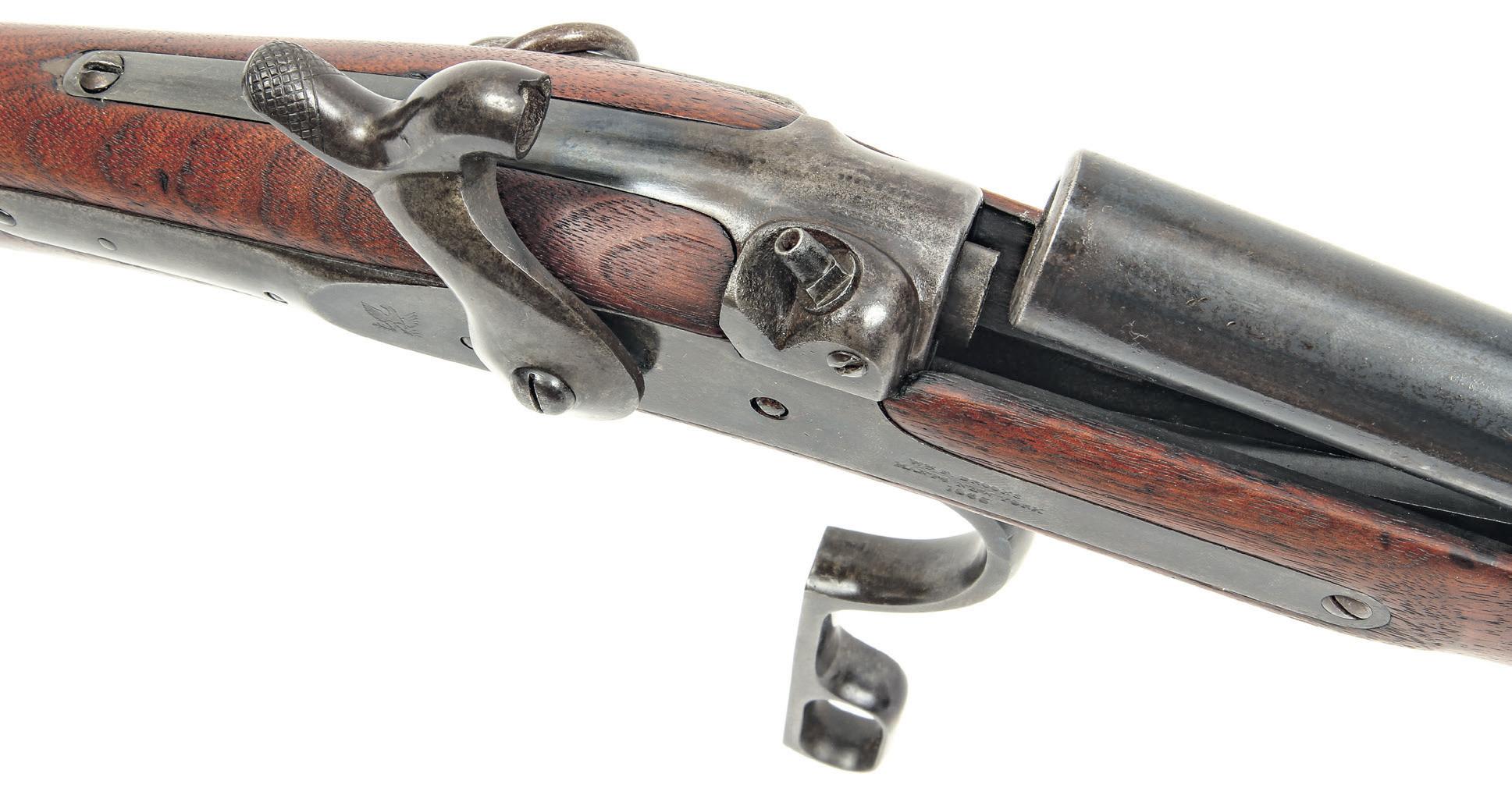
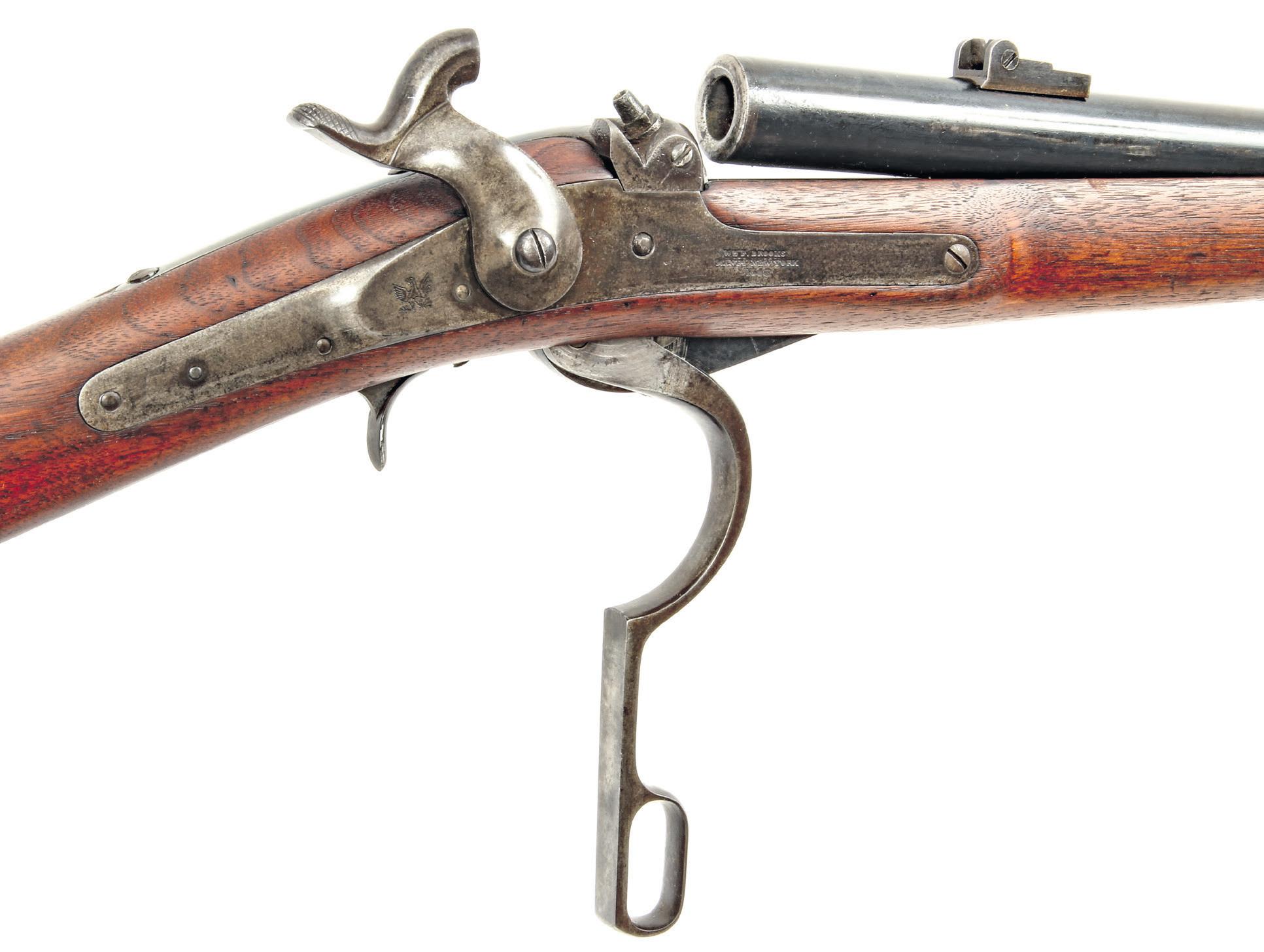

500 yards. While the wartime production carbines used the U.S. Pattern 1861 rear sight adopted during the summer of 1861, it is likely that the earlier test carbine used a U.S. Pattern 1858 rear sight.
With the coming of the American Civil War, and the U.S. military’s desperate need to acquire breechloading small arms for the cavalry, Gibbs finally seemed poised for success. On Oct. 24, 1861, Thomas Fields, representing Strobell & Company of Washington, D.C., submitted a proposal to the U.S. Ordnance Department to deliver 10,000 Gibbs carbines at a rate of $28.00 each. The Ordnance Department subsequently recommended on Nov. 21, that the proposal be reduced to 5,000 guns, and issued a contract to Strobell & Company, to be returned in January 1862. Strobell & Company never returned the signed contract for this order, and it was subsequently cancelled.
The Ordnance Department initiated a second contract with Strobell & Company on Dec. 13, 1861, for 10,000 Gibbs carbines; exactly the same proposal that Fields had put forth only weeks earlier! This contract, however, appears to have been either issued by accident or as a duplicate for yet another Gibbs carbine contract. In any case, the HoltOwen Commission that investigated U.S. military contracts, and all the problems that seemed to go along with them, cancelled both Strobell & Company orders. The first contract was annulled on
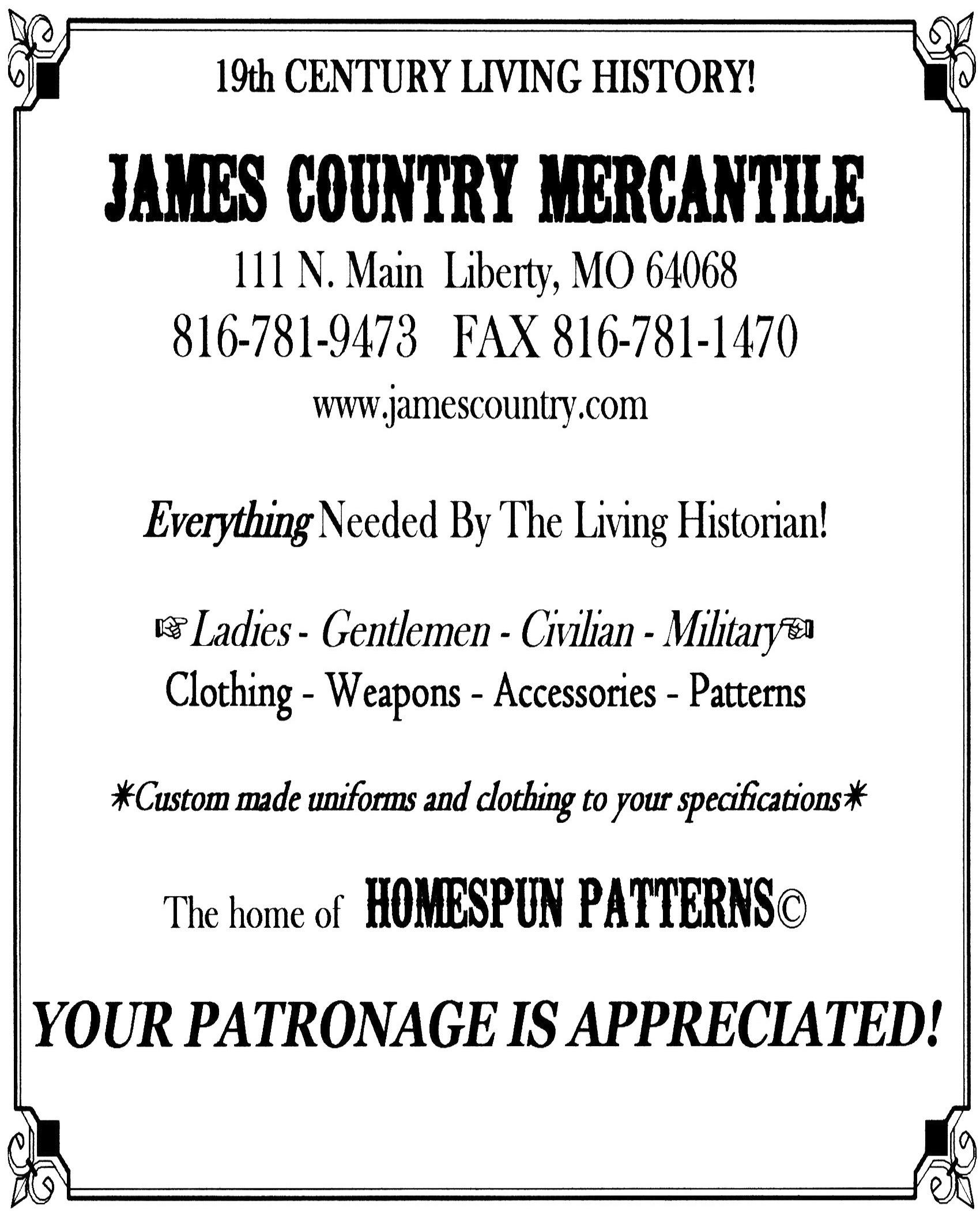
the grounds that the original contract had never been signed and returned by Strobell as required, and it was argued that the second contract was really issued to another company! Interestingly, researchers have yet to determine who Strobell & Company or Fields were, and there is no evidence that either entity ever had anything to do with firearms production or manufacturing. It is most likely that they were simply arms speculators hoping to secure governments arms contracts, with the plan of having sub-contractors do the actual work.
The Dec. 13, 1861, contract for 10,000 Gibbs carbines was apparently intended for William F. Brooks of New York City. Brooks was also the recipient of
a contract for 10,000 U.S. M1861 Rifle Muskets, issued the same day as the Gibbs contract. Brooks was another speculator, who had no firearms manufacturing capability. While testifying before the Holt-Owen Commission, Brooks noted that he was a “brass and flue manufacturer.” He further noted that he intended to have W.W. Marston’s Phoenix Armory, the firm that made the twenty initial sample carbines, manufacture both the Gibbs carbines and the M1861 rifle muskets. Brooks was to have the first 1,000 guns under each contract delivered by April 12, 1862, and to continue deliveries at the rate of 1,000 per month until the contract was completed.
By April 1862, no Gibbs carbines, or any rifle muskets,
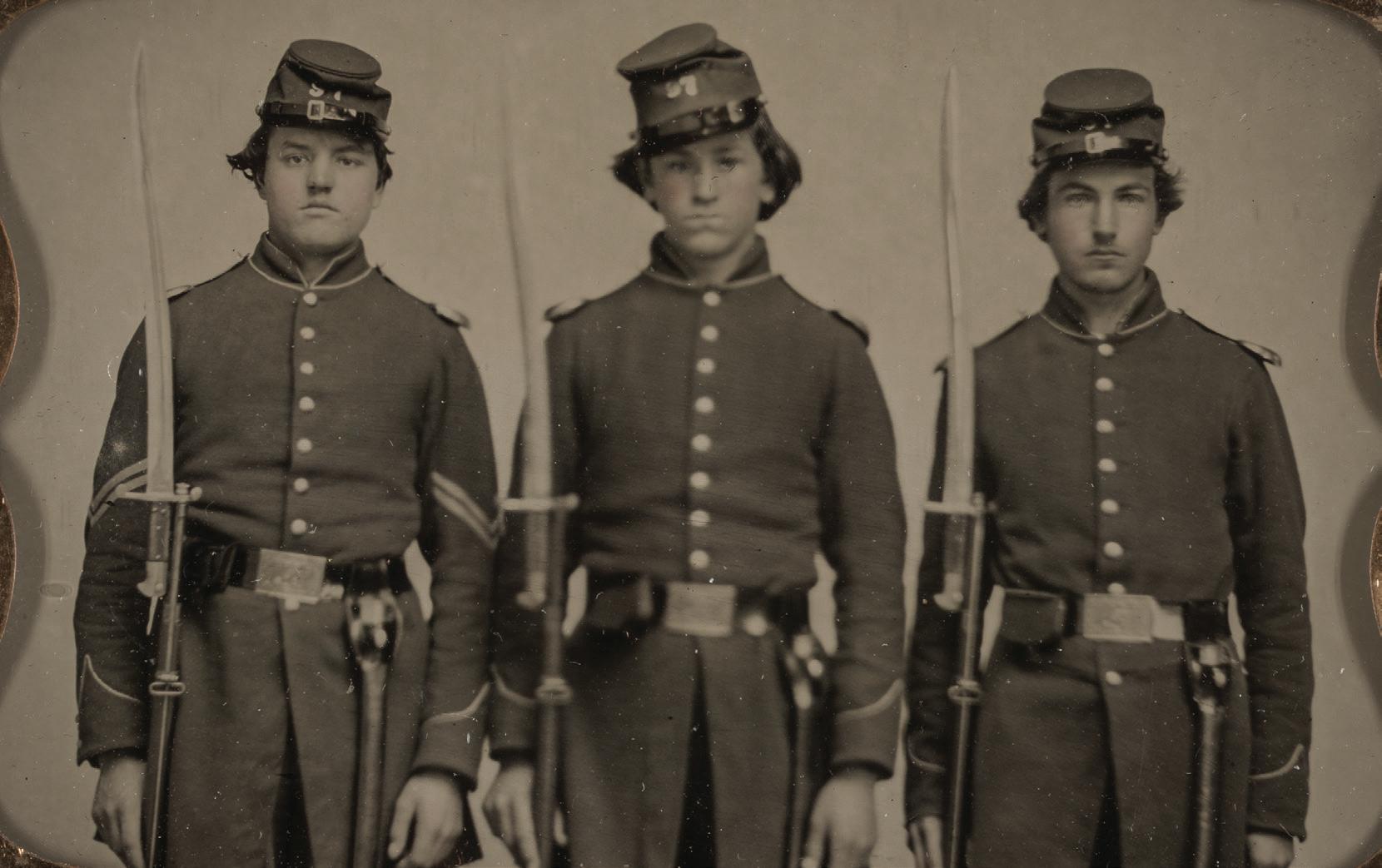
had yet been manufactured or delivered. The Holt-Owen Commissioners investigated the situation very quickly, and even sent Captain Silas Crispin of the U.S. Ordnance Department to inspect Marston’s manufacturing facility. Crispin’s report noted that Marston’s factory was capable of producing the Gibbs carbines, given the necessary time, tooling, and materials. He also noted that they had already sub-contracted for barrels and some small parts, had invested sufficiently in the required machinery to manufacture the necessary additional components, and assemble the guns. However, he noted that there appeared to be no progress at all in regard to manufacturing of the rifle muskets, and
on April 18, 1862, that portion of the contract was voided. The commission did, however, agree to maintain the carbine contract.
On June 21, 1862, the Gibbs carbine contract was reissued, making this the forth official contact for these guns, with the first delivery of 1,000 carbines to take place on Aug. 1, 1862. As with every previous contract for Gibbs carbines, the sellers were once again in default, and not a single gun was delivered under the contract. For whatever reason, Marston did not seem to have had the ability to get his operations under control and ready to manufacture the guns. On Dec. 1, 1862, the Mayor of New York City, George Opdyke, bought Marston’s Phoenix Armory and the Gibbs carbine contract and went to work filling it. As Opdyke wanted to avoid any appearance of impropriety, and because he was probably busy running the city, he placed the factory in the name of his son-in-law, G.W. Farlee.
They hired new management including two new factory superintendents and a special foreman to supervise production of the Gibbs carbines. The man hired to directly oversee Gibbs carbine production was John W. Keene, a U.S. Ordnance Department sub-inspector at the time. Keene eventually would go on to work for Remington about a year later and would also invent the Remington-Keene bolt-action repeating rifle. Interestingly, it appears the Keene made his first trip to Ilion, N,Y., to investigate the possibilities of having Remington complete the Gibbs carbine contract, after the factory fire of July 1863 ended production; but we are getting a little ahead of the story.
With new management and leadership, the bad luck that followed the Gibbs carbines from their first contract seemed to have been wiped away. After four different contracts and nearly two years of delays, the factory was able to deliver the first five hundred and fifty Gibbs carbines to the Ordnance Department on May 30, 1863. The next five hundred and two were delivered on June 24, 1863. By July 13, 1863, another five hundred were completed and ready for inspection at the factory, prior to delivery, and some six thousand more were in the process of being built or assembled. That same day, the “curse of the Gibbs” struck again,
and this time ended the Gibbs story permanently.
On July 13, 1863, the New York Draft Riots broke out in response to the newly established national conscription act. Rioters tore through the streets of New York looting, burning, attacking, and killing. Whether they attacked the former Phoenix Armory because they wanted weapons, because they knew it was owned by the Mayor, or just as a random act of destruction is unclear; but attack it they did.
The rioters were initially driven off by New York City police stationed at the factory to protect it. The factory superintendents issued the thirty-four policemen Gibbs carbines. After the police shot and killed one of the rioters, the mob moved off. However, the situation in the city had become truly dangerous, and with only the police trying to control the rioters (the New York Militia had been sent to Pennsylvania due to Lee’s invasion of that state), the police stationed at the factory were sent to other parts of the city to help. Later that day rioters returned to the factory and burned it. In the process they destroyed five hundred completed carbines and the six thousand others being assembled.
In the end, all the time, effort, and capital spent on the production of the Gibbs carbine resulted in only 1,052 being delivered to the U.S. government. Nearly all these guns were issued for use in the field; Gibbs carbines have been documented as being issued to the 13th and 16th New York Cavalry (who were issued 95 and 111 carbines respectively) and the 10th Missouri Cavalry (426), for a total confirmed issuance of 632. Others were likely issued as well, although the carbine was ill thought of in service, especially when compared to the Sharps and Spencer.
Tim Prince is a full-time dealer in fine & collectible military arms from the Colonial Period through WWII. He operates College Hill Arsenal, a web-based antique arms retail site.
A long time collector & researcher, Tim has been a contributing author to two major book projects about Civil War era arms including The English Connection and a new book on southern retailer marked and Confederate used shotguns. Tim is also a featured Arms & Militaria appraiser on the PBS Series Antiques Roadshow.

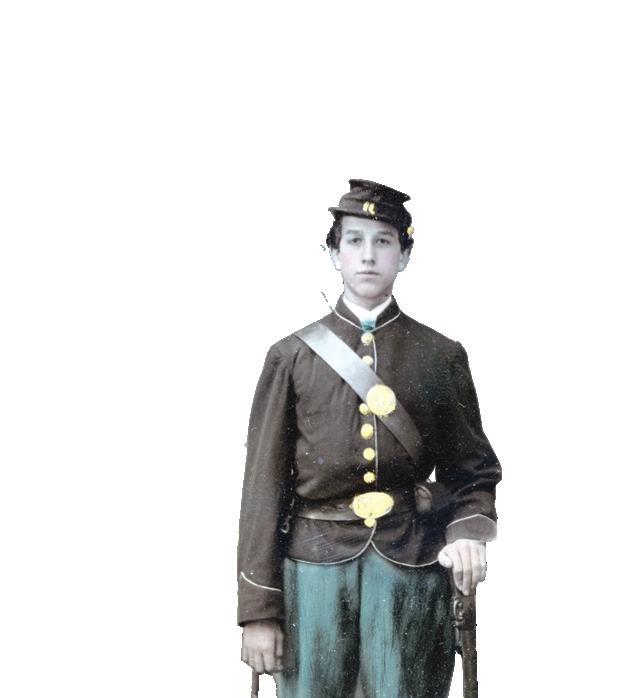
Once again, the 2019 Civil War show season opened the first week in January with the 25th Annual Low Country event, which has been sponsored by American Digger magazine for the last four years. In contrast to last year’s show, when a freak snow and ice storm hammered the traditionally mild South Carolina Lowcountry climate, affecting dealer turnout, the weekend weather was nearly perfect. The show was held on Jan. 5-6 at the spacious Omar Shrine Center in Mt. Pleasant, just across the river from historic Charleston.

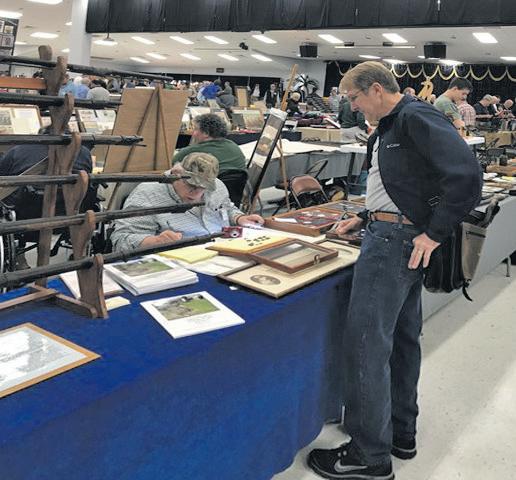
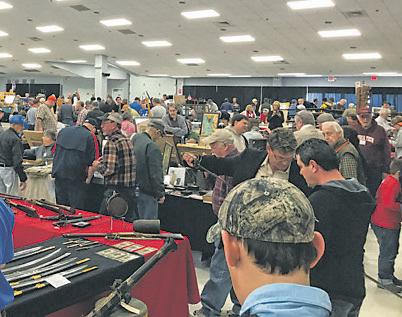
Dealers and exhibitors came from all over to attend this year’s event, making the show a virtual sell out of the 200 tables. The public also came out in droves, partially due to increased public marketing. Multimedia advertisements in local newspapers and on social media complimented a billboard for the show, plus aggressive advertising and giveaways on Charleston radio station WTMA, including an in-studio interview with show promoters Butch Holcombe and Mark Schuessler. Unplanned marketing was accomplished when the local NBC TV affiliate showed up to film a segment on the show, which was then shown on Channel 2 for three consecutive news hours on both Saturday and Sunday, creating a much larger than normal Sunday crowd.
Exhibits and sale included items from ancient times up to WWII. Bottles, weapons, artillery projectiles, documents and paper items, books, dug and nondug artifacts, arrowheads, jewelry, Americana, and more were seen throughout the hall. Door prizes, including metal detectors donated by Minelab and Garrett, were given away to lucky ticket holders. Feedback from dealers was enthusiastic, with many saying it was the best show they have had here in years. An oyster and lowcountry barbecue, a long running tradition, was catered by Charlestonian Jamie Westendorff, on Friday evening for all table holders. Next year’s show has already been announced for January 4-5, 2020. With orders for table spaces already coming in, it is already shaping up to be a must-attend event.
Visit www.AmericanDigger.



information.
Awards were given as follows: Best Dug Artifact—Jerry Kirkland; Best of Show/Award of Excellence—Mike Fisher; Best NonDug Artifact—Bill Blackman; Most Educational—Art DiFilipio.
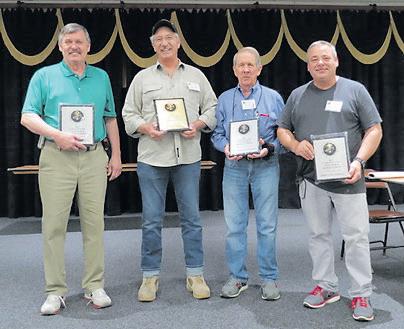
Wes Freeman’s career has been marked by great variety. The Vietnam veteran did a 10-year stint with the DeKalb County, Ga., Sheriff’s Department, working in the county jail and serving on the SWAT team. He drove an 18-wheeler. He sold insurance. Since 2005 he and his wife Barbara have owned a trapping company, helping homeowners in the Atlanta area get rid of squirrels, rats, and raccoons, and sometimes even bears, deer, and coyotes. Wes is a friendly and talkative man, and listening to him tell stories about catching wild animals and controlling inmates is a pleasant and entertaining way to spend an hour or two.
Why, you ask, is Wes the subject of a column in Civil War News? Well, it is not just unruly bears or prisoners he has dealt with; the reason is his first job after his return from Vietnam. Wes is the last man alive who worked on the Stone Mountain carving.
In late 1970 or early 1971, his friend Nelson Wilborn suggested he might work with him at Stone Mountain Park. Wes expected to get employment on the maintenance crew or something like that. Instead he found himself high above ground, on a platform pinned to the mountainside, talking to chief carver
Roy Faulkner, the man in charge of turning the rock face into a Brobdingnagian sculpture.
Faulkner was a rather eccentric man and he gave Wes a rather eccentric interview. When Wes proved that he did not fear heights but was prudent enough not to take chances, Faulkner said “you’re hired” and put him right to work.
For the next two years or so Wes’s workplace was a platform in the sky, built on steel beams fixed to the granite. A scaffold hanging below that was raised and lowered by two winches. Here Faulkner and his crew cut the rock away to reveal the men and horses inside.
The carving, begun by Gutzon Borglum in 1923 and taken over by Augustus Lukeman in 1925, was abandoned in 1928. After a long hiatus, work resumed in 1964 under the aegis of the state of Georgia. While Wes was on the job almost all the work was done by Faulkner, Nelson Wilborn, and Wes. The previous carvers used dynamite, but under the supervision of sculptor Walker Hancock, gentler methods were employed to create the huge images of Jefferson Davis, Robert E. Lee, and Stonewall Jackson. In some places the men used pneumatic tools similar to jack-hammers.


This unique work contains a complete photographic record of Georgia’s memorials to the Confederacy, a full transcription of the words engraved upon them, and carefully-researched information about the monuments and the organizations which built them. These works of art and their eloquent inscriptions express a nation’s profound grief, praise the soldiers’ bravery and patriotism, and pay homage to the cause for which they fought.
www.mupress.org
866-895-1472 toll-free
In others they drilled holes into the stone and broke it up by driving wedges, or “splits,” into the holes. Shaping was done with a “thermo-torch.”
The thermo-torch was a device designed by Faulkner. It was a portable version of a much larg er tool used to split rock in the quarry, Wes said. It was fueled by a mixture of liquid oxygen and kerosene, the thermo-torch spit out fire at 7,000 degrees.
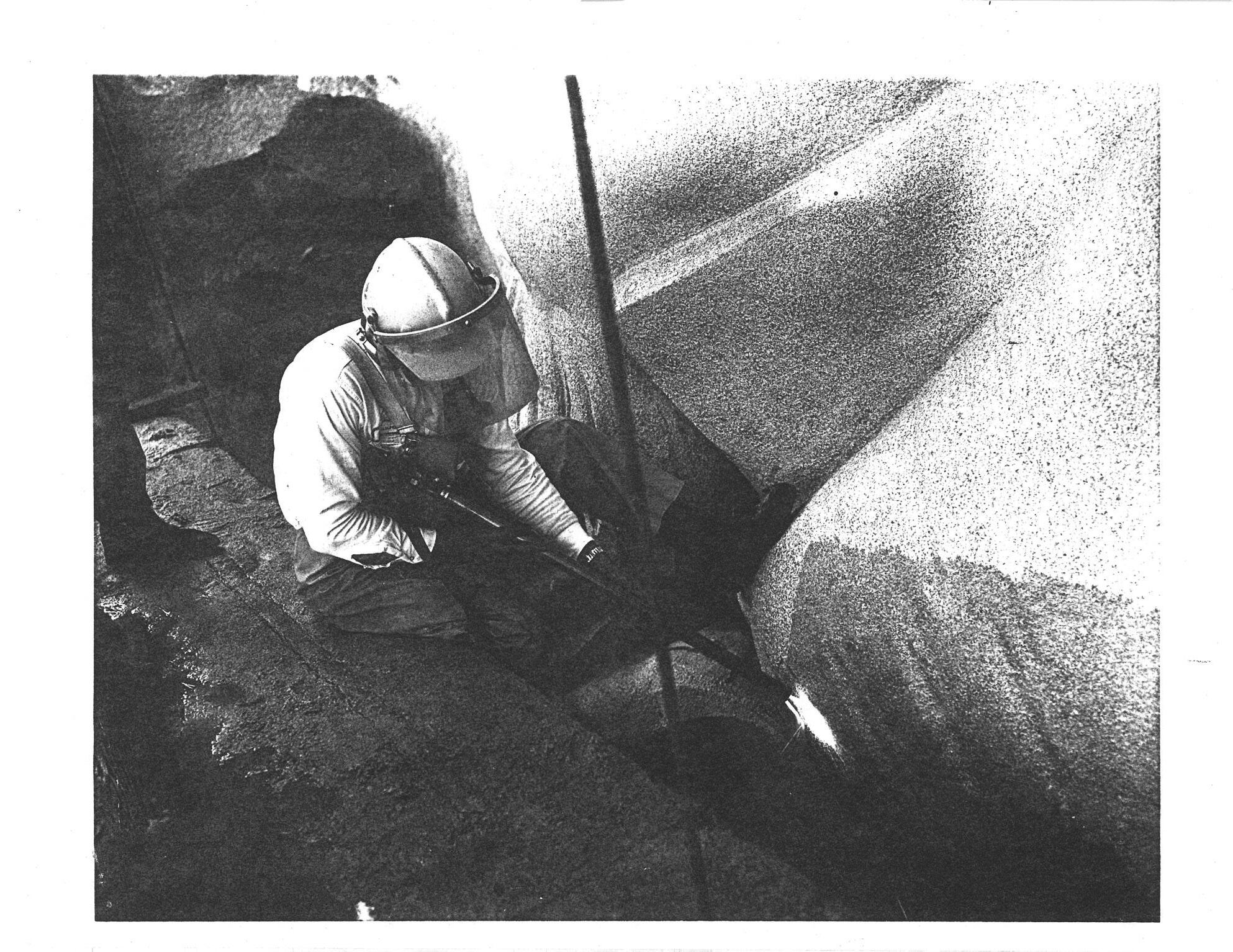
“Stone Mountain is ‘live rock;’ it contains water,” Wes explained.
“The thermo-torch at 7,000 de grees would heat the water so much that the granite would just flake off.”
Wes says that Hancock seldom appeared on the worksite and when he was present he stayed on the ground. According to Wes, Hancock was afraid of heights.
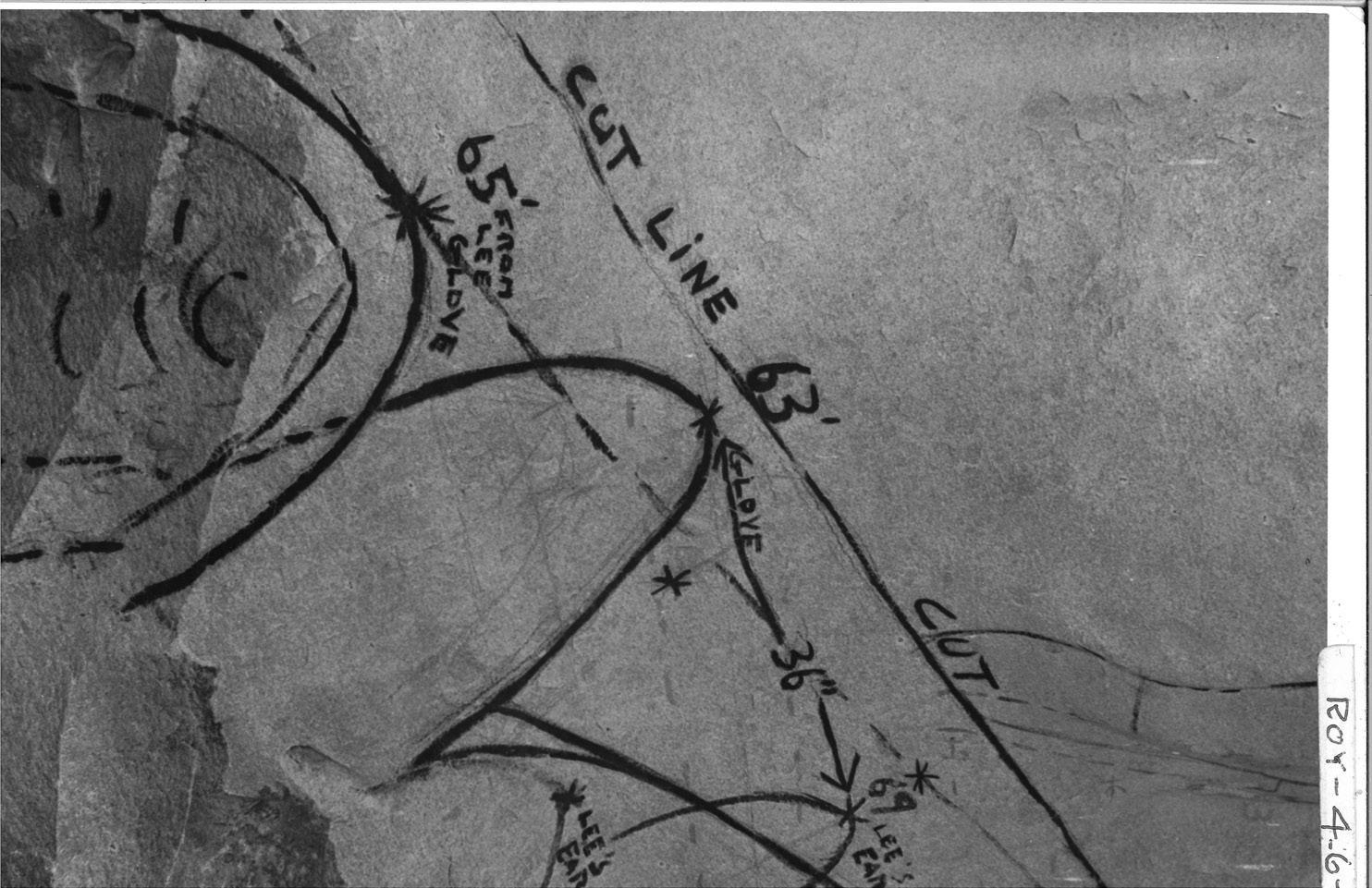
“He did not want to go up on the mountain. I think he tried it once and decided he couldn’t make it.”
While the crew labored above, a model on the ground, built on a one-inch to three-foot scale, served as a guide.
Some original work had to be repaired with stone patches
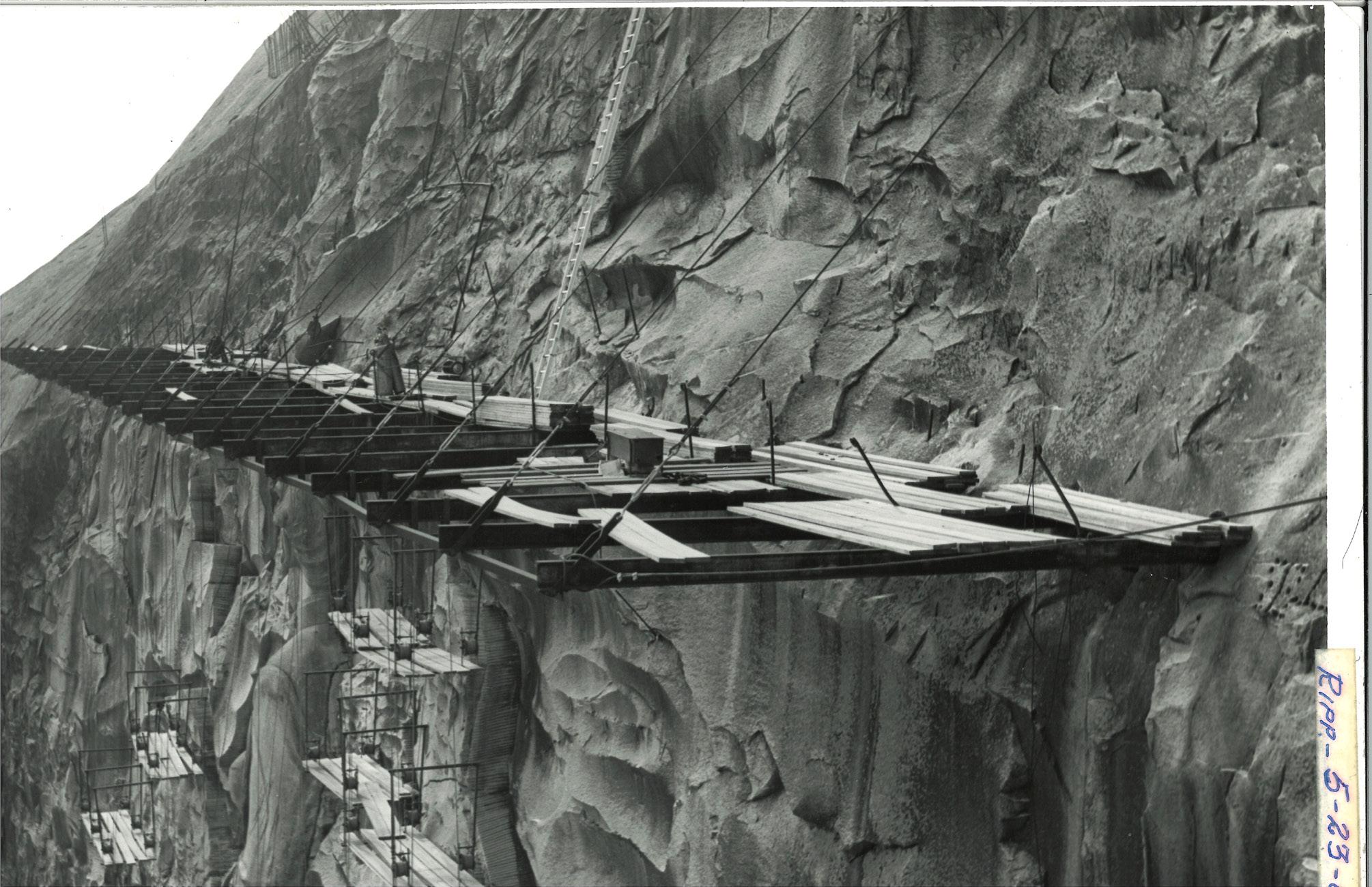
affixed to the carving. The largest patch was a large piece of granite; Wes estimates the size to be about 10 feet by 12 feet with a depth of six feet, that formed Lee’s elbow. Wes has no idea how much it weighed, but he said that when the rock was rigged to a pulley, lifting it required the tractive power of two concrete mixers pulling away from the mountain.
This was, obviously, very dangerous work. There were no nets or safety lines to catch the workers if they fell.
Falling was not the only hazard. Once the thermo-torch did not shut off properly and the flame began to back up the line toward the fuel supply. “Nelson, Roy, and myself all pulled out our knives and ran; we started cutting lines. Luckily we got it before it got to the main line. If it had it would have blowed everything off that mountain.” Everything but the carving, he clarified; just the scaffolding and three souls.
Wes speaks matter-of-factly about another brush with death. While he was helping surround the unfinished carving with a gigantic Christmas wreath made of 21 spruce trees, a shifting wind struck one of the branches which then hit Wes. “It jerked me around and I fell upside down.” He was saved by his strong jeans, a pin protruding from the scaffold, and his quick-thinking coworkers. “One of the pins caught my pants leg on the seam. It ripped about six inches and stopped to hold me upside down. They threw me a rope and I had to kick loose and swing around underneath the carving.” He hung on as they pulled him up with the winch.
Later, Wes’s friend Nelson was not as fortunate. When Nelson fell there was no pin to catch his pants and no rope to haul him up. Nelson fell to his death.
Wes’s friend was at least the second man to die on the project. Wes remembers one more, Boll Weevil Williams. There may have been others but Wes is not sure. In any event Nelson was the last casualty. “The day Nelson fell, Roy called it done,” Wes recalled. “Roy was not going to let this mountain kill anybody else.”
The head carver halted work and declared the carving complete. In a way it was already finished, but in another way it was not and never will be. Additional sculpting in lower relief was planned to form a backdrop for the three mounted figures, and the horses were to be finished down to their feet.
I asked Wes if state officials or others wanted to continue. “As far as what happened in the background, I don’t know.” Wes said. “But Roy said ‘that was that’ and that was that.”
The official dedication had already been held, in May 1970. According to Stone Mountain Park’s Official Commemorative Guide, “finishing touches were made in 1972—including the addition of a memorial with bronze statues at the carving’s base.”

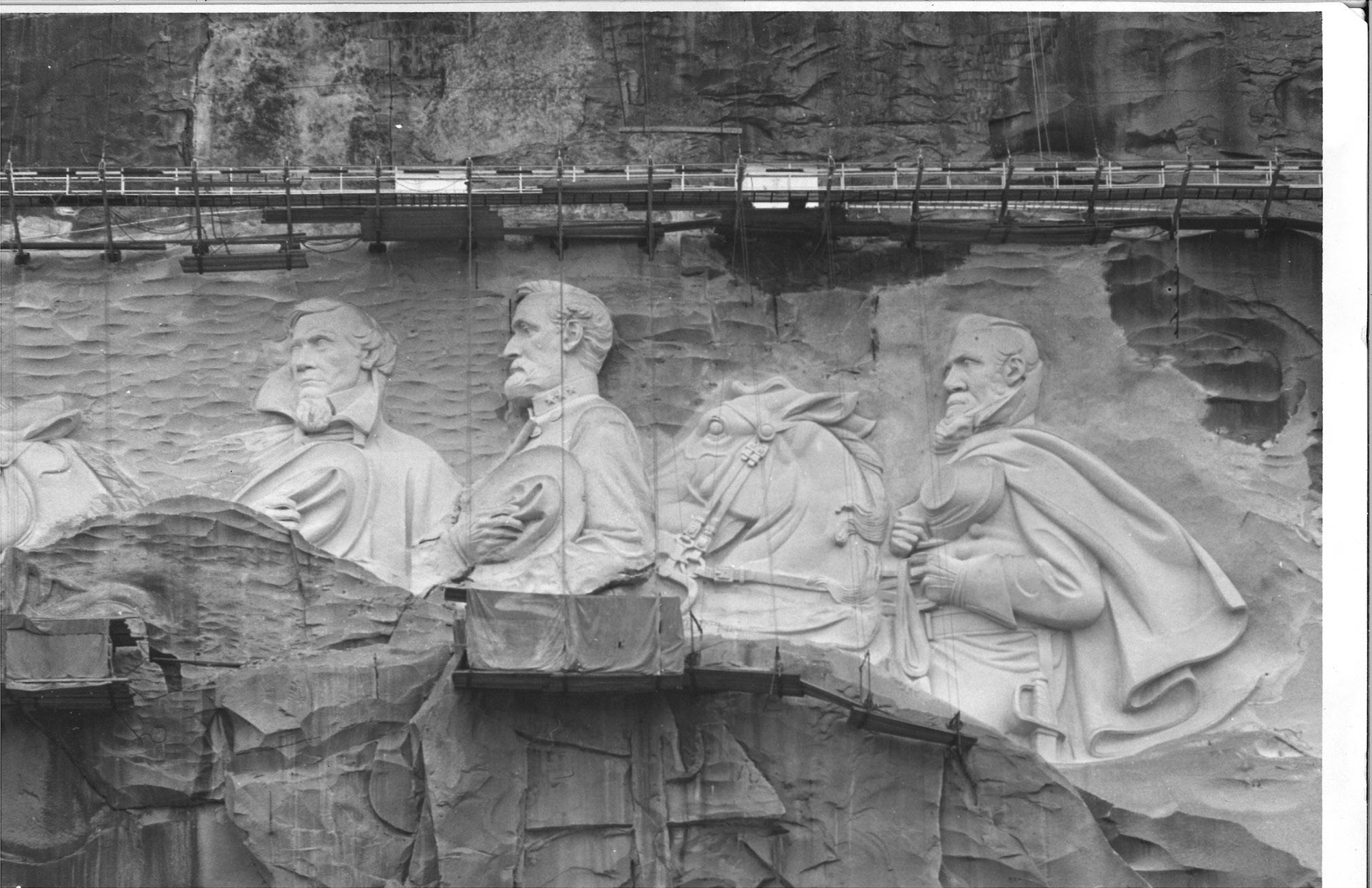

These finishing touches were at ground level. As for the aerial work, Roy Faulkner had said “that was that” and that was that.
Gould Hagler is a retired lobbyist living in Dunwoody, Ga. He is a past president of the Atlanta Civil War Round Table of Atlanta and the author of Georgia’s Confederate Monuments: In Honor of a Fallen Nation, published by Mercer University Press in 2014. Hagler speaks frequently on this topic and others related to different aspects of the Civil War and has been a regular contributor to CWN since 2016. He can be reached at gould.hagler@gmail.com.
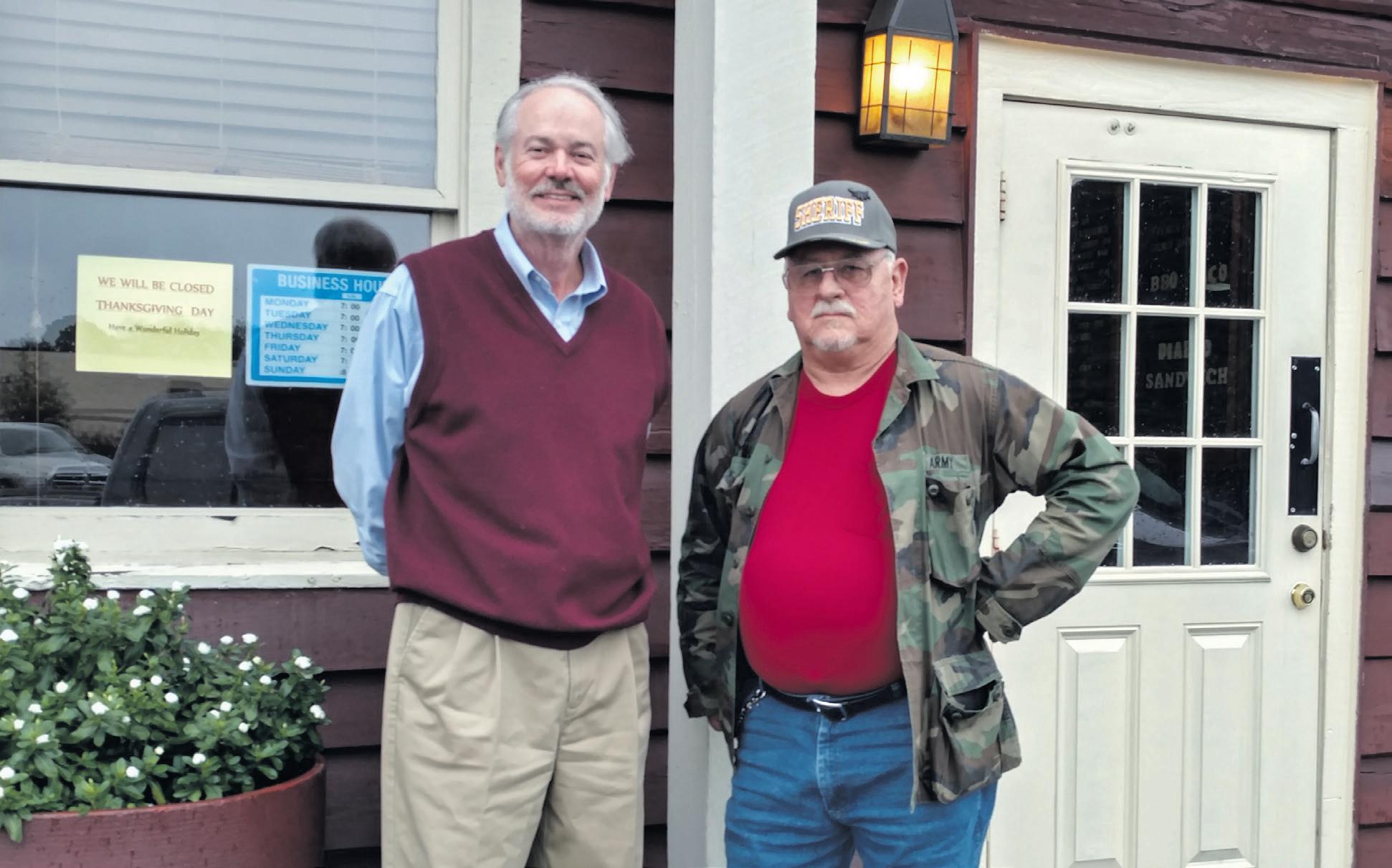
Elizabeth Van Lew’s neighbors thought she was crazy, and Van Lew did everything she could to cultivate their low opinion of her mental competence. Whenever she heard them whisper “Crazy Bet” behind her back, she suppressed any hint of an outward smile and grinned with an inner satisfaction.
duration of the war.
Crazy Bet, as she was widely known, was from a privileged Richmond family and lived in a three-story mansion on fashionable Church Hill, not far removed from The Capitol, St. John’s Church, and Libby Prison. Generally speaking, especially in the South, the wealthy were traditionally given the benefit of doubt when they espoused peculiar ideas or exhibited questionable behavior. Miss Van Lew’s neighbors made an exception in her case; they decided she was absolutely crazy. Van Lew used the prevailing misconception to her advantage.
Although Elizabeth Van Lew was a native of Richmond, she was educated in Philadelphia and became an impassioned abolitionist as a result of her exposure to that sentiment in the City of Brotherly Love. After her father’s death, she convinced her mother to free the nine slaves that her family owned. Her abolitionist stance and her sympathy for the Union cause made her a social outcast and prompted some Confederate officials to keep a watchful eye on Van Lew’s home and her activities.

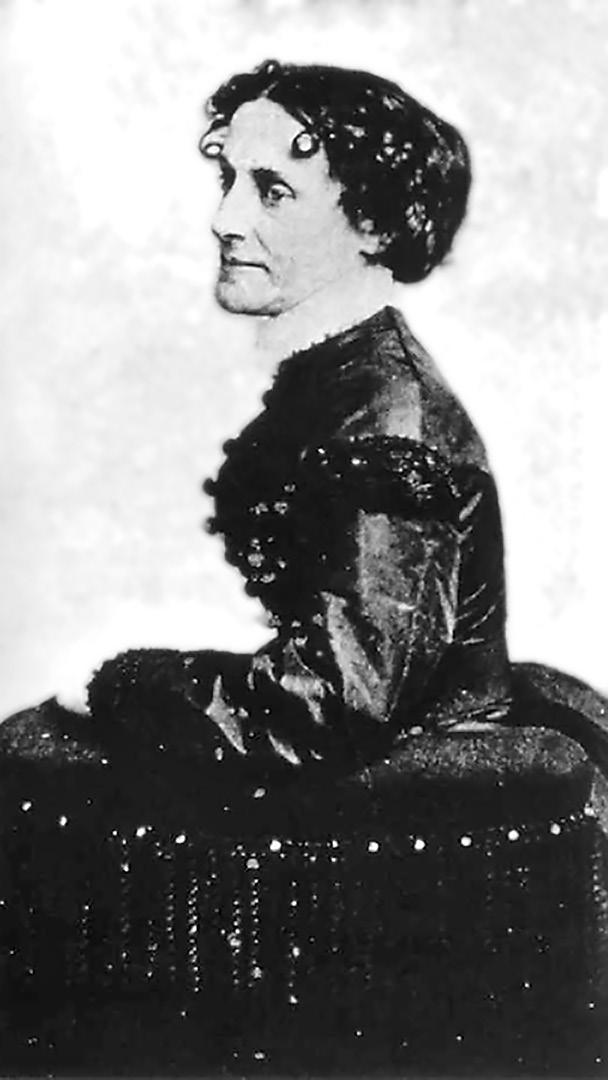
the household staff.
During the course of the war, the Union spy mistress exhausted her family fortune by personally funding her spy network and providing some welcome amenities to Federal soldiers held in Libby Prison. Van Lew was able to convince General John Henry Winder, the Confederate provost marshal of Richmond, to allow her frequent access to Federal prisoners ostensibly to supply them with food and medicines. “I can flatter almost anything out of old Winder,” wrote Van Lew, “his personal vanity is so great.”
At dawn on April 3, 1865, Union troops arrived in Richmond. As soon as they arrived, Federal troops began extinguishing fires in an effort to save the city from total destruction. A small contingent of Union troops commanded by Colonel Ely Parker was dispatched to Grace Street on Church Hill to protect the Van Lew family and their property. Much to their surprise, Colonel Parker and his men were greeted with a large Union flag flying above the Van Lew mansion. It was the first Union flag raised over the Confederate capital in four years.
knowledge, Van Lew requested that all documents written by her to the War Department be returned to her. All incriminating paperwork that could be located was returned to Van Lew, and she promptly burned it for obvious reasons.
Van Lew’s “occasional journal” kept sporadically throughout the war, an account that numbered greater than 700 pages, has survived in part. The spy mistress’ secret journal was buried on Van Lew property for safekeeping. Only about half the original version remains, but it has provided an authentic wartime chronicle of the Union’s most successful female spy.
Van Lew was a social pariah for the remainder of her life. She was never forgiven by those who supported the Confederacy for her aid to the Union cause. For her steadfast loyalty to the Union, she was branded a traitor by those Southerners who opposed Federal aggression.
great-grandson of Revolutionary War hero Paul Revere, who Van Lew had helped when he was a prisoner of war in the Henrico County Jail. The bronze plaque affixed to the stone reads:
She risked everything that is dear to man—friends, fortune, comfort, health, life itself, all for one absorbing desire of her heart – that slavery might be abolished and the Union preserved.
Van was an invaluable Union spy in the very heart of the Confederate capital during the Civil War. She supplied vital military information to a handful of Union generals; Benjamin Butler, George McClellan, George Sharp, George Meade, and Ulysses Grant were among them. She also supplied captured Union officers in Harwood Prison, Henrico County Jail, and Libby Prison with bribe money, food, medicine, and books. On occasion, Van Lew even harbored escaped Union prisoners in her own home.
Throughout the conflict, Van Lew continued to feign dementia by mumbling to herself and singing meaningless jingles as she walked Richmond’s streets dressed in shabby clothing. In order to foster the belief that she was a harmless, guileless incompetent, the former Richmond socialite began wearing the coarse clothing associated with county folk. She wore buckskin leggings with a one-piece skirt and cotton blouse, accented with a large calico sunbonnet. It was hardly the attire generally associated with the duplicitous sophisticates engaged in the clandestine craft of the secret service. Her masterful ruse worked brilliantly for the
During the Seven Days Battles in June 1862, Van Lew was so convinced, perhaps even hopeful, that Union forces would capture Richmond that she prepared a room in her home for the use of General George McClellan when he seized control of Richmond; his Peninsula Campaign was turned back by General Robert E. Lee and the Confederate defenders.
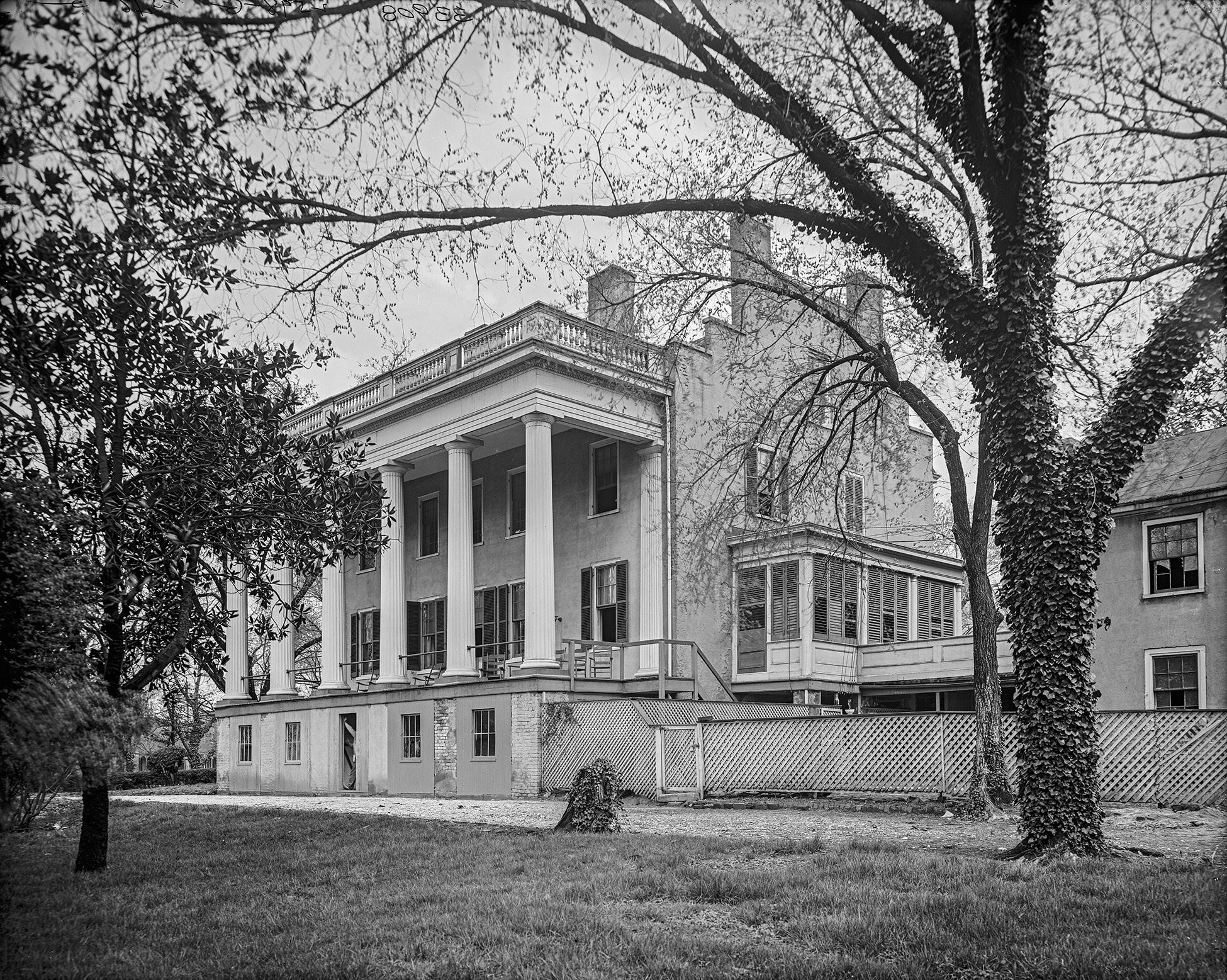
When the great majority of Richmond’s society women made bandages and cared for wounded Confederate soldiers who inundated the city, Van Lew and her mother did the same for Union soldiers.
The primary focus for Van Lew’s volunteer humanitarian efforts was the Union officers confined to Libby Prison, a converted warehouse on the James River. Under the noses of Confederate officials, Van Lew brought in books with divided spines that concealed notes and food on plates with false bottoms that hid important messages.
Crazy Bet, whose code name was “Babcock,” even managed to place an agent in the home of Confederate President Jefferson Davis. Mary Elizabeth Bowzer, a slave freed by Van Lew, was initially employed to serve at special affairs at the Davis residence in Richmond and eventually hired as a regular member of
Union occupation of Richmond brought an end to the war, but it did little to allay Lizzie Van Lew’s fear of reprisals from Richmond residents who had supported the Confederate cause. To reduce chances of her wartime spy activities becoming public
When Van Lew was interred in Richmond’s Shockoe Hill Cemetery, few attended the burial. She was buried vertically because there was little space available in the Van Lew family plot. For years her grave site went unmarked, which was fine as far as the vast majority of Richmonders were concerned.
Years later a granite boulder was placed over Van Lew’s grave by the relatives of Major Paul Joseph Revere, the
Bob Ruegsegger is an American by birth and a Virginian. His assignments frequently take him to historic sites throughout Virginia, the Mid-Atlantic, and the Southeast. His favorite haunts include sites within Virginia’s Historic Triangle—Jamestown, Yorktown, and Williamsburg. Bob served briefly in the U.S. Navy. He is a retired educator and has been an active newspaper journalist for the last twenty years.
A Look Inside Civil War Artillery Projectiles

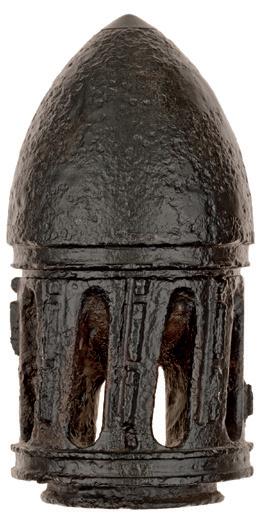

"Through Jack’s superb photography; the collector and professional can now view an extensive exposure to sectioned projectiles. This is new for the average person in that for the first time since radiography; one can examine the internal makeup of a shell."
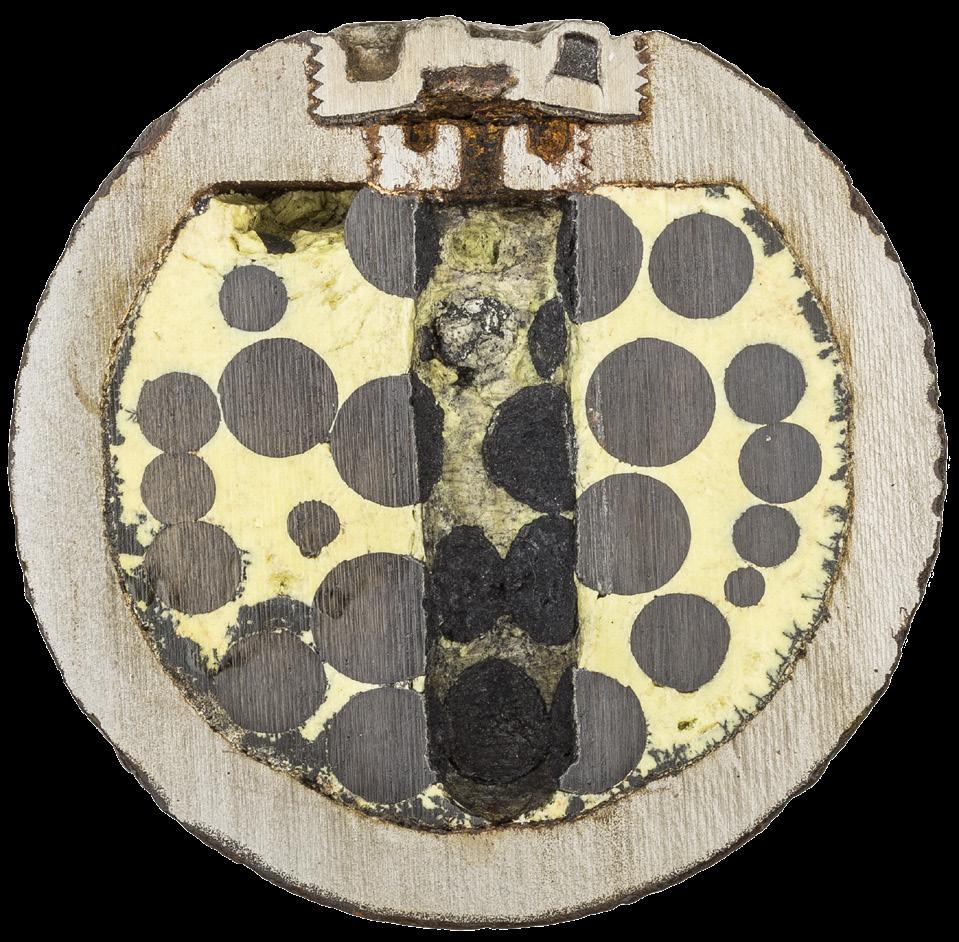

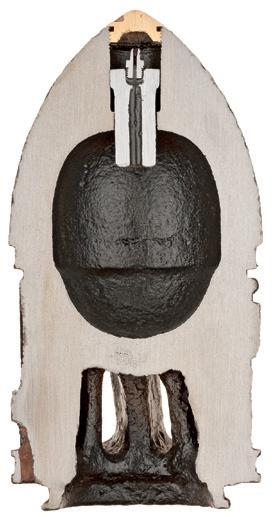
CWO4 John D. Bartleson
Jack Melton’s latest endeavor, Civil War Artillery Projectiles – The Half Shell Book, is a remarkable addition to Civil War artillery ammunition literature. For archaeologists and collectors the clearly written text and the excellent photographs provide a wealth of information to properly identify recovered shells and burst fragments. For bomb squad and EOD specialists this book should be on every units’ shelf. The material found in these pages will help EOD personnel identify what has been found, whether or not it is dangerous, and how to inert the round without the necessity of destroying an important historic object. This book takes Civil War artillery ammunition studies to a new level.
Douglas Scott Adjunct Research Faculty, Colorado Mesa University. Author of Uncovering History: Archaeological Investigations of the Little Bighorn.
Wow. I have been reading a lot of different books on ordnance from this era, but this one takes the cake. Most of the other books drift off in directions that are not helpful with the ordnance specific information I am usually looking for. But this book stays on task and topic from start to finish.
flame’scommunicationchannel.Theblackpowderburstingchargewaspouredinloosearoundthebullets.Thismethoddid notworkverywellandoftenonlysucceededinblowingthefusesout.Projectilesfilledwithbulletsusedascaseshotarerare. Thisspecimenwasrecovered,alongwithotherConfederateandUnionprojectiles,fromthepost-CivilWardumpsitelocated neartheConfederatePowderWorksinAugusta,Georgia.
Inthisexample,riflebulletswereutilizedasthecaseshotmaterialincluding3-ring.58caliberbullets,3-ring.69caliberbul lets,andU.S.ring-tailSharpsbullets.IthasabrassBormannsupportplug(underplug)thatiscountersunkonbothsidesof
MFS, Graduate Faculty, Arson-Explosives Investigation (AEI), School of Forensic Sciences, Oklahoma State University
Jack Melton’s new book Civil War Artillery Projectiles – The Half Shell Book, promises to be one of the most important volumes on Civil War artillery in recent times. Anyone who has studied the wide variety of Civil War projectiles knows that what is inside is just as important, and maybe more so, than what is outside the shell. In this book, cutaway shells are graphically explained with superb color photographs and detailed notes. They reveal important details and differences in a variety of similar projectiles that tell us U.S. from C.S. and between type variations, in a way that no other approach has ever done. It is supremely helpful in explaining to others just how a shell works, whether it is still dangerous or not, and why.
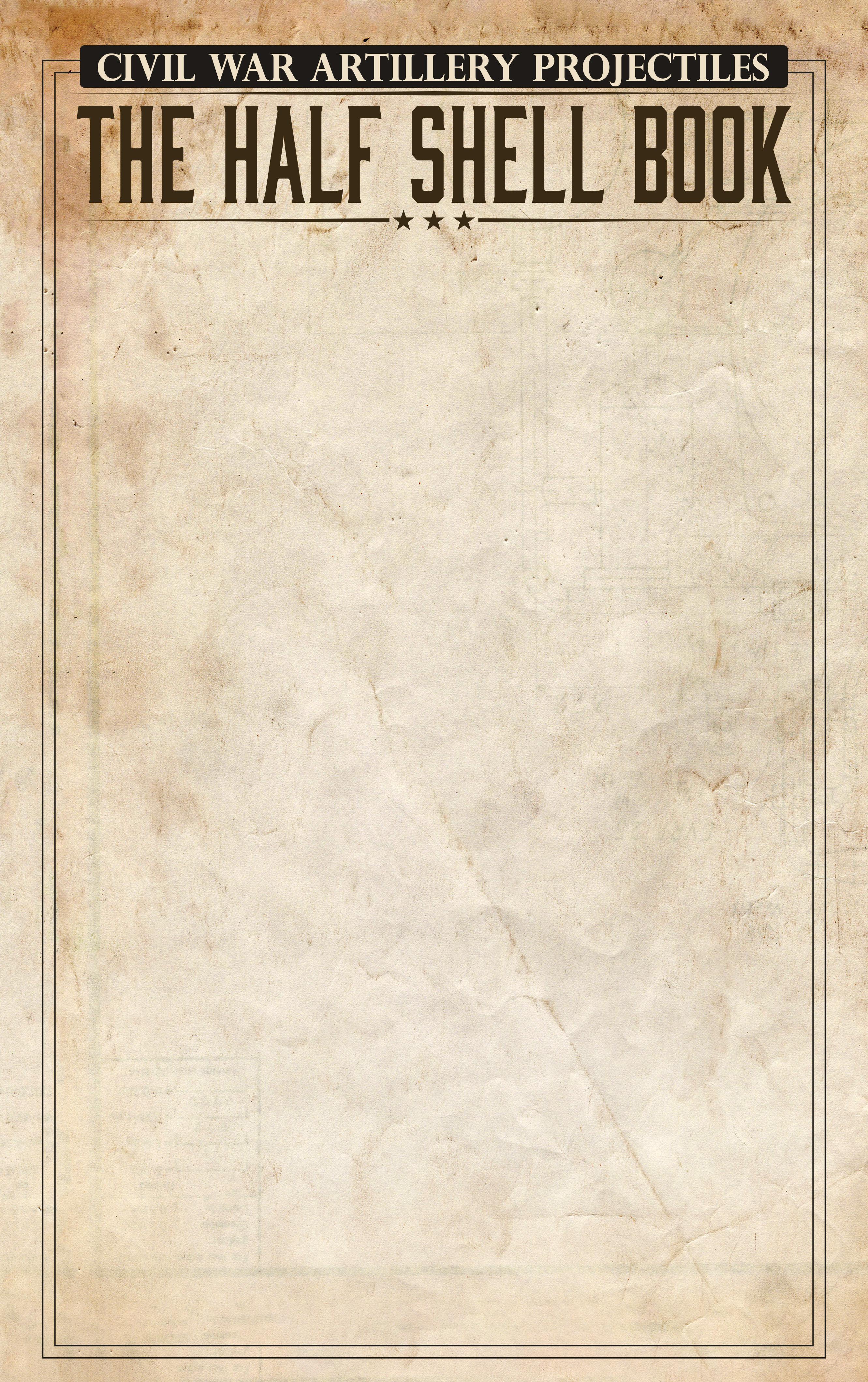 Les Jensen
Les Jensen
Former Curator of the Museum of the Confederacy
I have been currently involved in writing captions for an absolutely fabulous group of Civil War photographs owned by the Library of Congress given by Tom Liljenquist and sons. This remarkable group of photographs can be seen on the Library of Congress website.
Most of the photographs are unidentified but exhibit wonderful aesthetics, with the finest detail and hand-tinting by the artists who made them. Many images have good provenance and history, some just have oral history, some have old tags, and some have new tags. My assignment was to delve into the purported provenance and determine if the information was reliable and qualified. I also identified the arms, uniforms, and equipment displayed.
Sometimes images, even direct from a family’s descent, had the identification incorrect or they had no idea who the family member may have been. Sometimes through genealogy, confirmed
identification could be made but most often not. Many of these photographs have been known for years and published in early texts with incorrect identification or attribution that is difficult to prove. Comparable images for size, subject matter, and condition usually bring a premium price if identified. Often, images are sold with an identification that cannot be qualified. Often written identifications in the back of photographic cases are not original. A mundane sixth plate ambrotype of an enlisted Union infantryman in fine condition might sell for $125, but if that soldier was a battlefield hero or received the Congressional Medal of Honor, that same image might bring $2,000. The same can be said with other commonly “enhanced” Civil War items. We discussed in an earlier article where a fine condition foot officer’s sword ascribed to a notable soldier might bring $20,000-30,000 or more, when the same sword with no inscription would sell between $800-1200.
Needless to say, due diligence is required when buying expensive Civil War objects, as many more clever fakes and inscribed items that are “suspect” are becoming fairly common in the marketplace.
Illustrated in this article are several images showing the difficulties in identification and a few surprises.
John is an certified appraiser with International Society of Appraisers specializing in Civil War memorabilia. He authenticates and evaluates other rare and valuable historic items as well. His website is www.civilwardealer.com.
He is coauthor of the book Confederate Bowie Knives (2012) by Jack Melton, Josh Phillips and John Sexton, that was published by Mowbray Publishing, Inc. Send “Ask The Appraiser” questions and photographs to civilwarappraiser@gmail.com.
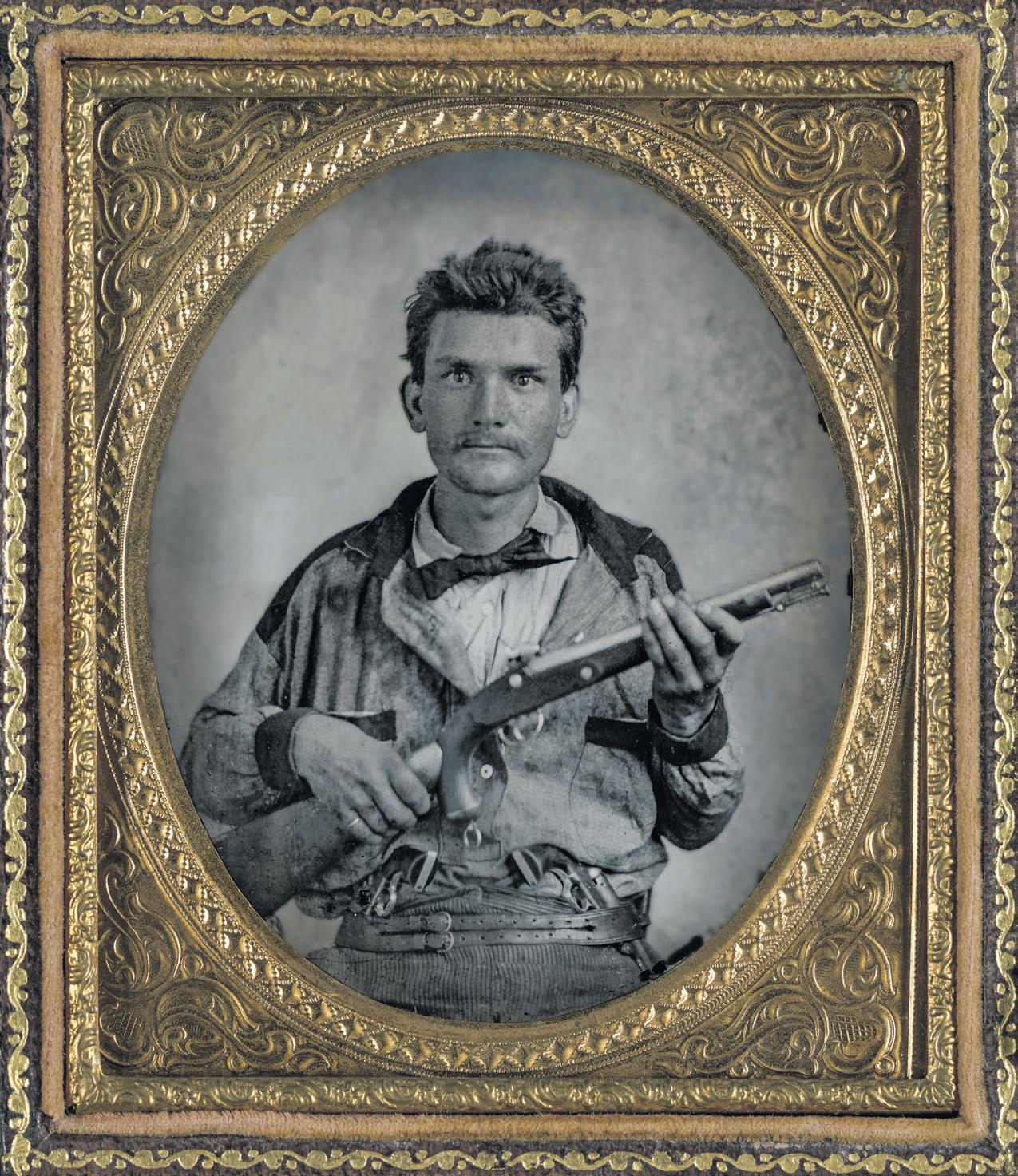

Not only has this sixth-plate ambrotype been published in numerous publications, it was also featured in episode 4 of Ken Burns’ 1990 Civil War documentary. The soldier was unknown in all publications and in the documentary until Patricia Mullinax, wife of well-known Confederate authority Steve Mullinax (1946-2012), recognized the image from other family photographs, as she was a Pollard. Stephen Pollard (1830–1899) posed wearing battle shirt, roller buckle belt with two Colt Model 1849 pocket revolvers, and holding a M1855 pistol carbine with attached stock. Stephen Pollard was member of the 7th Confederate States Cavalry Battalion, formed mid-1863, and served to the end of war in Eastern Tennessee and Western Virginia. This is a rare instance, where a Civil War image was identified from other existing images. Ironically, Steve Mullinax (1947–2016) is buried in same cemetery as Pollard, Liberty Church Cemetery, Temple, Ga. Patricia is also an historian and authority on West Georgia history.
Originally identified in earlier texts as Captain James Dugan Gist (1833–1863), this is more likely his older brother Joseph Gist (1818–1890). Joseph would be 43 years old in 1861 when he entered service as a major, something conveyed by the insignia on his shoulder straps and the approximate date of image. The uniform is also early war as it is still in US style. His brother James was on his staff but never attained this rank, as he died of typhoid fever in 1863. Joseph was later Lt. Colonel of 15th South Carolina Infantry until wounded at Chickamauga. He then retired to his home in Charleston. His kepi has the insignia “SCV” for South Carolina Volunteers. Captain Gist never held this rank, so we now know the family misidentified the brothers, where resemblance of all three is noticeable.
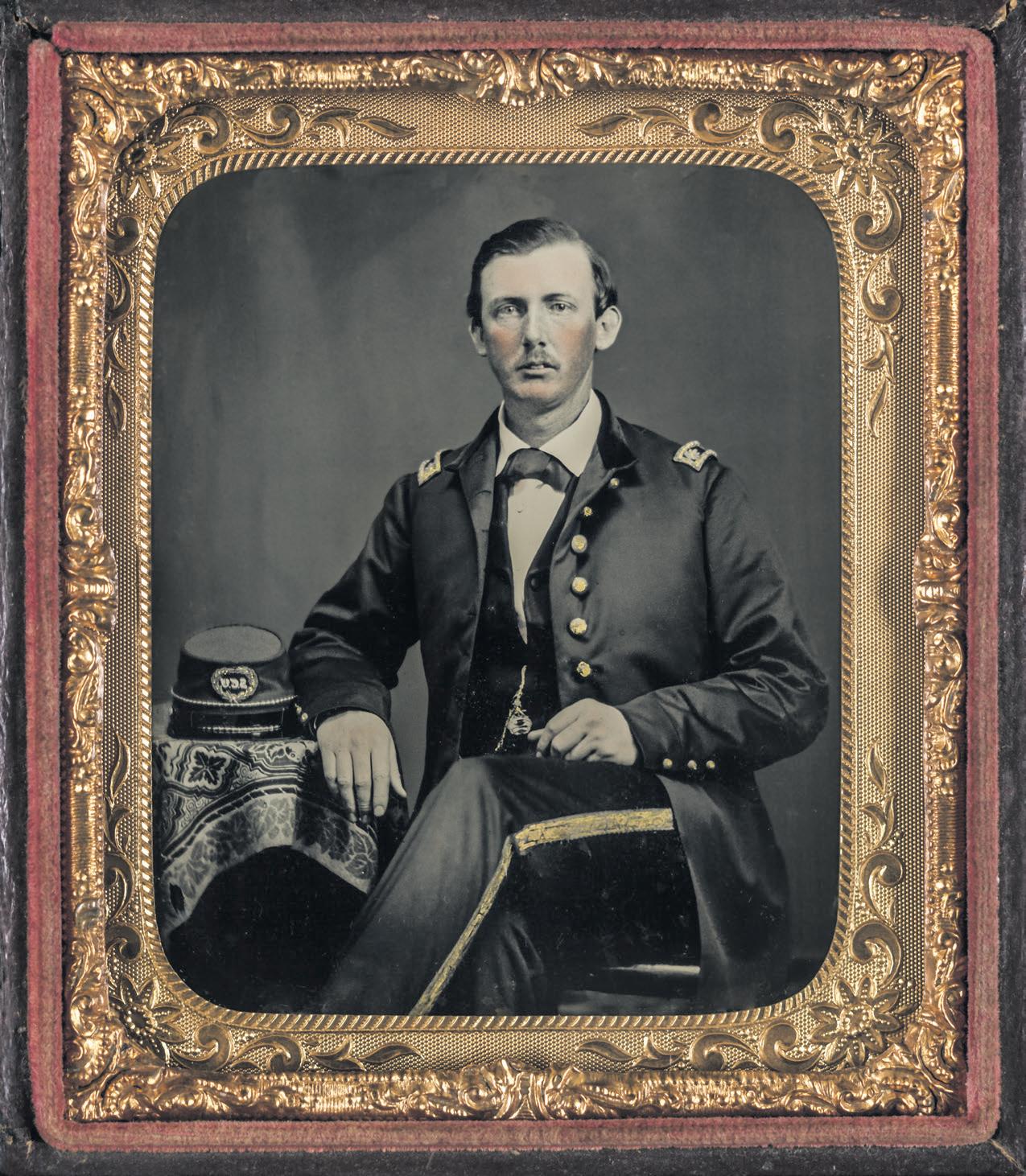
Edward A. Cary, Company I, 44th Virginia Infantry, with his sister Emma wearing fashion of the day, posed for this ambrotype by Charles Rees in Richmond during 1861. Edward was 18 years old when he entered service May 8, 1861; he was killed at the battle of Port Republic June 9, 1862. His beloved little sister was 16 when this photograph was taken. Edward served with his older brother William who was a sergeant in same unit and survived the war. Emma Judson Cary Garland (1845–1918) inked an inscription identifying her and her brother in back of the case late in her life thus preserving identification of a treasured memento that otherwise would be lost to history. This image was retained in the Garland family and luckily Emma inscribed a note placed in the case identifying her long deceased brother. Rarely do such mementos ever have a written description as they were personal to the owners only, and rarely did anyone think of identifying them for future generations.
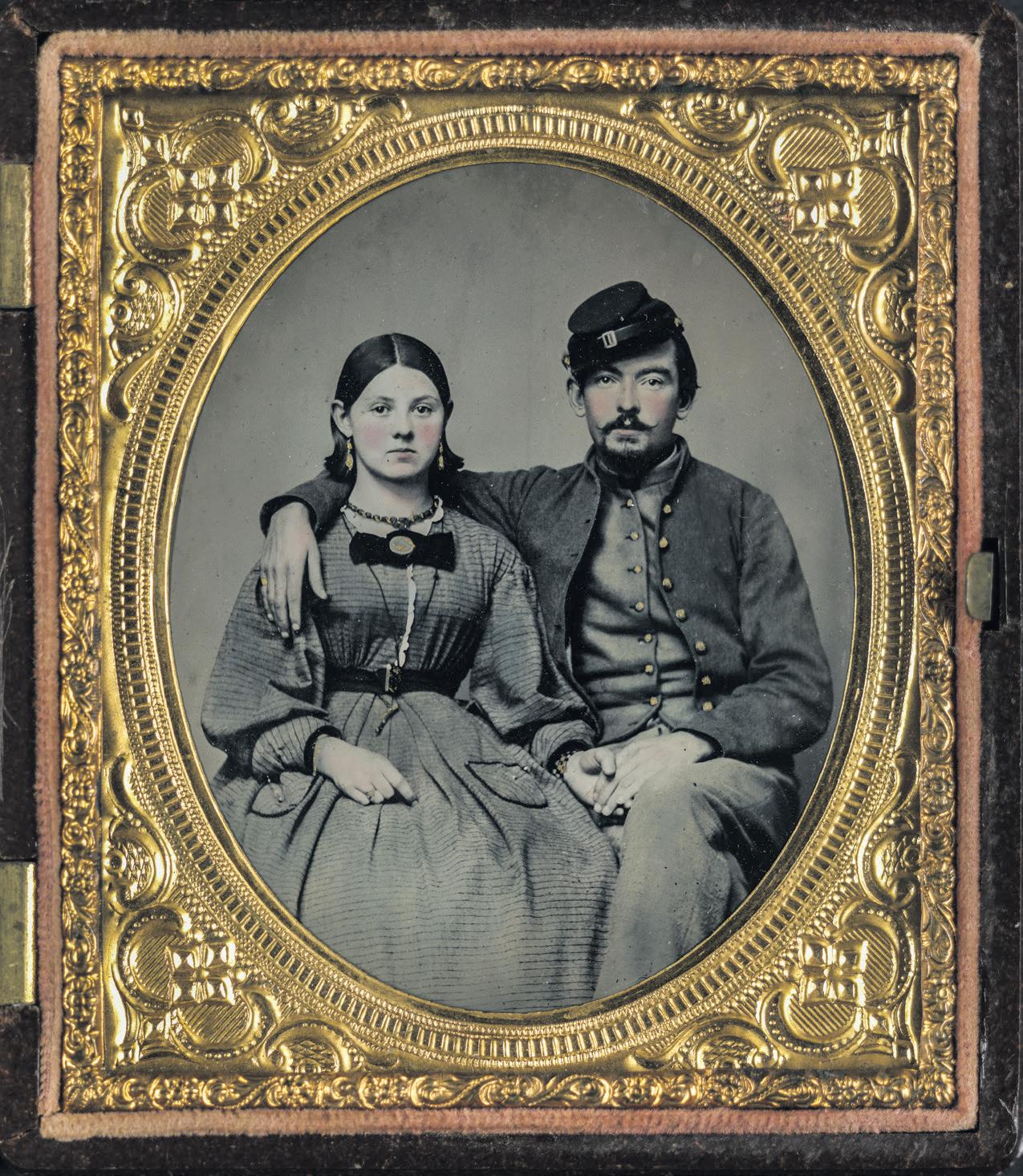
Henry F. Waters, a 28 year old Harvard graduate from Salem, Mass., enlisted as corporal in Company F, 23rd Massachusetts Infantry October 17, 1861. Henry saw action at the battles of New Bern and Roanoke, then served as a medical clerk with his unit in North Carolina at several hospitals. A yellow fever epidemic occurred about the time of his enlistment’s expiration. One biographer of the 23rd reported that, I do not know that he is alone but there are certainly not many whose need is greater than that of Cpl. Henry F Waters of Co. F. He had been, more than 2 years, clerk in the general hospitals. The time for which he enlisted had expired and he might have honorably sought safety in his Northern home. He remained at his post till all around him had been stricken down...
Henry knew he was needed as a hospital steward and clerk and, after leaving the Army, reentered service as a civilian clerk and remained at the Foster General Hospital until contracting yellow fever himself, barely escaping death, but returning home to Salem in the autumn of 1865. The 23rd lost 132 men to disease and another 80 killed in action and mortally wounded. After the war Henry became a nationally

known genealogist, publishing genealogies of many famous Americans. His papers are found today in the Phillips Library at the Peabody Essex Museum in Salem, Mass., where he was born and this photograph was made. This fine ambrotype is identified from the 1896 published Story of Co. F, 23d Massachusetts Volunteers with a different image of Waters wearing this same distinctive uniform.

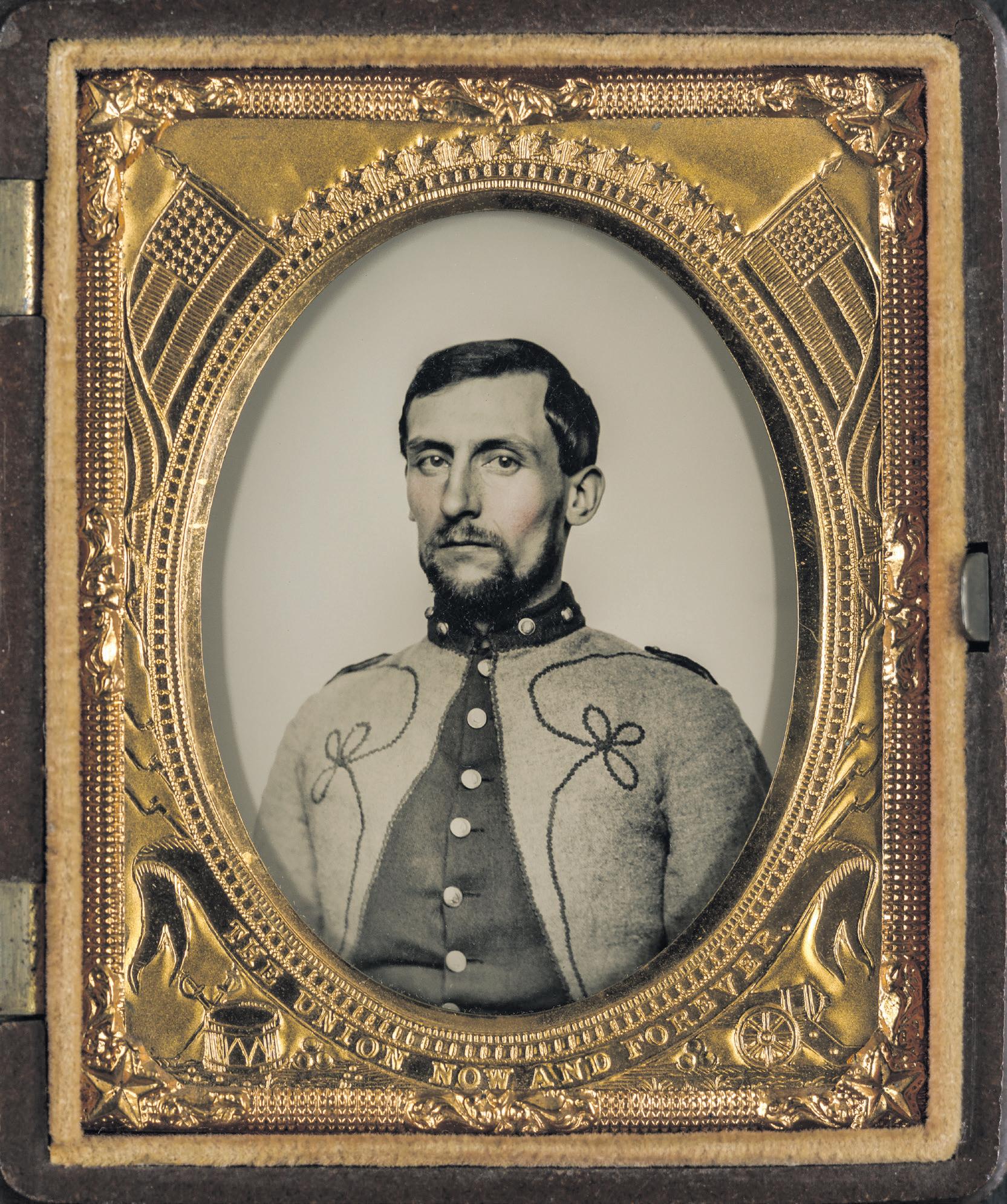
It would interesting to note if the mat on this image was removed, as the corporal chevrons might then be visible as in the standing view CDV from 1896 text, further supporting the conclusion as to his identity.
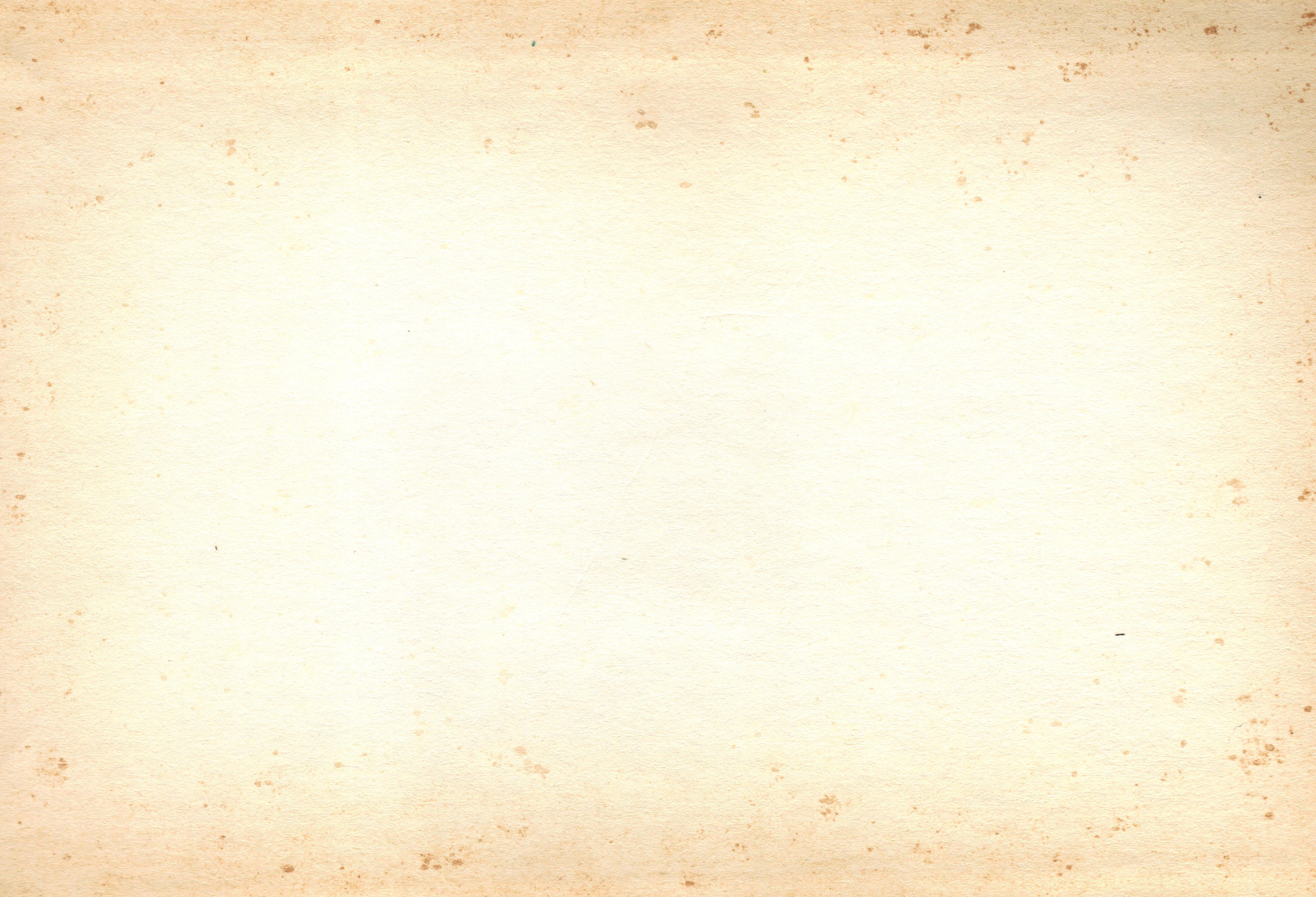
One of the things I love most about public libraries is that they’re usually a far cry from the stereotypical temples of silence that we all think of.
Yes, you can find people tucked away in quiet corners, reading, studying and researching. Sometimes, dim lighting adds to the sense of quietude and seclusion, but just as often, rooms are awash in bright florescent white. This is only fitting. Libraries themselves are beacons. They serve as repositories of all our accumulated knowledge. In an age
where we’re so easily distracted by soundbites and clickbait, and where we confuse opinions with wisdom, libraries represent steadiness and deliberateness.
But libraries are so much more than that, too. I recently spoke at a branch of the Central Rappahannock Regional Library, and on my way in, I was delighted to see the window in the entryway plastered with notices about upcoming events: book groups, a quilting guild, “books with wine,” a stamping club, a writers group, “paws for reading,” mahjong players, and even a senior exercise class. It represented a vibrant array of activities for all segments of the community. Good libraries always sit at the heart of their communities that way.

As a community, Civil War buffs love their books and pride themselves on their own libraries. But how might you or your Civil War Round Table, book club, or historical society work with your local library to help promote Civil War education? How might you help the library develop and promote its Civil War holdings? Just as the library sits at the heart of a community, how might you
help ensure that Civil War history has a seat there, too?
— Chris Mackowski Editor-in-ChiefEdward Alexander is teaming with author Doug Ashton on a William Barksdale biography, hopefully a late-summer release with Savas Beatie.
Chris Kolakowski recently had an article appear in the inaugural issue (Fall 2018) of the Air Force Journal of Indo-Pacific Affairs. The article is titled “A Short History of US Involvement in the Indo-Pacific.” It can be accessed here: https://www.airuniversity.af.edu/JIPA/ Display/Article/1676611/ volume-01-issue-1-fall-2018/
Chris Mackowski has an article, “Saving Spotsylvania,” in the inaugural issue of Central Virginia Battlefield Trust’s magazine, On the Front Line. You can read the magazine here: https:// indd.adobe.com/view/604a944dba03-4b04-8d5a-f9483b6ca4d2.
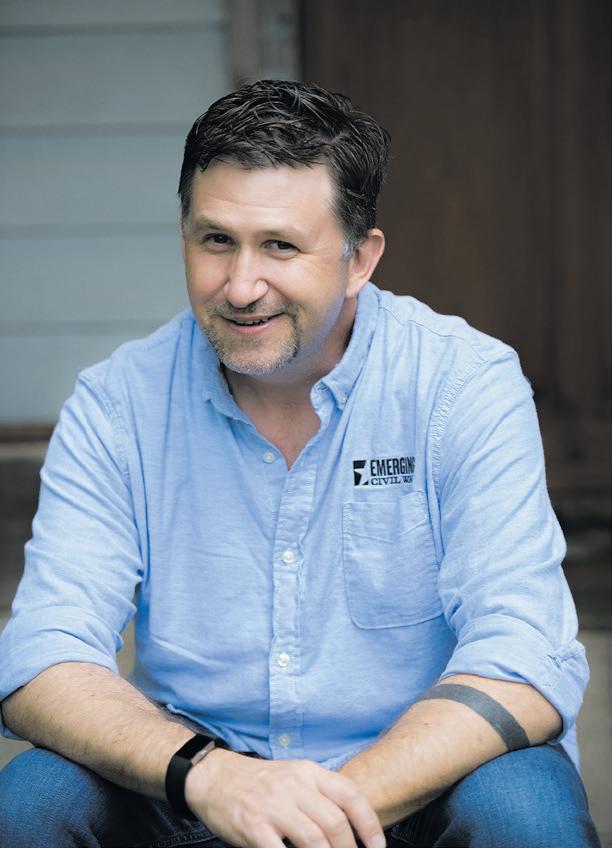
Dave Powell’s annual March Seminar in the Woods at the Chickamauga Battlefield is coming up March 8 and 9. This year Dave and NPS Historian Jim Ogden will focus on “the crucial operations in McLemore Cove, leading up to the battle of Chickamauga.” Room is still available on the tour. More details, including ticket info, are available at Chickamauga Blog: https://chickamaugablog.wordpress.com/2018/10/03/2019seminar-in-the-woods/.
William Lee White’s long-awaited ECWS book on the battle of Franklin is now hitting bookshelves. Let Us Die Like Men: The Battle of Franklin takes its title from a comment made
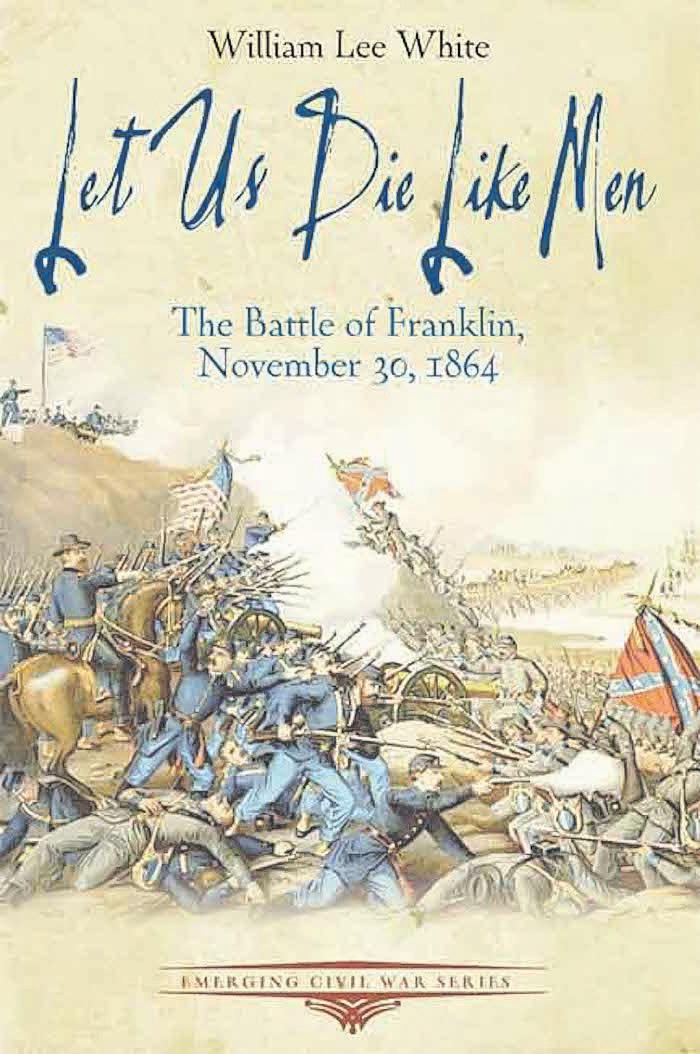
prior to the battle by Confederate Major General Patrick Cleburne. White, author of the ECWS book Bushwhacking on a Grand Scale: The Battle of Chickamauga, says his book on Franklin is the result of a lifelong fascination with the battle, which he has studied astutely for decades.
Aside from new maps by Hal Jespersen, the book features appendices on the captured flags of Franklin, artillery, preservation, and Franklin in memory.
Let Us Die Like Men is published by Savas Beatie and marks the 28th book in the Emerging Civil War Series.
10 Questions . . . with ECW’s James Brookes
James Brookes is Emerging Civil War’s one-man bureau in England. James, who is finishing his degree in American Studies at Great Britain’s University of Nottingham, has a particular fascination with Civil War portrait photography. You can read his full bio here: https://emergingcivilwar.com/ author-biographies/authors/ james-brookes/.

The war is often internalized to the U.S., which is logical, but we must remember that the conflict occurred in an era of global change: abolition had already been embraced by most nations, but conservatism faced off against egalitarian movements, monarchism rivaled democratic projects, and republican ideals espoused by the U.S. weren’t as exceptionally American as one might think. I recall once hearing the Civil War described as “a universal conflict, fought on an American stage,” and I think that’s a thought-provoking way to consider it.
How did you get interested in the war in the first place?
Despite what I’ve just said, my entry into the Civil War wasn’t tied to any of these UK-based Civil War touchstones. I was landed with giving a presentation on the war’s impact on the U.S. government in a politics class in high school, and that was my first “serious” engagement with the war. I had applied for American studies programs at university, but I’d been more interested in the colonial period and the early republic. But that small glimpse into the war set something off. I picked up McPherson’s The Battle Cry of Freedom shortly after that presentation, found myself absorbed by his references to the experiences of common soldiers, and within a year or so, if I wasn’t reenacting the War; I was surrounded by a small library devoted to it.
As ECW’s “Foreign Bureau,” what does the American Civil War look like from your side of the Pond?

Distant, but its reverberations are still felt across the Atlantic. Statues of Abraham Lincoln stand in Westminster, Manchester, and Edinburgh. In the North West, where I grew up, it’s more noticeable. The “Cotton Famine Road,” the result of a project intended to alleviate the effects of the cotton shortages, cuts through the countryside. In Liverpool, the former U.S. consulate stands a few minutes’ walk from the unofficial embassy of the Confederacy. A Union veteran lies in my hometown cemetery.
Your area of expertise focuses on Civil War-era portrait photography. What do you find so fascinating about those photos? Portrait photographs were potent vessels of personal identity during the Civil War. Much like letters, they were imbued with the hopes and anxieties of ordinary Americans, but they never seem to receive the same attention from scholars. I’ve taken wet-plate photographs and have been the subject of them. From engaging in that process you gain a real appreciation of the planning and labour that went into producing a portrait photograph in the 1860s. It was a ritual. They were a means for Americans to affirm and immortalize their selves when their identities were so in flux, and were so threatened by the specters of death and disability. Not only that, but they had very practical functions. For soldiers, they were used as tokens of home, as mediators of distance, and as surrogates for loved ones they wanted near.
relate to field photography?
I think the differences between the two mediums are most fascinating, though they can bleed into one another in some respects. On the one hand, field photography can have a significant anonymizing element to it, unless we’re talking about pictures of historic notables. But throngs of African American refugees, hosts of Union soldiers, crowds of civilians, or heaps of Confederate dead are susceptible to be viewed as masses, rather than as individuals. This is because of the documentary nature of field photography: we know we are viewing a major event when we see so many participants and onlookers. Conversely, in studio photography, you’re usually only confronted with one figure. They are the subject and the focus of the picture, and you have to reckon with their individualism. These soldiers made a conscious decision to have their portraits made: it was proof of their commitment to the cause they fought for, and they fixed themselves into the war’s visual archive. It’s incredible that we have such a diverse grassroots archive to parallel the mainstream record.
What are you working on at the moment?
I’m working towards completing my PhD. I’ve spent three years working on it at my home institution, the University of Nottingham, and now I’m currently based at the Smithsonian American Art Museum as a research fellow. My project essentially seeks to provide a comprehensive examination of soldiers’ creation and employment of war imagery: graphic arts, paintings, prints, portrait photographs, etc. I look at the ways in which soldiers made use of popular visual imagery, but also their own depictions of the war. From there, I’m examining the extent to which they associated with the heroic traditions of representing warfare. Most do, but some distance themselves in very interesting ways. I mostly focus on Union soldiers, owing to the greater number of archival materials related to them. It’s proved to be a little too ambitious, considering how much great material I’ve pulled up, but I’m really enjoying it.
Lightning Round (short answers):
Most overrated person of the Civil War?
Joshua Lawrence Chamberlain. I admire him greatly, don’t get me wrong: his service record is incredible and he was a true wordsmith. But his post-war writings and political career shone a bright
light on his contributions, which were then illuminated further by The Killer Angels and the movie Gettysburg. He’s come to eclipse so many other personalities in the popular understanding of the war.
Favorite Trans-Mississippi site?
I’ve not travelled west of the Mississippi, yet. I’ve always wanted to visit the Arabia Steamboat Museum in Kansas City, though it’s not strictly a Civil War site (the Arabia sank in 1856). It’s a mammoth time capsule of American material culture from the mid-nineteenth century.
Favorite Regiment?
The 57th Massachusetts Veteran Volunteers. Formed in 1864, they left camp with over 900 men to fight the Overland Campaign. By August, 47 remained. Their endurance was mind-blowing, and Warren Wilkinson tells their story poignantly in Mother, May You Never See the Sights That I Have Seen.
What one Civil War book do you consider to be essential?
Drew G. Faust’s This Republic of Suffering. It’s difficult to pick up any Civil War book without being reminded of the war’s enormous toll, but Faust’s book forces you to confront it on a very intimate level. Death’s heightened presence, proximity, and immediacy made it almost inescapable. We should always bear that in mind whenever we engage with the war.
What’s one Civil-War related question no one has ever asked you that you wished they would?
It’s difficult to pick out one question. My current work forms my greatest interest in the war so I’m fortunate to get asked plenty of questions about what I’m most passionate about. In general, I’d like to see people asking more about the war’s social and cultural history: it allows individuals to approach the war on a grassroots and personal level, which I think is key in generating interesting in accessible ways.
Dan Welch joins Chris Mackowski as a regular co-host of the Emerging Civil War podcast. Chris spends time chatting with Dan about his Civil War origins, his publications, and his dual life as historian, musician, and educator. Dan is co-author of the Emerging Civil War Series book The Last Road North: A Guide to the Gettysburg Campaign
In January, ECW ran a series on the blog called “Primary Sources:
The Words They Wrote.” In our second podcast of the month, Chris Mackowski and Kris White talked about the use of primary sources in research and writing – a “must-hear” for anyone interested in learning more about how historians work behind the scenes. Plus, Chris and Kris talk about some of their personal favorite primary sources.
Emerging Revolutionary War historians were out and about as December turned to January. Historian Mark Maloy, author of Victory or Death, was at the annual reenactment of the battle of Trenton. He made a stop at the Old Barracks Museum and is pictured with the last copy of his book in the bookstore.
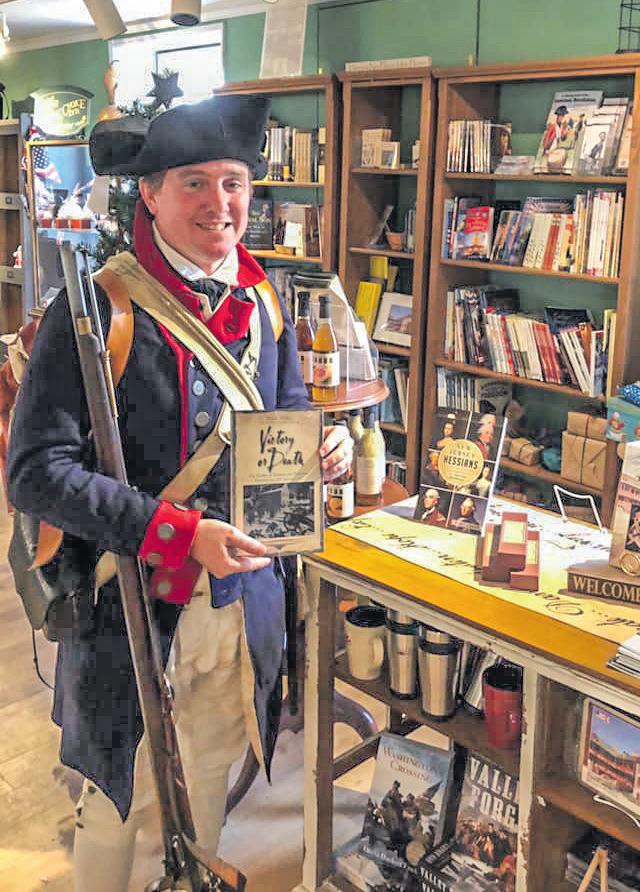
ERW Historian Bert Dunkerly was one of the event organizers for the commemoration of the January 5, 1781, raid on Richmond, Va., by Benedict Arnold. Although the National Park Service portion of the event
Civil War News publisher, Jack W. Melton Jr., is proud to announce his new 392 page, full-color book, Civil War Artillery Projectiles – The Half Shell Book. For more information and how to order visit the website www.ArtillerymanMagazine.com or call 800-777-1862.
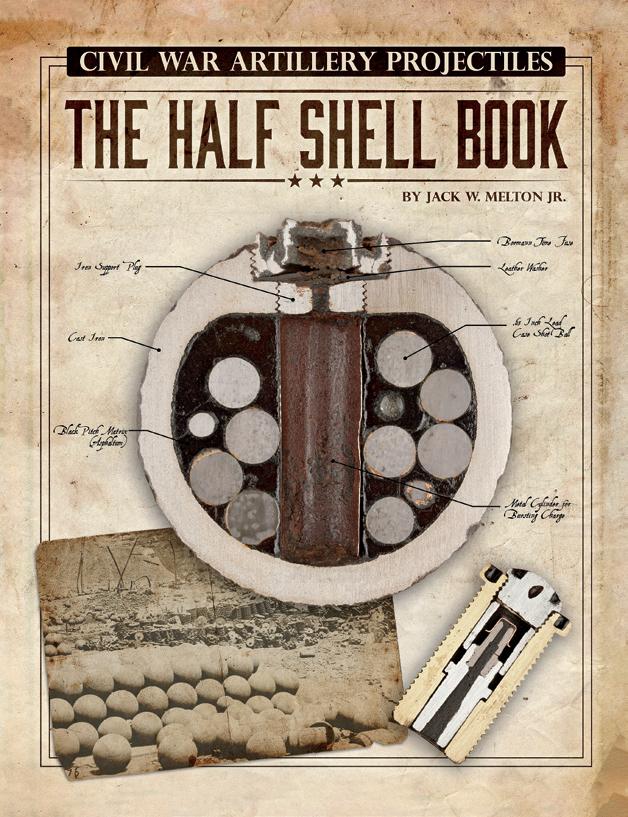
$89.95 + $8 media mail for the standard edition shown here. The limited edition deluxe edition is $125 + $8 media mail.
was canceled due to the government shutdown, the rest of the day unfolded as scheduled: speakers at St. James Church, where Patrick Henry famously gave his “Give Me Liberty or Give Me Death” speech, van tours of the raid, and drills conducted by reenactors. Approximately 40 people attended and came from as far as New England and the Carolinas. Dunkerly and other Richmond Revolutionary War era historians are looking to conduct similar events and programs in the future, so stay tuned to Emerging Revolutionary War for those updates.
Digital Issues of CWN are available by subscription alone or with print plus CWN archives at CivilWarNews.com
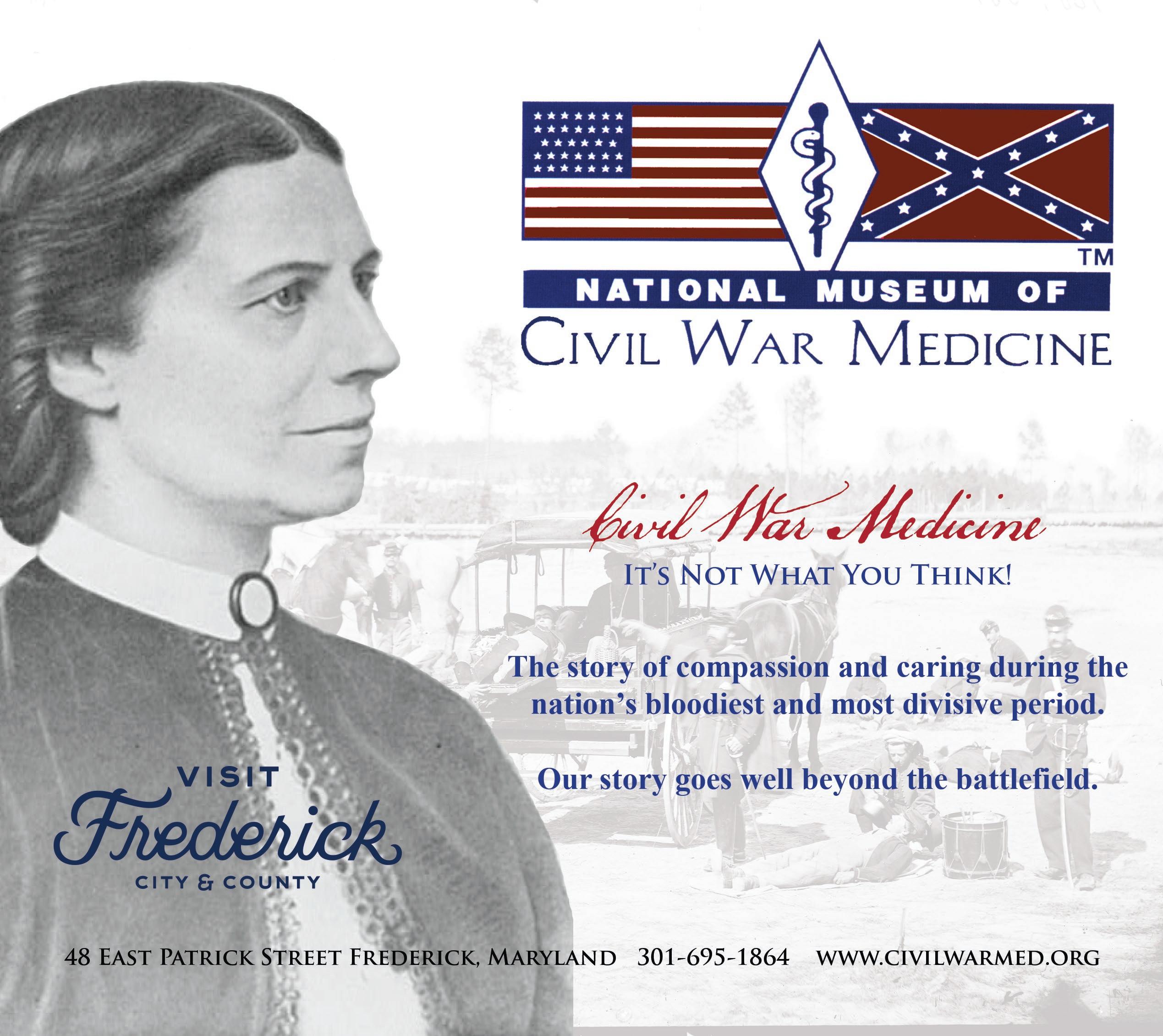
Civil War News book reviews provide our readers with timely analysis of the latest and most significant Civil War research and scholarship. Contact Stephen Davis, Civil War News Book Review Editor. Email: BookReviews@CivilWarNews.com.
Challenges of Command in the Civil War: Generalship, Leadership, and Strategy at Gettysburg, Petersburg and Beyond – Volume I: Generals and Generalship. By Richard J. Sommers. Photographs, maps, notes, bibliography, index, 268pp., 2018. Savas Beatie, www.savasbeatie.com. $29.95 hardcover.
 Reviewed
Reviewed
by
Christopher L. KolakowskiPenitentiaries, Punishment, and Military Prisons: Familiar Responses to an Extraordinary Crisis during the American Civil War By Angela M. Zombek. Notes, bibliography, index, 287 pp., 2018. Kent State University Press, www. KentStateUniversityPress.com. $45 cloth.
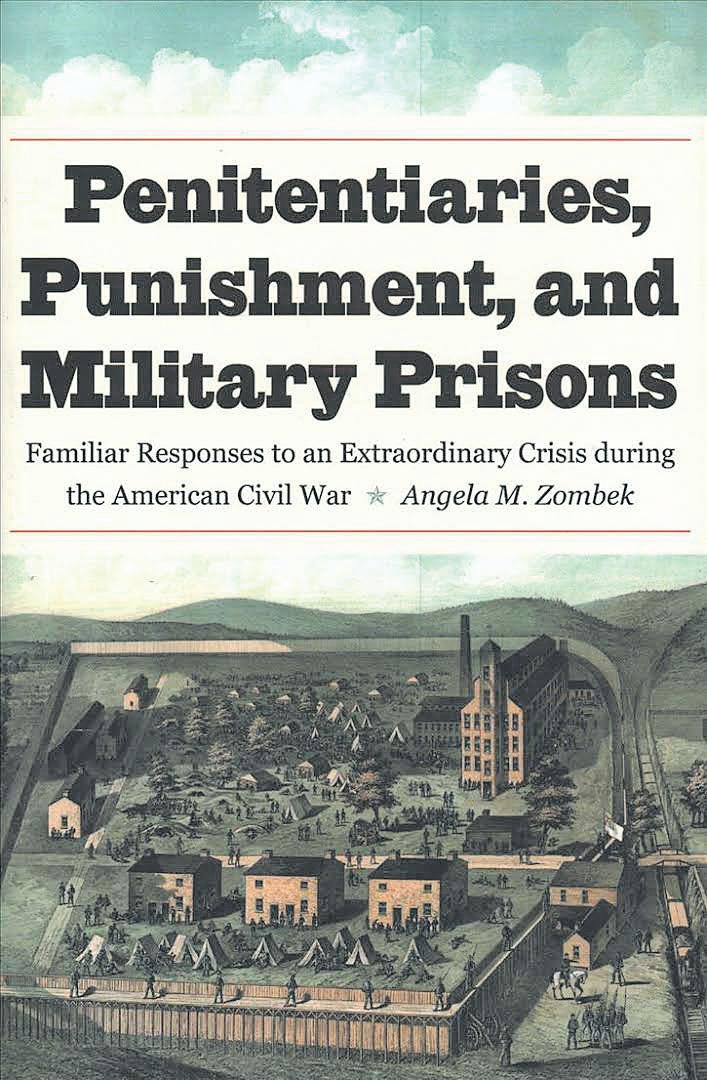
Reviewed by Meg Groeling
in Carlisle, Pennsylvania, and his published work on the Richmond-Petersburg campaigns of 1864-65. An in-demand speaker, Sommers has spoken many places and offered thoughts on Civil War leadership and combat. He has compiled several recent presentations into the current volume of essays. Topics include the generalship of U.S. Grant and Robert E. Lee in 1864 and 1865; Union civilian corps commanders; Union corps commanders at Antietam, Gettysburg and the Overland Campaign; and a final chapter on descendants of famous Revolutionary War figures in the Civil War. (A second volume will discuss tactics, logistics and other matters.)
The reviewer has heard one or two of the above presentations, and enjoyed reliving them in the text. The other presentations/essays were read with considerable interest, and did not disappoint. Sommers’ deep grasp of the subjects shows through in every section. His perspectives are worth consideration by any student of the war, especially of the Eastern Theater.
As long as military history has been written, there has been a focus on leadership and generalship. The personalities and interplay of various leaders and their subordinates, so critical often to the success or failure of campaigns, is a fruitful topic of study— no matter the era.
The Civil War offers no shortage of leadership and generalship case studies in both theaters. Major characters like Robert E. Lee, Ulysses S. Grant, Thomas J. Jackson, William T. Sherman, and many others continue to fascinate, educate, and inspire today. Much ground remains to be plowed in considering Civil War generals and generalship.
Richard Sommers is wellknown for his extensive work on U.S. military history, both professionally at the U.S. Army Heritage and Education Center
That said, the book does have some limitations. Several essays, especially those on the corps commanders, are repetitive as the same characters are mentioned. Long and detailed footnotes, while informative, can be distracting. Sommers also gets into technical details that may lose less well-informed readers.
All things considered, Richard Sommers has made an important contribution to understanding the Civil War and leadership. This book is recommended as a reference for any student of Union leadership or the war’s Eastern Theater.
Christopher L. Kolakowski works as a historian in Norfolk, Virginia. He is the author of four books on the American Civil War and World War II, and is a contributor to the Emerging Civil War blog.
Penitentiaries, Punishment, and Military Prisons places the years 1861–1865 into the broader context of prison in the mid-nineteenth century. I knew little about such things, so this book was very enlightening for me, and author Zombek provides more than enough details to set a reader up for an informed reading experience. In short, prisons in America were places where people convicted of committing a crime were sent to serve their sentences. They were warehouses—certainly not the sort of penitentiaries we know today. Punishment was the purpose, hand-in-hand with rehabilitation. Prisons differed from jails, which were temporary holding areas for the recently arrested or those who had not yet gone to trial.
Prisons housed the poor, illiterate, “rough customer” who got caught breaking the law. Gentlemen were not imprisoned, as a general rule—nor were average citizens who might occasionally drink too much, take something not theirs, or be a bit too aggressive in disciplinary measures used at home. Women were sent to prison as well, usually for theft or prostitution. “Nasty, bad criminals go there, not good folks.” It was into this mindset that the war imposed military prisons, and few knew just what to think about it all.
Before the war there were no facilities designated as military
prisons—both Washington and Richmond had to utilize other facilities such as warehouses and abandoned building complexes. Places in areas such as Chicago, Salisbury, and Andersonville needed to either refurbish old buildings or build new ones, some based on such spurious designs as a large enclosure which fenced in prisoners and provided makeshift shelter. There were arguments concerning just who had to pay for military prisons: states did not care to bear the burden of incarcerating and caring for men not their own, and before the war the military had not even considered hospitals, much less prisons. Lastly, there was the ongoing issue of a professional army versus a volunteer army. Federals rounded up after First Bull Run, for example, were sent to prison in Richmond. They were appalled that they were now considered convicts, a role they had not enlisted to play. Suddenly, Union soldiers went from proud volunteers to criminals in prison. Confederate prisoners fared even worse, as many captives from the South at the beginning of the war were often from well-to-do families. They had no idea how to care for themselves in prison, and quickly spoiled their rations and their environment due to ignorance of simple skills like cooking and cleaning. It did not get better as the war ground on. When prisoner exchanges were cancelled, more and more men were confined, with little planning made for their care. When this information is put into context, as it is in Zombek’s book, the results may be viewed in a new light. The antebellum expectations of prisons-such as not imposing a financial burden on the citizenry by being self-supporting via workshops and contract labor—suddenly became untenable. Confederate prisoners were certainly not going to help the Union war effort by sewing uniforms or wrapping cartridges. Nor were Union prisoners going to receive the care in a Confederate prison that a
Southern man might receive. Guarding prisoners became an onerous and unpopular job when transferred from the realm of public employment to a military duty. Author Zombeck details many of these issues, which occurred on both sides.
Penitentiaries, Punishment, and Military Prisons is a fascinating comparison of institutions, and one that has not been given much attention. The book is heartbreaking in many ways, but the way that it affected me most was the psychological one, in which a soldier was placed in the same position as a criminal. Even a jailbreak could be looked at from many points of view. If it is the duty of a captured soldier to attempt escape, which it was on both sides, then imagine the conflict of a man in prison. He knows he should try to get out, but he also knows that he is putting his life in his hands in the attempt. If he is recaptured, punishment is great as well. Imagine being a young man who was law-abiding until the war, signed up to fight for morally feasible reasons, and for some cause—illness, wound, staying with a fallen friend—suddenly he is a prisoner and is being treated as if he was a criminal.
Angela M. Zombek, an assistant professor of history at the University of North Carolina, has done extensive research on her topic and has written articles and book chapters about Civil War prisons. With this work she gives readers a serious, empathetic and nuanced look at a topic that affected hundreds of thousands of men. Reverberations of these events continue today in the modern struggle for humane treatment of prisoners.
Meg Groeling of Hollister, Cal., received her Master’s degree in military history, with a Civil War emphasis, in 2016 from American Public University. Her next book, First Fallen: The Life of Colonel Elmer Ellsworth, will be published by Southern Illinois University Press.
Featuring a large assortment of Civil War and Indian War autographs, accoutrements, memorabilia, medals, insignia, buttons, GAR, documents, photos, & books. Please visit our fully illustrated online catalog at www.mikebrackin.com
Mike Brackin
PO Box 652, Winterville, NC 28590 • 252-565-8810
Ambivalent Nation: How Britain Imagined the American Civil War. By Hugh Dubrulle. Notes, index, bibliography, 337pp., 2018. Louisiana State University Press, www.lsupress. org. $49.95 cloth.
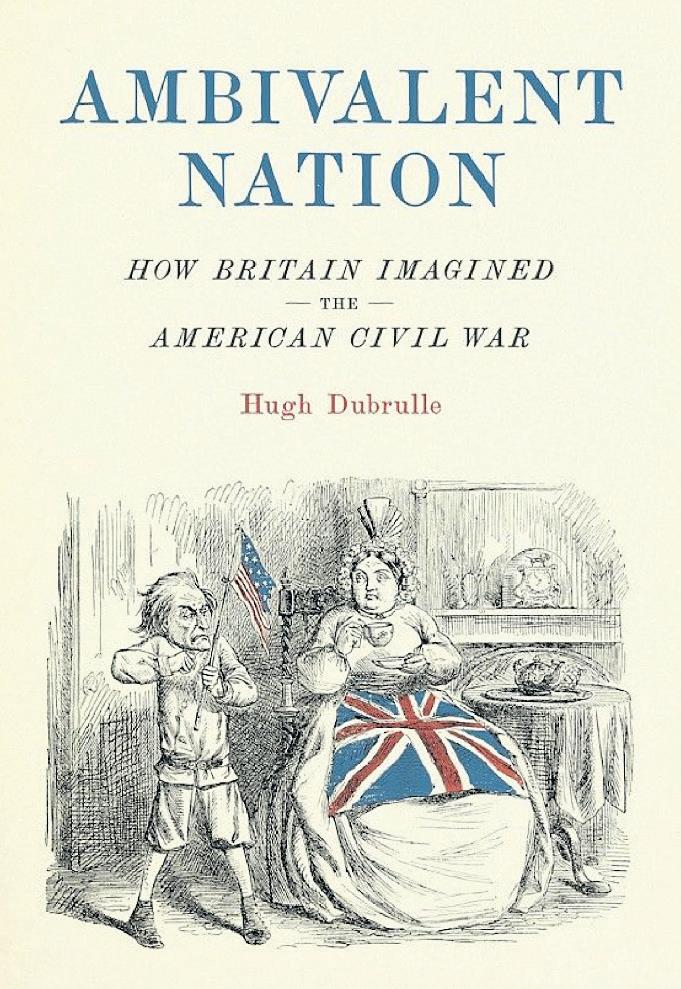
Reviewed by Katelyn Brown
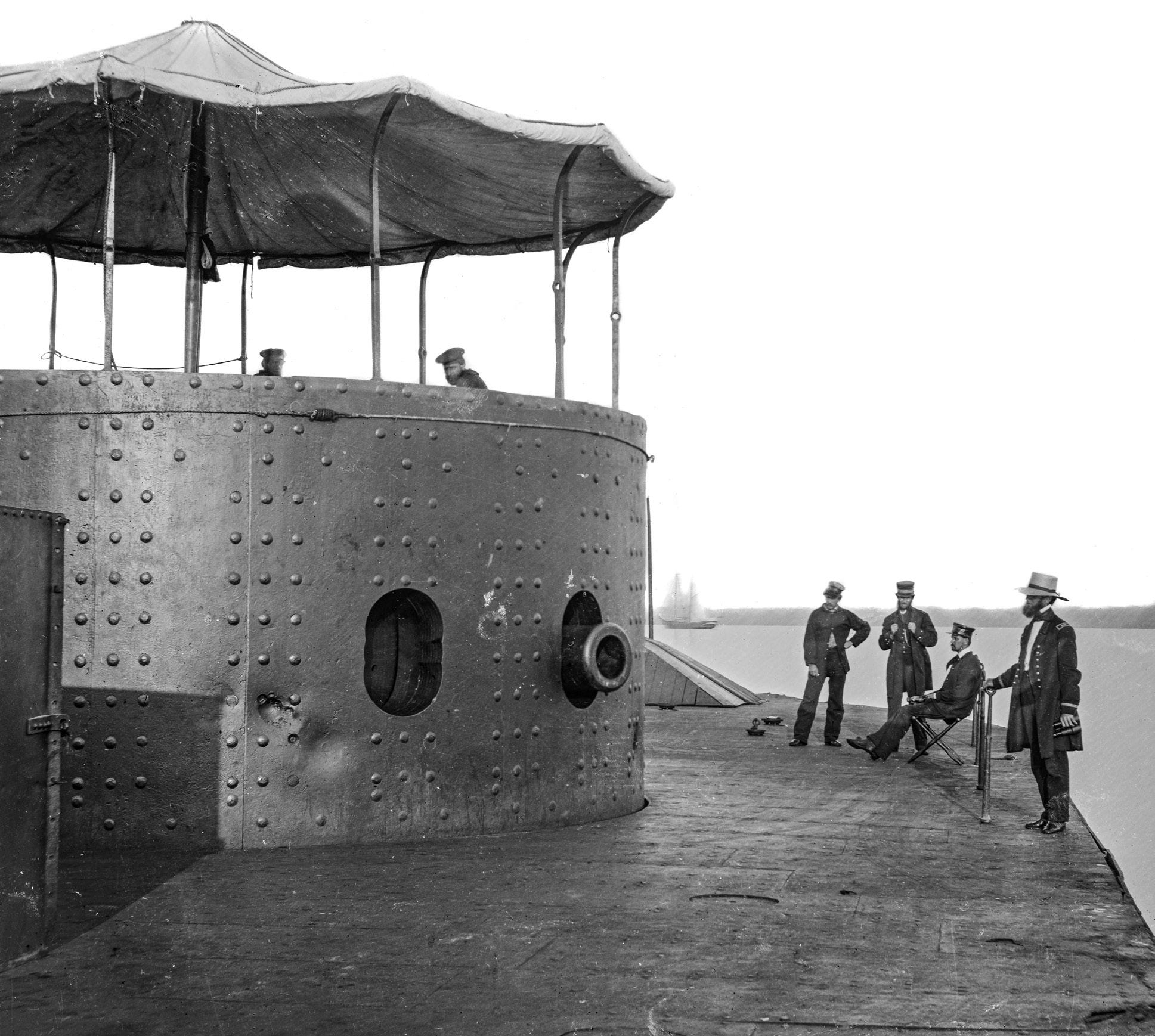
attitudes towards the war were shaped by slavery or commerce; instead, he argues that “British opinion was not pro-northern or pro-southern as much as it was pro-British.” As the title suggests, the British public was more ambivalent than anything else.
When most Americans imagine the Civil War, they picture a strictly American conflict that was fought and thought about only by Americans; however, no historical event happens in a bubble, and the Civil War was no exception. A number of scholars have argued the importance of the Civil War to Britain, a discussion which Hugh Dubrulle joins with this book.
Dubrulle, a history professor at Anselm College in Manchester, New Hampshire, begins with a description of the state of the field, laying out the various scholarly views of Britain’s perspectives on the Civil War. As Dubrulle argues, scholars’ analysis of British opinion has focused on “who believed what,” whereas the field also requires a discussion of “how Britons believed.” With the purpose of the book clearly stated, Dubrulle then moves into a thorough analysis of how the people of Britain thought about Americans before and during the war. Throughout, the author argues that the British viewpoint of Americans was shaped by postcolonial arrogance and the stereotypes that antebellum travel literature had instilled in the British public. Americans were somehow both a familiar extension of the British world while also being an unknown Other.
After beginning with an examination of British perceptions of antebellum Americans, Dubrulle spends most of the book in the analysis of four particular subjects: British perspectives on American racial relations, politics, military, and nationalism. Interestingly, Dubrulle challenges the popular narrative that British
Dubrulle’s assertion of British ambivalence is a relatively new idea, with most scholars arguing for strong British opinion one way or the other. As the author writes, only a handful of scholars have previously framed British opinion in a nuanced way, including R.J.M. Blackett in Divided Hearts (2001) and D.P. Crook, The North, the South, and the Powers (1974). Dubrulle adds a new dimension to this argument, however, by arguing that Reconstruction changed British minds regarding the feasibility of its popular government. Surprised by the Federal military victory and the resilience of American nationalism, Britain was forced to reevaluate its ambivalence and therefore to open up a new chapter in Anglo-American relations.
This argument is strengthened by Dubrulle’s opening chapters, in which he describes the perspectives that Britons brought into the start of the Civil War. By opening with such analysis of antebellum perceptions, he provides a crucial foundation from which to convincingly prove the shift in British views of Americans as a result of the war.
Another strength comes from the author’s thorough research and use of a wide variety of primary sources, including newspapers, official correspondence and government archives. By adopting an entirely new lens of analysis on this source base, Dubrulle is able to successfully meet his own challenge of showing how the British perceived Civil Warera Americans, demonstrating that British attitudes towards the war were shaped by an ambivalence formed even before the war began.
While the breadth of his sources is impressive, this thoroughness results in a highly academic work that is quite dense. As a result, it is not a book for the casual reader; however, it does provide a valuable perspective on the international dimensions of the Civil War and the relationship between Britain and the United States.
Katelyn Brown is the Program Coordinator for the Virginia Center for Civil War Studies and Education Assistant for the American Battlefield Trust. She has published articles in Military Images and Ohio Valley History.
“Our Little Monitor”: The Greatest Invention of the Civil War. By Anna Gibson Holloway and Jonathan W. White. Maps, tables, illustrations, photos, notes, appendix, index, 283 pp., 2018. Kent State University Press, www.KentStateUniversityPress. com. $34.95. Hardcover.
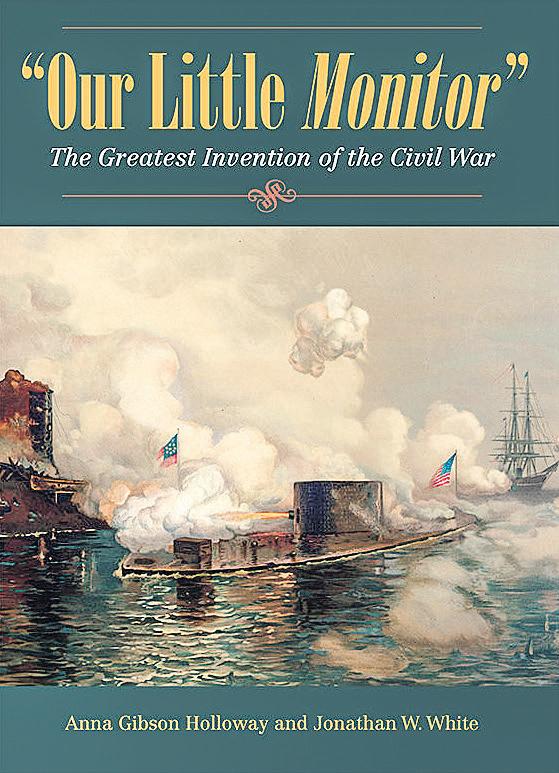
Reviewed by Joan Wenner
then for CWN. And how amazing that this “greatest invention” shares center stage with another innovative and technologically advanced craft—the winning 2013 Team Oracle America’s Cup foiling catamaran in a newly launched exhibition.
This is a book of heft that includes many interesting images and illustrations with technical and engineering information. For example, did you know there was a Monitor float in a Grand Army of the Republic parade and later commemorations, and sheet music composed for marches, common for notables at the time?
(including remains of crew members, their identification and burial).
What a pleasure to review this comprehensive and fact-filled book. It is co-penned by Jonathan W. White, the former curator of the USS Monitor Center at the Mariners’ Museum & Park, a respected professor and author at Christopher Newport University.
This is partly due to my witnessing the retrieved turret’s arrival in 2002 at Newport News and updating developments at the Museum numerous times since
Other photographic images from the period have been often reprinted, while recovered artifacts and discoveries from the modern day would likely be of special interest to Civil War naval buffs, and especially perhaps the undersea images by the National Oceanic and Atmospheric Administration from the Monitor National Marine Sanctuary (currently in hopes of its boundaries being expanded.)
The work is divided into two distinct parts. Part 1, containing 177 richly illustrated pages, presents a narrative history of the ironclad Monitor from its beginning designs through construction and her battle at Hampton Roads with the CSS Virginia in March of 1862, the sunken ship’s discovery, to the conservation of those parts and artifacts retrieved
Part 2, 68 pages, in documentary fashion serves up intriguing and often fascinating first-hand accounts and communications— the real words and unique perspectives of those who experienced the Monitor. They are gleaned from many “untapped materials” and divided into individual chapters. The battle of Hampton Roads in Chapter 10 is particularly interesting, as are Chapter 11 on President Lincoln’s Mailbag March 10-17, 1862, the Engineer’s View in Chapter 12, and the chapters that follow concerning the ship’s repair and personal observations of two surgeons of her final moments. A terrific book that does in fact pull it all together, as the authors claim, “Our Little Monitor” is for whatever level the reader desires to know about the ship and those connected with her. It is indeed a very definitive account of virtually every aspect of the USS Monitor.
Joan Wenner, J.D. is a longtime contributor to the Civil War News and numerous history publications. Presently residing in eastern North Carolina (and the Graveyard of the Atlantic), she has a special interest in Civil War naval operations and military courts of inquiry. Contact at joan_writer@ yahoo.com
Irenus Watson Landingham was born in Alabama in 1839. His family moved to the vicinity of Houston, Texas, before the war. Landingham enlisted in the Bayou City Guards, which became Company A, 5th Texas Infantry. With his regiment he traveled to Virginia, where he eventually became part of Hood’s famed Texas Brigade.
Prof. Susannah Ural, in her acclaimed Hood’s Texas Brigade (2017), quotes a letter that Private Landingham wrote his mother on Nov. 1, 1861, from his unit’s camp outside Richmond. When they marched into Richmond a week before, “windows went down in a hurry;” Richmonders had heard that “Texan’s is coming,” and they wanted to take a look.
At some point Landingham joined General Hood’s staff as clerk, and in this capacity he followed Hood throughout the war. Happily, he kept in touch with his mother through letters that are preserved at the Auburn University Libraries Special Collections and Archives (Landingham Papers, #552). When I recently visited Auburn to examine Landingham’s letters, two specially caught my eye. Here they are.
Near Atlanta, Ga.
July 14, 1864
Dear Mother
I rather expected a letter from some of you by the mornings mail, but as none came, I must perforce content myself by writing. You all certainly do not write often or I would not have to complain so much.
be briefer than I intended.
Doubtless ere now, you are acquainted with the situation of military affairs in this department. The Chattahoochee river has seperated the two Armies for the last four or five days, and we have had an opportunity to rest a little. Sherman seems to have “smelt a mice” and evinces some hesitation in following, he had two corps on this side above us, but whether he intends to come on is a question left with the future to decide, the Yankee has such a high appreciation of his own abilities, that I will not be surprised to know of his crossing his whole Army soon. In that event we will probably fall back upon Atlanta, & perhaps even still farther, leaving that place to the tender mercies of the minions. It is not yet quite time for us to strike—indeed I think the longer a battle here, can be postponed the better, as I believe we can whip Sherman, and if the Yankee nation can go to the polls next November with a crushing defeat in the west fresh upon their memories, it will make many a man stick in a “peace ticket.” We have, for the last two or three days, been sumptuously fed upon reports of Kirby Smith being on this side of the Mississippi, with a force, organizing, preparatory to striking Sherman in the rear. I earnestly hope there is some foundation for these reports, as it will necessitate a retreat on Shermans part and then will come our time to work upon him. Genl Bragg is on a visit to the Army, but his occasion had not yet transpired.
I notice Early, Breckinridge, &c, are kicking up a “big scare” in Maryland and Pennsylvania. I hope they may be able to take Baltimore and Washington. It would be a tremendous joke on King Abe, and would perhaps call forth a grin on the wrong side of the mouth, if Lee should take Washington before Grant gets to Richmond. I think in taking all things into consideration—affairs wear a pretty bright aspect. It is reported that the Legislature of Texas, has requested the President to grant the “Old Texas Brigade” a 90 days furlough at the close of the present campaign—Alas! there are but few to go.
A storm has come up since I commenced writing, and the rain is beating through the tent so much, that I fear I shall have to
Our presence on the south side of the Chattahoochee created considerable alarm in Atlanta, and the good people of that city have been getting to the rear in a hurry. I was in town a few days after we crossed, and there was so much confusion that it was a relief to get back to the Army again. Citizens hurrying to and fro with anxious faces, drays and wagons running about with furniture, Engines whistling, & puffing and blowing and shrieking, Hotel gongs ringing (and right then I went in and got dinner.) Cavalry dash about over the streets, Artillery rumbling, and every thing generally, in such a high state of haste and confusion, that it did not present a very lovely scene to a lover of tranquility. What has become of Cousin Anna? There really seems to be something strange about her writing to me, her silence has suggested many thoughts— thoughts which perhaps do injustice, and had therefore, better be kept to myself. Of course it is a pleasure to write, and receiving letters from those we love, but if Cousin Anna must write contrary to her own, or any body else’s feelings, it is best that she should remain silent.
You have not yet acknowledged the receipt of 10$ I sent some time ago. Give my love to all, and kiss Ella for me—there is only one to kiss now. Write soon.
Your affectionate boy Watson
Send me Mr. Davis’ proper address
I wish to write to him
Landingham’s observations of Atlantans “hurrying to and fro” in the days after Johnston’s army had retreated back across the Chattahoochee are echoed elsewhere. As I wrote in my What the Yankees Did to Us: Sherman’s Bombardment and Wrecking of Atlanta (2012), a correspondent for the Mobile News similarly observed, “everybody seems to be hurrying off, and especially the women….The excitement beats anything I ever saw.” The excitement was palpable when Confederate Gen. Braxton Bragg stepped off the train in downtown Atlanta on the morning of July 13. Even before he rode to Johnston’s headquarters, Bragg shot a telegram to Richmond: “indications seem to favor an entire evacuation of this place.” Johnston, of course, did not evacuate Atlanta; he was fired by the War Department before he could do so. His successor, Gen. John B. Hood, defended the city for a month and a half, until Sherman cut his last railroad
supply line. By this time command of Hood’s Corps had passed to Lt. Gen. Stephen D. Lee, on whose staff Landingham remained. The Army of Tennessee evacuated Atlanta during the night of September 1-2. Landingham wrote home a few days later.
Near Lovejoy Station
September 6, 1864
Dear Mother: Here we are twenty-five miles below Atlanta on the Macon R.R. and the Yankees have possession of the “Gate City.” On the night of the 30th inst this Corps started from East Point and arrived at Jonesboro about 12 o’c the next day and immediately formed line of Battle. Hardees Corps was already there in line, and about 3 o’clock we attacked the enemy, but failed to dislodge him. The next morning we left Hardee in line and marched back to within five miles of Atlanta where we bivouaced. The City was evacuated that night at 12 o’c, and we started for this point the following morning, and arrived here yesterday. The loss of this Corps in the fight was 169 killed, 1095 wounded, and 248 missing. Hardees loss was very small. The troops did not half fight or we might have saved Atlanta. Our failure to drive them back at Jonesboro made it necessary to abandon the city. Several trains of Ammunition were destroyed, but I believe most of everything else was gotten away. The enemy left the front of this Corps this morning and are reported to be falling back on Atlanta, tearing up the Rail Road as they go. It is impossible to form an idea of what will be done next, I do not think we can get Atlanta back without more troops, or somebody in Sherman’s communications who can accomplish something. Wheelers expedition seems to have been a fizzle, as Sherman does not mind him much.
I wish Forrest could be sent to Tennessee he seems to be the only Cavalry Commander down this way who can accomplish anything.
I expect the people are looking rather glum over the fall of Atlanta. I consider it a great disaster coming just at this juncture, but it may not be irreparable. If McClellan & Pendleton are elected in November, I think peace will soon follow. If not there is no telling how long the war will last.
We have had no mail since we left Atlanta, the Army Post Office was destroyed there, and another one has not been organized yet. I hope it will not be long, however, before the mail for the army will
be ready for delivery. I wrote you a few days before the evacuation of the city enclosing fifty Dollars (50$). I have not been able to learn whether mail left after that time or not, but hope it went along all safe. There is no other news [worth] sharing. I haven’t time to write much more this even’g. Love to all, unto soon.
Your Affectionate Son Watson
Landingham was incorrect in writing, “our failure to drive them back at Jonesboro made it necessary to abandon the city.” Around 3 p.m. on August 31— when Hardee and Lee were launching their attack on O.O. Howard’s three infantry corps at Jonesboro—Federals of Jacob Cox’s division struck the Macon & Western Railroad eight miles north of Jonesboro. It was this lodgment, and Hood’s learning of it within a few hours, that sealed Atlanta’s doom. I had a map commissioned for my Atlanta Will Fall: Sherman, Joe Johnston and the Yankee Heavy Battalions (2001) to make this very point. This does not diminish the value—the charm, really—of Watson Landingham’s letters to his mother in Texas. Wayne Wolf and Bruce Allardice, who write articles about soldiers’ letters for Civil War News, will agree with me that finding and publishing little-known epistles from the war front contribute to what we may call gaudium inventionis the joy of discovery.
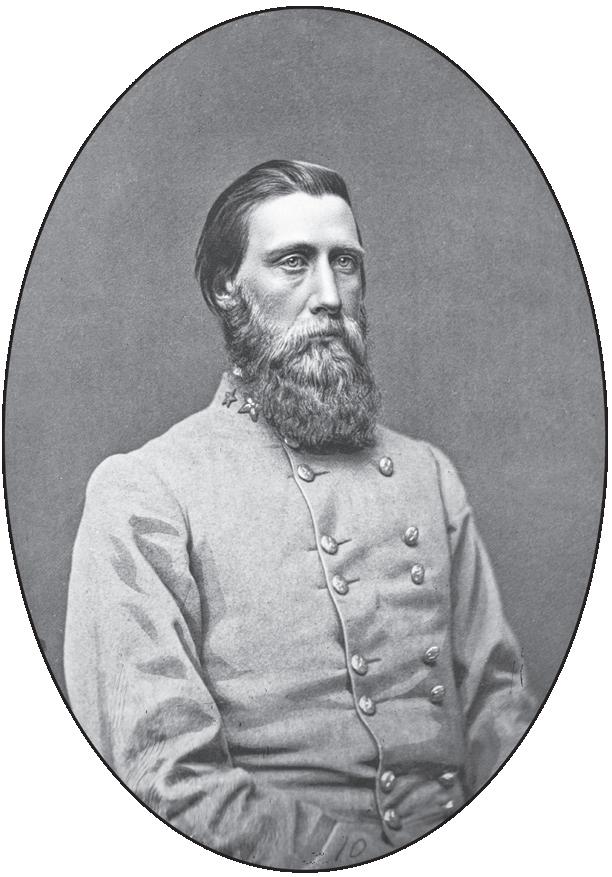
Note: As I wrote in this space last month, we’re all Civil War students and researchers, even if most of us are not “academics.” I therefore suspect some CWN readers have, like I did, found an interesting (AKA cool) letter or diary written by a Civil War participant. If you have a text or excerpt to share, email it to us—we might be able to print it.
Stephen Davis steveatl1861@yahoo.com
Custer: The Making of a Young General. By Edward G. Longacre. Maps, bibliography, notes, index, 276 pp., 2018. Skyhorse Publishing, www.skyhorsepublishing.com. $24.99 hardcover.
Reviewed by Thomas J. Ryan
1. Who sent the following message to the Confederate commander at Fort Donelson: “I propose to move immediately upon your works”?
2. Who wrote President Lincoln, “I beg to present you as a Christmas gift, the City of Savannah, with one hundred and fifty heavy guns and plenty of ammunition”?
3. This Union officer, a son of Irish immigrants, started out serving in Missouri, then distinguished himself as an infantry brigade commander at Perryville and Stones River. He ended the war as commander of all cavalry in the Army of the Potomac. Who?
4. The preceding officer moved from west to east. Just the opposite occurred with this Federal major general. His mediocre leadership of Hooker’s cavalry in spring 1863 led to his being relieved; he was later reassigned to Sherman’s army in Georgia. In his raid toward Macon in July 1864, he was pursued and overwhelmed by Confederate cavalry, and forced to surrender himself and much of his command. Who?
5. In May 1862 this Northern general was sent to New Orleans after Federal capture of the city. Southerners excoriated him, calling him “Spoons” for alleged thievery of silverware and “Beast” for his famous “Woman Order.”
Who?
6. The arrival of this U.S. major general’s army during the battle of Shiloh is widely seen as saving Grant from defeat in April 1862. But he allowed Bragg and Kirby Smith to maneuver him out
of middle Tennessee later in the summer. After the battle of Perryville, Ky., on October 8, 1862, Bragg retreated, but this officer failed to pursue. Within two weeks he was canned. Who?
7. This Virginia-born career U.S. Army officer earned the famed nickname “Rock of Chickamauga.” Who?
8. This intellectually brilliant Union general commanded Federal forces from St. Louis early in the war. After Shiloh he assumed command of Grant’s Army of the Tennessee, Buell’s Army of the Ohio and Pope’s Army of the Mississippi, some 110,000 men. But his advance to Corinth, Miss., was so cautious and lethargic that in July 1862 Lincoln kicked him upstairs to become general-in-chief in Washington. Who was this officer, nicknamed “Old Brains”?
9. After his lines were broken during the battle of Chickamauga, this commander of the Union Army of the Cumberland was later accused by James A. Garfield of having fled the field. Who?
10. Recommended by Halleck and Grant, this Ohio-born officer was promoted to brigadier in August 1862 and to major general two months later. He led the XVII Corps at Vicksburg and the Army of the Tennessee in Sherman’s Georgia Campaign until his death near Atlanta. Who?
Answers found on page 45.
Steve Davis is the Civil War News Book Review Editor. He can be contacted by email at: SteveATL1861@yahoo.com.
Unfortunately for his legacy, George Armstrong Custer is best known for his death in 1876 at the battle of Little Bighorn against the Lakota and Arapaho Tribes in Montana Territory. The general public knows much less about Custer’s exploits and accomplishments during the Civil War of 1861–1865.
Edward G. Longacre, who has focused much of his research and writing career on Civil War cavalry commanders and operations, undertook to clarify and expand upon the historical record of George Custer’s service in the Union army—primarily as a cavalry officer. This is the first of a planned two-part series. Longacre laid the groundwork for his current study with prior publications, including The Cavalry at Gettysburg (1986), General John Buford: A Military Biography (1995), Lincoln’s Cavalrymen (2000) and Lee’s Cavalrymen (2002).
In this current work, Longacre proposes “to identify and correct the myths, misconceptions, and misinterpretations about Custer the man.” He also intends to “add depth to the Custer narrative” by including substantial detail about his life and career.
The author introduces the Ohio native George Armstrong Custer as an impulsive youth, born in 1839, whose hero was General Winfield Scott of Mexican War fame. Custer’s penchant for engaging in pranks and telling jokes was in evidence during his years as a cadet at West Point. His behavior and lack of dedication to
the curriculum came within a whisker of ending his status as a cadet, and he graduated last in his class in 1861.
Longacre points out that, depending on their geographic origin, hostility developed between West Point students prior to the Civil War. Yet Custer managed to maintain friendships with cadets from both the North and South. Once he donned the uniform as a Union officer, he retained amenity toward Southern friends and acquaintances—some of whom he met on the battlefield. Politically, he was more in tune with the South regarding lifestyle issues, including slavery, yet maintained an allegiance to the Union of states.
The narrative describes battles in which Custer played a role either in a staff or line function. A paradox is evident concerning the mutual admiration between Custer, a daring young officer, and Maj. Gen. George McClellan, a slow-to-act army commander. Custer failed to find fault with McClellan even in light of the latter’s reluctance to act aggressively during the battle of Antietam and its aftermath.
The author pays considerable attention to Custer’s relationship with young women, and his tenacious, and, at times, overbearing, pursuit of the hand of Libby Bacon—his future wife. While Custer’s social escapades are indicative of his personality, Longacre also details Custer’s facility for maneuvering through the political morass to achieve promotion, as well as important assignments with the assistance of high-ranking military officers.
Indicative of his success in overcoming typical bureaucratic constraints, Custer received promotion from captain to brigadier general in the volunteer service just two years after graduating from West Point. His patron was Maj. Gen. Alfred Pleasonton, Army of the Potomac cavalry corps commander, who saw in this young officer, as well as the fiery and reckless Hugh Judson Kilpatrick, the caliber of leader he wanted commanding his cavalry divisions and brigades.
Longacre focuses in detail on Custer’s courageous performance against Stuart’s more numerous cavalry east of Gettysburg on July 3, 1863. Although not
as famous as the charge named for Maj. Gen. George Pickett on that same date, Custer’s charge-while shouting to his Michigan horse soldiers, “Come on, you Wolverines!”—stymied Stuart’s attempt to break through Union defenses behind the main lines. It was an important contribution to the Union victory at Gettysburg.
To insure that Custer’s character and motivation in life are understood, Longacre quotes readily from Custer’s wartime letters. Prior to the retreat of Lee’s army from Gettysburg, the author speculates whether Custer “must have wondered if the general commanding [Maj. Gen. George G. Meade] would be just as happy to see his antagonist escape.” Custer’s loss of patience with Meade’s cautious tendencies is seen in a letter he wrote not long after the Gettysburg campaign, when both armies were back in the same location as when it began.
In a compact, easy-to-read, well-documented narrative, Longacre fills in some blanks in George Custer’s story, and corrects a number of misconceptions. Maps and other illustrations help to keep track of events. The author evaluates Custer’s performance as a West Point cadet, and as an officer in the Union army during the first two years of the war. His projected second volume “will cover the remainder of Custer’s Civil War service and his controversial stint in Texas during the early months of Reconstruction.”
Given the sparsity of historical writings devoted to George Armstrong Custer’s service during the Civil War, Custer devotees as well as a more general audience will no doubt want to add Custer: The Making of a Young General to their collection.
Thomas J. Ryan is the author of the award-winning Spies, Scouts, and Secrets in the Gettysburg Campaign: How the Critical Role of Intelligence Impacted the Outcome of Lee’s Invasion of the North, June-July 1863. His latest book, written with Richard R. Schaus, is titled Lee is Trapped, and Must be Taken: Eleven Fateful Days after Gettysburg, July 4-14, 1863 and is scheduled for publication by Savas Beatie later this Spring.
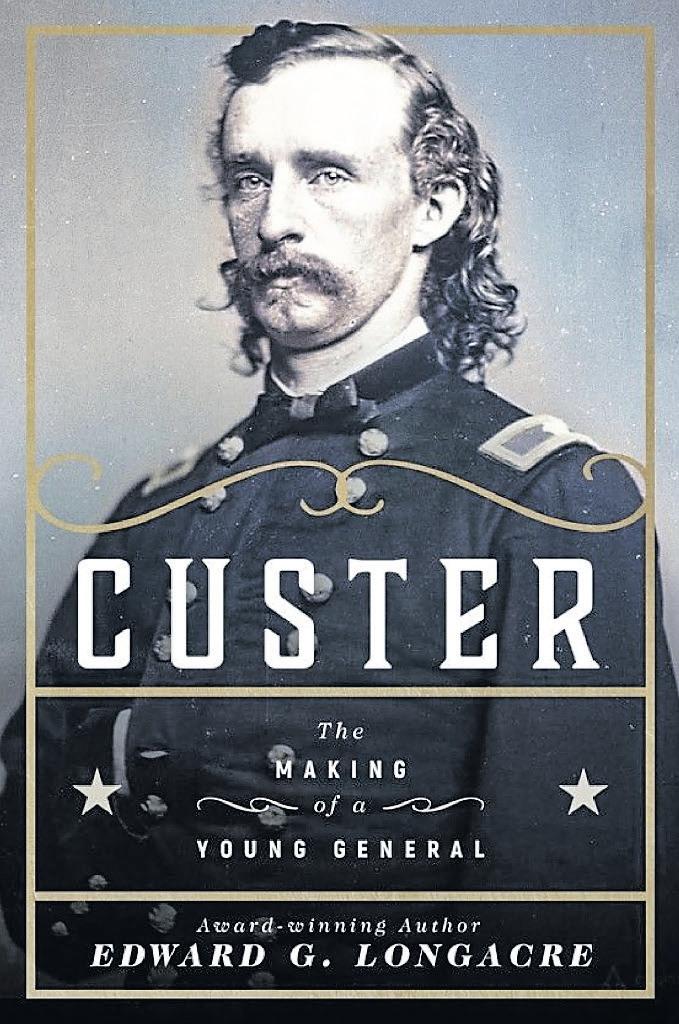
Decisions at Second Manassas: The Fourteen Critical Decisions that Defined the Battle.
By Matt Spruill III and Matt Spruill IV. Maps, photos, notes, index, 260 pp., 2018. University of Tennessee Press, www.utpress.org. $29.95 paper. Reviewed by John Hennessyof key battles and events: a new series, “Command Decisions of the Civil War.” Matt Spruill III and Matt Spruill IV—both retired military officers—have combined to produce the second volume of the series, Decisions at Second Manassas: The Fourteen Critical Decisions that Defined the Battle.
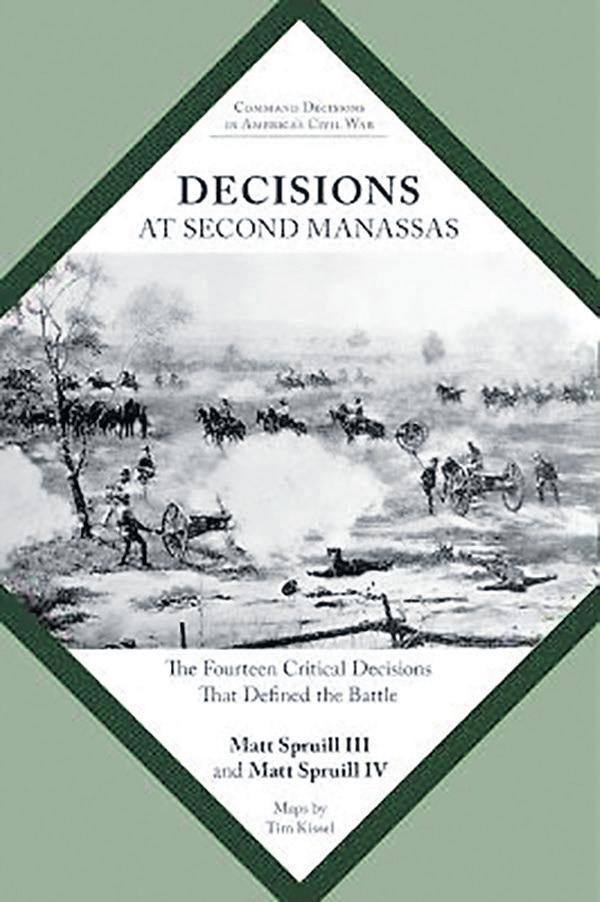
The Spruills offer readers an adaptation of a military staff ride, focused entirely on the decisions that they see as critical to the flow and outcome of the Second Manassas Campaign. The book makes no pretense to narrative. Instead, the authors parse fourteen moments, leading readers through what they perceive to have been the options available, the decision made, and the implication of that decision. The focus, as the authors say, is less on what happened than why it happened and why it mattered.
Army of Virginia but spend little ink on Lincoln’s critical decision to place John Pope in command of that army. (Indeed, the book little addresses the political context of the campaign—this is military history in pure form.) They barely reference perhaps the most important decision of the campaign: Pope’s choice to engage Lee at all, instead of falling back behind Bull Run to merge his own army with McClellan’s Army of the Potomac without a climactic battle.
Decisions at Chattanooga: The Nineteen Critical Decisions That Defined the Battle. By Larry Peterson. Maps, appendices, notes, photos, index, 176pp., 2018. University of Tennessee Press, www.utpress.org. $29.95 paperback.

Reviewed by Wayne L. Wolf
T. Sherman. The author argues that these personnel, tactical and organizational decisions defined the result and perhaps sealed the Confederacy’s fate.
In a lifetime, we have seen the historiography of the Civil War morph continually as publishers try new ways to engage a readership flooded to their waists with words. Analytical works by academic scholars have always been the foundation of the history business, but they often have little appeal to the masses. With Freeman, Catton and Foote, narrative histories emerged as the dominant way the public engaged in its past. Then, in the 1980s and beyond, a firehose of letters, diaries and memoirs gave consumers new ways to engage the story of war. More recently, anthologies have become the thing, though the public seems little enthused about them.
The University of Tennessee Press has devised a new way for readers to engage the story
We can surely argue number and nature of the critical decisions that shaped the campaign (and if we had more wordage available to us at the moment, we would). But most of the critical decisions the authors identify are obvious and their analysis is useful and interesting: Halleck’s decision to have McClellan evacuate the Peninsula; Lee’s decision to send Jackson on his flank march and Jackson’s subsequent decision to initiate the battle with Pope on August 28; Pope’s decision to attack on August 30…and many more. The various options the authors present generally seem to be those most likely considered by the players on the ground at the time.
Like a list of the 10 greatest lefties of all time, this book is intended to provoke, and that’s precisely what many readers will like best about it. There is enough to argue about. The authors explore the decision to create the Union’s
In a few instances, the discussion of the “critical” decisions presented seems to rely on presumptions that may seem reasonable, but are not necessarily supported by what’s known. The authors present the dilemma of Fitz John Porter on the morning of August 29 as if he had affirmative, or at least knowable, orders to attack Jackson, when in fact he did not. The authors’ analysis of the decision of Col. Nathan McLean to keep his brigade on Chinn Ridge and fight on the afternoon of August 30 rides on a thin foundation of source material indeed. We know almost nothing about McLean’s orders or thinking, or the limits placed upon him by superiors.
Of course, these are precisely the sorts of arguments a book like this is intended to provoke. The Spruills’ writing is straightforward and clear. The maps are good and numerous (31 in all). In fact, in some cases, these are the best published maps available on certain phases of the battle

The authors’ method won’t appeal to everyone, but for those are who looking for an examination of a military campaign through the lens of decision-making, as if on a military staff ride, this book will intrigue and satisfy.
John Hennessy is the author of Return to Bull Run: The Campaign and Battle of Second Manassas (1993), and The First Battle of Manassas: An End To Innocence July 18-21, 1861 (1989). Formerly historian at Manassas National Battlefield, he is presently the Chief Historian at Fredericksburg and Spotsylvania National Military Park.
Larry Peterson defines a critical decision as one of such magnitude that it shapes the success or failure of a battle or campaign. He succinctly presents three pre-battle decisions, nine decisions during the battle, and seven decisions post-battle that might have altered the outcome of the Chattanooga campaign.
From the Union perspective, Abraham Lincoln’s reinforcement of the Army of the Cumberland, Grant’s restructuring of the Union’s three western departments, the opening of the “Cracker Line,” and General George Thomas’ troops taking Missionary Ridge were the crucial decisions that ultimately led to Northern victory. For the South, Braxton Bragg’s dispersal of troops after Chickamauga to rid his army of malcontents, his poorly designed defensive lines, including the use of a topographical crest line of defense, and Patrick Cleburne’s protection of the Confederate retreat stand out as the turning points for the South. While the first two Southern decisions led to the fall of Chattanooga, the third saved Bragg’s army from annihilation. The result was the South’s loss of Chattanooga, a critical rail and supply depot and opening point on the road to Atlanta for William
The author includes an extensive driving tour to the locations of all nineteen critical decisions. This is perhaps the most valuable inclusion in the book. To enhance this section, he includes narratives from battle participants to add an historical “I was there” perspective which creates the imagery for the tourist. An appendix also details both the Union and Confederate order of battle to clarify division and brigade placement and participation. While the nineteen critical decisions are clearly defined with options offered for each, any such analysis will be open to other possibilities that are equally valid. Likewise, there are a number of whys not examined. For example, why did Grant continue to promote Sherman, when his performance at Chattanooga was abysmal? How did James Longstreet’s personal ambitions overshadow his effective cooperation with Bragg? What led Grant to assign George Thomas a supporting role at Chattanooga? And finally, when options were chosen, how did they affect future decisions? The nineteen selected options did not exist in a vacuum but ultimately interacted in a web of actions that changed as the battle progressed. This cause-andeffect is inadequately addressed.
This book certainly contains a number of interesting options that helped to shape the battle. Yet more comprehensive battle analyses by Wiley Sword, Peter Cozzens, Matt Spruill and David Powell, among others, address all of these issues in greater depth and comprehensiveness. Perhaps this book’s greatest benefit is the travel guide for the visiting historian. But at $29.95, it is a bit pricey for that benefit alone.
Wayne L. Wolf is Professor Emeritus at South Suburban College, Illinois, and the author of numerous Civil War books and articles, including Two Years Before the Paddlewheel: Charles F. Gunther, Mississippi River Confederate (2012), co-edited with Bruce S. Allardice. He is currently researching soldiers’ letters that add a personal touch to the war.
A Family and a Nation Under Fire: The Civil War Letters and Journals of William and Joseph Medill. Edited by Georgiann Baldino. Photos, notes, bibliography, index, 232 pp., 2018. Kent State University Press, kentstateuniversitypress.com. $34.95 hardcover.
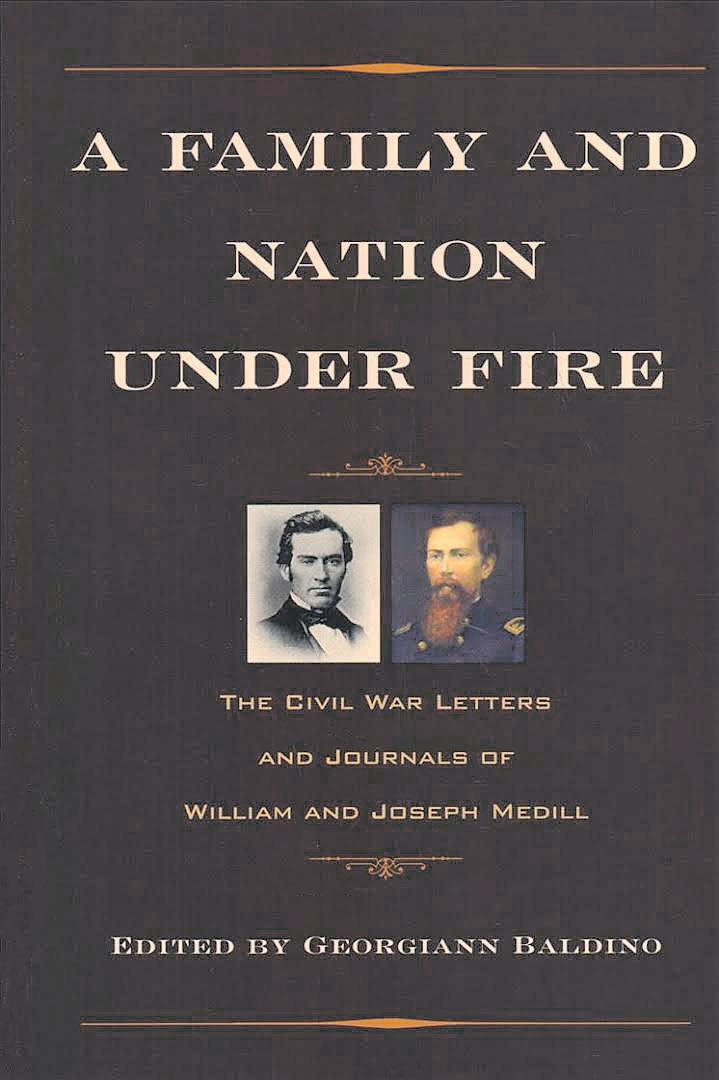
Reviewed by Jonathan W. White
who advocated for the destruction of slavery. Ironically, William also defended Union general George B. McClellan in the early months of 1862, although he would come to loathe “Little Mac” by the end of the year. His letters detail interactions with slaves and white southerners and offer pointed commentary on the landscapes of Virginia. When he visited the site where George Washington had courted Martha Custis, he wrote, “Romance is written everywhere, and I wonder not that Washington’s heart was filled with love while stopped at the [plantation]. Even I would be tempted to make love to a handsome widow if I found one in such a delightful spot.”
Unfortunately, other health issues caused Samuel to leave the army within a few weeks.
Confederate Prisoners at Fort Delaware: The Legend of Mistreatment Reexamined.
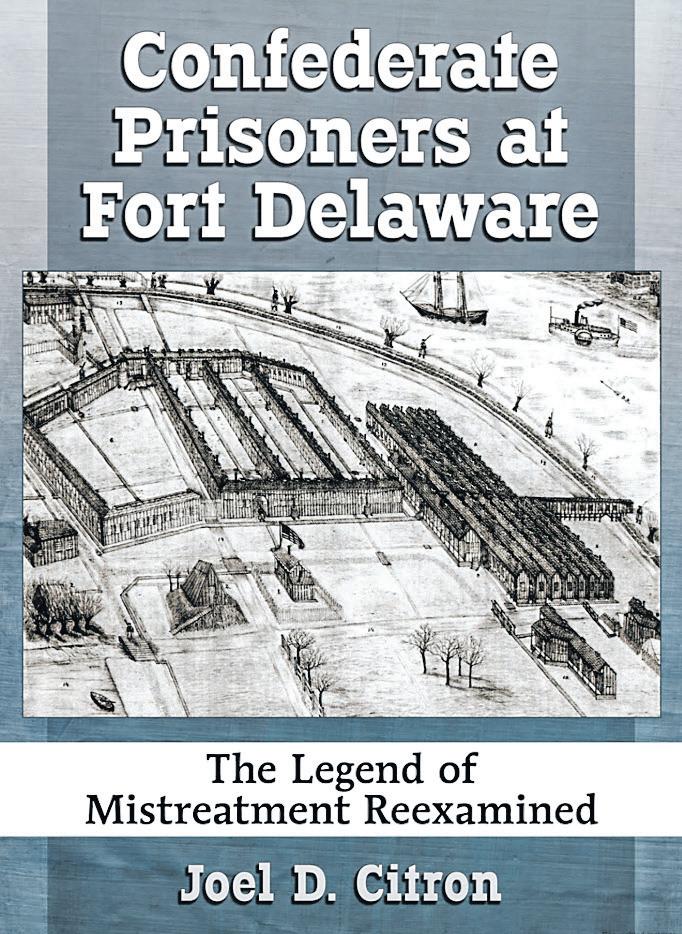

Joseph Medill is well known in Lincoln circles. This book will bring him and his family to the attention of Civil War enthusiasts as well. In the mid-nineteenth century Medill was the editor of the Chicago Tribune, an important Republican newspaper. In 1861 his brother William enlisted in a 3-month cavalry unit from Chicago; later that year he became an officer in the 8th Illinois Cavalry. This book reproduces a series of wartime letters to/from various members of the Medill family, although most of the letters are from William to Joseph. As a newspaperman himself, William was an astute observer of his surroundings, and his letters offer readers a spectacular glimpse into the experiences of Union soldiers.
William and Joseph Medill were both strong Republicans


By the summer of 1862 William started to think about resigning his commission. He was “disgusted and disheartened” with the lack of progress by the army as well as the way that Union soldiers were required to protect Confederate property. “Our generals will never put down this slaveholders’ rebellion by pursuing a proslavery policy,” he wrote in June 1862. “We must knock away this great pillar of their edifice, else we shall never succeed in putting down the revolt.”
William finally tendered his resignation in August but his superiors refused to accept it. He found renewed joy in the army, though, when his younger brother Samuel joined his regiment in September.
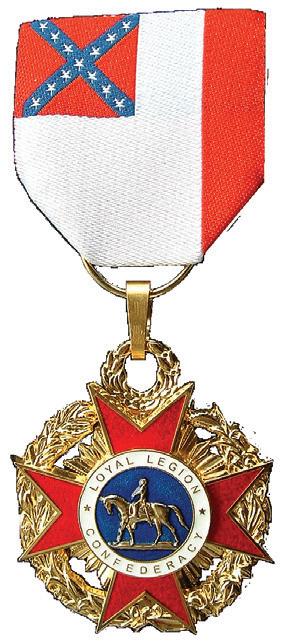
“His initiation into the regiment was on the morning of the great battle of Antietam Creek,” wrote William. “The regiment was moving forward at the time he arrived and in twenty minutes after I shook hands with him, we were in advance of all the lines and under the most terrific storm of shell and shot I have ever experienced.” William watched his little brother withstand “the fire first-rate,” remarking, “I don’t think he was frightened much.”
William’s correspondence includes personal reflections, accounts of military operations, and astute political observations. Some of the most telling passages offer details about how his regiment worked to free as many slaves as they could, and how William cared for a fourteen-year-old Virginia slave who had lost his family through slave sales. But the most touching part of the book comes at the end. William was mortally wounded on July 6, 1863, a few days after the battle of Gettysburg. Joseph rushed to the hospital to care for his brother and kept a detailed diary over the ensuing ten days, until William finally died on July 16. Joseph’s diary brings readers right to William’s deathbed in a way that few period sources do so vividly.
A Family and a Nation Under Fire is an excellent volume that will appeal to readers interested in the military and political history of the Civil War. The book is ably edited and annotated, and the personal correspondence from this family of journalists makes for fascinating reading.
Jonathan W. White is the author or editor of 8 books about the Civil War, including Midnight in America: Darkness, Sleep, and Dreams during the Civil War (2017) and “Our Little Monitor”: The Greatest Invention of the Civil War (2018) with Anna Gibson Holloway.
By Joel D. Citron. Photos, endnotes, index, illustrations, tables, graphs, bibliography, 238 pp., 2018. McFarland, www.mcfarlandbooks.com. $39.95 softcover.Reviewed by Gould Hagler
The work includes a great deal of quantitative analysis related to rations, death rates and medical care. It also includes descriptions of the prison’s physical plant and Pea Patch Island on which the prison was located; the prison’s administration and the military bureaucracy which oversaw operations; and the daily life of the prisoners and their guards.
No prisoner-of-war camp is a pleasant place to be. No one would dispute that. However, for many decades—since 1861 probably—Americans have argued about the relative conditions of Northern and Southern prisons. As important as the conditions themselves is the question of the cause. What led to the inhumane circumstances which created so much suffering? One commonly-held view is that the squalid conditions in Confederate prisons were due to a lack of resources, while Confederate prisoners in the North suffered because of retaliatory measures adopted by the United States government. The late Joel Citron, a chemist by profession, was a long-time volunteer at Fort Delaware State Park. In Confederate Prisoners at Fort Delaware Citron argues against this commonly-held view.
“The goal of this study,” he writes in the preface, “was to find as many contemporaneous primary sources of information about what happened...and to analyze what these primary sources reveal.” The author pored through over 20 diaries and the relevant documents in the Official Records. In addition, Citron found many unpublished and previously unused documents in the National Archives that relate to the prison. The research led him to the conclusion that conditions at Fort Delaware were not nearly so harsh as previous writers have maintained and that retaliatory measures ordered by the Commissary General of Prisoners and the Secretary of War did not lead to significant worsening of the prisoners’ plight.
Citron concludes that the prisoners fared reasonably well at Fort Delaware; that the food, shelter and medical care were generally adequate; that camp discipline was not unduly harsh; that the death rates (the proof of the pudding, if you will) were lower than at other Northern and Southern prisons. (The adjectives and adverbs in the foregoing sentence, and especially in the last clause, are employed with the understanding that we are talking about a facility in wartime—and about events that occurred in the mid-19th century, when medical science and understanding of the causes of disease were primitive compared to the present. We must keep in mind that soldiers died of disease every day of the war, whether they were in prison or not.)
Citron makes a strong case. However, in one way his methodology—his exclusive reliance on contemporaneous sources—is questionable. There is no doubt that contemporaneous sources are preferable in most circumstances, but should all others be dismissed wholesale? Shouldn’t they be consulted, compared to other sources, assessed and used with care to complete the picture? One example is a 1905 Confederate Veteran article, written by Col. George Moffett, a prisoner at both Camp Chase and Fort Delaware, which does not appear in Citron’s work. Moffett claimed that hanging prisoners by their thumbs was “a daily occurrence,” while Citron gives just a few examples of this torture and then changes the subject. Should this allegation of daily torture be ignored? Moffett said that Fort Delaware was “infinitely worse” than Camp Chase. While Delaware’s commandant was a “Hessian brute,” the officer in charge of Chase was “a soldier with gentlemanly instincts.” Discipline at Chase was “strict and strictly enforced,” but at Delaware was “brutal and brutally enforced.” If Moffett was exaggerating or lying, why would he give a favorable comparison
to Camp Chase? Perhaps the judicious use of sources like this could add to our knowledge.
The book is not an easy read. There are some stylistic issues that are distracting and in places the writing could be more spirited. These are minor matters, however. The main reason Confederate Prisoners at Fort Delaware is not a page turner is because it is not meant to be. It is a detailed analysis and requires work on the reader’s part.
Citron explicitly limits his conclusions to Fort Delaware and suggests that studies similar to his be undertaken for other Northern prisons. He has already uncovered long-ignored boxes of records. Perhaps another researcher could dig through them and see if there is something to learn about Elmira, Camp Douglas and Point Lookout.

Gould Hagler is a retired lobbyist living in Dunwoody, Ga. He is a past president of the Atlanta Civil War Round Table and the author Georgia’s Confederate Monuments: In Honor of a Fallen Nation, published by Mercer University Press in 2014. Hagler speaks frequently on this topic and others related to different aspects of the Civil War and has been a regular contributor to CWN since 2016. He can be reached at gould.hagler@gmail.com.
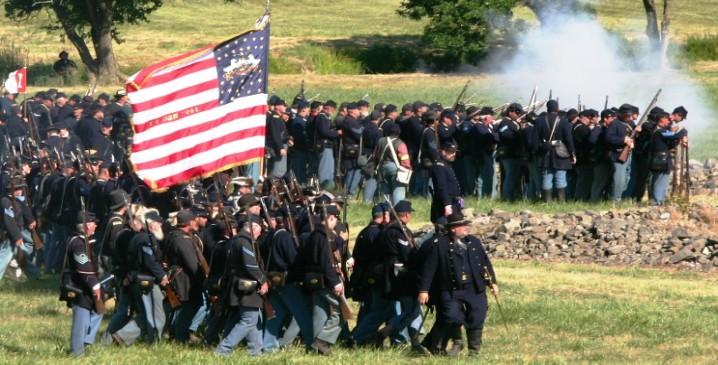
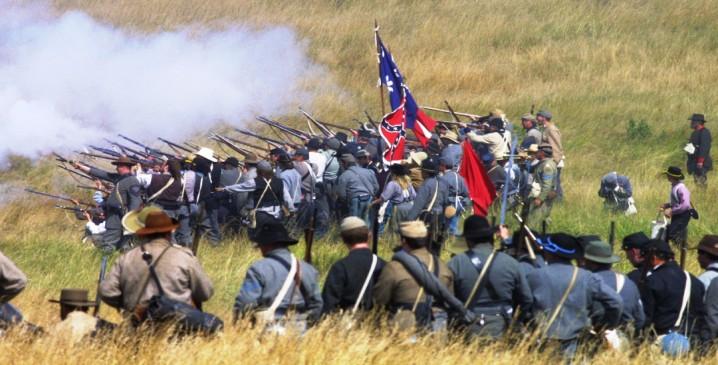
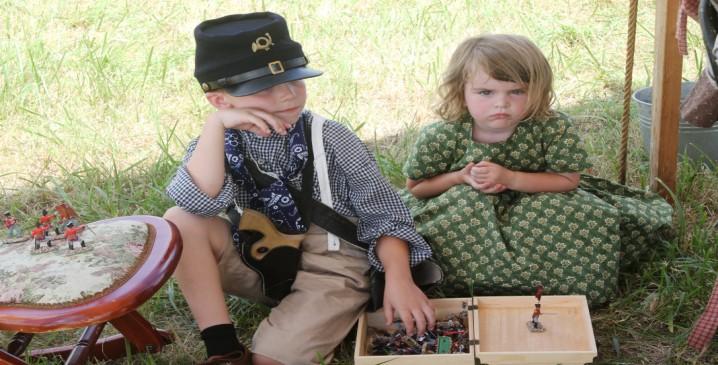
At the Forefront of Lee’s Invasion: Retribution, Plunder, and Clashing Cultures on Richard S. Ewell’s Road to Gettysburg. By Robert J. Wynstra. Illustrations, maps, notes, bibliography, index, 352 pp. Kent State University Press, www.KentStateUniversityPress. com $49.95 cloth.
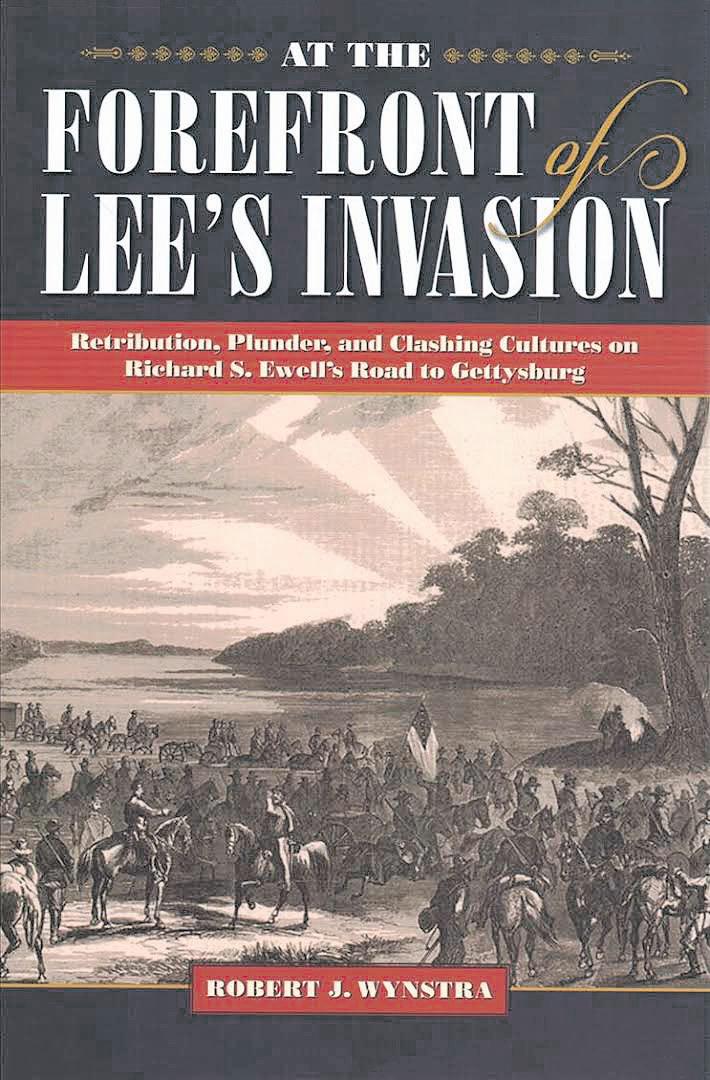
Reviewed by Paul Taylor
Within ten days and with Brig. Gen. Robert Rodes’ brigade in the lead, Confederate forces had swept all Union forces from western Virginia’s Shenandoah Valley, which included victories at Berryville and Martinsburg. By June 15, Ewell’s lead columns stood on the south bank of the Potomac River, ready for a return visit to northern territory.
The Confederacy needed supplies for its depleted ranks. As with the Antietam campaign nine months earlier, one of Lee’s paramount concerns was feeding his always hungry army and perhaps more importantly, gaining diplomatic recognition from England and France. They were confident that one more victory, especially on northern soil, might bring that recognition.
men to plunder or take private property of no military value, except by officers so designated to requisition necessary supplies. How Lee’s senior officers strove to enforce the general’s edict against the army’s legitimate supply needs and some men’s longing for retribution is a core focus in this book.
On June 4, 1863, the three corps of General Robert E. Lee’s Army of Northern Virginia began marching northward from their Virginia camps to begin what would become the second invasion of northern soil. This new work by Robert Wynstra focuses on the march of General Richard Ewell’s Second Corps, which led the advance.
Wynstra amply depicts the tactical maneuvering and the resultant skirmishing with northern militia. Five maps are included illustrating corps and division routes of march through Virginia, Maryland and Pennsylvania. However, it is the Confederate supply demands and requisition tactics throughout Maryland and Pennsylvania—and the civilians’ response to those ultimatums— that form this book’s essence.
The author describes how the Confederates’ reception by Maryland residents was generally more welcoming than in the prior campaign; nevertheless, the soldiers’ desire for revenge ran deep. Consequently Lee issued explicit orders forbidding his
Those officers in charge of gathering supplies confiscated whatever they needed, “paying” businesses and individuals for their booty in worthless Confederate scrip or receipts. They quickly realized they would be able to comfortably live off the land and off these confiscations while realizing that any local militia resistance could be easily swatted away. As one Confederate soldier famously asked of the terrified northern civilians, “How do you like this way of our coming back into the Union?”
Confederate officers reassured shopkeepers that if the South won the war, the Confederacy would reimburse their losses in gold. If the South lost, however, it would be up to the U.S. Government. In any event, few civilians or business owners ever saw the first nickel in compensation. Wynstra illustrates how the Confederates were well aware of the financial distress their confiscations placed on the northern population and were quite pleased by it.
Confederate soldiers did not limit their spoils to foodstuffs, medicines, clothing, livestock, or other supplies of military
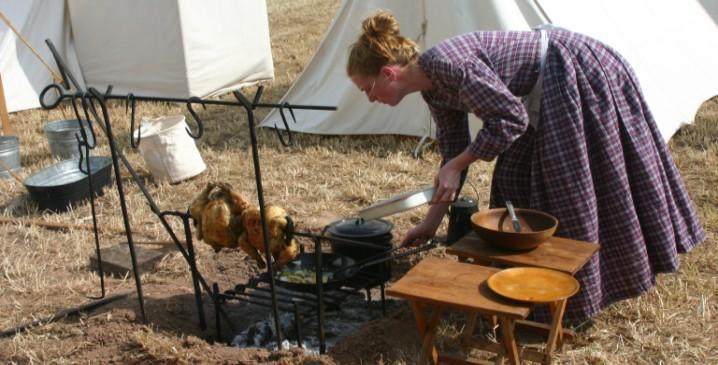
value, either. Any blacks they came across—allegedly slave or free—were rounded up to be sent back south into bondage. Such seizures were considered by the Confederates to be no different than confiscating horses or cattle and were carried out with the sanction and knowledge of their commanding officers. Meanwhile, southern slave catchers and owners followed closely behind the army in order to claim their “property.”
The author utilized period newspapers as well as dozens upon dozens of manuscript sources from both northern civilians and Confederate soldiers to describe how and to what degree the southern soldiers confiscated what they needed. Many of these men were in awe at the rich bounty of food and supply all around them. Despite that material abundance, however, those same men often had little good to say within their diaries and letters about the local people who produced such wealth. This was especially prevalent within the German immigrant communities in south Pennsylvania. Instead, they derisively claimed the hated “Dutch” were merely part of a corrupted culture that placed monetary wealth above social refinement.
Wynstra’s excellent book is not the first to cover the Confederate advance into Maryland and Pennsylvania. Jacob Hoke, a Chambersburg eyewitness, first penned The Great Invasion of 1863 in 1887. That was followed by Wilbur Nye’s Here Come the Rebels! over 75 years later in 1965. Both works are considered essential components of a Gettysburg bookshelf. John W. Schildt’s Roads to Gettysburg (1978) and Bradley M. Gottfried’s Roads to Gettysburg: Lee’s Invasion of the North, 1863 (2001) are more recent additions to this small canon.
Even so, with its rich use of uncommon primary sources and insightful analysis, At the Forefront is a worthy successor to these previous volumes that covered the Confederate march to destiny: a four-week campaign that succeeded admirably at refitting and feeding Lee’s legions, but hardly compensated for the forthcoming devastation at Gettysburg.
Paul Taylor is an award-winning author of seven books pertaining to the Civil War era. His newest book is titled “The Most Complete Political Machine Ever Known”: The North’s Union Leagues in the American Civil War, published by Kent State University Press.
Before making plans to attend any event contact the event host.
Deadlines for Advertising, Editorial or Events Submissions is the 20th of each month.
We strive to add all events submitted to us but do not guarantee that your event will be published. There is a 100 word maximum for each event. Email events to: ads@civilwarnews.com
Feb. 24-25, South Carolina. Reenactment
See history come alive with cannon, cavalry horses and living history experts. Reenactments, authentic 19th-century military encampments, living history presentations, civilian portrayals, reproductions of medical facilities, etc. Adults: $12, 6-12: $6, 5 and under: Free. For info; www.battleofaiken.org.
March 8-10, Florida. Civil War Reenactment
Join us for the Raid of Fort Pierce. Battles are at 1:30 p.m. Sat. and Sun. Ladies’ Tea is at 11 a.m., Sat. and a Grand Bon Fire Frolic will be held in the Confederate Camp at 7:30 p.m. Sat. If you play a musical instrument, feel free to bring it to the Frolic. Cavalry needed for school day, and artillery is welcome. The Ladies of the Order of Confederate Rose will be cooking dinner for school day participants on Fri. evening, breakfast on Sat. and Sun., and supper on Sat. evening. Bounty for the first Union and Confederate artillery pieces registered. Firewood, water, and hay provided. Persona or officer impressions to speak to school kids are welcome and appreciated. Reenactor Fee: None – Donations welcome. For directions and information; Jim O’Dell at 772- 318-8258 or thejdawg5692000@yahoo.com.
March 23, Pennsylvania. Annual Grand Army Museum
Preservation Luncheon
9130 Academy Rd. Philadelphia, Pa. “Lincoln’s Gamble: The Tumultuous
Six Months that Gave America the Emancipation Proclamation and Changed the Course of the Civil War” by Historian Todd Brewster. For information; garmuslib@verizon.net; or 215-289-6484
March 29-30, Virginia. Civil War Show and Sale
The Northern Virginia Relic Hunters Assoc. will present its 47th annual Civil War show at the Fredericksburg Expo Center. The show will feature Civil War and World Wars I & II era relics, memorabilia along with a wide selection of antique guns and swords. Hours are 12 to 7 p.m. on Friday and 9 a.m. to 4 p.m. on Saturday. For information; contact Denny Chafin, 703-8552376 or civilwarshow@nvrha.com.

March 30, Pennsylvania. Civil War Preservation Ball
Pennsylvania State Capitol Rotunda, Harrisburg, Pa. 7 p.m. – 10 p.m.. Surrounded by the majesty and history of the Capitol Rotunda, the 16th Annual Civil War Preservation Ball benefits the Pennsylvania Gettysburg Monuments Trust. The trust helps fund repairs and maintenance of the more than 140 markers and monuments that honor Keystone State regiments and individuals on the Gettysburg battlefield. Sponsored by the Civil War Dance Foundation, the ball has raised nearly $100,000 to preserve the Pennsylvania monuments. Admission $35 single, $65 couple. For more information, visit CivilWarDance.org. Email: Info@CivilWarDance.org.
March 30-31, Tennessee. Civil War Show
52nd Mid-South Civil War and Military Show at the Agricenter Showplace Arena located at 105 S. Germantown Pkwy., Memphis. For information; Lee Ann Robertson at 662-279-0538, Sandy Parent at 901-652-7005, Don Harrison at 901-832-4708 or dharrison@aol.com.
April 1, New Jersey. Lecture
Walt Whitman’s enormous contribution to the Civil War will be the focus of this power point presentation. For three years Whitman tirelessly tended to the sick, wounded, and dying soldiers in Washington’s hospitals. The presentation will begin at 7 p.m. on the Blackwood campus of Camden County College. All are invited to the free presentation by Joseph F. Wilson that will take place in Civic Hall. Free parking. For info; joef21@aol.com.
April 6-7, Mississippi. Civil War Show
The 10th Annual Corinth Civil War Relic Show and Sale sponsored by the

Col. W.P. Rogers, SCV Camp #321 will be held at the Crossroads Museum. Located at 2800 S. Harper Road exit on Hwy 45, just 1 mile south of Hwy 72 in Corinth, Miss., this show is expanded, larger and better than ever before. Sat. 9 a.m. to 5 p.m., Sun. 9 a.m. to 3 p.m. For information; Dennis Brown, 662-212-4621/ducksu@frontier.net, Buddy Ellis, 662-665-1419/bellis@1960@comcast.net or visit www.battleofcorinth.com.
April 6, Park Day at Fort Gaines
This annual event brings history enthusiasts together in an effort to help keep our nation’s heritage not only preserved but pristine. Volunteers will help preserve this important monument to honor the brave soldiers who fought and sacrificed in the American Civil War. Pre-register at the Fort Gaines is located at 51 Bienville Blvd. Dauphin Island, AL 36528, via facebook (fb.com/fort Gaines) or call 251-861-6992.
April 6, Virginia. Shenandoah University’s McCormick Civil War Institute in Winchester will host its annual spring conference from 8:30 a.m. – 4 p.m. “A House Divided...”: Dissent, Disagreement, and Subversion During the Civil War Era. Conference will focus on such topics as divisions within Jefferson Davis’ cabinet, Copperheads, Unionists in the Shenandoah Valley, and the ways John Brown’s raid created divisiveness. Presentations by historians Dennis Frye (Harpers Ferry National Historical Park, retired), Paul Quigley (Virginia Tech), Jennifer Weber (University of Kansas), and Jonathan Noyalas (Shenandoah University). Registration fee of $50 ($25 for students with valid id) covers all presentations and lunch. For information or to register visit www. su.edu/MCWI, call 540-545-7293, or email jnoyalas01@su.edu.
April 12-14, North Carolina. Symposium
22nd Annual Salisbury Confederate Prison Symposium sponsored by the Robert F. Hoke Chapter 78, UDC. Event begins on Friday with Friendship Banquet, 3 lectures, music, and recognition of veterans. On Saturday there will be 4 lectures, lunch, door prizes, displays and books. Sunday there is a 10 a.m. Memorial Service for prisoners at the Salisbury National Cemetery and an 11 a.m. Service for guards at the Old Lutheran Cemetery. Tour of Prison site after lunch. $70 per person when postmarked by Mar. 22, $80 afterwards. Send checks to Robert F. Hoke Chapter 78, UDC, PO Box 83, Salisbury, NC 28145. For info; Sue Curtis 704-637-6411, southpawsagain@gmail.com.
April 14, Pennsylvania. Annual Symposium
General George G. Meade - Life & Legacy will be held at the Conservatory at West Laurel Hill Cemetery in Bala Cynwyd. For information; Jerry McCormick 215-848-7753; ged-winmc@msn.com.
April 27-28, Alabama. Thunder on the Bay 2019
Come celebrate the upcoming 155th Battle of Mobile Bay Sponsored by the 6th Alabama Cavalry and the Alabama Division of Reenactors. Event will be held at Fort Gaines Historic Site, 51 Bienvile Blvd, Dauphin Island, Alabama 36528. Battle will be held Sat. at 2 p.m. and a surrender ceremony at 3 p.m. On Sunday, there will be a 1 p.m. tactical.
March
Public Hours: Sat. 9
to 5 P.M., Sun. 9
Admission: $10.00
to 3 P.M.
Friday:
Living history for local schools. Come and share your knowledge of the Civil War with Columbia and Montour County school children. Dinner provided for all participants. Saturday Living history all day.
• Unit bounties paid
• Free registration
• Artillery and Cavalry welcome
• Sutlers welcome
• Large gun show also on the Fairgrounds
For more information and registration forms contact Eric Stahley at ecstahley@gmail.com
Bloomsburg Fairgrounds 620 W 3rd St • Bloomsburg, PA 17815
Dissent, Disagreement & Subversion During the Civil War Era
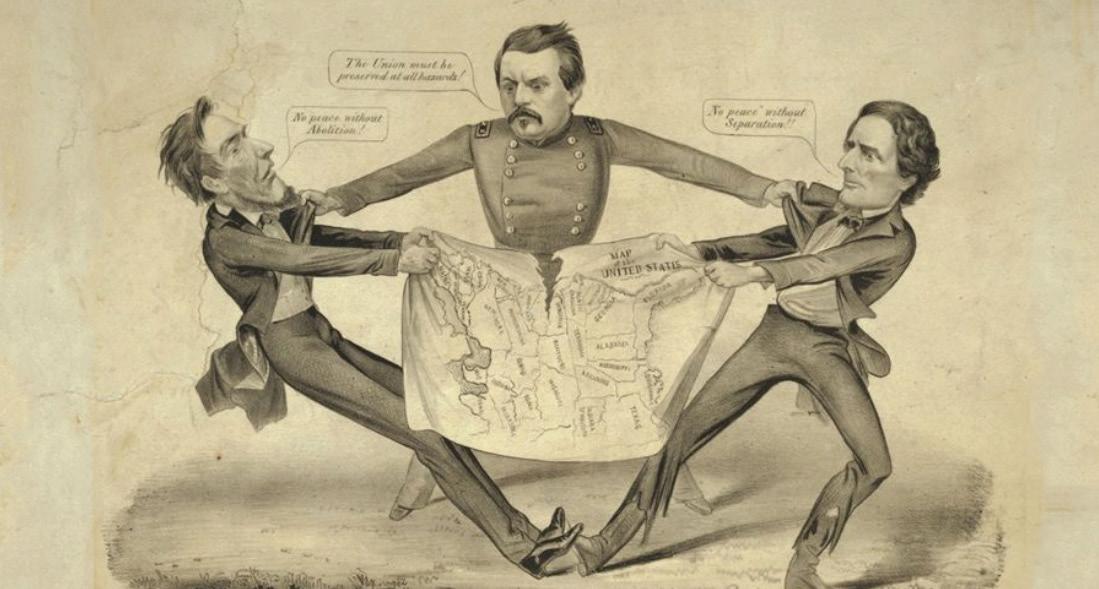
Shenandoah University McCormick Civil War Institute annual spring conference, Saturday, April 6, 2019, featuring nationally-recognized Civil War scholars Dennis Frye, Jonathan A. Noyalas, Paul Quigley and Jennifer Weber.
Registration information: su.edu/MCWI
Registration fee: $50 includes presentation & lunch
Location: Shenandoah University, 1460 University Drive, Winchester, VA
Questions: contact MCWI's director Jonathan Noyalas 540-665-4501 | jnoyalas01@su.edu
For information; 251-861-6992, via facebook (fb.com/fort Gaines) or call 251-861-6992.
April 27, Illinois. Civil War Show and Sale
Zurko Promotions presents The National Civil War Collectors Spring Show and Sale which will be held at the DuPage County Fairgrounds in Wheaton. Hours: 9 a.m. to 4 p.m. Admission is $9 – includes admission to the CADA Collector Arms Dealers Assoc. Show. For information; www. chicagocivilwarshow.com.

May 1-4, Maryland. 6th Annual National Ed Bearss Symposium on Military Leadership & Combat
Featuring Ted Alexander, Steve Bockmiller, Dr. Richard Sommers, Martin West & others based in Chambersburg, Pa. Special guest Edwin C. Bearss will also join us. Exploring American military history! Tours of the following: Civil War sites in southern Pennsylvania including Monterey Pass; military history sites in Washington County, Maryland, including the Hagerstown Aviation Museum; the Forbes Campaign of 1758 featuring stops at Fort Ligonier, Bushy Run Battlefield and more. Talks also given by the historians listed above. For info visit www.CivilWarSeminars.org.
May 4-5, New York. Artillery School
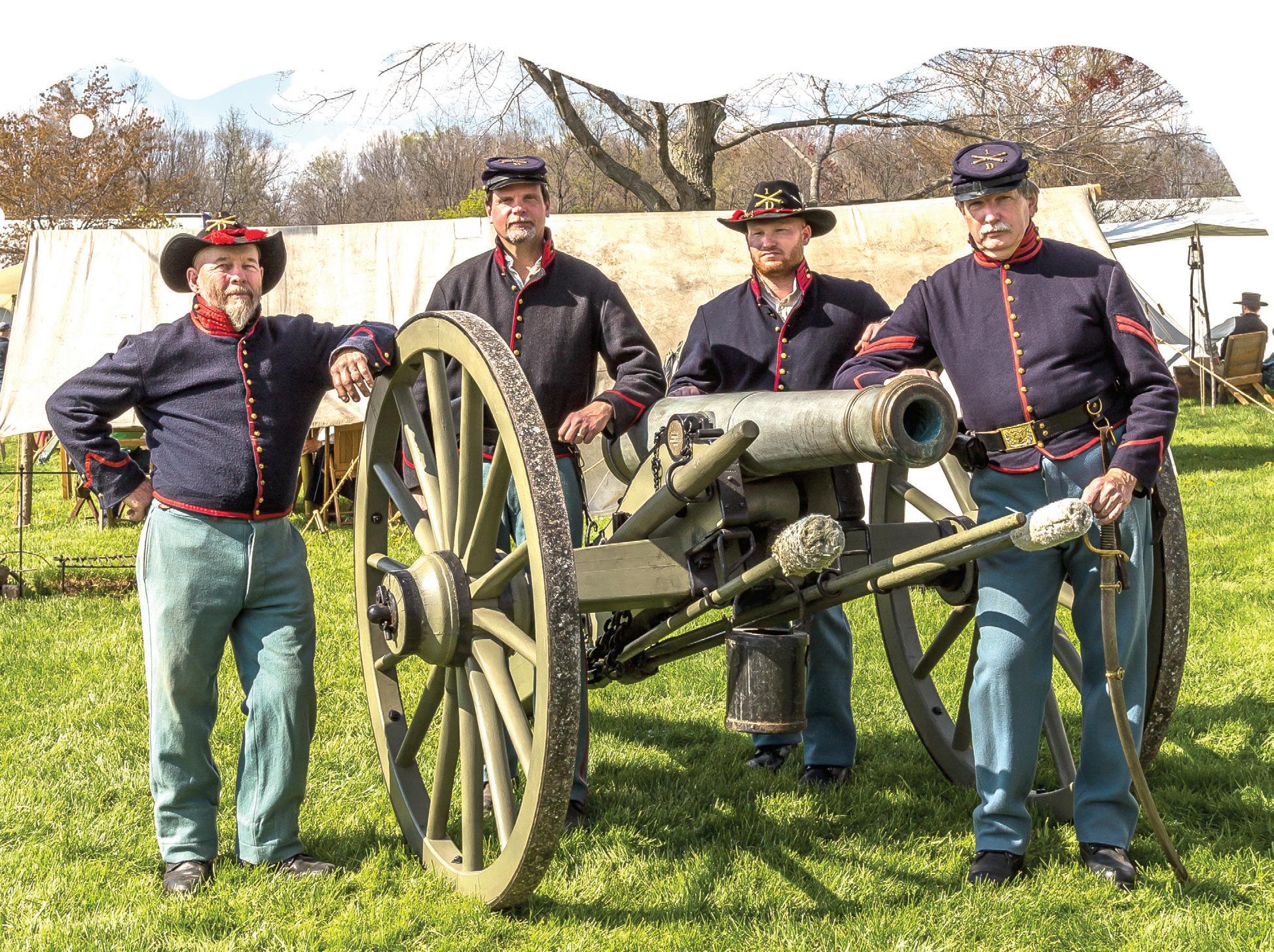
The 31st Annual Artillery School will take place, at Old Fort Niagara in Youngstown, New York. Open to all branches of service, both Federal and Confederate. Registration fee is $7. Sponsored by the National Civil War Artillery Association and Reynolds’ Battery L. For information; Rick Lake, rlake413@aol.com or 585-208-1839. Registration Forms and additional information can be found at: www.reynoldsbattery.org.
May 4-5, Ohio. Civil War Show and Sale
42nd Annual Ohio Civil War Show & 25th Annual Artillery Show at Richland County Fairgrounds, Mansfield, Sat. 9-5, Sun. 9-3. Living history, cannon firing, field hospital, music, demonstrations. $7 ages 12 up. Seven buildings
– One Gate Admission, Food and Handicapped Facilities, 30-Gun Artillery Show – Indoor/Outdoor, 6-Gun Battery Firing Demonstrations, Sutler’s Row, Civil War Field Hospital by the Society of Civil War Surgeons. Period Church Service Sun. Morning with Period String Music, Abe Lincoln Live Presentations, Living History Campfire by Brigade of American Revolution, 8th Pennsylvania Regiment, Period Music by Camp Chase Fife & Drums. For info; call 419-884-2194; or visit the website www.ohiocivilwarshow.com.
May 17-19, Georgia. Reenactment
The 155th Anniversary “Battle of Resaca” reenactment will be held on over 650 acres of the original battlefield. This event will have main camps located within the original US and CS lines. Camping allowed in or near the breastworks. Amenities include straw, hay and firewood; food and ice on site. The planned activities include main battles both days at 2 p.m., period dance, medical demo’s, cavalry competition, ladies’ tea, civilian refugee camp, period church services and a memorial service at the Confederate cemetery. Handicapped parking is available. A portion of the proceeds will be donated to the preservation efforts of the Friends of Resaca Battlefield, Inc. A $150 bounty will be paid to the first fourteen 57-inch cannon and crews registered by May 1st. Reenactor registration fee is $10 due by May 1. For
more information, www.georgiadivision.org or Battle of Resaca, P.O. Box 0919, Resaca, GA 30735-0919.
May 17-19, Virginia. Period Firearms Competition
The North-South Skirmish Association 139th National Competition near Winchester. Over 3,000 uniformed competitors in 200-member units compete in live-fire matches with muskets, carbines, revolvers, mortars and cannon plus costume competitions and historical lectures. The largest Civil War live-fire event in the country. Free admission, large sutler area, and food service. For information; www.n-ssa.org.
May 26, Pennsylvania. Annual Memorial Day Observed at Historic Laurel Hill Cemetery Recreating the Original G.A.R. Decoration Day Service of 1868: The traditional Decoration Day service of the Grand Army Meade Post #1 will be recreated at Historic Laurel Hill Cemetery, 3822 Ridge Ave. Philadelphia at 12 noon. For information; 215-228-8200.
June 1-2, Pennsylvania. Lehigh Valley Civil War Days
The 11th Camp Geiger Reenactment will be held at Whitehall Pkwy., Whitehall, Pa. There will be a battle reenactment each day. This will include fighting in trenches and a tactical. Living History Street. Medical demos, historical personages, children’s activities and more. Period music and speakers each day. Sat. evening period dance. Sutlers and food vendor will be on site to serve reenactors and spectators. Water & wood is provided. Ice & straw available for small fee. Sutlers by invitation only. Registration fees - $10 until May 15, $15 after May 15. Sutler fees - $50 until Apr. 15, $75 Apr. 15 – May 15. No sutler registration after May 15. For information and registration forms visit our website at www.friendsofcampgeiger.webs.com.
June 1-2, Virginia. 155th Anniversary - The Action at Wilson’s Wharf
Pocahontas was the site of the May 24, 1864 Action in which United States Colored Troops defended the fort they built against an assault by Fitzhugh Lee’s Confederate Cavalry. Open to the public 10-4 Sat. and 10-3 Sun. $10/adults, $8/students. Battle reenactments 1 p.m. both days. Civil War living history weekend including a dress parade, mortar demonstration and family activities. For reenactors: campsites with James River views, Proud Hound Commissary, Friday night Officer’s Social, Saturday night live music, artillery fire and tactical. Free T-shirts. Discounted early registration by May 24. www.fortpocahontas.org.
June 1-2, Pennsylvania. Civil War Event at Pennypacker Mills
Daily battle, artillery demonstrations, military encampments, Civilian Street demos, performance on Sat. by the 28th PA Regimental Brass Band, music & songs on Sun. by Matthew Dodd. Herb Kaufman will speak on Civil
1. Ulysses S. Grant (1822–1885).
2. William Tecumseh Sherman (1820–1891).
3. Philip Henry Sheridan (1831–1888).
4. George Stoneman (1822–1884).
5. Benjamin Franklin Butler (1818–1893).
6. Don Carlos Buell (1818–1898).
7. George Henry Thomas (1816–1870).
8. Henry Wager Halleck (1815–1872).
9. William Starke Rosecrans (1819–1898).
10. James Birdseye McPherson (1828–July 22, 1864).
July 20-21, 2019
Union Mills Homestead, Union Mills, Md.
Commemorating Civil War History along Meade’s Pipe Creek Line
Where Citizen Meets Soldier
Infantry and artillery drills, living history, skirmishes both days at encampment sites of Stuart’s Cavalry & Sykes’ U.S. V Corps.
Military units and living historians contact: info@unionmills.org • (410) 848-2288
War medicine. Mansion tours, museum shop and food vendor onsite. Free to the public. $2/person until May 1. $10/ person after May 1. Under 16, Free. Sutlers’ fee $25.00. Free firewood, water, straw & cake on Sat. For information 610-287-9349. Registration forms at www.ppmcivilwar.org.
June 8-9, Mississippi. Civil War Relic Show
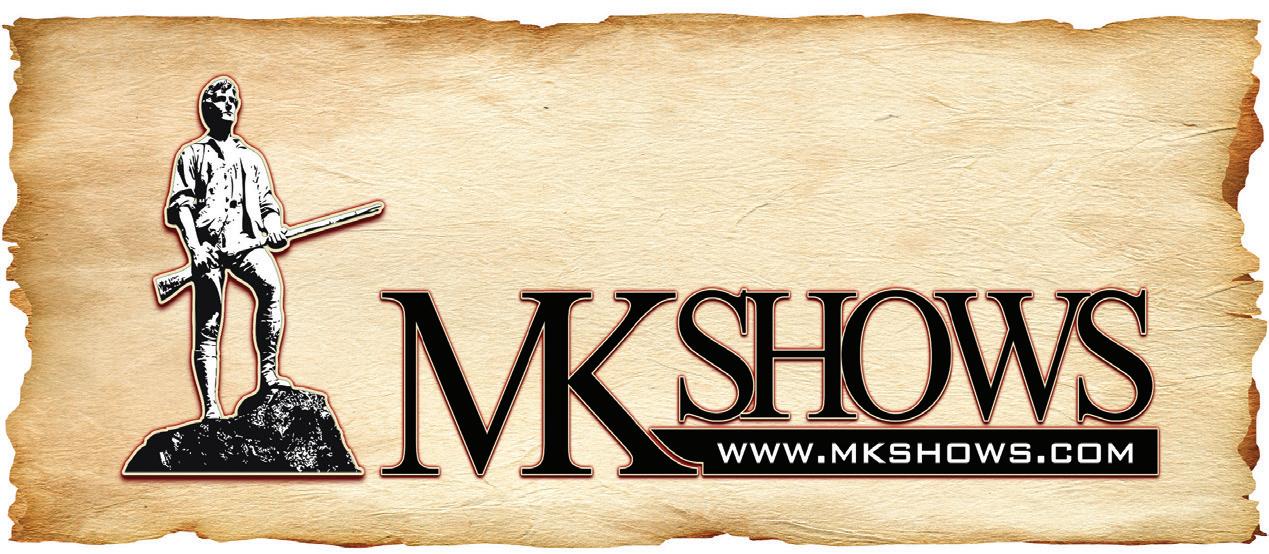
Brandon’s 5th Interactive Civil War Relic Show sponsored by SCV Camp #265 will be held at City Hall located at 1000 Municipal Drive, Brandon. For information; contact Tim Cupit at 769-234-2966 or timcupit@comcast.net.
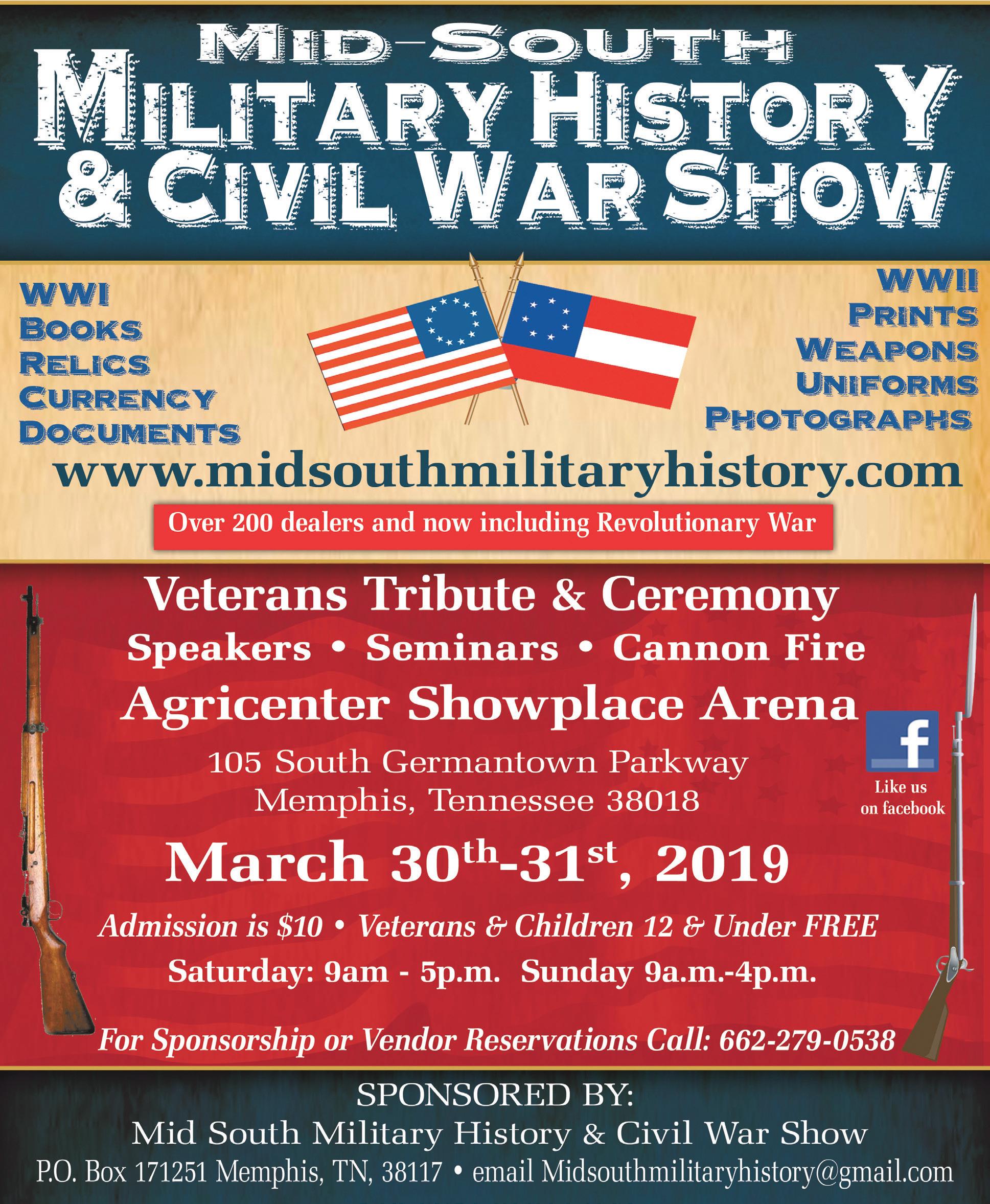
June 29-30, Pennsylvania. Civil War Show
Sat. 10 a.m. - 5 p.m., Sun. 9 a.m. – 2 p.m.
Eisenhower Hotel & Conference Center Allstar Expo Complex, 2638 Emmitsburg Road, Gettysburg. The Gettysburg Battlefield Preservation Association’s Artifact and Collector’s Show features more than 200 vendors and over 300 tables of artifacts, swords, firearms, correspondence, books, photographs, documents and much more. Daily admission: Adults: $8. Children 12 and under free. Vendors contact: bsynnamon@gmail.com or call 717-334-2350. For more information visit www.uniondb.com or www.gbpa. org. Email: info@gbpa.org.
lPromoters of Quality Shows for Shooters, Collectors, Civil War and Militaria Enthusiasts

Capital of the Confederacy Civil War Show (original dates)
November 16 & 17, 2019
Chickamauga (Dalton) Civil War Show

February 2 & 3, 2019
Middle TN (Franklin) Civil War Show

December 7 & 8, 2019
Military Collectible & Gun & Knife Shows
Mike Kent and Associates, LLC • PO Box 685 • Monroe, GA 30655 (770) 630-7296 • Mike@MKShows.com • www.MKShows.com

Deadlines for Advertising or Editorial Submissions is the 20th of each month. Email Ads or Events to ads@civilwarnews.com
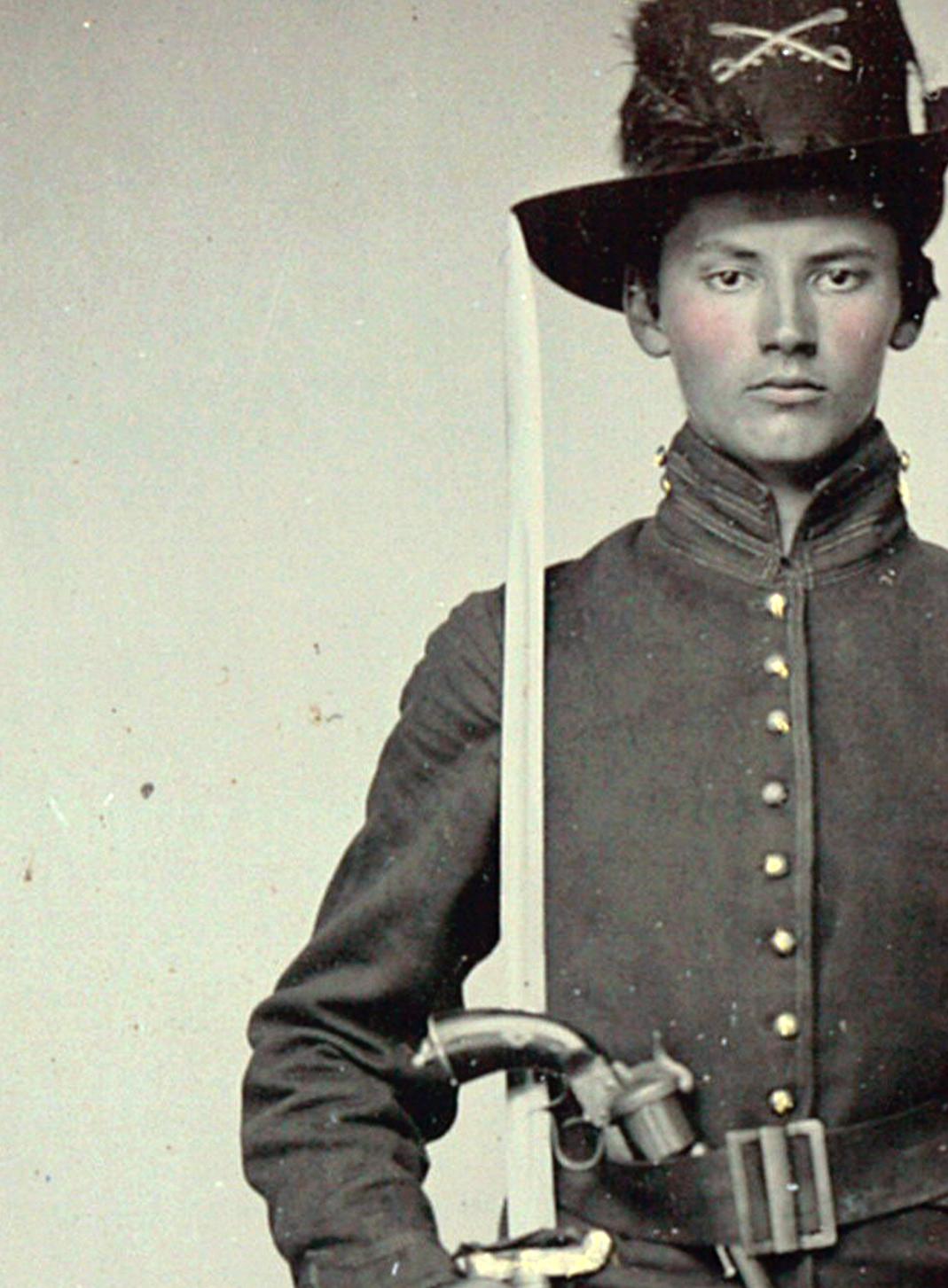
The Seven Days Campaign

June 14-16, 2019
Join tour guide Robert E.L. Krick joined by Jeffry D. Wert as we visit.
Saturday:
• Lee’s Headquarters
• Beaver Dam Creek/Mechanicsville
• Gaines’s Mill
• Lunch at the Cold Harbor picnic area
• After lunch, finish up Gaines’s Mill and Savage’s Station
• Yellow Tavern Battlefield


Sunday:
• Savage’s Station
• White Oak Swamp
• Glendale/Frayser’s Farm
• Malvern Hill
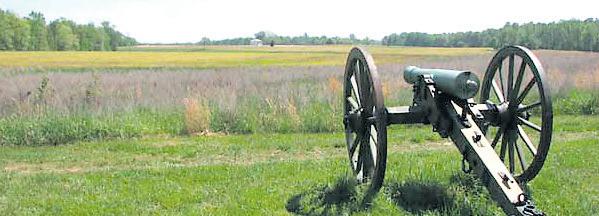
Friday and Saturday evening dinners included with dinner speakers Frank O’Reilly and Jeff Wert. Includes two nights lodging at the picturesque Virginia Crossings Hotel in Glen Allen, Virginia.
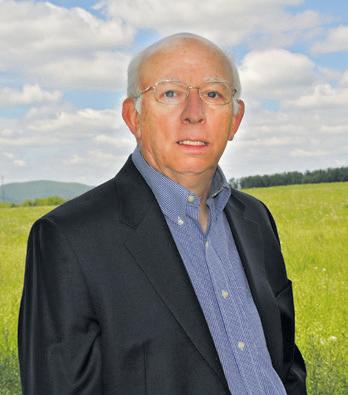

For information:
Total cost $495.00
Go to our website at shencivilwar.org or email shencivilwar@gmail.com
Registration Contact: Conference Services at James Madison University (540) 568-8043
CIVIL WAR REENACTMENT at Museum Village
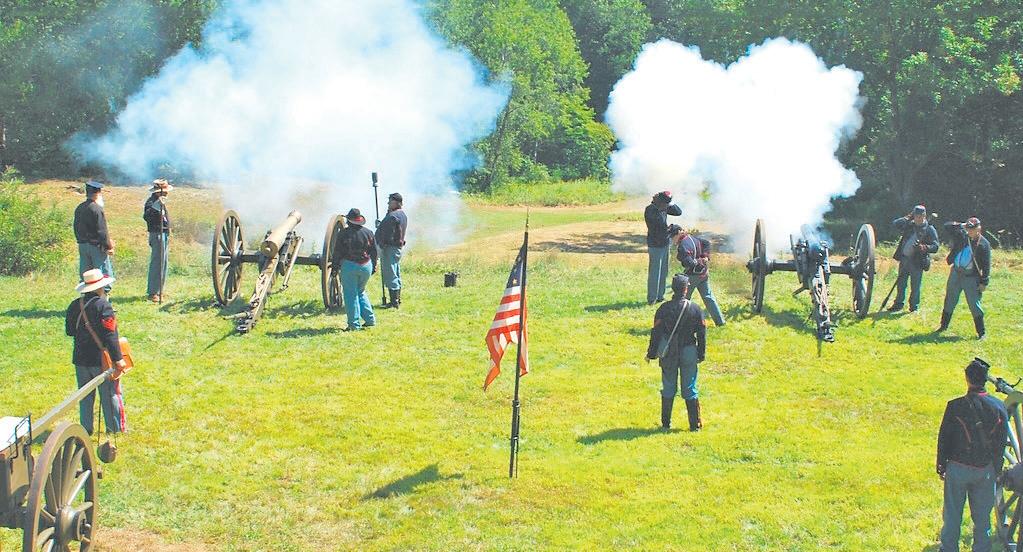
Aug. 31 & Sept. 1, 2019
Looking for Reenactors!
Application is available on our website: www.museumvillage.org

$38.50 - 1 year USA Print $48.50 - 1 year USA Print & Digital
- 2 year USA Print
- 2 year USA Print & Digital $29.95 - 1 year Digital only
Payment Enclosed Check #
# Exp. Date
The following terms and conditions shall be incorporated by reference into all placement and order for placement of any advertisements in Civil War News by Advertiser and any Agency acting on Advertiser’s behalf. By submitting an order for placement of an advertisement and/or by placing an advertisement, Advertiser and Agency, and each of them, agree to be bound by all of the following terms and conditions:
1. All advertisements are subject to acceptance by Publisher who has the right to refuse any ad submitted for any reason.
2. The advertiser and/or their agency warrant that they have permission and rights to anything contained within the advertisement as to copyrights, trademarks or registrations. Any infringement will be the responsibility of the advertiser or their agency and the advertiser will hold harmless the Publisher for any claims or damages from publishing their advertisement. This includes all attorney fees and judgments.
3. The Publisher will not be held responsible for incorrect placement of the advertisement and will not be responsible for any loss of income or potential profit lost.
4. All orders to place advertisements in the publication are subject to the rate card charges, space units and specifications then in effect, all of which are subject to change and shall be made a part of these terms and conditions.
5. Photographs or images sent for publication must be high resolution, unedited and full size. Phone photographs are discouraged.
6. At the discretion of Civil War News any and all articles will be edited for accuracy, clarity, grammar and punctuation per our style guide.
7. Articles can be emailed as a Word Doc attachment or emailed in the body of the message. Microsoft Word format is preferred. Email articles and photographs:
